You are using an out of date browser. It may not display this or other websites correctly.
You should upgrade or use an alternative browser.
You should upgrade or use an alternative browser.
Reviews by Jarlaxle
Filters
Show only:
Loading…
Jarlaxle
100+ Head-Fier
Pros: Sublime bass definition and texture
Great detail, imaging and staging capability
Balanced tuning
Great build quality
Great detail, imaging and staging capability
Balanced tuning
Great build quality
Cons: Other tuning options could have been implemented better
Treble sensitive people should look elsewhere
Treble sensitive people should look elsewhere
EA1000 has been one of the IEMs that I have been very curious to try since its release. Although the initial hype already died out, it doesn’t mean that it’s not relevant anymore. In fact, any newly released single DD that is around 200 USD is put against EA1000. Good gear is eternal after all. Coming at 219 USD, EA1000 Fermat isn’t exactly Simgot’s flagship, but it already overshadowed EA2000 Boson and the others with the positive reception.
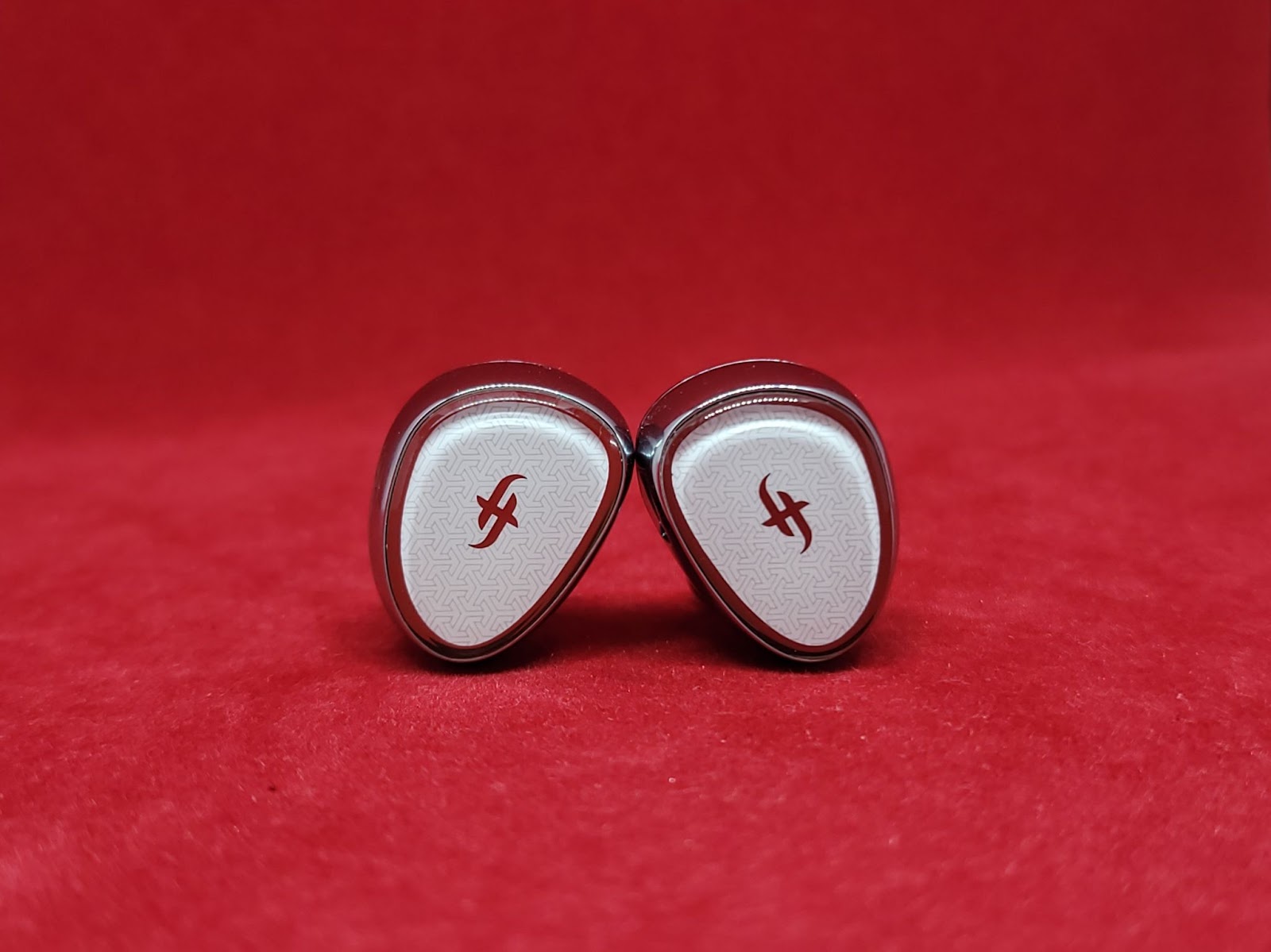
Simgot EA1000 Fermat was provided to me by Simgot for free and I only paid for the customs fee. As I always say, everyone is biased one way or another so take everything you read with a grain of salt. Also I will try to be more concise and to the point in my reviews from now on without worrying about the word count etc. If you have any questions, please ask me in the comments and I will try to answer them to the best of my abilities.
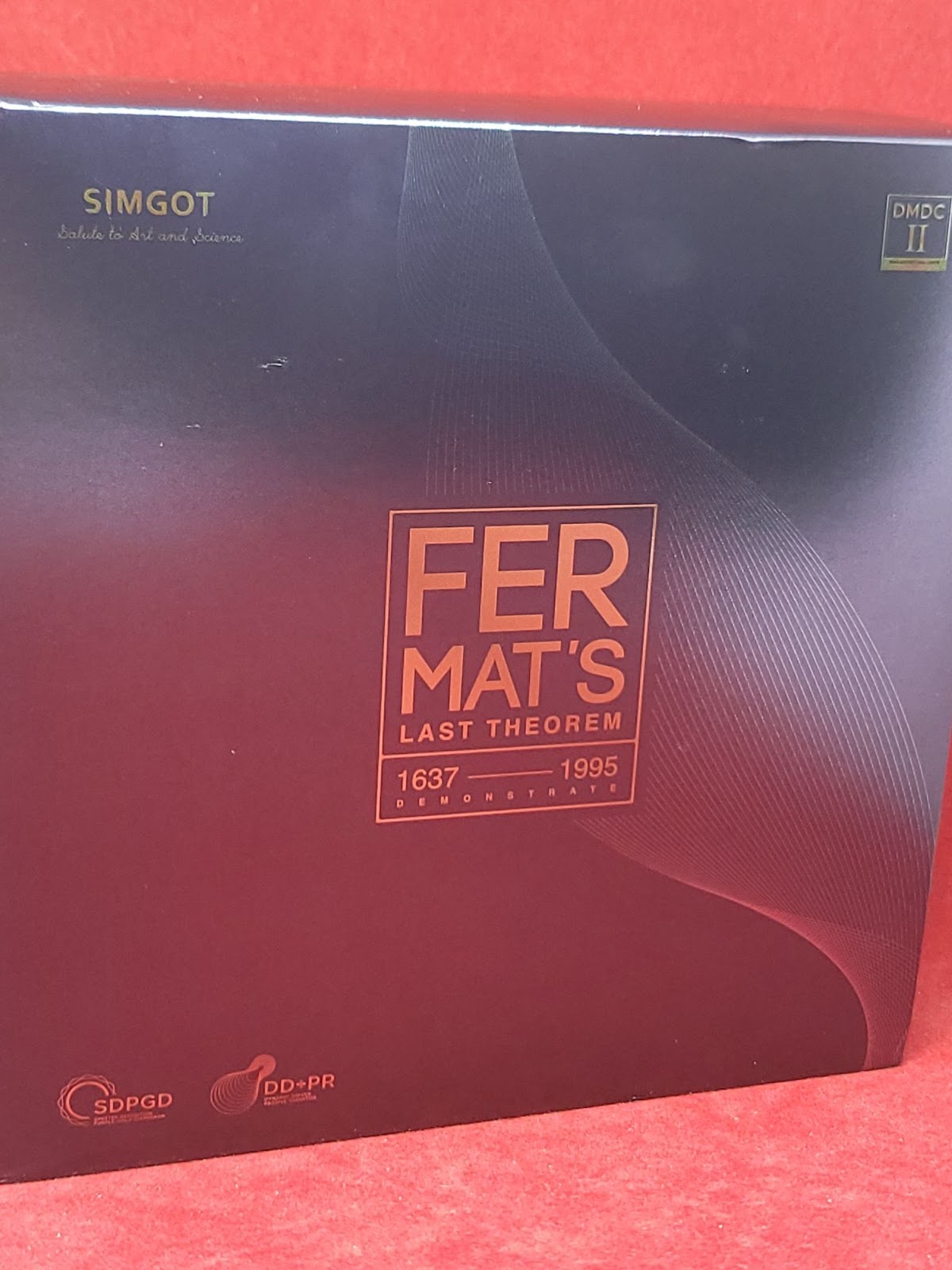
I think at this point, everyone is pretty familiar with Simgot IEMs high build quality. Shells are, as always, fully made out of CNC’d metal. But there are a few twists on EA1000 that solidifies its place as Simgot’s best offering. Faceplate has a beautiful pattern and a glass cover on top of it, so I can’t exactly call it a fingerprint magnet anymore. On the inner side there is a big vent placed on top of the passive radiator. Yes, the EA1000 has a passive radiator per side apart from the dynamic drivers.
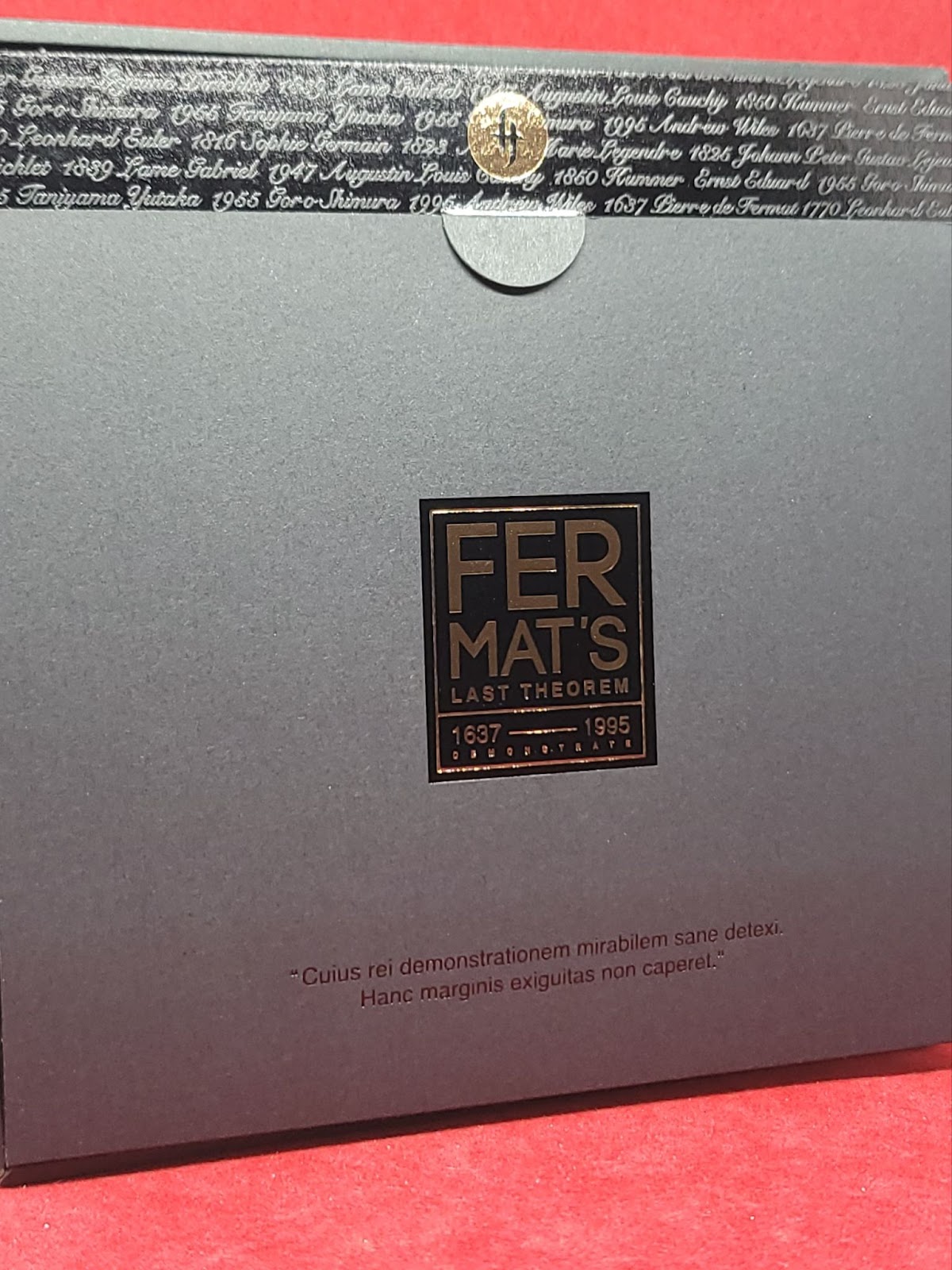
The unboxing experience of EA1000 is also above its brothers. The box is slightly bigger and fancier than usual. When you open the cover inside, you are greeted with a card that explains Fermat’s last theorem and which also acts as a warranty card. The carrying case you get with EA1000 is also fancier. The provided cable is again a single 3.5 mm terminated single ended one but this time thicker. This time you get two sets of eartips instead of one, unlike EA500s and EM6L.

EA1000 comes with 3 pairs of tuning nozzles. Among them silver nozzles with red rings were the most balanced ones, so I used them mostly during my test.
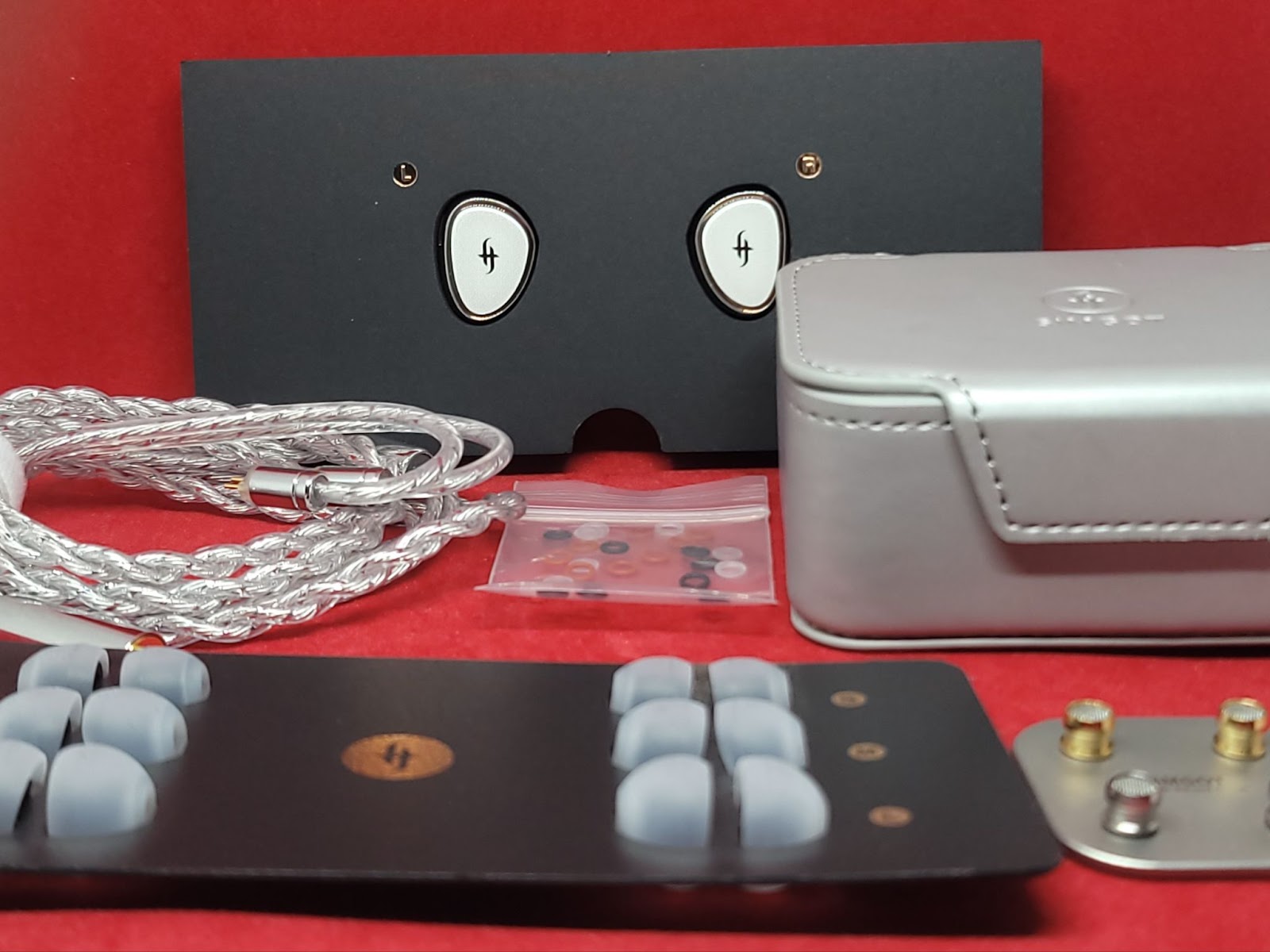
EA1000 targets the bright kind of Harman curve like most of the other Simgot IEMs. So if you used other Simgots like EA500 before, EA1000 will both feel familiar but impress you at the same time.
,
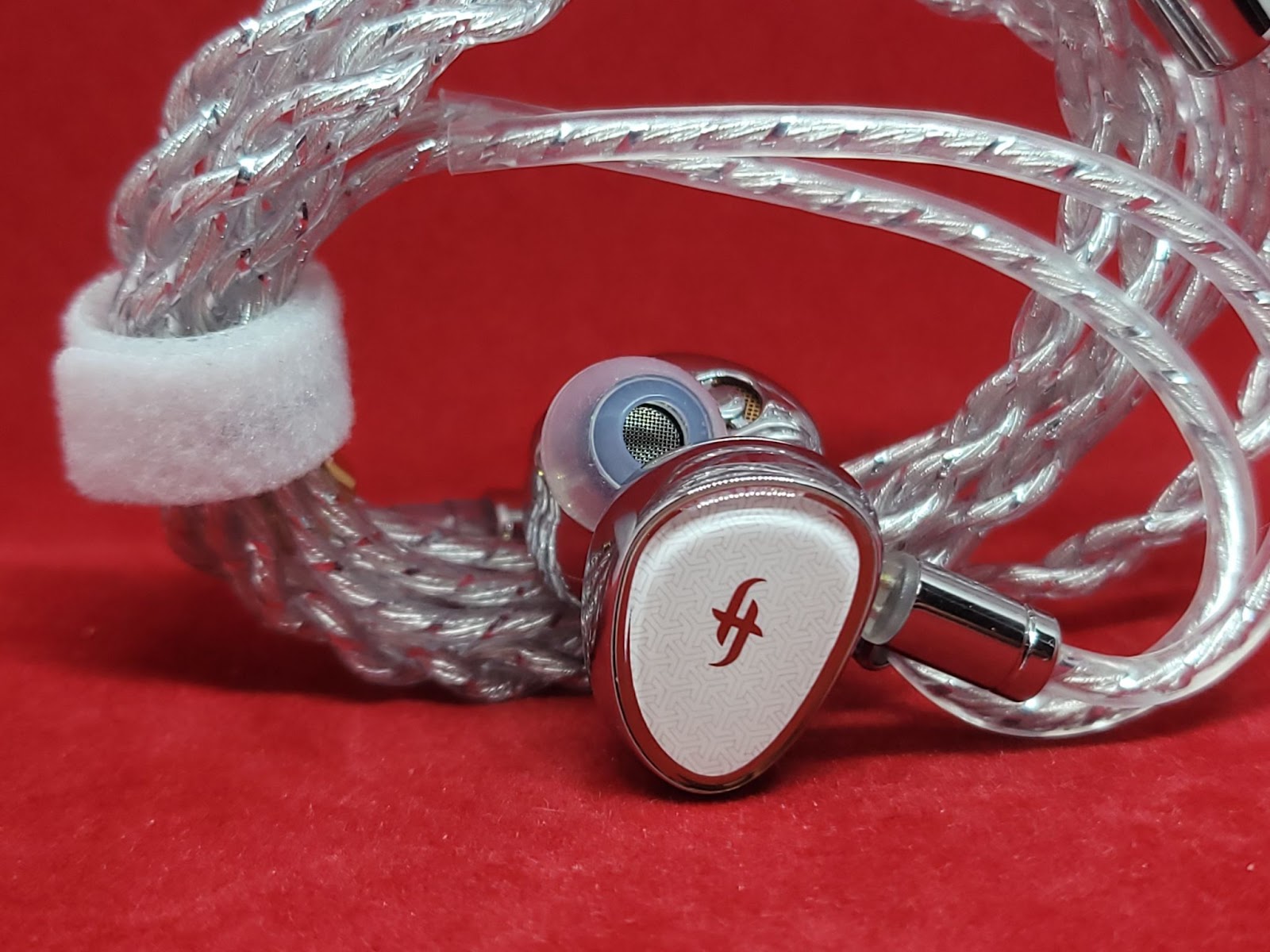
Bass on EA1000 is the most distinguishing feature of the set. It’s one of the most defined and well-textured bass I’ve heard around this price range. It’s not exaggerated, just slightly north of what I would call neutral. It doesn’t dig too deep into the subbass either but it’s enough. There is enough warmth without muddying mids too much. Decay is on point, not too fast to feel dry but fast enough to not feel sloppy.
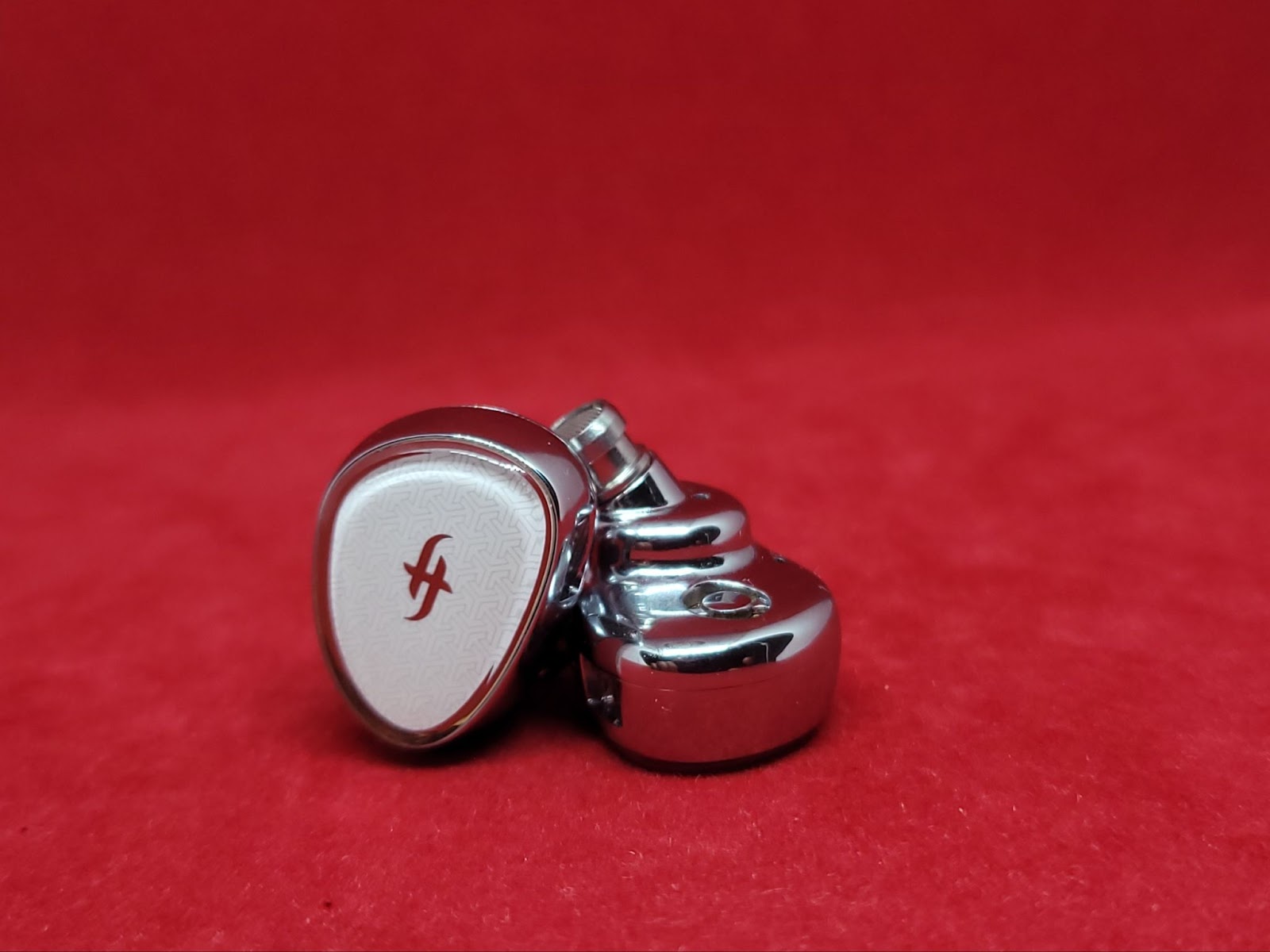
Mids are, in classic Simgot fashion, highlighted, especially the upper mids. For some, I can see it being shouty or intense. Still I mostly like this kind of presentation, and I think most female vocal lovers will like it as well. However, I also think Simgot could provide nozzles that are tamer instead of more intense.
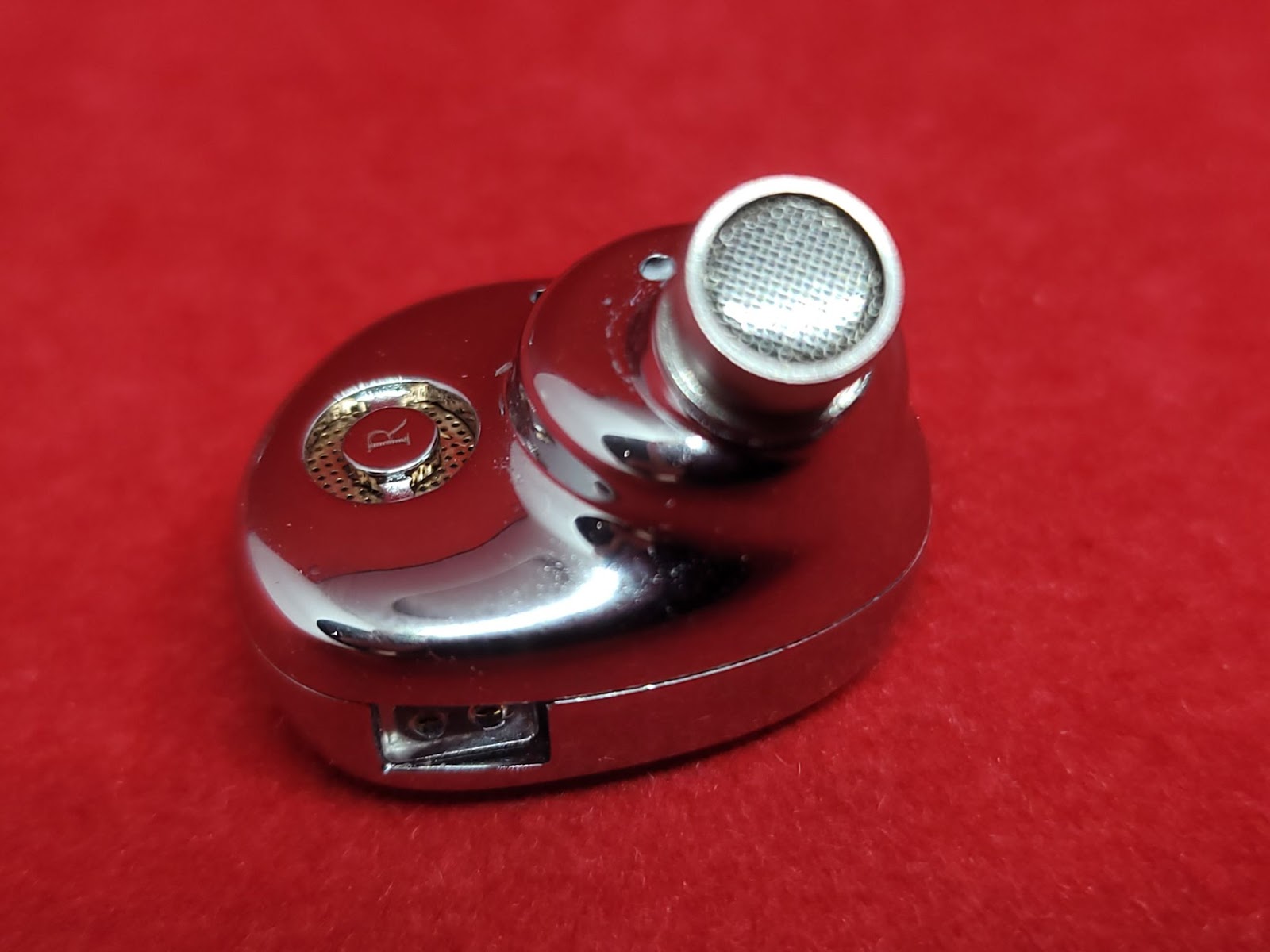
Treble is again pronounced and colored, but in a tasteful way. I mostly prefer bright tuning to a darker one if it’s not too peaky or piercing and EA1000 is definitely not that. Again, a more tamer nozzle offering could make these IEMs appeal to a wider audience. Also I feel as though EA500LM was easier to listen to because the higher bass level was balancing out the treble nicely even though it measures brighter.
Simgot IEMs have always been among the most technically adept products in their price range and EA1000 is no exception. If you think EA500 is good, wait until you try EA1000. Yes, sparkly treble helps with details that it feels like cheating but if making a bright IEM was enough to be detailed, everyone would go for that sound signature. Simgot uses good parts and it pays off. Treble is more controlled than similarly tuned IEMs, even Simgot’s own.
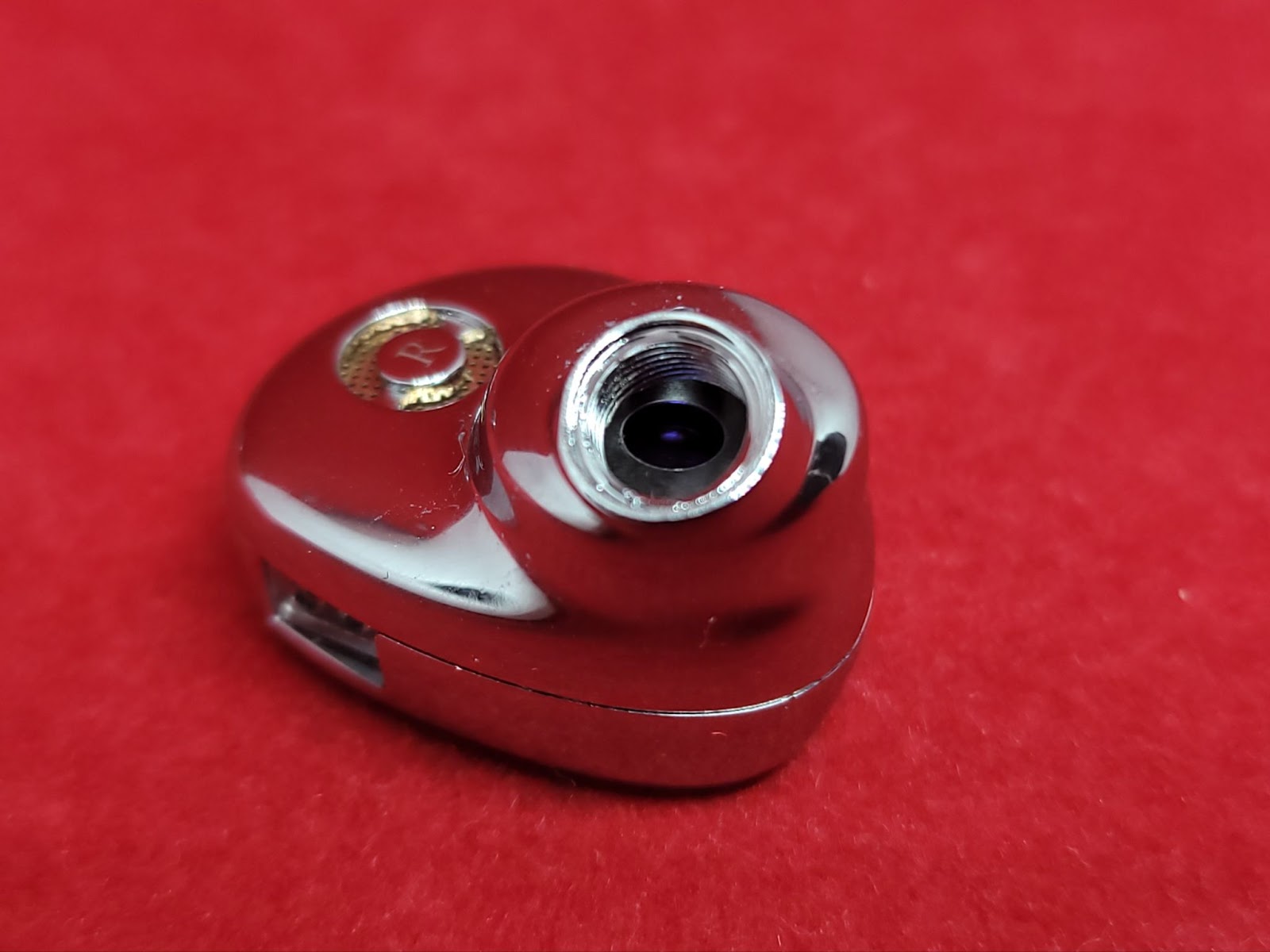
Headstage on Simgot is very three-dimensional and I don’t use this word too often to describe the headstage/soundstage. It feels spacious but more than that it feels immersive and on point. Neither depth nor width feels more exaggerated than the other. Imaging and layering is very precise. Timbre is mostly great too.
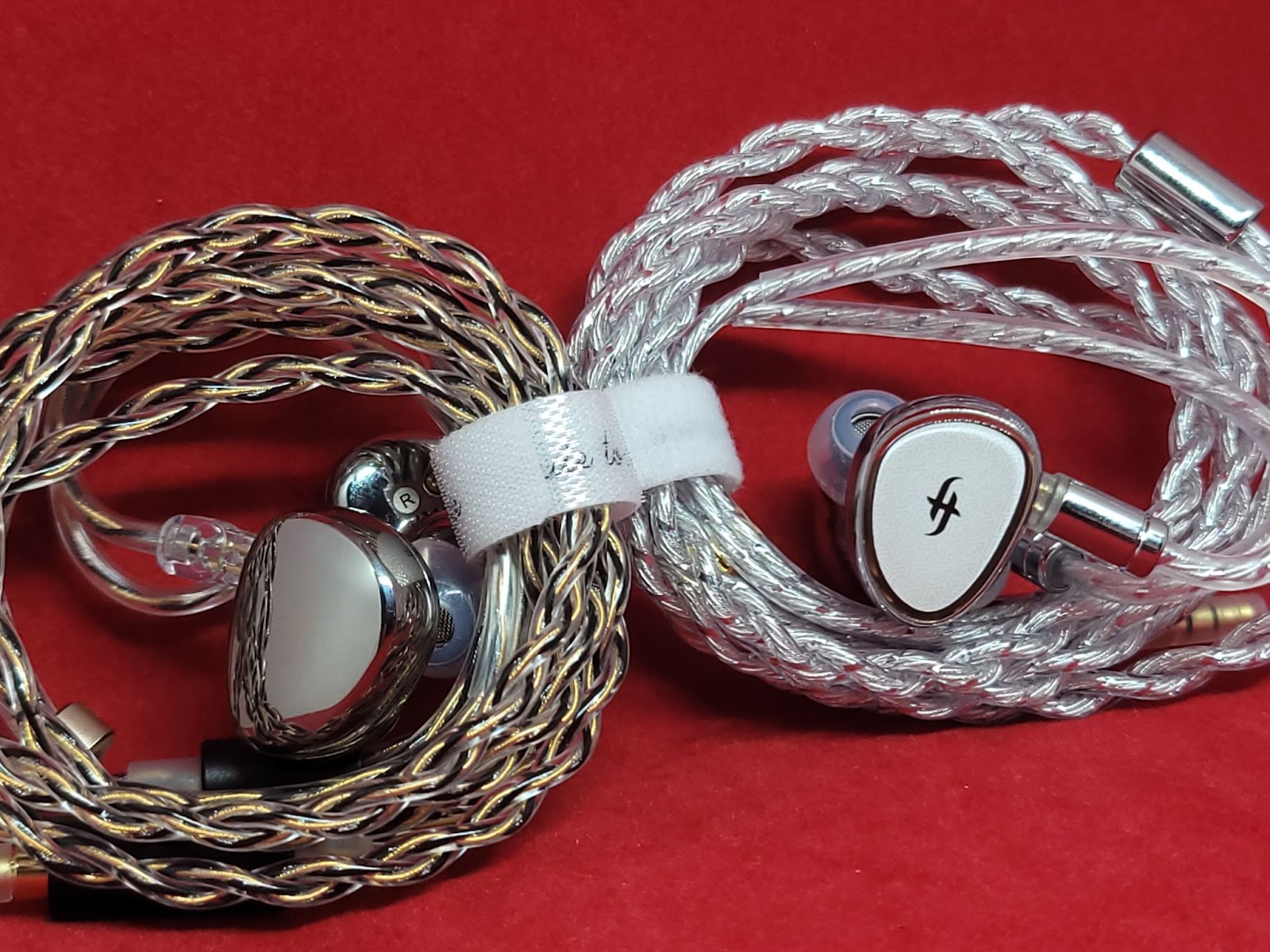
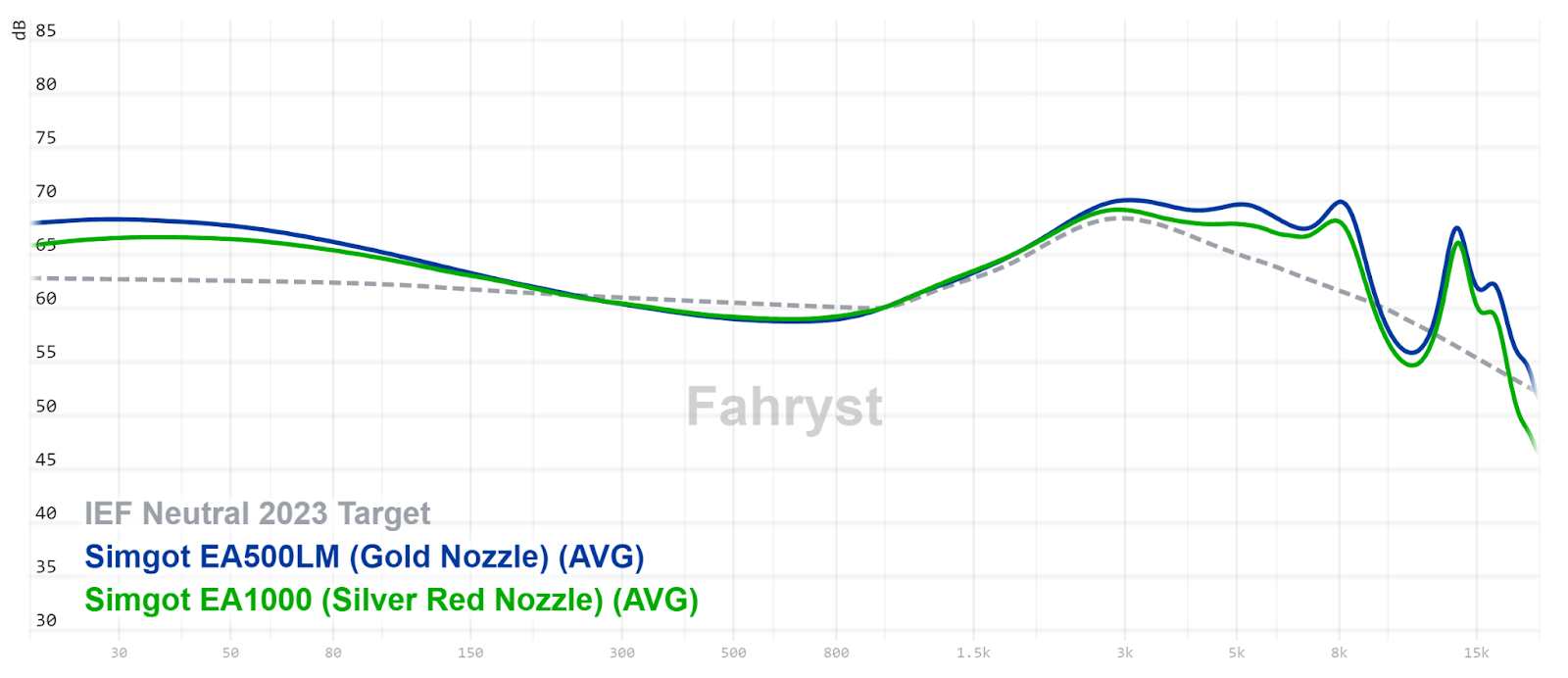
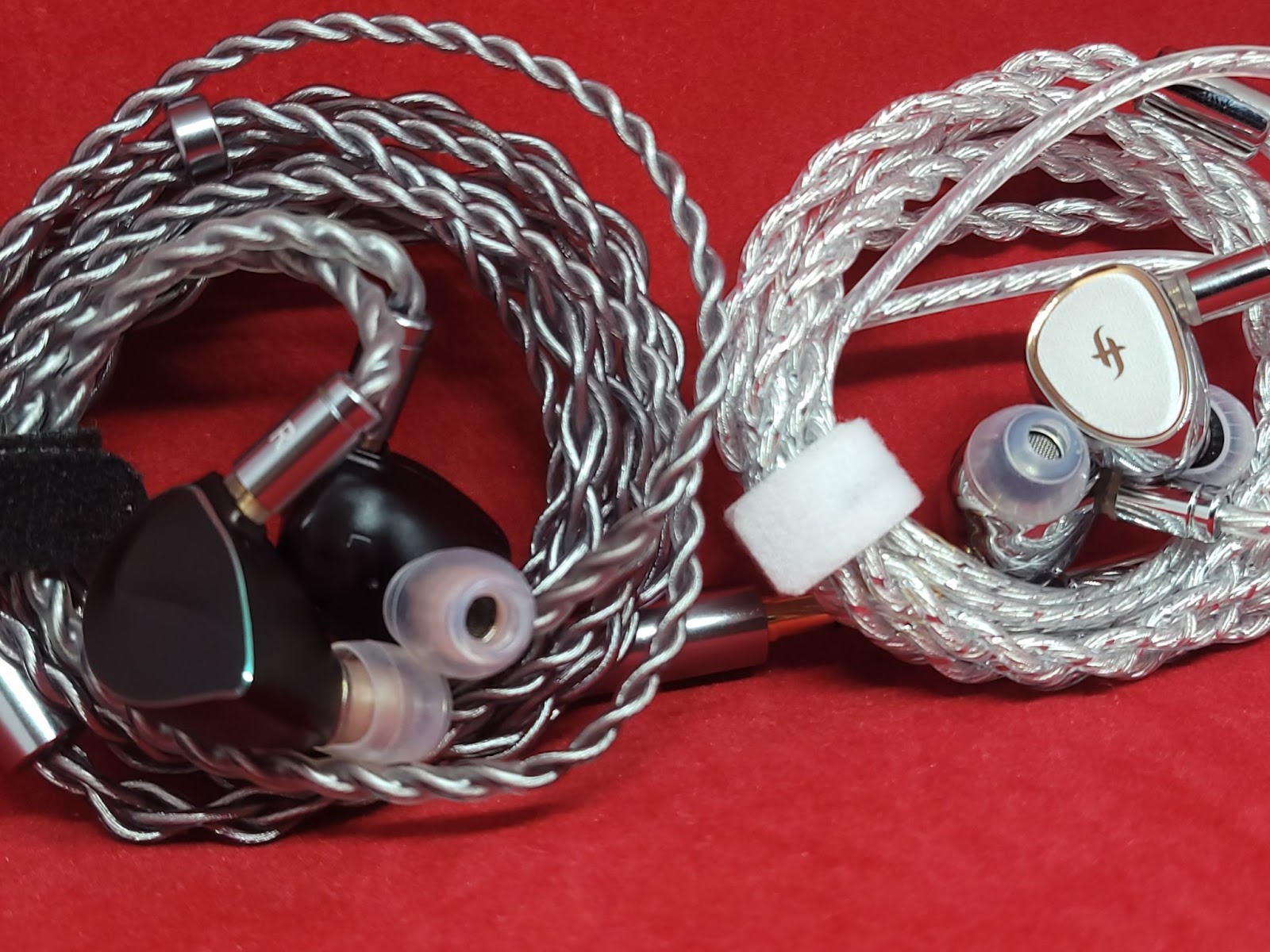
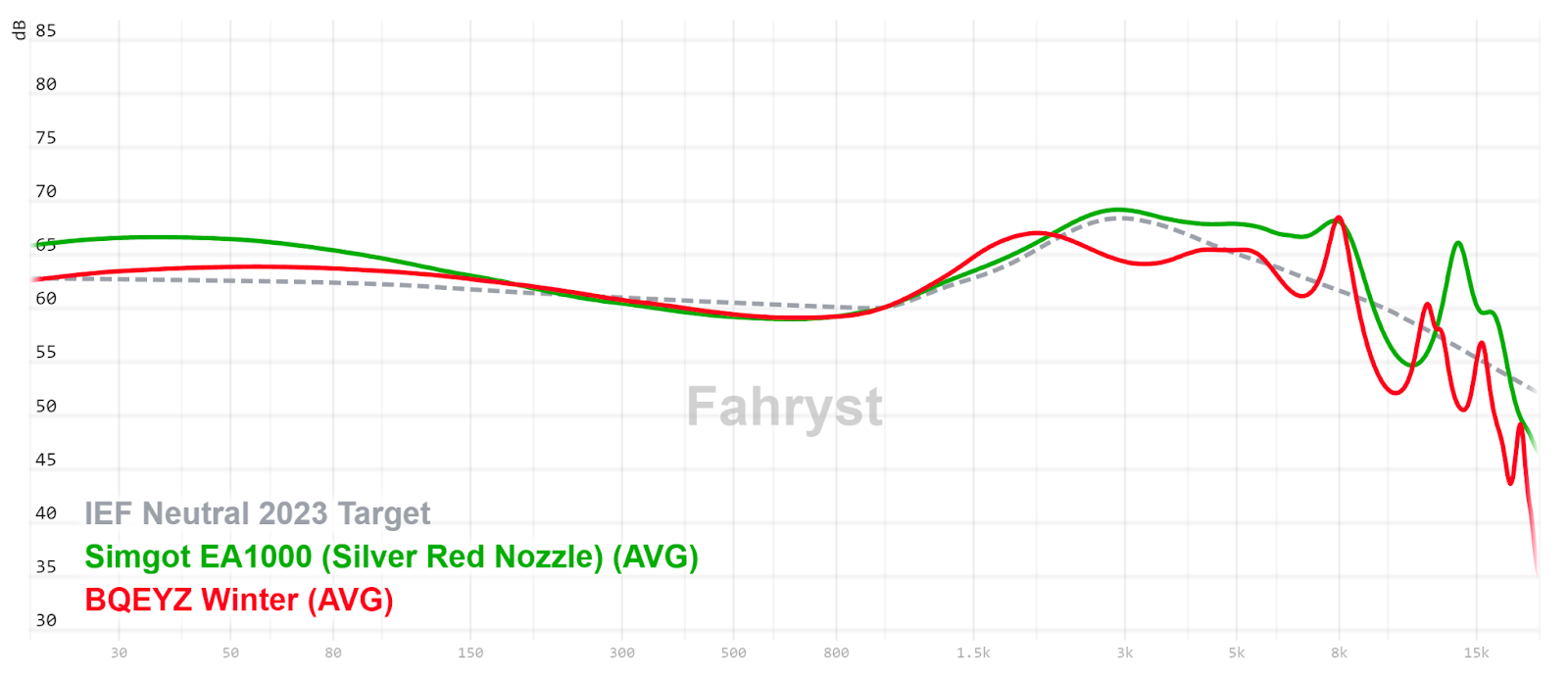
When I review a Simgot product, even I question my own objectivity. But they almost always deliver what I look for in IEMs. In EA1000 Fermat’s case, it provides a very balanced and highly technical listening without any balanced armatures, piezoelectric or planar magnetic drivers. I never could feel comfortable with multi driver IEMs as much as I did with single DDs, maybe that’s why I’m biased. With a Simgot’s single DDs, you don’t feel you are missing out and EA1000 is the ultimate form of this experience. The only criticism I can give is that they could make the alternative tuning nozzles in a way to appeal to the treble sensitive audience too. Other than that, I have no complaints and definitely going to keep EA1000 Fermats.
Disclaimers
Simgot EA1000 Fermat was provided to me by Simgot for free and I only paid for the customs fee. As I always say, everyone is biased one way or another so take everything you read with a grain of salt. Also I will try to be more concise and to the point in my reviews from now on without worrying about the word count etc. If you have any questions, please ask me in the comments and I will try to answer them to the best of my abilities.
Build and Accessories of Simgot EA1000
I think at this point, everyone is pretty familiar with Simgot IEMs high build quality. Shells are, as always, fully made out of CNC’d metal. But there are a few twists on EA1000 that solidifies its place as Simgot’s best offering. Faceplate has a beautiful pattern and a glass cover on top of it, so I can’t exactly call it a fingerprint magnet anymore. On the inner side there is a big vent placed on top of the passive radiator. Yes, the EA1000 has a passive radiator per side apart from the dynamic drivers.
The unboxing experience of EA1000 is also above its brothers. The box is slightly bigger and fancier than usual. When you open the cover inside, you are greeted with a card that explains Fermat’s last theorem and which also acts as a warranty card. The carrying case you get with EA1000 is also fancier. The provided cable is again a single 3.5 mm terminated single ended one but this time thicker. This time you get two sets of eartips instead of one, unlike EA500s and EM6L.
EA1000 comes with 3 pairs of tuning nozzles. Among them silver nozzles with red rings were the most balanced ones, so I used them mostly during my test.
Sound of Simgot EA1000
Tonality
EA1000 targets the bright kind of Harman curve like most of the other Simgot IEMs. So if you used other Simgots like EA500 before, EA1000 will both feel familiar but impress you at the same time.
,
Bass on EA1000 is the most distinguishing feature of the set. It’s one of the most defined and well-textured bass I’ve heard around this price range. It’s not exaggerated, just slightly north of what I would call neutral. It doesn’t dig too deep into the subbass either but it’s enough. There is enough warmth without muddying mids too much. Decay is on point, not too fast to feel dry but fast enough to not feel sloppy.
Mids are, in classic Simgot fashion, highlighted, especially the upper mids. For some, I can see it being shouty or intense. Still I mostly like this kind of presentation, and I think most female vocal lovers will like it as well. However, I also think Simgot could provide nozzles that are tamer instead of more intense.
Treble is again pronounced and colored, but in a tasteful way. I mostly prefer bright tuning to a darker one if it’s not too peaky or piercing and EA1000 is definitely not that. Again, a more tamer nozzle offering could make these IEMs appeal to a wider audience. Also I feel as though EA500LM was easier to listen to because the higher bass level was balancing out the treble nicely even though it measures brighter.
Technicalities
Simgot IEMs have always been among the most technically adept products in their price range and EA1000 is no exception. If you think EA500 is good, wait until you try EA1000. Yes, sparkly treble helps with details that it feels like cheating but if making a bright IEM was enough to be detailed, everyone would go for that sound signature. Simgot uses good parts and it pays off. Treble is more controlled than similarly tuned IEMs, even Simgot’s own.
Headstage on Simgot is very three-dimensional and I don’t use this word too often to describe the headstage/soundstage. It feels spacious but more than that it feels immersive and on point. Neither depth nor width feels more exaggerated than the other. Imaging and layering is very precise. Timbre is mostly great too.
Comparisons
Simgot EA1000 (Silver with Red ring) vs EA500LM (Gold Nozzle)
- EA500LM’s bass is slightly more impactful but EA1000’s bass is impactful enough and more textured. EA500LM also extends deeper into the subbass and rumbles more.
- Vocals are clearer on EA1000. The EA500LM has slightly more body and note weight.
- Both are bright IEMs and have similar intensity and tendency to sibilance in the upper mids and lower treble but EA500LM has slightly more energy in the mid treble and above so cymbals and hi-hats are more splashy, still it’s balanced out with more bass. On the other hand EA1000 still feels more controlled.
- Headstage of the EA1000 is more spacious and three-dimensional. EA1000 is also more resolving. Even though the EA500LM has more air, the EA1000 feels more effortless. It renders and layers better. Both have great imaging but EA1000 staging helps its imaging more. Timbre is great on both. If EA1000 was just an EA500 with a passive radiator, that would explain bass detail and texture but obviously it’s more than that.
Simgot EA1000 vs BQEYZ Winter
- EA1000 is bassier. Bass on Winter is fast, tight but not as impactful. Subbass extension is also better on EA1000.
- Vocals are more forward on EA1000. Winter is kind of in the similar vein but vocals are more natural and in line with the rest of the track.
- EA1000 overall brighter but Winter has some emphasis where bone conduction driver kicks in. Above 6k Winter emphasizes “S”s, “Sh”s and “T”s slightly. Male vocals are more likely to get sibilant on EA1000 with volume while females get sibilant first on Winter.
- Both have great detail rendition. EA1000 pushes the detail more in your face however, so if you are after the ultimate detail between the two, EA1000 wins. On the other hand Winter has a deeper head stage and imaging more precise. I like the timbre on Winter slightly more as the EA1000 can get a little metallic compared to that.
Conclusion
When I review a Simgot product, even I question my own objectivity. But they almost always deliver what I look for in IEMs. In EA1000 Fermat’s case, it provides a very balanced and highly technical listening without any balanced armatures, piezoelectric or planar magnetic drivers. I never could feel comfortable with multi driver IEMs as much as I did with single DDs, maybe that’s why I’m biased. With a Simgot’s single DDs, you don’t feel you are missing out and EA1000 is the ultimate form of this experience. The only criticism I can give is that they could make the alternative tuning nozzles in a way to appeal to the treble sensitive audience too. Other than that, I have no complaints and definitely going to keep EA1000 Fermats.
Jarlaxle
100+ Head-Fier
Pros: Low price
Good fit security and comfort
Decent isolation
Decent quality bass
Getting a pair of TRN T-Ear tips
Good fit security and comfort
Decent isolation
Decent quality bass
Getting a pair of TRN T-Ear tips
Cons: Shouty and harsh sounding out of the box
Needs an easy mod to sound decent
Nothing else at this price
Needs an easy mod to sound decent
Nothing else at this price
TRN is mostly known for their budget offerings and CS4 is one of them. Until these were offered to be sent to me, I wasn’t even aware that they existed. So here I am letting you know that these exist.
This barebones set of IEMs starts from 9.90 USD. If you want a cable with a microphone you need to pay another dollar and if you want a USB-C type connector instead of a 3.5 mm you need to pay 11.90 USD.
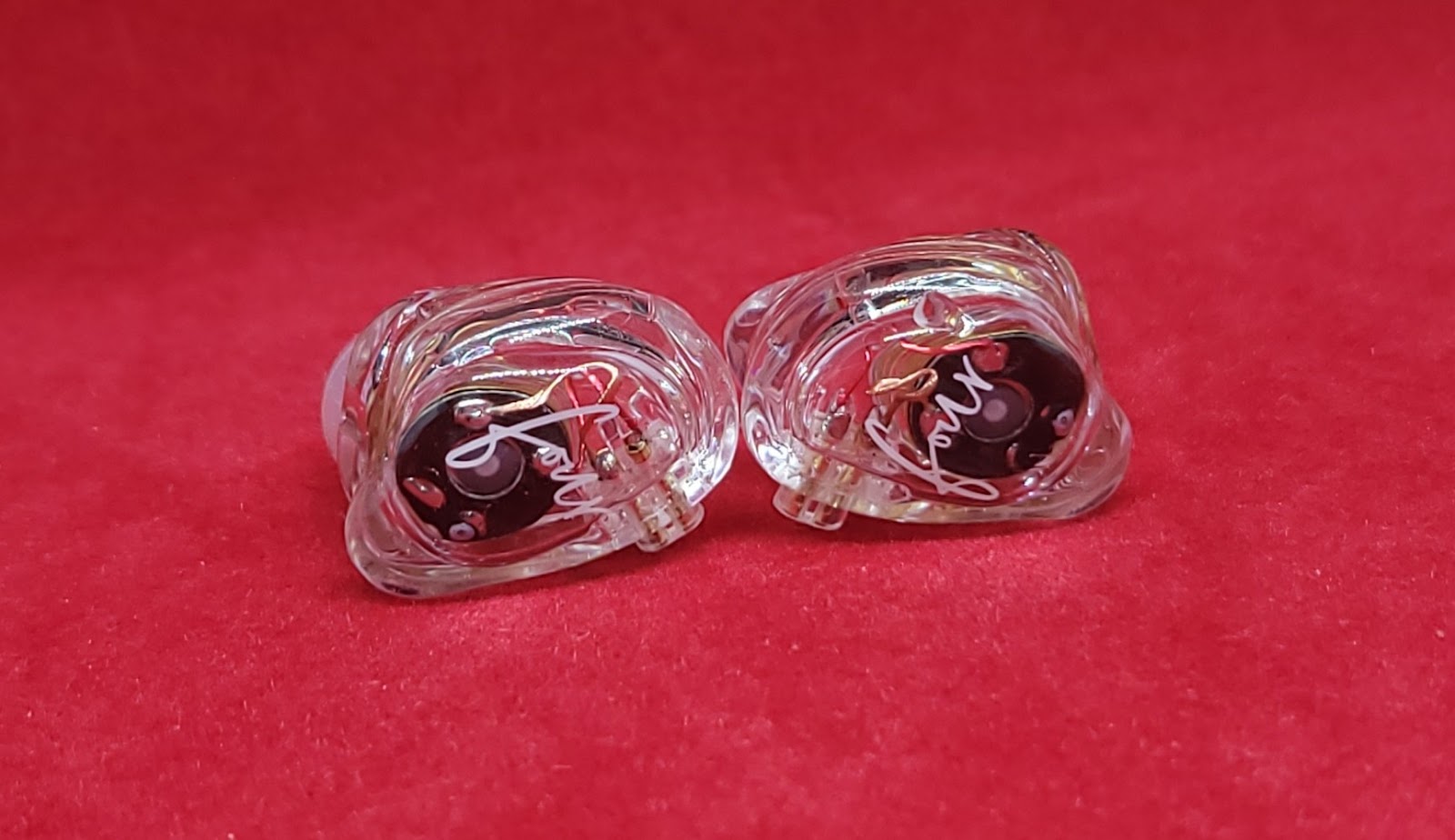
TRN CS4 was provided to me by Cloris from shenzhenaudio.com for free. As I always say, everyone is biased one way or another so take everything you read with a grain of salt. Also I will try to be more concise and to the point in my reviews from now on, without worrying about the word count etc. If you have any questions, please ask me in the comments and I will try to answer them to the best of my abilities.
If you had bought any cheap KZ, QKZ or TRN, the packaging is exactly that: a small box with earpieces, a cable, a set of generic eartips inside. There is also a pair of TRN’s own medium size T-Ear tips on the earpieces which was a welcome surprise.
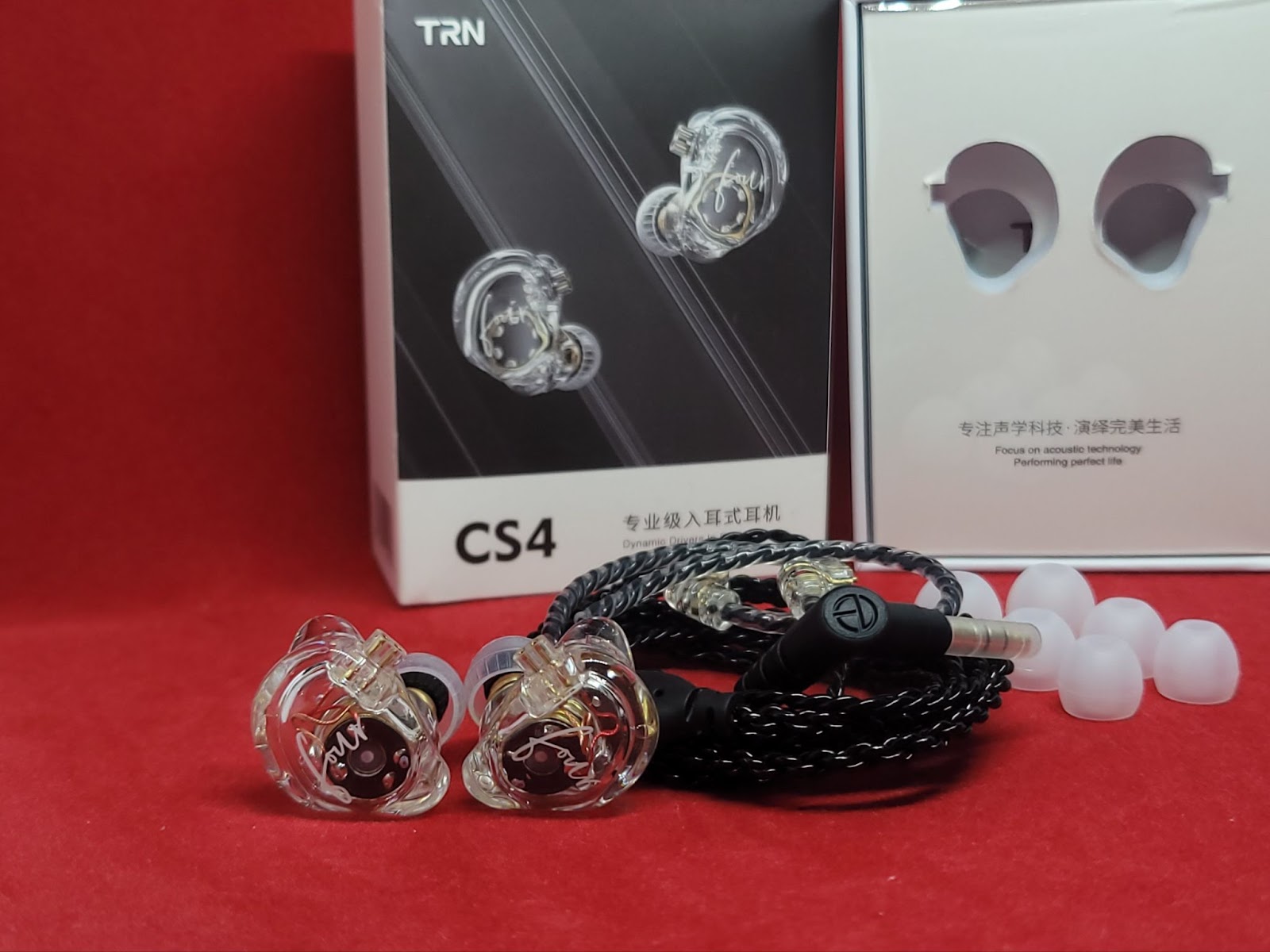
CS4’s build is nothing out of the ordinary for an IEM in this price range. It’s plastic, in fact its build is identical to Tangzu Wan’er’s so if you have a problem with that, you can look elsewhere (and probably pay more). However, the shape of the shells is very ergonomic. They might be the best fitting IEMs for me. They stay very securely in my ears. If only they didn’t start to hurt after a while but I’m sure it’s because of the unusual shape of my ears, not the IEMs.
I wasn’t expecting much from CS4 and it didn’t deliver much at first but let me explain. CS4 doesn’t sound very good out of the box. It sounds fine to a degree with a healthy amount of bass and excess energy around the upper midrange.
Bass is relatively fast and tight, I have heard worse bass from sets more expensive than these. With the great seal and isolation they extend deep into the subbass, more than the graphs would indicate.
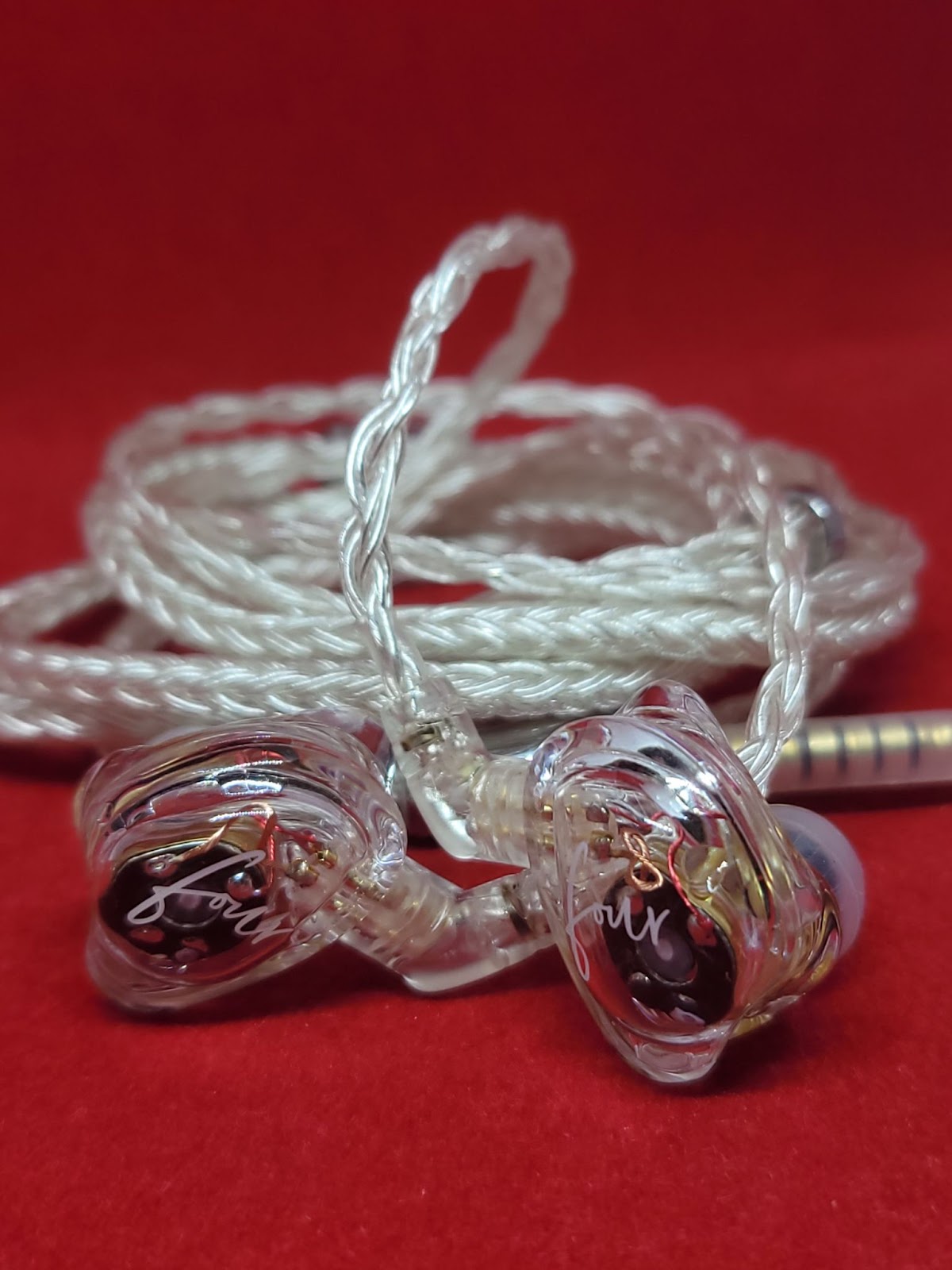
There is minimal bass bleed into the lower mids so there is a slight warmth to the tone but not much. Upper mids are just too much. If you listen at a low volume, it won’t bother you much but as soon as you raise the volume, CS4 begins to screech and shout.
Treble energy is slightly excessive, especially in the lower treble. However, the extension is better than I expected for a single DD at this price. There is a decent amount of detail and sparkle.
After noticing there is more life in these I decided to slap a Tanya filter on the nozzles to tame the upper mids and Voila! They turned into a very good set of IEMs. Bass was tight so they could handle some more without getting muddy too much. mids and treble became much more agreeable and treble extension wasn’t affected at all!
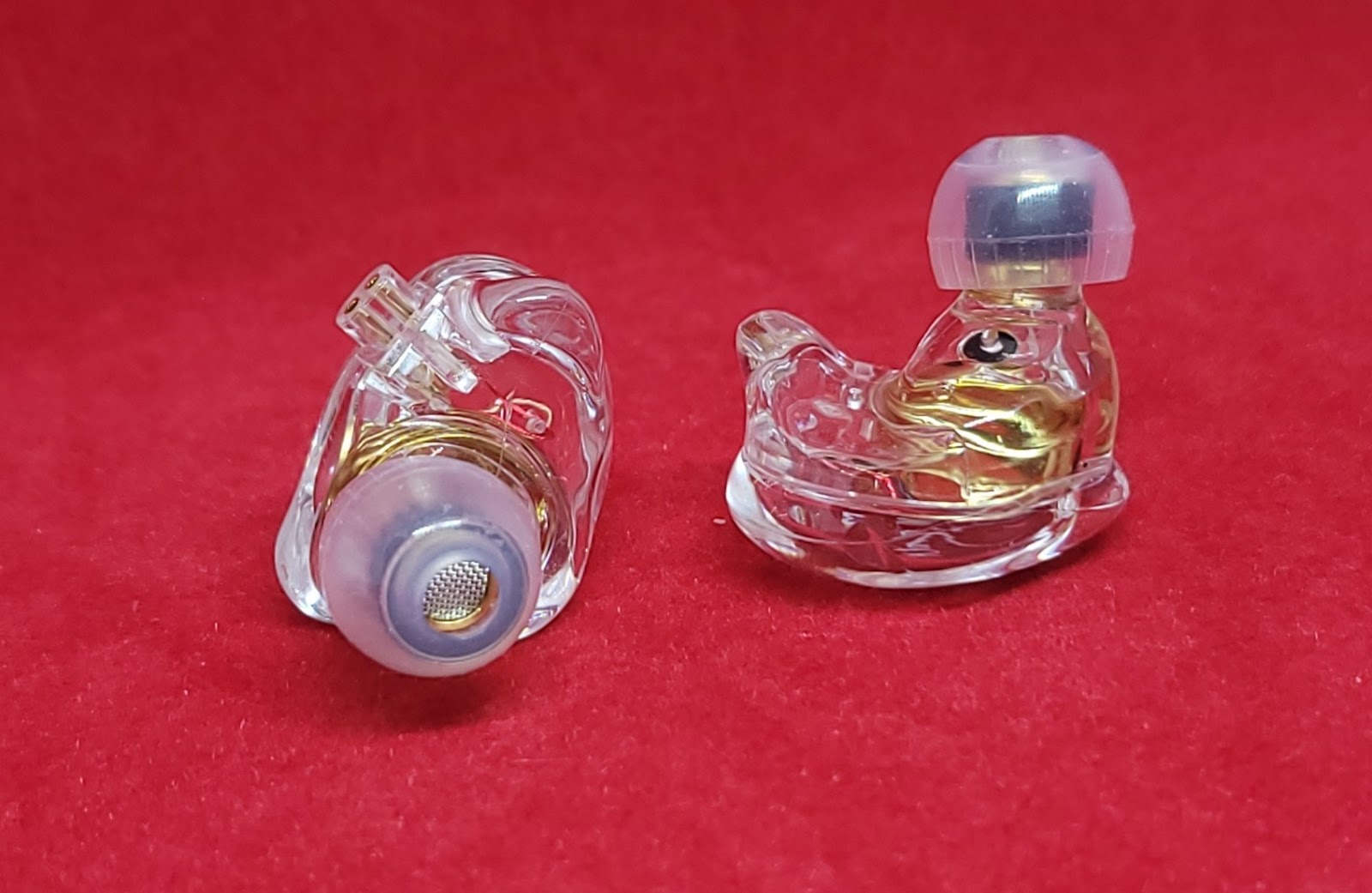
Speaking of technicalities or subjective experience of an IEM at this price feels kind of weird but I can say CS4 fared better than some of the 20 USD IEMs on the market in some aspects. It has good treble energy and decent details. The headstage is also fine along with the imaging, again for the price.
I didn’t want to put CS4 against too many other IEMs that are more expensive. Instead I compared them with and without the mods to my ultra budget benchmark Tangzu Wan’er. All of the comparisons made by volume matching at 1 kHz.
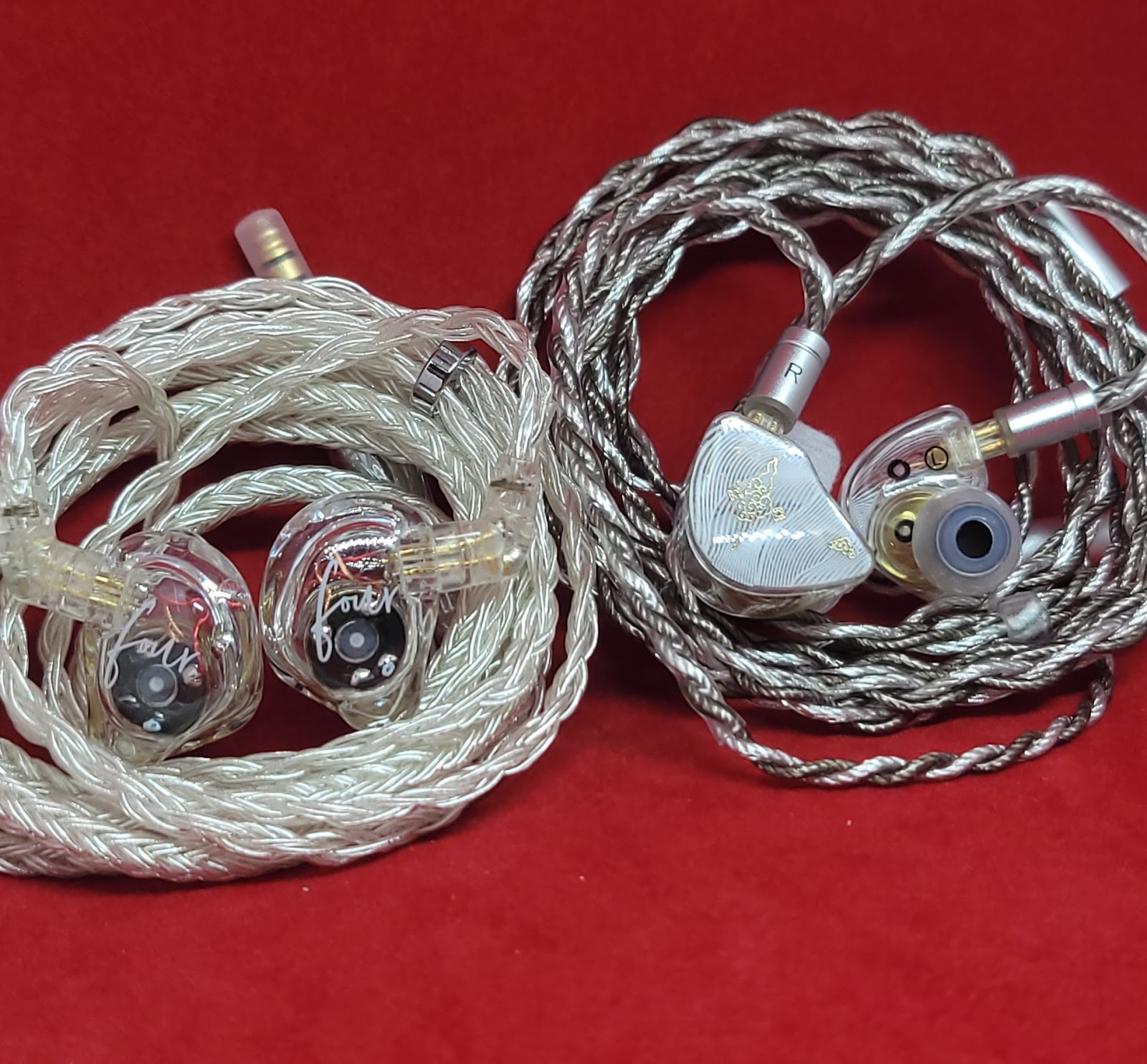
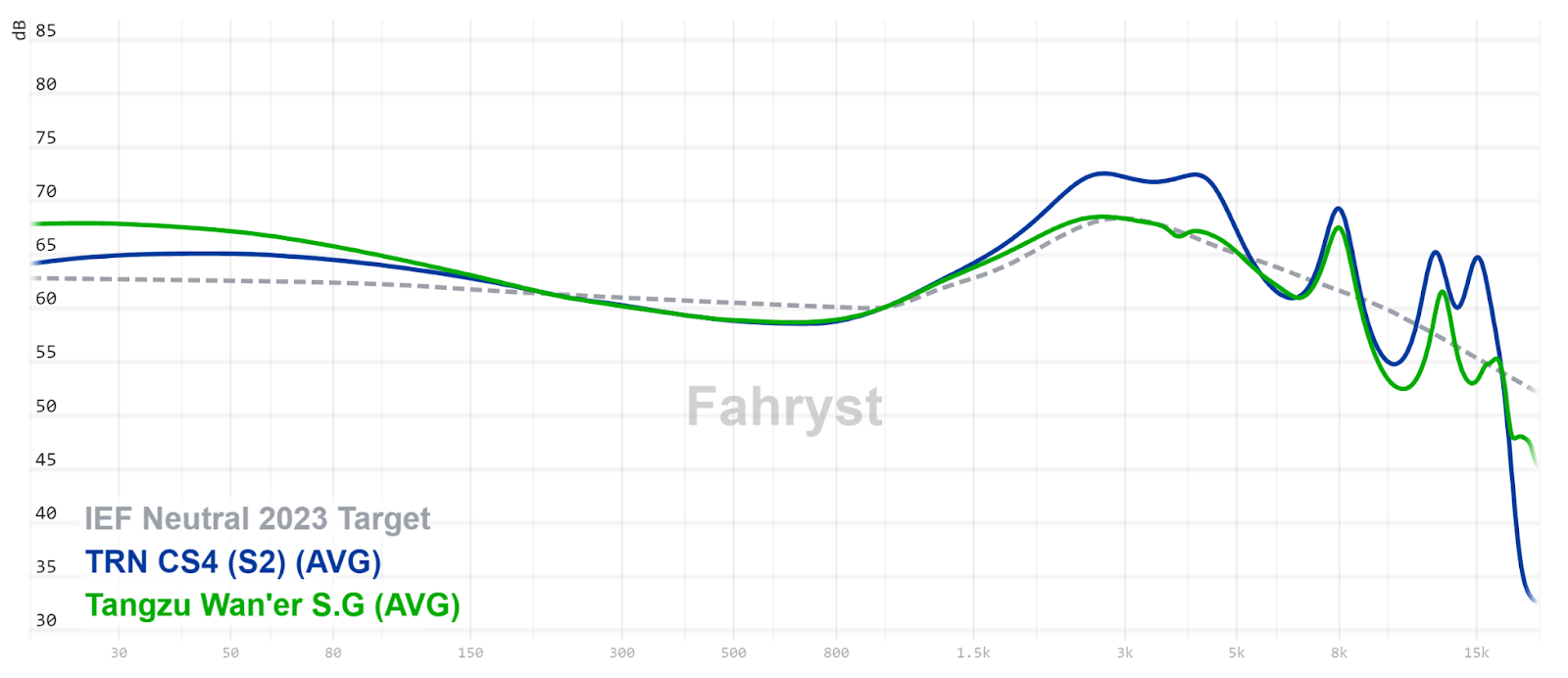
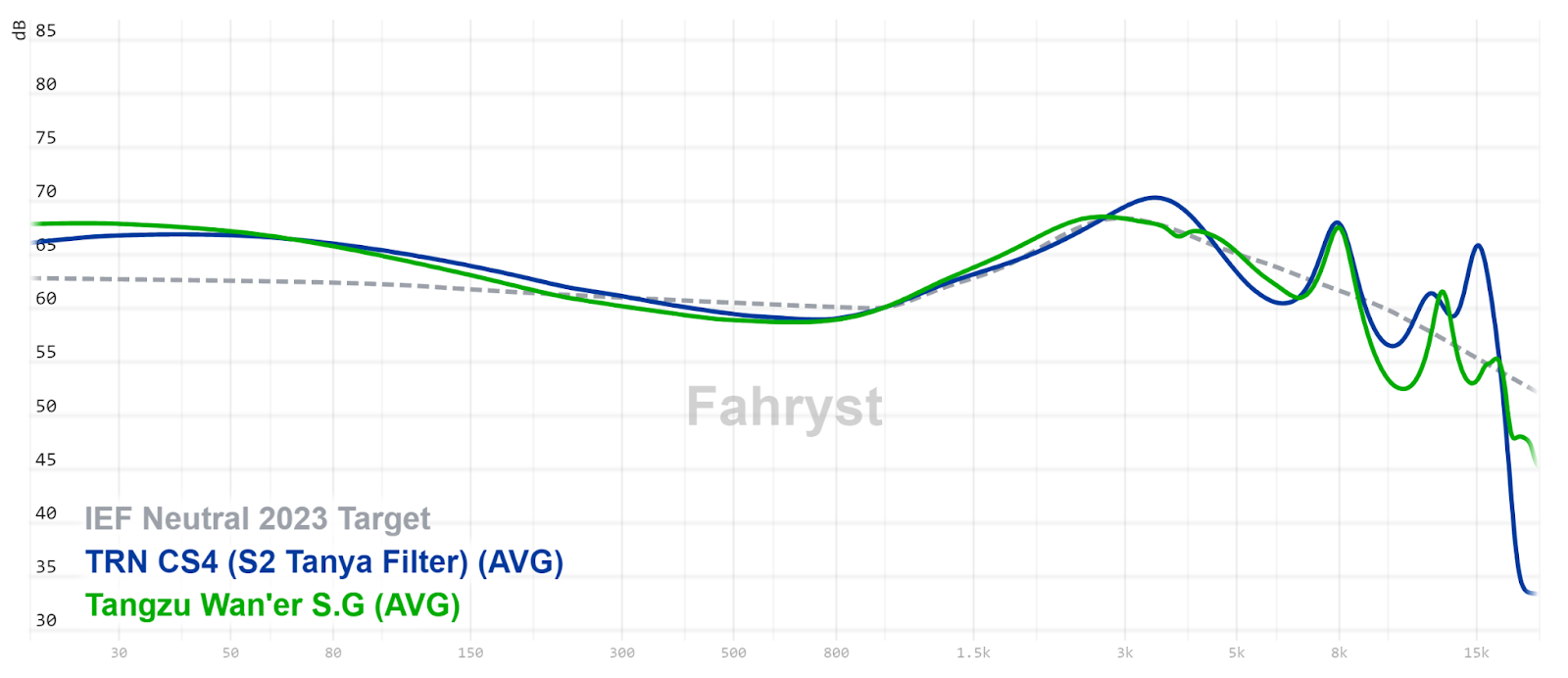
The CS4 review was one of those that made me feel “ugh whatever” at first. But after making that easy mod, they started to sound pretty good. Fit security and comfort are also one of the best I have ever experienced. So while I can’t really say go out and buy them, if you have some filters lying around, you won’t miss the 10 dollars you’ve spent on these. Also I imagine they would perform well in gaming even without a mod but I haven’t tested that unfortunately. If TRN comes up with a gaming variant of these with a boom mic, I probably would have less problems recommending that.
This barebones set of IEMs starts from 9.90 USD. If you want a cable with a microphone you need to pay another dollar and if you want a USB-C type connector instead of a 3.5 mm you need to pay 11.90 USD.
Disclaimers
TRN CS4 was provided to me by Cloris from shenzhenaudio.com for free. As I always say, everyone is biased one way or another so take everything you read with a grain of salt. Also I will try to be more concise and to the point in my reviews from now on, without worrying about the word count etc. If you have any questions, please ask me in the comments and I will try to answer them to the best of my abilities.
Build and Accessories of TRN CS4
If you had bought any cheap KZ, QKZ or TRN, the packaging is exactly that: a small box with earpieces, a cable, a set of generic eartips inside. There is also a pair of TRN’s own medium size T-Ear tips on the earpieces which was a welcome surprise.
CS4’s build is nothing out of the ordinary for an IEM in this price range. It’s plastic, in fact its build is identical to Tangzu Wan’er’s so if you have a problem with that, you can look elsewhere (and probably pay more). However, the shape of the shells is very ergonomic. They might be the best fitting IEMs for me. They stay very securely in my ears. If only they didn’t start to hurt after a while but I’m sure it’s because of the unusual shape of my ears, not the IEMs.
Sound of TRN CS4
Tonality
I wasn’t expecting much from CS4 and it didn’t deliver much at first but let me explain. CS4 doesn’t sound very good out of the box. It sounds fine to a degree with a healthy amount of bass and excess energy around the upper midrange.
Bass is relatively fast and tight, I have heard worse bass from sets more expensive than these. With the great seal and isolation they extend deep into the subbass, more than the graphs would indicate.
There is minimal bass bleed into the lower mids so there is a slight warmth to the tone but not much. Upper mids are just too much. If you listen at a low volume, it won’t bother you much but as soon as you raise the volume, CS4 begins to screech and shout.
Treble energy is slightly excessive, especially in the lower treble. However, the extension is better than I expected for a single DD at this price. There is a decent amount of detail and sparkle.
After noticing there is more life in these I decided to slap a Tanya filter on the nozzles to tame the upper mids and Voila! They turned into a very good set of IEMs. Bass was tight so they could handle some more without getting muddy too much. mids and treble became much more agreeable and treble extension wasn’t affected at all!
Technicalities
Speaking of technicalities or subjective experience of an IEM at this price feels kind of weird but I can say CS4 fared better than some of the 20 USD IEMs on the market in some aspects. It has good treble energy and decent details. The headstage is also fine along with the imaging, again for the price.
Comparisons
I didn’t want to put CS4 against too many other IEMs that are more expensive. Instead I compared them with and without the mods to my ultra budget benchmark Tangzu Wan’er. All of the comparisons made by volume matching at 1 kHz.
TRN CS4 (stock) vs Tangzu Wan’er
- Vocals are much more forward and shouty on CS4. It’s too husky and breathy and tends to get sibilant.
- Bass level is similar on both, but on CS4, it is tighter and and slightly more impactful. I get more subbass extension from the CS4 probably because of a better seal.
- Instruments like guitars and piano are more forward on CS4, just not as much as vocals.
- CS4’s treble is above neutral and fatiguing. Definitely not suitable for loud level listening. Wan’er’s treble is much more relaxed.
- CS4 is more detailed with lots of sparkle. Wan’er is more smeared over. CS4 also sounds more open but you feel closer to the stage and artist. Imaging and separation is better on CS4.
TRN CS4 (modded) vs Tangzu Wan’er
- CS4’s bass is more impactful and rumbly. Thanks to the seal and isolation, it also extends more into the subbass.
- Vocals on Wan’er are more forward.
- CS4 has a thicker note weight with the mod.
- Wan’er is more likely to get sibilant with volume.
- Wan’er has a more natural timbre than CS4.
- Electric guitars are more prominent on CS4.
- Wan’er has a more relaxed treble overall, CS4 has more energy in the treble and more air.
- CS4 has a more enveloping staging and feels more spacious.
- CS4 is more detailed although neither is very resolving, there are cheap sets after all. CS4 also has better imaging and separation.
Conclusion
The CS4 review was one of those that made me feel “ugh whatever” at first. But after making that easy mod, they started to sound pretty good. Fit security and comfort are also one of the best I have ever experienced. So while I can’t really say go out and buy them, if you have some filters lying around, you won’t miss the 10 dollars you’ve spent on these. Also I imagine they would perform well in gaming even without a mod but I haven’t tested that unfortunately. If TRN comes up with a gaming variant of these with a boom mic, I probably would have less problems recommending that.
Jarlaxle
100+ Head-Fier
Pros: Cool design
Flagship level configuration
Class A amplification
Fast operation
Android 12
Systemwide parametric EQ
Very neutral and natural sound
Flagship level configuration
Class A amplification
Fast operation
Android 12
Systemwide parametric EQ
Very neutral and natural sound
Cons: Battery life
Low power output
Side buttons are hard to feel and press with the leather case on
Lack of volume wheel
Low power output
Side buttons are hard to feel and press with the leather case on
Lack of volume wheel
R6 Pro II is, as the name implies, the second iteration of the improved Pro version of the R6 line of Digital Audio Players from Hiby. Although I have known and followed Hiby as a company, R6 Pro II is the first of their products I have actually used. Retailing at 749 USD, this DAP has some impressive specs to boast about.
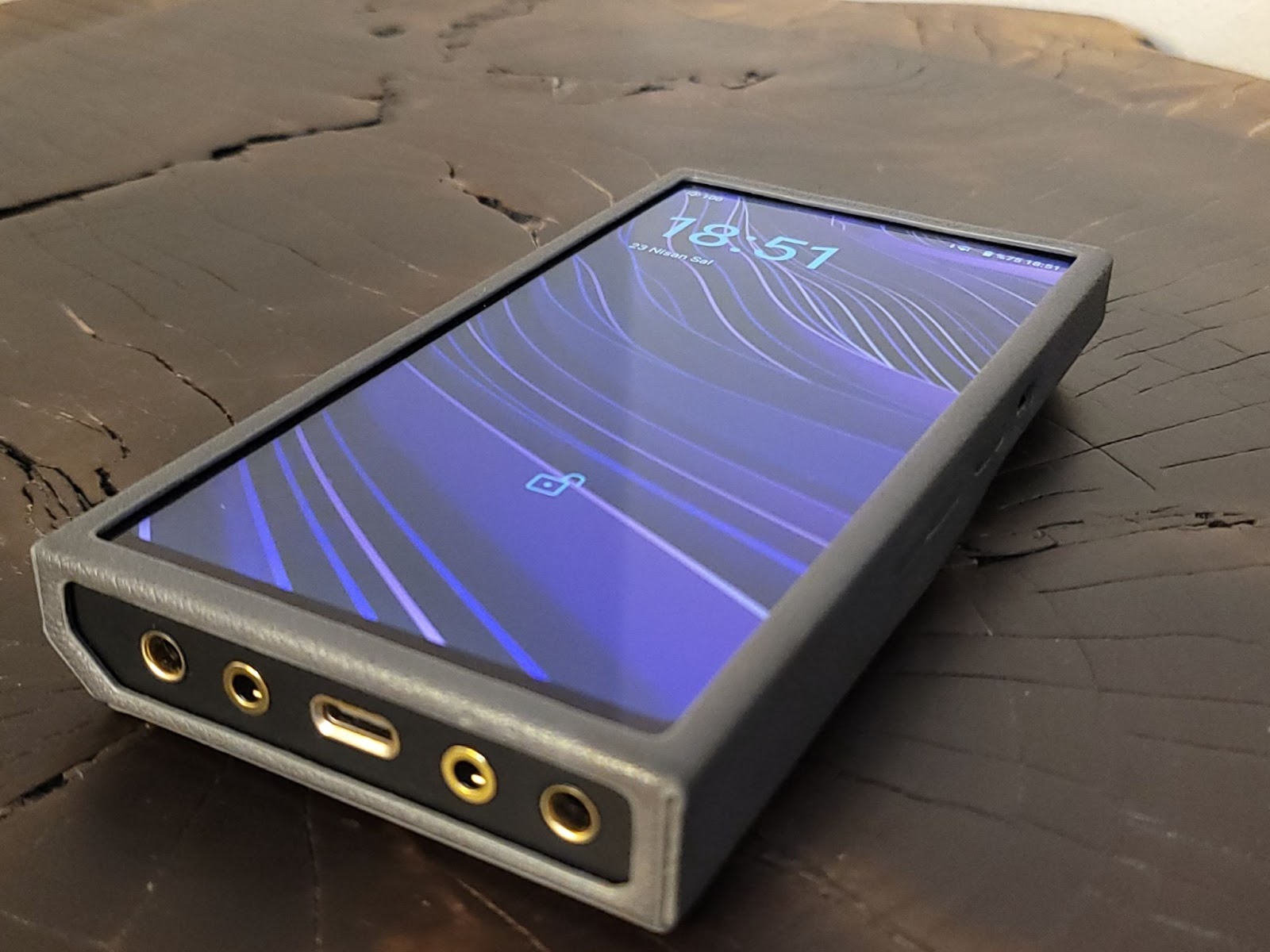
I bought R6 Pro II with my own money from a friend pre-used so, of course I didn’t pay the full price if that matters. I have been using the device for some time as my personal unit, therefore review includes my own long term user experience as well. As I always say, everyone is biased one way or another so take everything you read with a grain of salt. Also I will try to be more concise and to the point in my reviews from now on without worrying about the word count etc. If you have any questions, please ask me in the comments and I will try to answer them to the best of my abilities.
Hiby was founded in 2011 according to their website and has even more experience in the audio field apparently. They are mostly known for their Digital Audio Players but they also make DAC/Amps and earphones. However, what makes Hiby different from other manufacturers is their expertise in software. Their UIs, apps and connection protocol Hiby Link are used by even other brands.
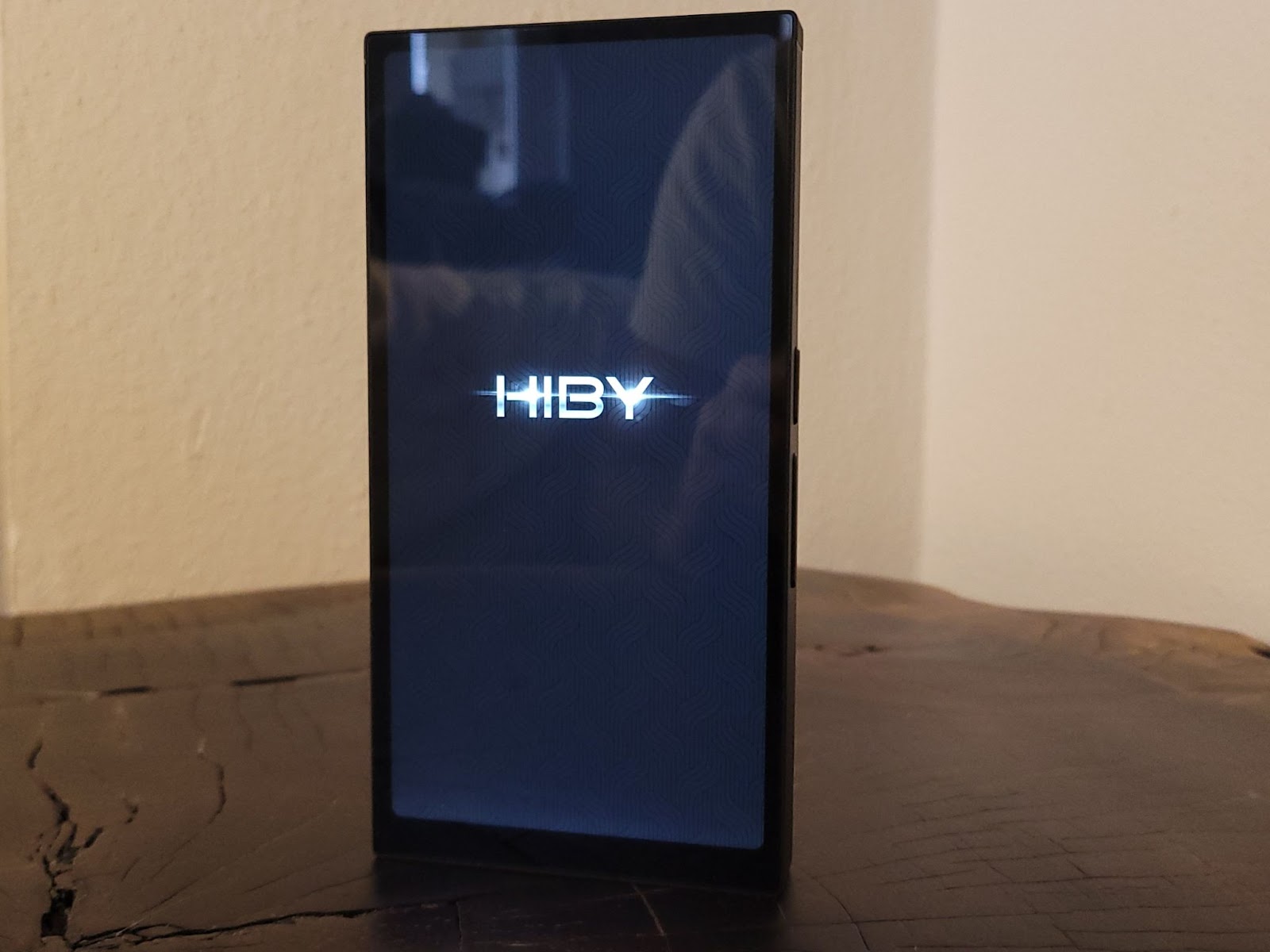
R6 Pro II comes with a rather modest packaging, still it doesn’t feel like missing anything. A leather protective case, spare screen and back glass protectors, a rather thick USB-C to USB-C cable and a USB-C to USB-A adapter is included in the package. Leather case feels sturdy and premium enough and has a great design feature that stretches and closes when the DAP is slid inside. After the loose DX300 case I used for a long time, it is a very welcome change.
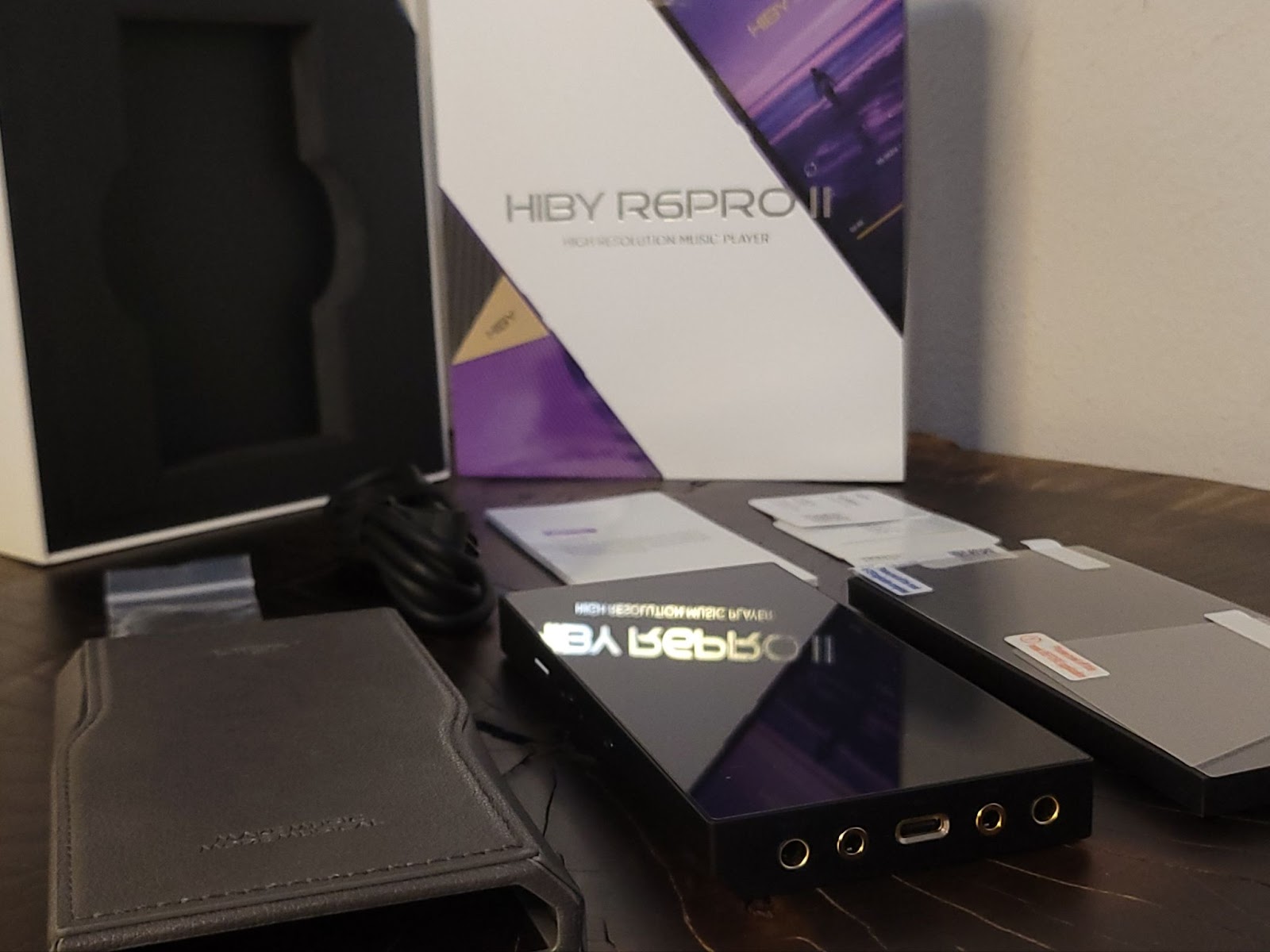
R6 Pro II is a hefty device. In fact it’s heftier than I first thought it would be, definitely more in line with +1k devices. It has a unique asymmetrical wavy design but not as esoteric as Astell&Kern devices. R6 Pro II comes in two colors: Purple and black. Purple comes with a purple case and black comes with a gray case. Honestly I would have liked to have the purple one instead.
Inside, the device used Asai Kasei’s latest DAC chip AK4499EX in dual formation along with their AK4191EQ delta-sigma modulator. Companies like to promote this modulator as another DAC chip but it really isn’t and if I’m not mistaken this modulator was embedded to older chips but in the latest AK4499EX they separated it from the DAC chip instead. Still these chips are flagships of the company and having them in a DAP that’s sold for 749 USD is quite a feat.
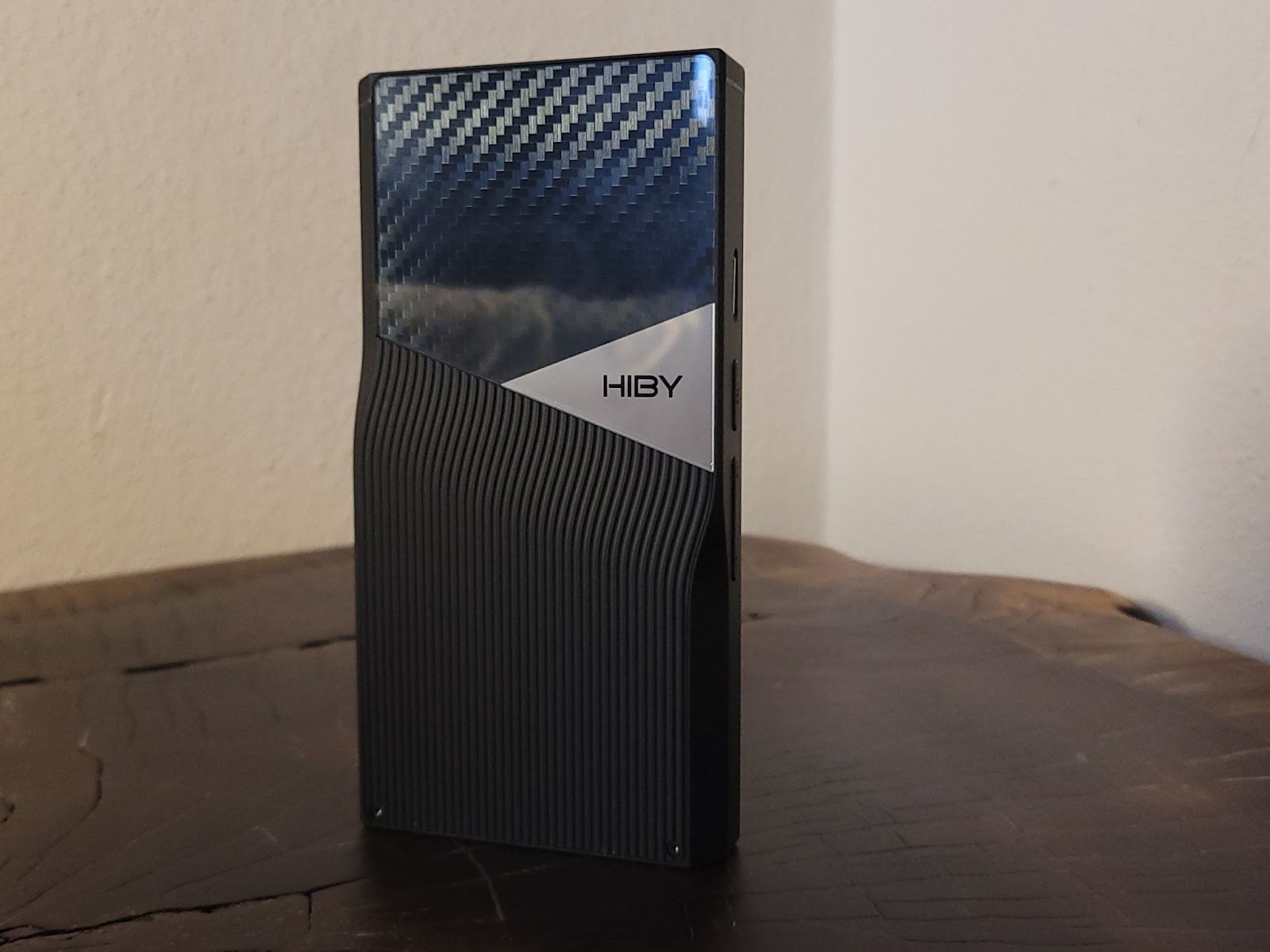
R6 Pro II runs Qualcomm’s Snapdragon 665 processor. While it’s not a flagship or the latest processor on the market, due to batch limitations, it was probably the best one they could offer. However I'm pretty sure it's the fastest processor that’s used in a DAP currently on the market. I had no problem with the operation of the device. It’s always smooth and responsive. Even one of my friends commented that it was faster than his phone.
Device has 4 GBs of RAM which is again enough for the intended use case and 64 GBs of internal storage. You can also add a micro SD card to increase the storage up to 2TBs for your music.
R6 Pro II has an independent amplification circuitry that can provide both class A amplification with dual OPA1652 op amps and class AB amplification. I will describe the differences later in its own section.
5.9” FHD+ screen with minimum bezel thickness gives R6 Pro II a sleek look but Hiby decided to feed all this hardware with 5000 mAh battery which yields suboptimal listening times.
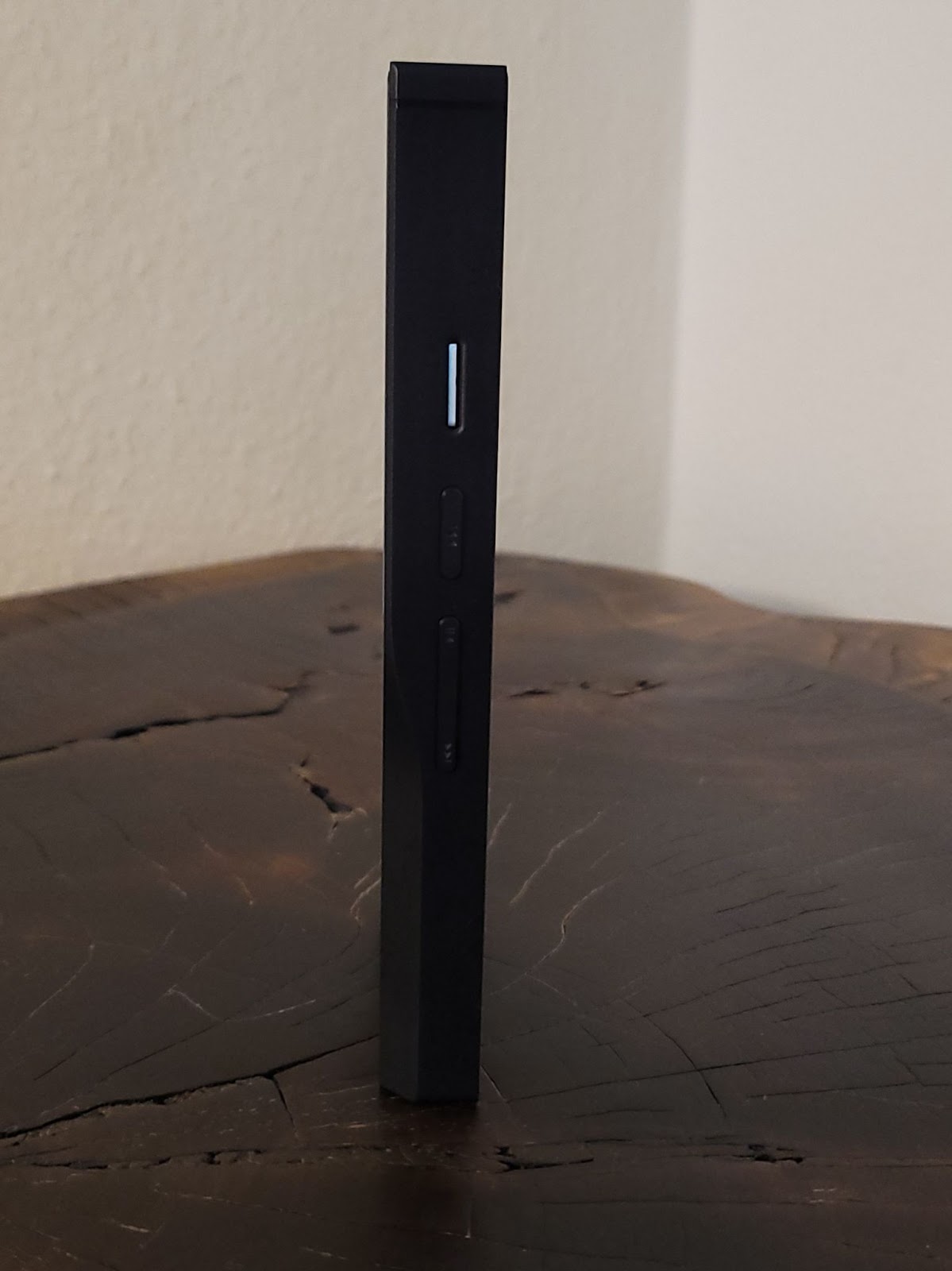
Lastly R6 Pro II supports the usual wireless and wired connectivity options, namely WiFi, Bluetooth 5.0, USB and Coaxial through USB-C output. Analog outputs include 3.5 mm single ended and 4.4 mm balanced. Line outs and phone outs are separated. Device also supports DLNA, Airplay and their own Hiby Link protocols as well as Hiby Cast remote control. It can render X16 MQA too, if that’s important for you. I’m pretty sure there are others I forgot to mention.
So all of these yields to virtually no distortion and noise. Battery life isn’t the best, I got 5 hours and 45 minutes of playing time with streaming in class A mode, low gain and balanced output at volume 50/100 which is louder than my usual listening level, with minimum screen usage. Website says R6 Pro II plays for 5 hours in balanced class A mode so info is more than real. It’s mostly enough for me but competitors offer more so there is that. Class A mode works slightly warm which is expected.
Amplification section isn’t very powerful but should be enough for almost all IEMs and a lot of headphones out there. Max single ended power output is 125 mW and balanced power output is 383 mW.
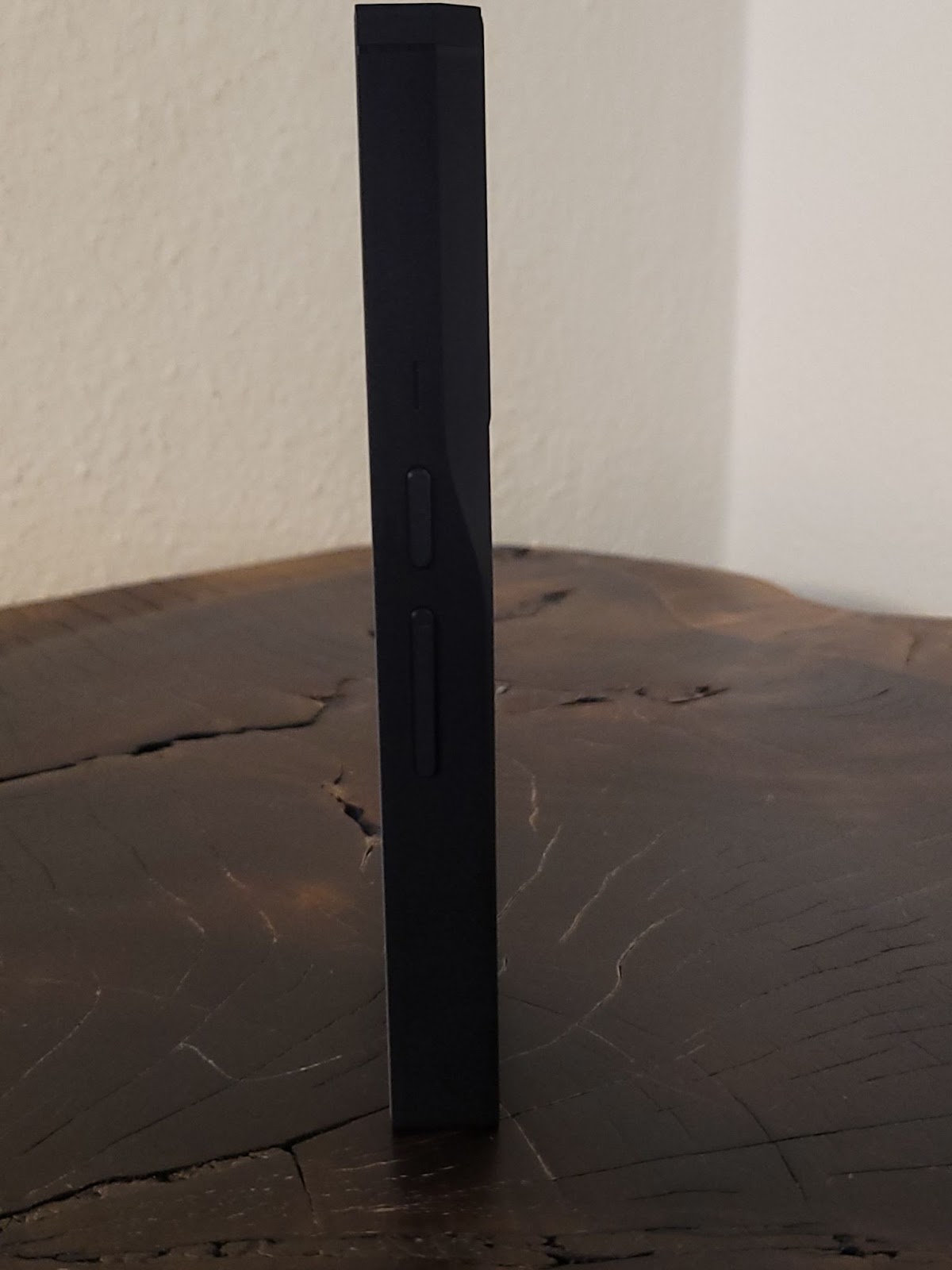
R6 Pro II uses an open Android 12.0 which means you can download any 3rd party apps you want and it should get app updates for quite a while. While Android 14 is out, 12.0 is the newest version among the current DAPs on the market if I’m not mistaken. Hiby Music comes pre-installed as the default music player and I didn’t need to use any other music app since I mostly stream my music.
UI is customized by Hiby for the intended use case. It is not too different from the usual Android experience but changing audio controls like adjusting gain and amplification type is especially very easy.

Hiby’s own MSEB (Mage Sound 8-ball Tuning) is an EQ based easy sound adjustment mechanism. If using EQ is intimidating for you, playing with MSEB can ease you into it. I think it’s a great feature. Here is the list that shows how each choice affects the sound:
1 -- Overall Temperature is a tilt of the whole line towards treble (cool) or bass (warm)
2 -- Bass extension 70Hz and below
3 -- Bass texture 100Hz (medium)
4 -- Note thickness 200Hz (wide)
5 -- Vocals 650Hz (very wide)
6 -- Female overtones 3kHz (tight)
7 -- Sibilance LF 5.8kHz (medium)
8 -- Sibilance HF 9.2kHz (medium)
9 -- Impulse response 7.5kHz (very wide)
10 - Air 10kHz sloped all the way to 20kHz
Other than that Hiby added Systemwide Parametric EQ to P6 Pro II along with some of their other DAPs with the latest updates. Actually groundwork was always there, MSEB used it after all, but they decided to give the freedom of choice to us. It has 9 bands and all the filters, not just peak filters. I tried different use cases and it worked with 3rd party apps and also digital out through USB. Looks like Hiby wants me to sell my RME Adi-2 DAC FS.
I don’t like describing the sound of the source gears with frequency response terms but I don’t really know a better way either. In the case of the R6 Pro II, in one word, it sounds focused. First thing I noticed when I started listening to it was how focused it was, especially the midrange. No region in frequency response was emphasized but if I were to name one highlighted area, it was the midrange.
The Midrange of the R6 Pro II is clean, crisp and sharp. Bass is neutral, just how I like it. I know we mostly judge the quality of a source gear by how it handles the bass and believe me it handles it well, especially in the class A mode but doesn’t particularly emphasize or highlight it. Treble is devoid of any digital glare or sharpness. So while I wouldn’t call R6 Pro II a warm source, if neutral normally has this kind of quirks for you, I guess you can call R6 Pro II a little warm.
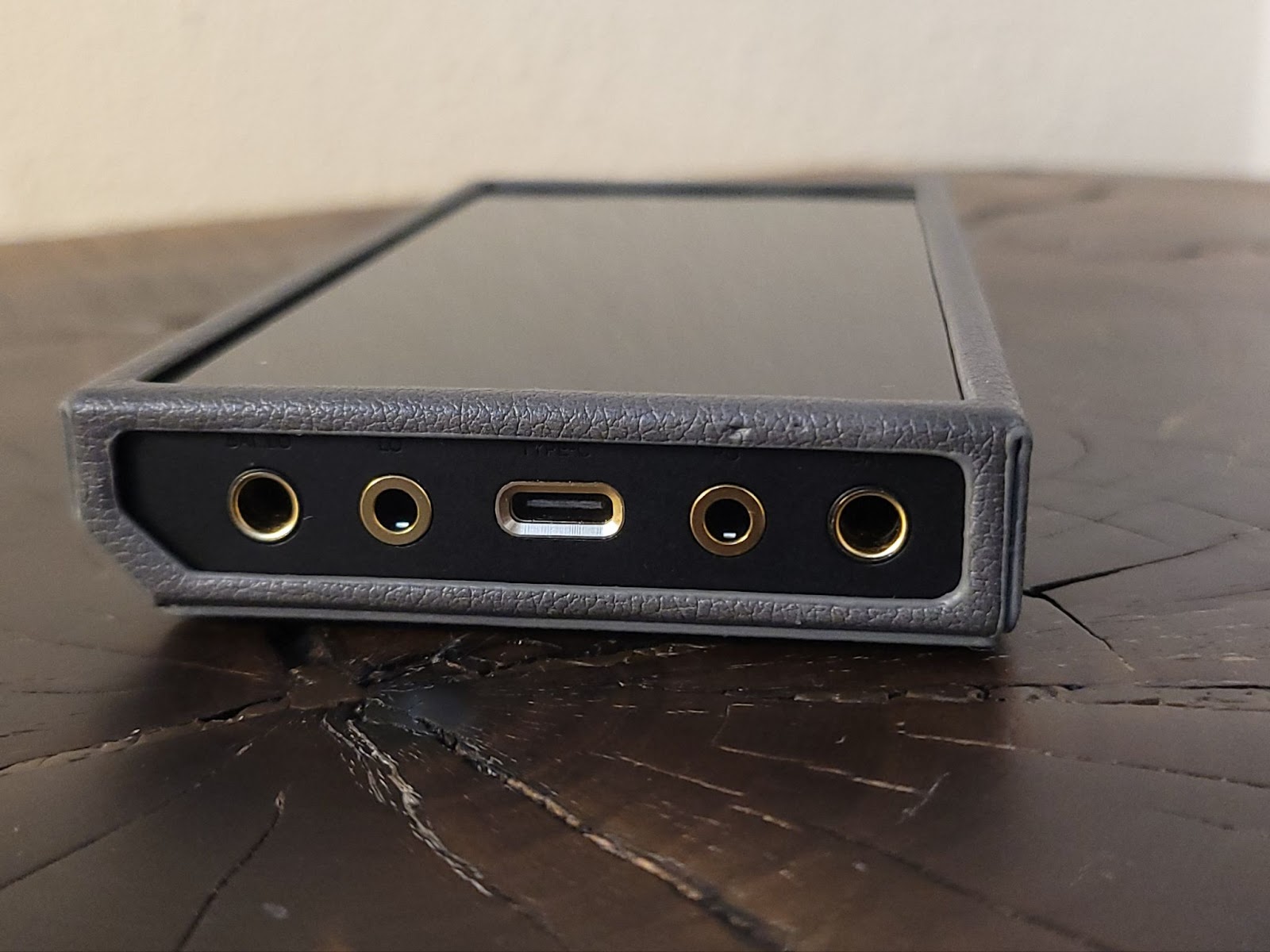
R6 Pro II is very resolving, more resolving than its peers. Its staging capabilities are also above average and the focus I kept rambling about makes imaging and layering especially sharp and precise. Timbre is very natural too. As usual comparisons should shed more light to what I mean.
Although Class A is definitely the way to go for me, depending on the situation you can choose to use Class AB too, to make the battery last longer or to have a more relaxing listening session.
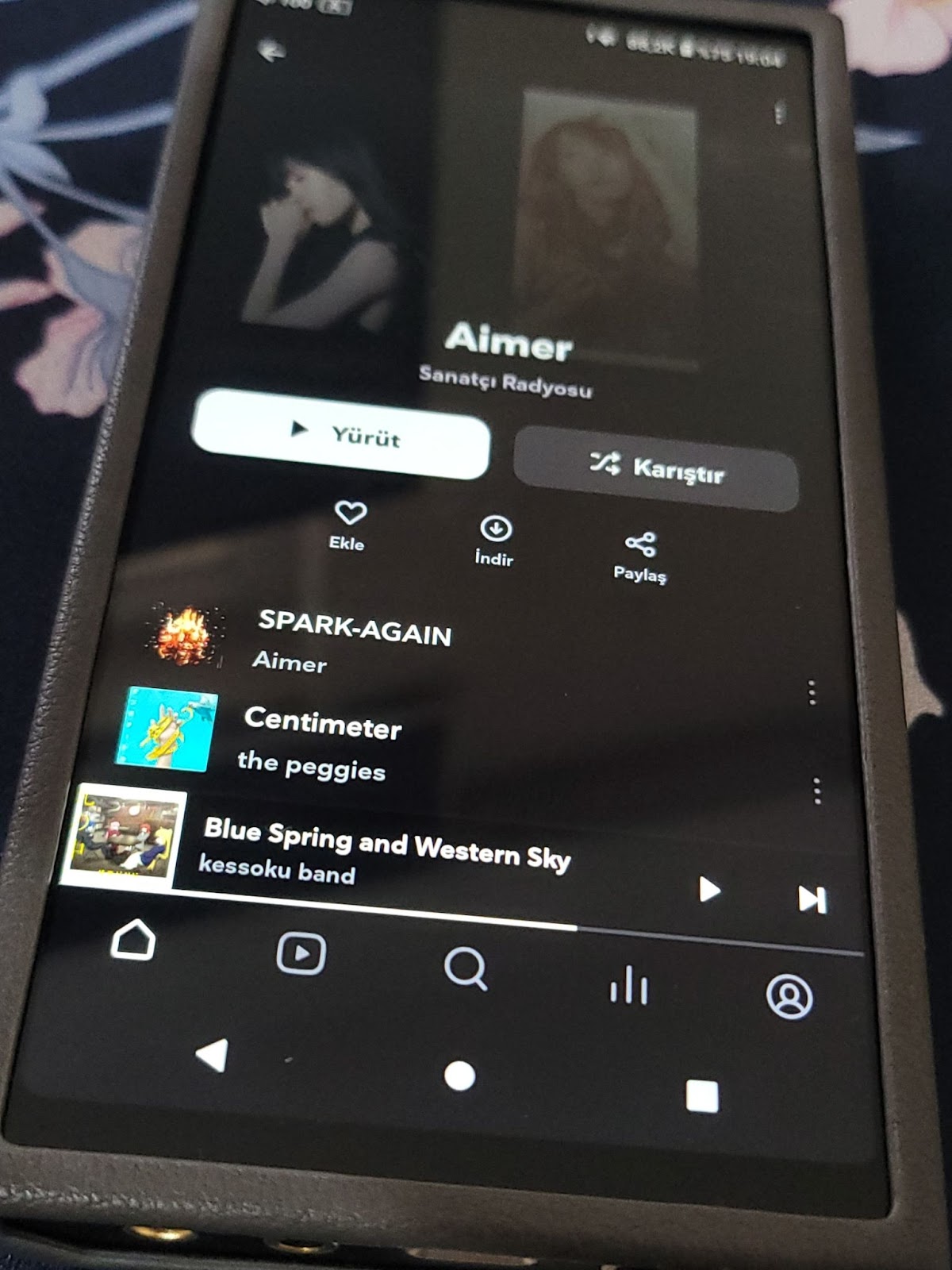
When I had the M11 Plus I briefly compared the two and sold the M11 Plus in the end. My findings were as follows.
All in all my desktop rig is more lively but R6 Pro II smooth and controlled.
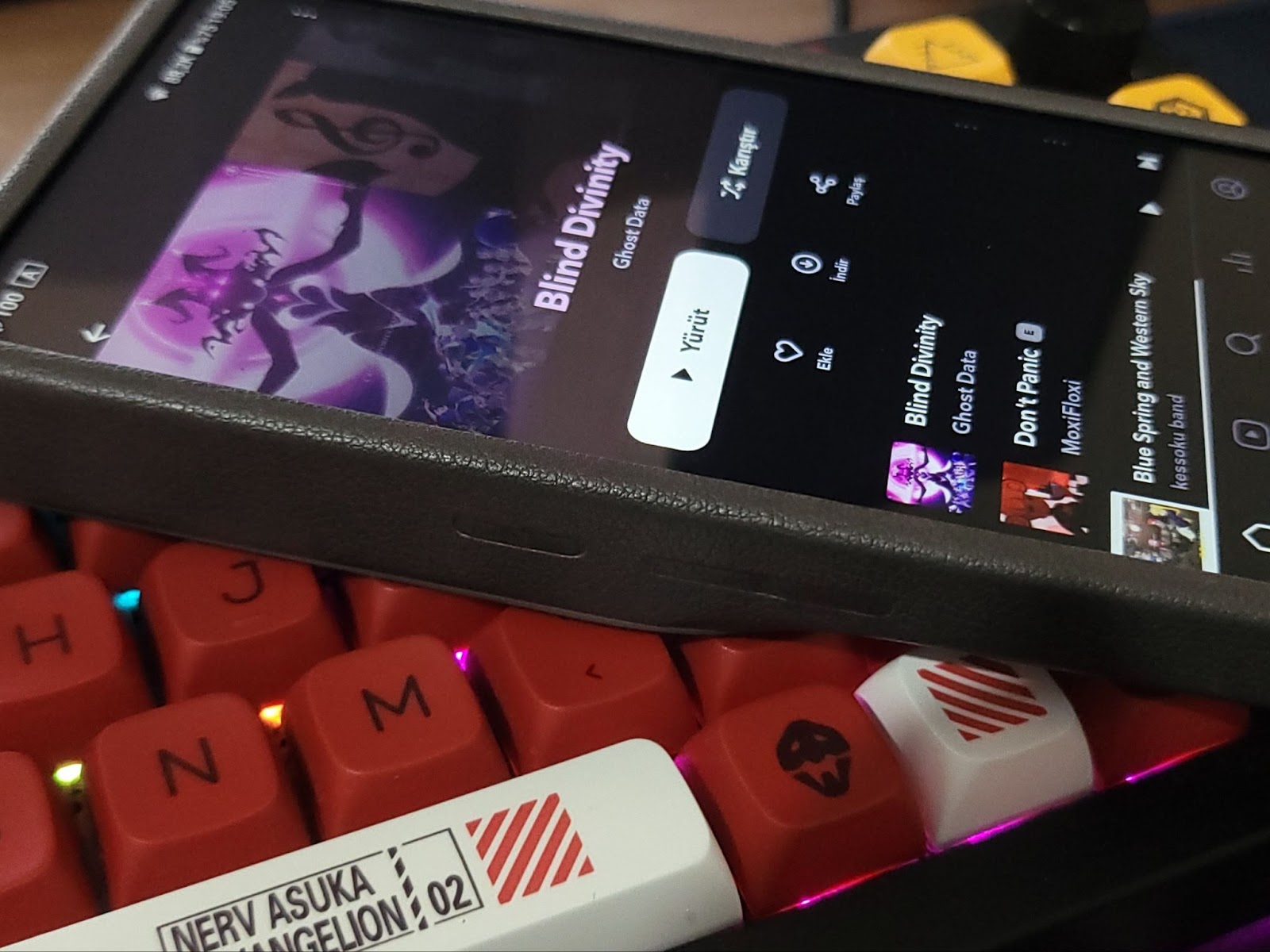
Hiby R6 Pro II was a device I have been very interested in since it was announced. I “degraded” from DX300 and never looked back. I also had FiiO M11 Plus LTD for a short while but didn’t feel any inclination to keep it. That’s how much I like my R6 Pro II. I knew what I was getting into. Yes power output is lower than other DAPs in its price range but I mostly use IEMs outside so it wasn’t a problem. Also I can only listen to music for a couple of hours at the office so battery life didn’t bother me too much either. Sound quality, the parts that have been used, futureproof OS and Parametric EQ already make this device a value proposition that’s too hard to pass.
Disclaimers
I bought R6 Pro II with my own money from a friend pre-used so, of course I didn’t pay the full price if that matters. I have been using the device for some time as my personal unit, therefore review includes my own long term user experience as well. As I always say, everyone is biased one way or another so take everything you read with a grain of salt. Also I will try to be more concise and to the point in my reviews from now on without worrying about the word count etc. If you have any questions, please ask me in the comments and I will try to answer them to the best of my abilities.
About Hiby
Hiby was founded in 2011 according to their website and has even more experience in the audio field apparently. They are mostly known for their Digital Audio Players but they also make DAC/Amps and earphones. However, what makes Hiby different from other manufacturers is their expertise in software. Their UIs, apps and connection protocol Hiby Link are used by even other brands.
Packaging of R6 Pro II
R6 Pro II comes with a rather modest packaging, still it doesn’t feel like missing anything. A leather protective case, spare screen and back glass protectors, a rather thick USB-C to USB-C cable and a USB-C to USB-A adapter is included in the package. Leather case feels sturdy and premium enough and has a great design feature that stretches and closes when the DAP is slid inside. After the loose DX300 case I used for a long time, it is a very welcome change.
Hardware of R6 Pro II
R6 Pro II is a hefty device. In fact it’s heftier than I first thought it would be, definitely more in line with +1k devices. It has a unique asymmetrical wavy design but not as esoteric as Astell&Kern devices. R6 Pro II comes in two colors: Purple and black. Purple comes with a purple case and black comes with a gray case. Honestly I would have liked to have the purple one instead.
Inside, the device used Asai Kasei’s latest DAC chip AK4499EX in dual formation along with their AK4191EQ delta-sigma modulator. Companies like to promote this modulator as another DAC chip but it really isn’t and if I’m not mistaken this modulator was embedded to older chips but in the latest AK4499EX they separated it from the DAC chip instead. Still these chips are flagships of the company and having them in a DAP that’s sold for 749 USD is quite a feat.
R6 Pro II runs Qualcomm’s Snapdragon 665 processor. While it’s not a flagship or the latest processor on the market, due to batch limitations, it was probably the best one they could offer. However I'm pretty sure it's the fastest processor that’s used in a DAP currently on the market. I had no problem with the operation of the device. It’s always smooth and responsive. Even one of my friends commented that it was faster than his phone.
Device has 4 GBs of RAM which is again enough for the intended use case and 64 GBs of internal storage. You can also add a micro SD card to increase the storage up to 2TBs for your music.
R6 Pro II has an independent amplification circuitry that can provide both class A amplification with dual OPA1652 op amps and class AB amplification. I will describe the differences later in its own section.
5.9” FHD+ screen with minimum bezel thickness gives R6 Pro II a sleek look but Hiby decided to feed all this hardware with 5000 mAh battery which yields suboptimal listening times.
Lastly R6 Pro II supports the usual wireless and wired connectivity options, namely WiFi, Bluetooth 5.0, USB and Coaxial through USB-C output. Analog outputs include 3.5 mm single ended and 4.4 mm balanced. Line outs and phone outs are separated. Device also supports DLNA, Airplay and their own Hiby Link protocols as well as Hiby Cast remote control. It can render X16 MQA too, if that’s important for you. I’m pretty sure there are others I forgot to mention.
So all of these yields to virtually no distortion and noise. Battery life isn’t the best, I got 5 hours and 45 minutes of playing time with streaming in class A mode, low gain and balanced output at volume 50/100 which is louder than my usual listening level, with minimum screen usage. Website says R6 Pro II plays for 5 hours in balanced class A mode so info is more than real. It’s mostly enough for me but competitors offer more so there is that. Class A mode works slightly warm which is expected.
Amplification section isn’t very powerful but should be enough for almost all IEMs and a lot of headphones out there. Max single ended power output is 125 mW and balanced power output is 383 mW.
Software and UI
R6 Pro II uses an open Android 12.0 which means you can download any 3rd party apps you want and it should get app updates for quite a while. While Android 14 is out, 12.0 is the newest version among the current DAPs on the market if I’m not mistaken. Hiby Music comes pre-installed as the default music player and I didn’t need to use any other music app since I mostly stream my music.
UI is customized by Hiby for the intended use case. It is not too different from the usual Android experience but changing audio controls like adjusting gain and amplification type is especially very easy.
Hiby’s own MSEB (Mage Sound 8-ball Tuning) is an EQ based easy sound adjustment mechanism. If using EQ is intimidating for you, playing with MSEB can ease you into it. I think it’s a great feature. Here is the list that shows how each choice affects the sound:
1 -- Overall Temperature is a tilt of the whole line towards treble (cool) or bass (warm)
2 -- Bass extension 70Hz and below
3 -- Bass texture 100Hz (medium)
4 -- Note thickness 200Hz (wide)
5 -- Vocals 650Hz (very wide)
6 -- Female overtones 3kHz (tight)
7 -- Sibilance LF 5.8kHz (medium)
8 -- Sibilance HF 9.2kHz (medium)
9 -- Impulse response 7.5kHz (very wide)
10 - Air 10kHz sloped all the way to 20kHz
Other than that Hiby added Systemwide Parametric EQ to P6 Pro II along with some of their other DAPs with the latest updates. Actually groundwork was always there, MSEB used it after all, but they decided to give the freedom of choice to us. It has 9 bands and all the filters, not just peak filters. I tried different use cases and it worked with 3rd party apps and also digital out through USB. Looks like Hiby wants me to sell my RME Adi-2 DAC FS.
Sound of Hiby R6 Pro II
I don’t like describing the sound of the source gears with frequency response terms but I don’t really know a better way either. In the case of the R6 Pro II, in one word, it sounds focused. First thing I noticed when I started listening to it was how focused it was, especially the midrange. No region in frequency response was emphasized but if I were to name one highlighted area, it was the midrange.
The Midrange of the R6 Pro II is clean, crisp and sharp. Bass is neutral, just how I like it. I know we mostly judge the quality of a source gear by how it handles the bass and believe me it handles it well, especially in the class A mode but doesn’t particularly emphasize or highlight it. Treble is devoid of any digital glare or sharpness. So while I wouldn’t call R6 Pro II a warm source, if neutral normally has this kind of quirks for you, I guess you can call R6 Pro II a little warm.
R6 Pro II is very resolving, more resolving than its peers. Its staging capabilities are also above average and the focus I kept rambling about makes imaging and layering especially sharp and precise. Timbre is very natural too. As usual comparisons should shed more light to what I mean.
Class A vs. Class AB
- Biggest difference is in the bass notes. Class A is more incisive in its attack. It also sounds bolder and more confident, AB, compared to that is softer.
- Class A has sharper and more focused imaging and separation. It makes Class A resolve the nuances easier too. Class A also might be slightly more spacious but it’s hard to tell.
Although Class A is definitely the way to go for me, depending on the situation you can choose to use Class AB too, to make the battery last longer or to have a more relaxing listening session.
R6 Pro II vs. Fiio M11 Plus LTD
When I had the M11 Plus I briefly compared the two and sold the M11 Plus in the end. My findings were as follows.
- Bass was more emphasized on Fiio with more heft and body to it.
- Timbre was the most apparent difference between the two, R6 Pro II being more natural, especially the midrange on the R6 Pro II sounds better with more focus.
- Imaging was sharper on R6 Pro II and staging was more enveloping.
- Other than sound differences, R6 Pro II uses a newer processor, OS and DAC chip. With the latest update R6 Pro II got systemwide Parametric EQ too.
Desktop Rig (Monolith Liquid Platinum DAC and Amp Section of Yulong Da-art Aurora)
- Desktop Rig has more handling power on tap and bass is even more authoritative.
- Desktop Rig also has better staging.
- R6 Pro II is smoother and more controlled in the treble.
- Desktop Rig is more resolving and has better layering and separation capabilities.
All in all my desktop rig is more lively but R6 Pro II smooth and controlled.
Conclusion
Hiby R6 Pro II was a device I have been very interested in since it was announced. I “degraded” from DX300 and never looked back. I also had FiiO M11 Plus LTD for a short while but didn’t feel any inclination to keep it. That’s how much I like my R6 Pro II. I knew what I was getting into. Yes power output is lower than other DAPs in its price range but I mostly use IEMs outside so it wasn’t a problem. Also I can only listen to music for a couple of hours at the office so battery life didn’t bother me too much either. Sound quality, the parts that have been used, futureproof OS and Parametric EQ already make this device a value proposition that’s too hard to pass.
Last edited:
Jarlaxle
100+ Head-Fier
Pros: Good build for the price
Abundace of the tips included
Clean neutral tuning
Good timbre
Very good staging
Abundace of the tips included
Clean neutral tuning
Good timbre
Very good staging
Cons: Cable isn't replaceable
Bass might be lacking for most people
Treble could have been smoother and extended more
Bass might be lacking for most people
Treble could have been smoother and extended more
Hifiman is mostly known for their open-back planar magnetic headphones and I myself own 3 pairs. As you may already know, almost all of their headphone offerings have become benchmarks in their respective price ranges. Other than headphones, they make IEMs, digital to analog converters, amplifiers and digital music players which are more or less successful in their own right and this is a review of one such product: their bullet style IEMs RE-400.
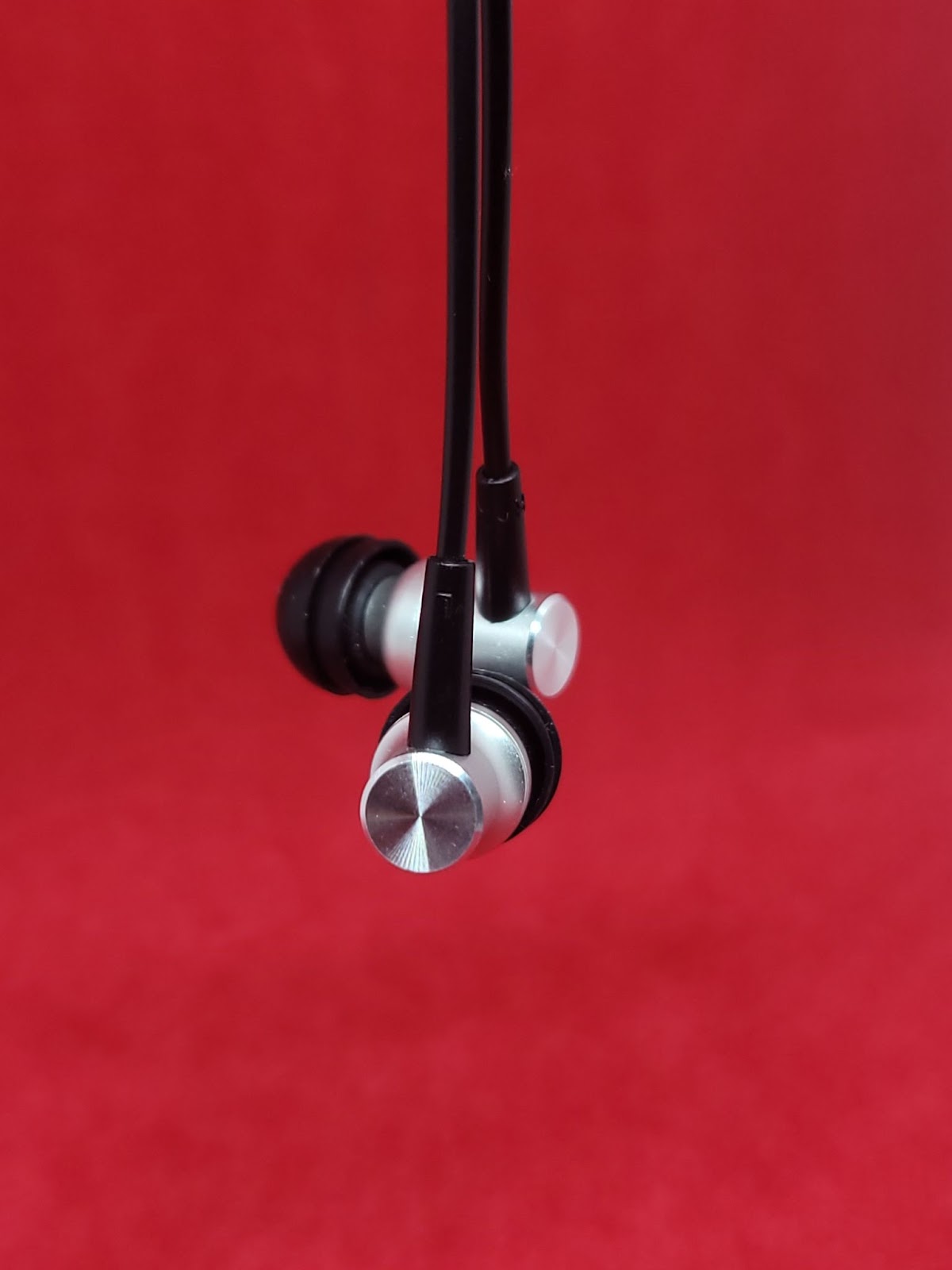
RE-400 is their cheapest IEMs as of now and although the original price for it was 79.00 USD when it first came out, now it’s sold for 19.99 USD on their official site and Amazon.
Hifiman RE-400 was provided to me by Hifiman for free and I only paid for the customs fee. As I always say, everyone is biased one way or another so take everything you read with a grain of salt. Also I will try to be more concise and to the point in my reviews from now on without worrying about the word count etc. If you have any questions, please ask me in the comments and I will try to answer them to the best of my abilities.
Shells of the RE-400 are bullet shaped and relatively small. Not as small as Final Audio E series IEMs, but still very comfortable. As materials used, they are made out of aluminum, not the smoothest aluminum out there, but still feels premium especially for the price.The cable which is fabric coated below the splitter by the way, isn’t replaceable and has some memory unfortunately. Cable termination is 3.5 mm single ended and angled.
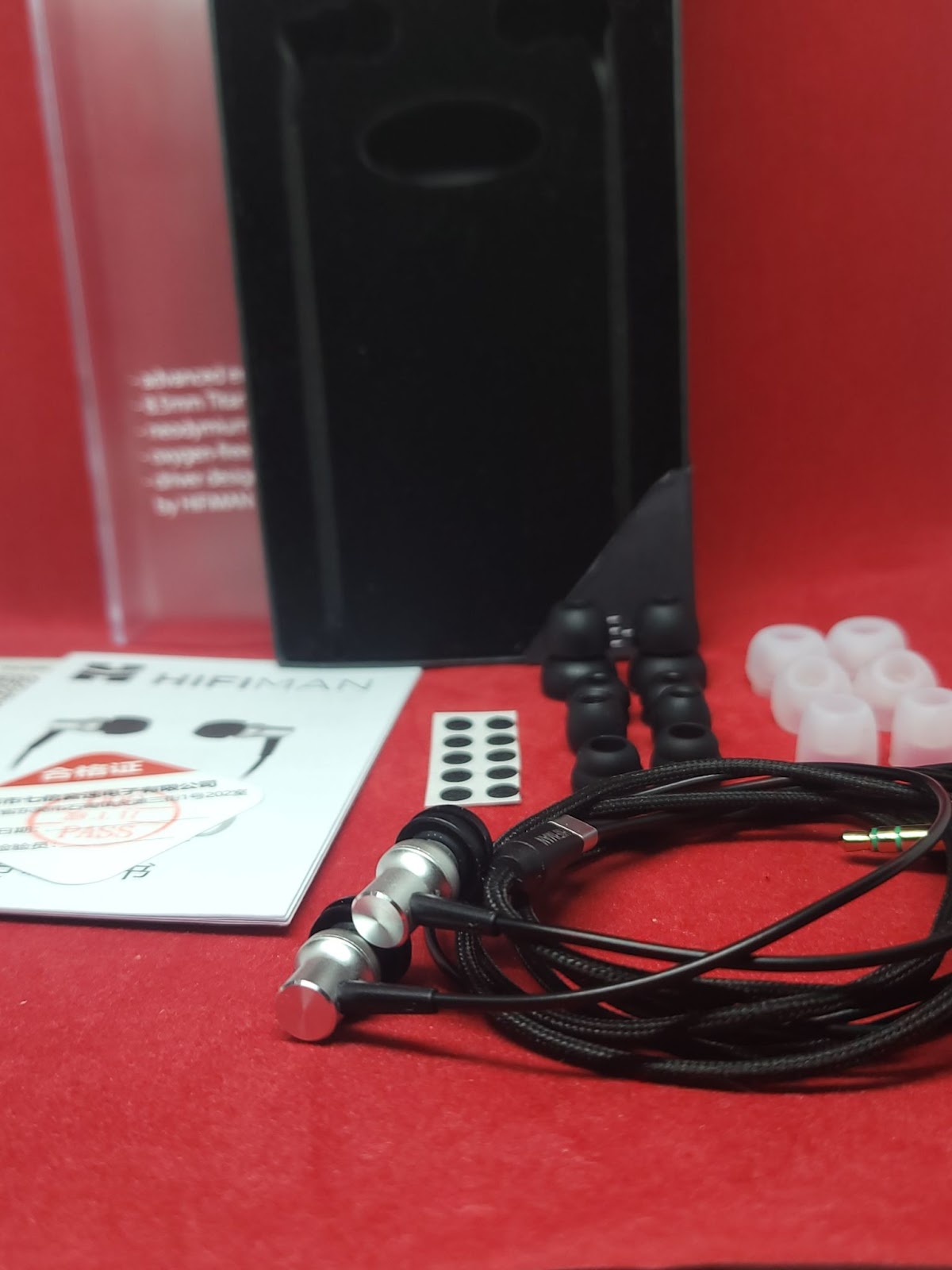
RE-400 comes in a compact plexiglass packaging. It doesn’t look too cheap and they probably decided to increase the contents along the way since there is also a bag of accessories that comes with it. Apart from the IEMs, you get a carrying case and 8 pairs of different eartips. I mostly used double flanged ones in my testing.
RE-400 has a neutral tuning, almost like an average Etymotic. It isn’t particularly devoid of bass but there is not too much of it to speak of. As a character, the bass is relatively fast and tight.
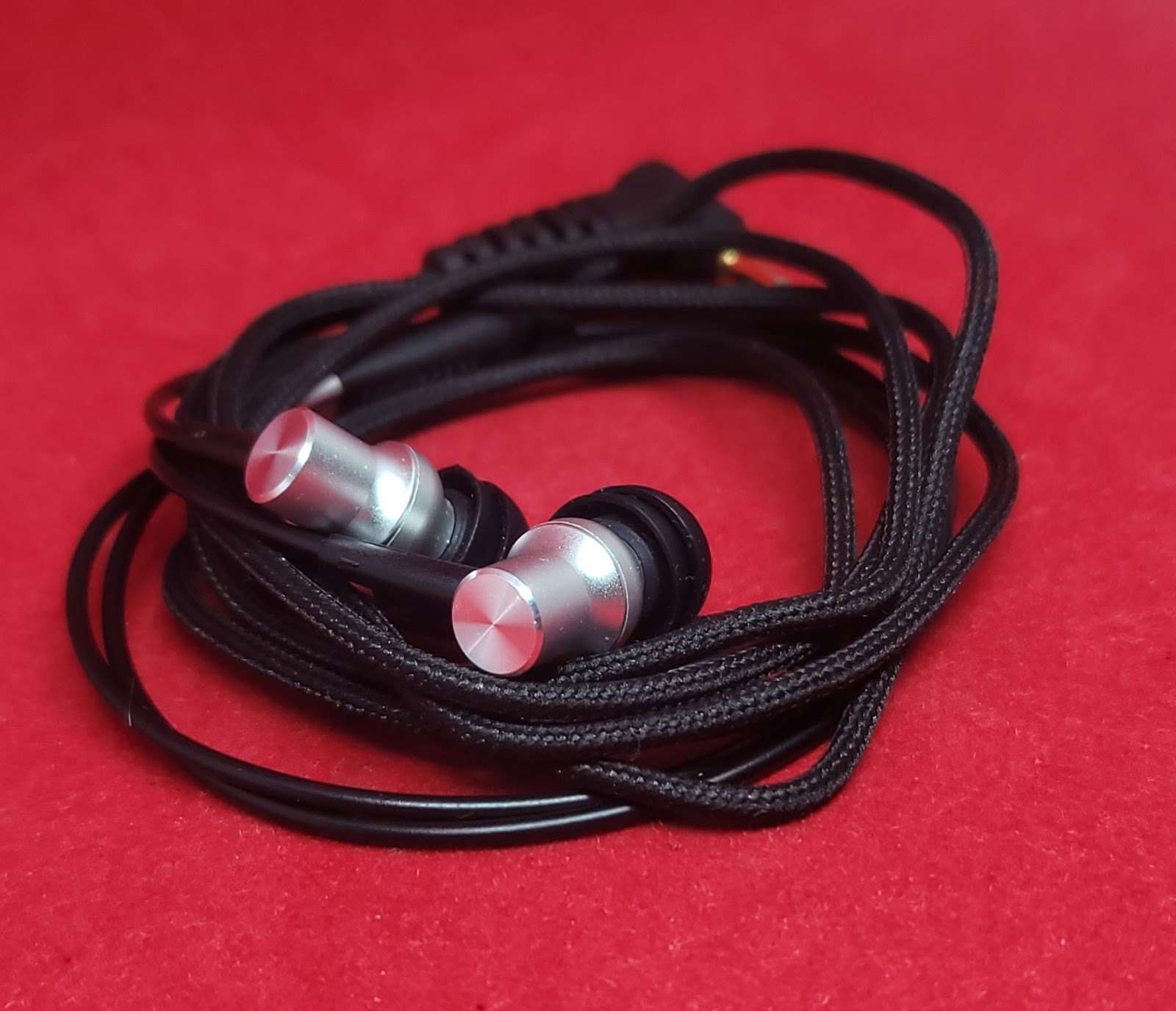
Mids are very clean and clear but also a little lean. Vocals mostly keep their distance. In this sense, RE-400 kind of sounds almost like their open-back planar magnetic headphones.
There is no harshness in the treble region but it also isn’t very smooth. There are narrow peaks you notice occasionally and treble extension isn’t great either.
The most impressive aspect of RE-400 is its staging capability. Stage expands sideways and it creates an interesting hall effect. In fact, it was the first thing I noticed as soon as I put them in my ears. Imaging is also pretty good.
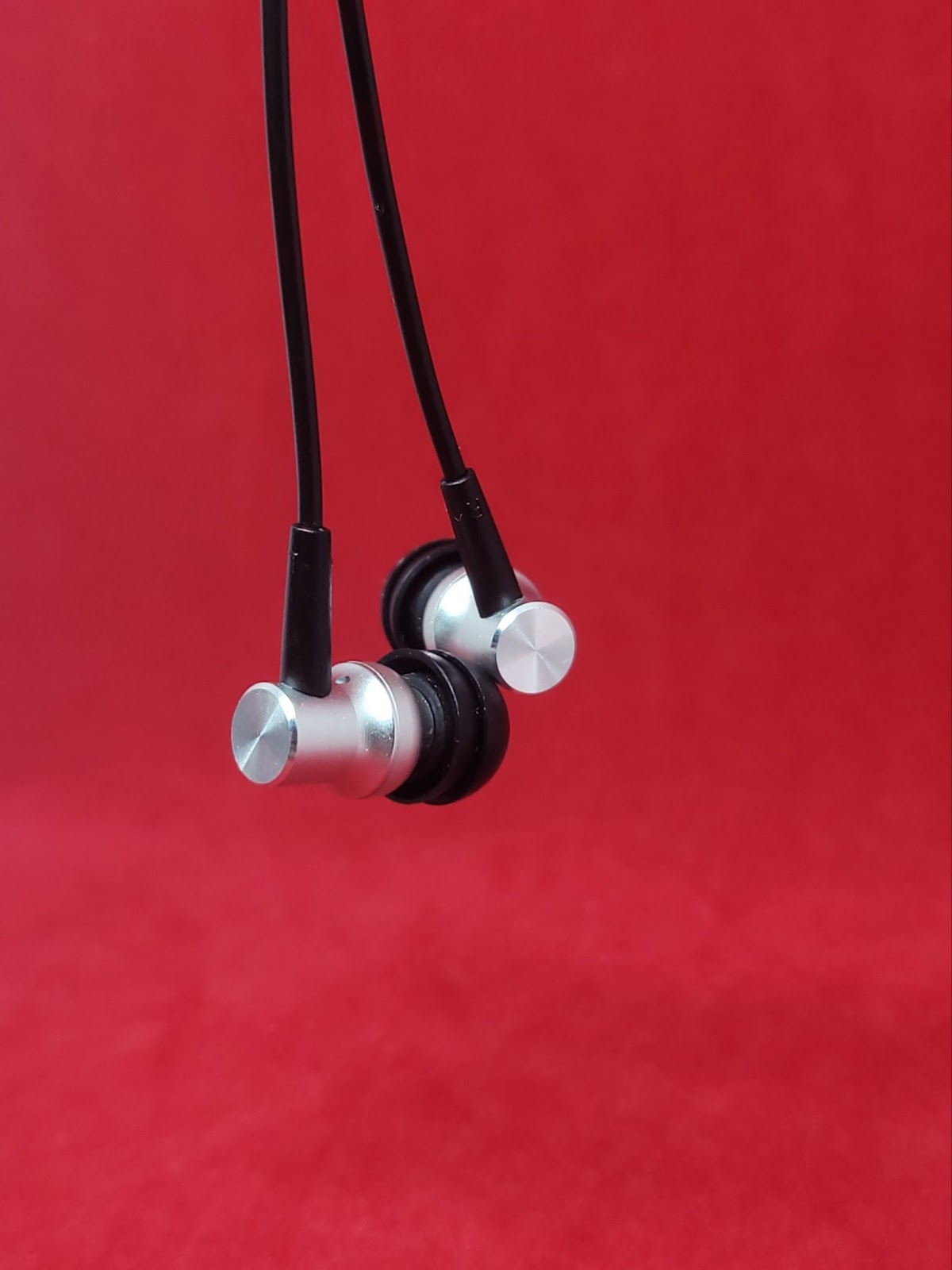
RE-400 sounds kind of dry but other than that timbre is mostly fine, nothing jumps out as unnatural. Lack of extension kind of hampers the rendering capability but at this price, I won’t complain too much. As always comparisons shed more light to how RE-400 sounds.
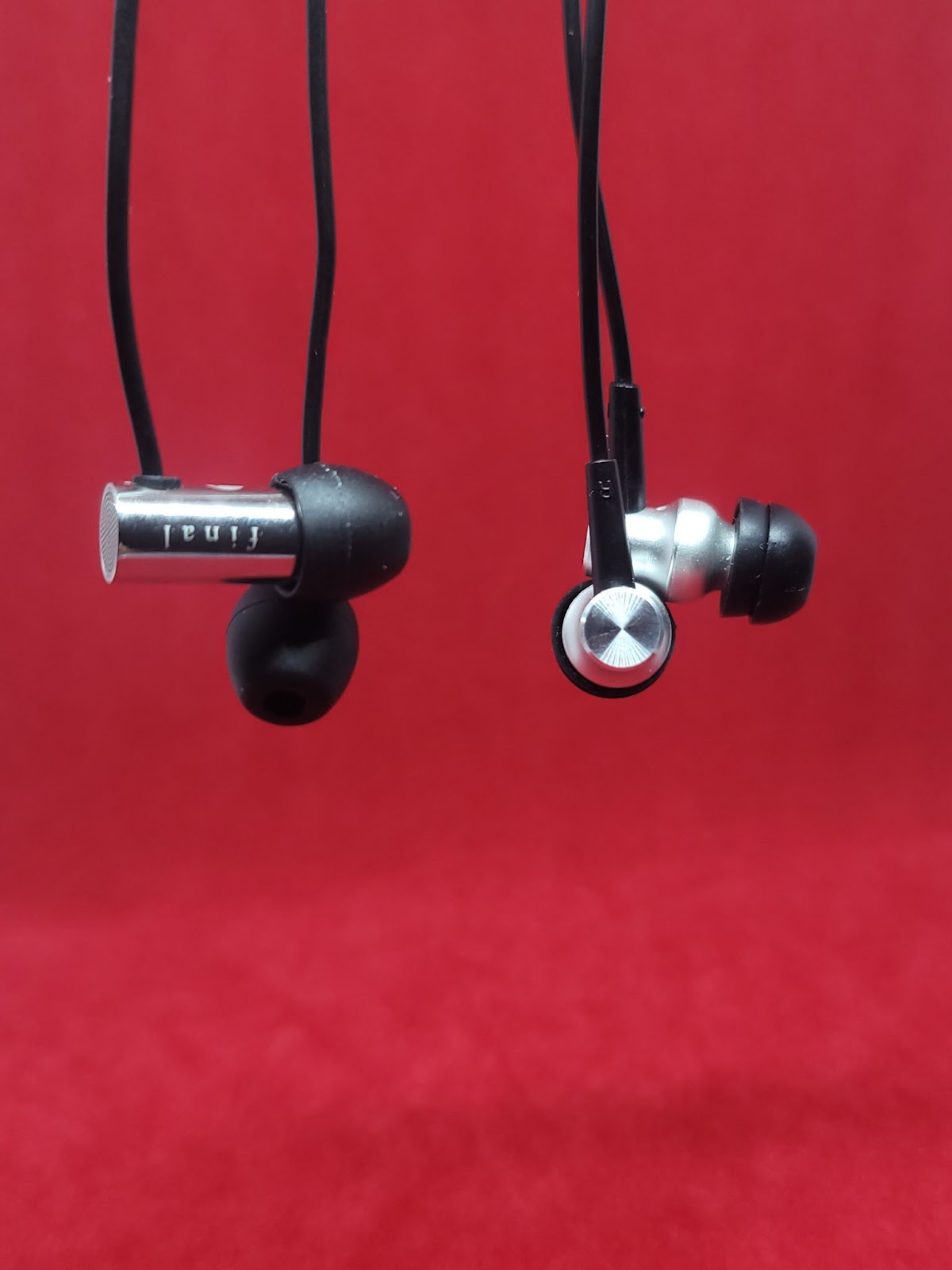
Volume Matched at 1 kHz
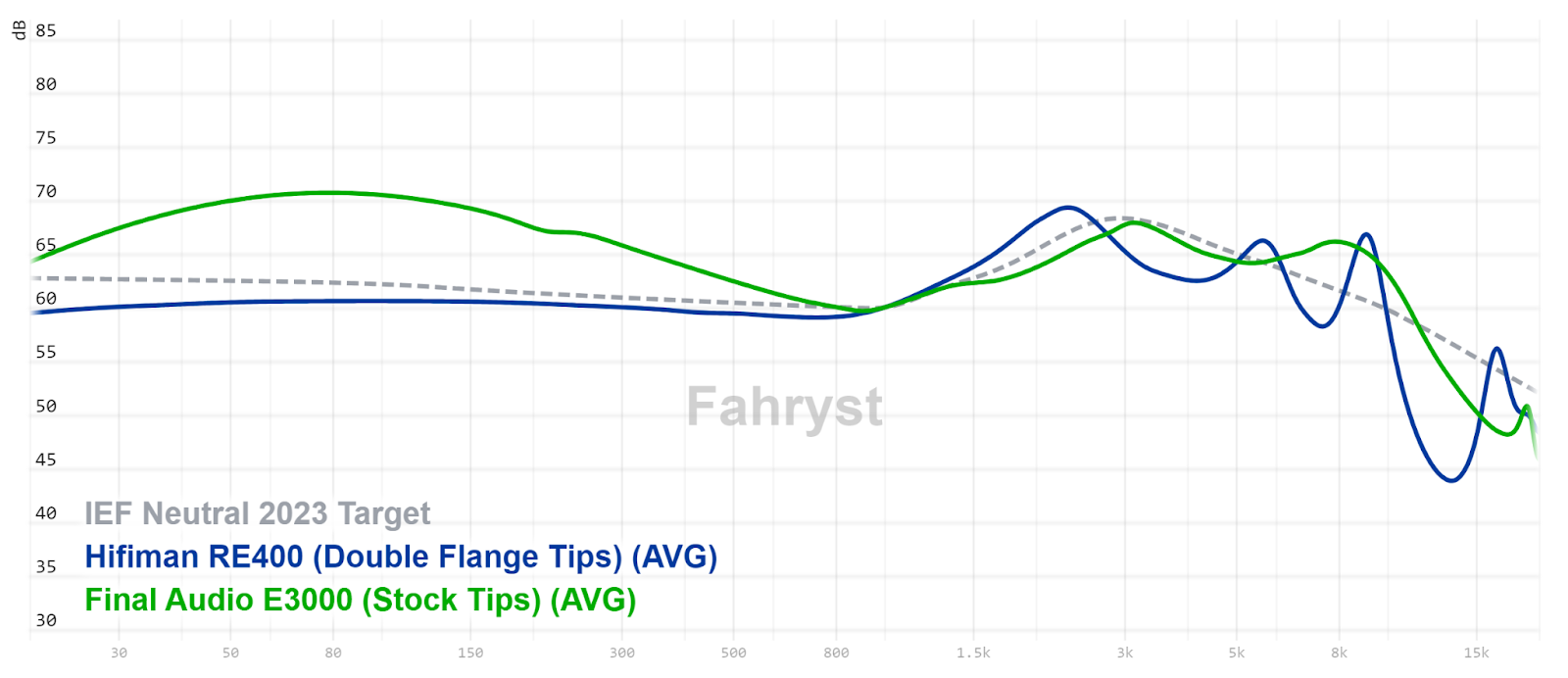
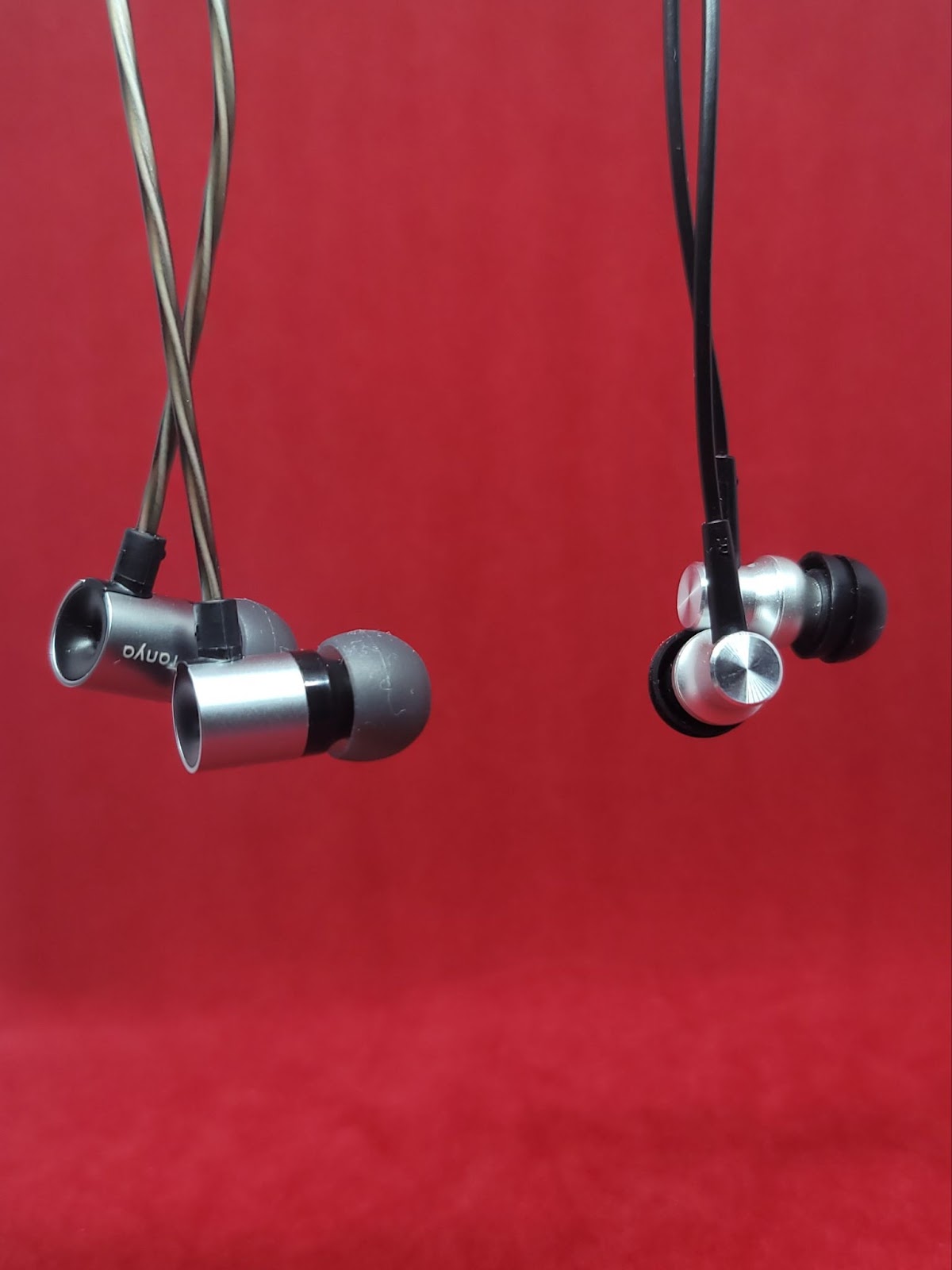
Volume Matched at 500 Hz
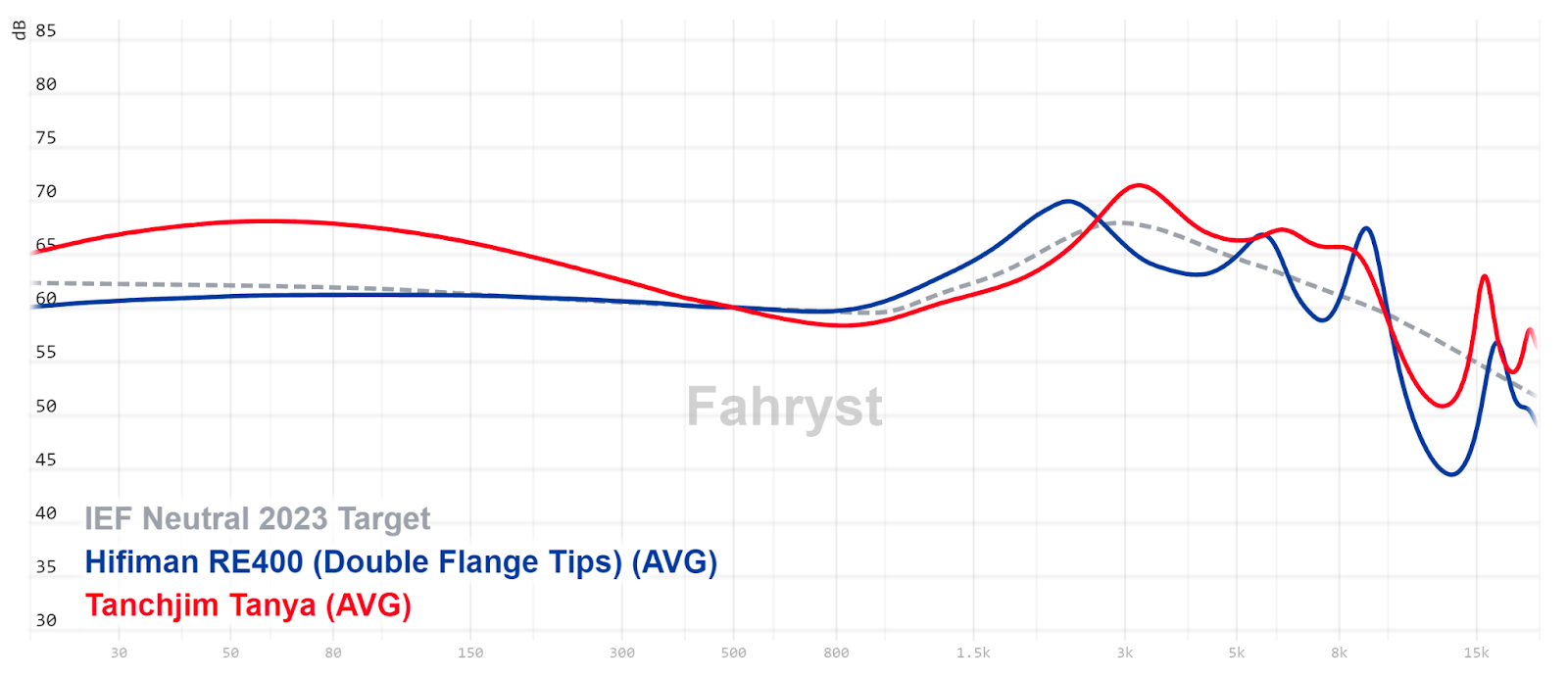
I wasn’t expecting too much from the Hifiman RE-400 but I was pleasantly surprised. It doesn’t set the world on fire, no, however for the price now it sells, it’s hard to make an argument against it. Especially in a market that is flooded with V-Shaped and Harman tuned IEMs, it feels fresh with its clean neutral tuning and the interesting hall effect it creates. All in all, maybe not at the full price, but for 19.99 USD, I think RE-400 deserves a place in everyone’s collection.
RE-400 is their cheapest IEMs as of now and although the original price for it was 79.00 USD when it first came out, now it’s sold for 19.99 USD on their official site and Amazon.
Disclaimers
Hifiman RE-400 was provided to me by Hifiman for free and I only paid for the customs fee. As I always say, everyone is biased one way or another so take everything you read with a grain of salt. Also I will try to be more concise and to the point in my reviews from now on without worrying about the word count etc. If you have any questions, please ask me in the comments and I will try to answer them to the best of my abilities.
Build and Accessories of Hifiman RE-400
Shells of the RE-400 are bullet shaped and relatively small. Not as small as Final Audio E series IEMs, but still very comfortable. As materials used, they are made out of aluminum, not the smoothest aluminum out there, but still feels premium especially for the price.The cable which is fabric coated below the splitter by the way, isn’t replaceable and has some memory unfortunately. Cable termination is 3.5 mm single ended and angled.
RE-400 comes in a compact plexiglass packaging. It doesn’t look too cheap and they probably decided to increase the contents along the way since there is also a bag of accessories that comes with it. Apart from the IEMs, you get a carrying case and 8 pairs of different eartips. I mostly used double flanged ones in my testing.
Sound of Hifiman RE-400
Tonality
RE-400 has a neutral tuning, almost like an average Etymotic. It isn’t particularly devoid of bass but there is not too much of it to speak of. As a character, the bass is relatively fast and tight.
Mids are very clean and clear but also a little lean. Vocals mostly keep their distance. In this sense, RE-400 kind of sounds almost like their open-back planar magnetic headphones.
There is no harshness in the treble region but it also isn’t very smooth. There are narrow peaks you notice occasionally and treble extension isn’t great either.
Technicalities
The most impressive aspect of RE-400 is its staging capability. Stage expands sideways and it creates an interesting hall effect. In fact, it was the first thing I noticed as soon as I put them in my ears. Imaging is also pretty good.
RE-400 sounds kind of dry but other than that timbre is mostly fine, nothing jumps out as unnatural. Lack of extension kind of hampers the rendering capability but at this price, I won’t complain too much. As always comparisons shed more light to how RE-400 sounds.
Comparisons
Hifiman RE-400 vs Final Audio E3000
Volume Matched at 1 kHz
- E3000 is much warmer, has much more bass and subbass than RE-400. However, the E3000's bass is more pillowy. RE-400 isn’t really devoid of bass and it’s tighter.
- RE-400 is much cleaner.
- Vocals are more forward on E3000. RE-400 leaves room to breathe.
- Neither is harsh. E3000 has a better treble extension but that might also be because of the deeper insertion it provides. RE-400 rolls off earlier in the upper treble.
- RE-400 has a wide spacious sound and interesting hall effect. E3000 on the other hand, also has a very tangible staging and it feels like you are in the studio with the artists. Both have their stages expanding to the sides but RE-400 is wider. Imaging is very precise on both.
- Personally I find overly warm iems suffocating. On that note RE-400 feels fresher for me.
- Both have decent timbral qualities but RE-400’s timbre is more lifelike. E3000 warmth skews the balance a little too much.
- E3000 renders more details but warmth drowns a big part of these details so RE-400 might come as more revealing to most.
Hifiman RE-400 vs Tanchjim Tanya
Hifiman RE-400 vs Tanchjim Tanya
Volume Matched at 500 Hz
- Tanya is V-Shaped while RE-400 is neutral. Again Tanya is warmer but it also has upper mids presence so vocals are slightly more forward. Vocals on RE-400, although not too recessed, aren’t too close and personal either.
- Bass on Tanya is also more impactful and extends deeper.
- Although Tanya is shoutier, neither is necessarily harsh.
- Treble on Tanya is noticeably better. It has good energy and is smooth at the same time; pretty much on point and it has better extension too. RE-400’s treble sounds blunted compared to Tanya’s.
- Tanya’s timbre is objectively better but I find RE-400’s timbre somewhat more agreeable. Maybe Tanya's shoutiness affects my perception.
- Tanya is more detailed by a good margin. Staging is extraordinary on RE-400. It expands wider than Tanya’s headstage but Tanya’s stage is deeper. RE-400’s imaging is also better.
Conclusion
I wasn’t expecting too much from the Hifiman RE-400 but I was pleasantly surprised. It doesn’t set the world on fire, no, however for the price now it sells, it’s hard to make an argument against it. Especially in a market that is flooded with V-Shaped and Harman tuned IEMs, it feels fresh with its clean neutral tuning and the interesting hall effect it creates. All in all, maybe not at the full price, but for 19.99 USD, I think RE-400 deserves a place in everyone’s collection.
Last edited:
Jarlaxle
100+ Head-Fier
Pros: Highly technical improved dynamic driver
Fast attack and decay in the bass
Detailed, spacious and airy sound
Surprisingly not fatiguing
Good fit
Angled nozzles
Easily modifiable
Fast attack and decay in the bass
Detailed, spacious and airy sound
Surprisingly not fatiguing
Good fit
Angled nozzles
Easily modifiable
Cons: Tuning nozzles don't make a big difference
Intense tonality that some people may find harsh
Fingerprint magnet
Intense tonality that some people may find harsh
Fingerprint magnet
EA500LM is Simgot's latest release at the date of this review. Just by the name, it promises to continue the legacy of the now legendary EA500. LM name comes from the materials used in the drivers which are Lithium and Magnesium, so it doesn’t stand for “Limited”. Apart from the tuning, the price was also increased to 89.99 USD and they added another pair of tuning nozzles to the package.

Simgot EA500LM was provided to me by Simgot for free and I only paid for the customs fee. As I always say, everyone is biased one way or another so take everything you read with a grain of salt. Also I will try to be more concise and to the point in my reviews from now on without worrying about the word count etc. If you have any questions, please ask me in the comments and I will try to answer them to the best of my abilities.

Earpieces of the EA500LM are identical to the original EA500; it’s made fully out of metal, only darker in color. If you like EA500’s fit, then you don’t need to worry at all. Domes of the drivers powering them are, like I said above, made using Lithium and Magnesium.
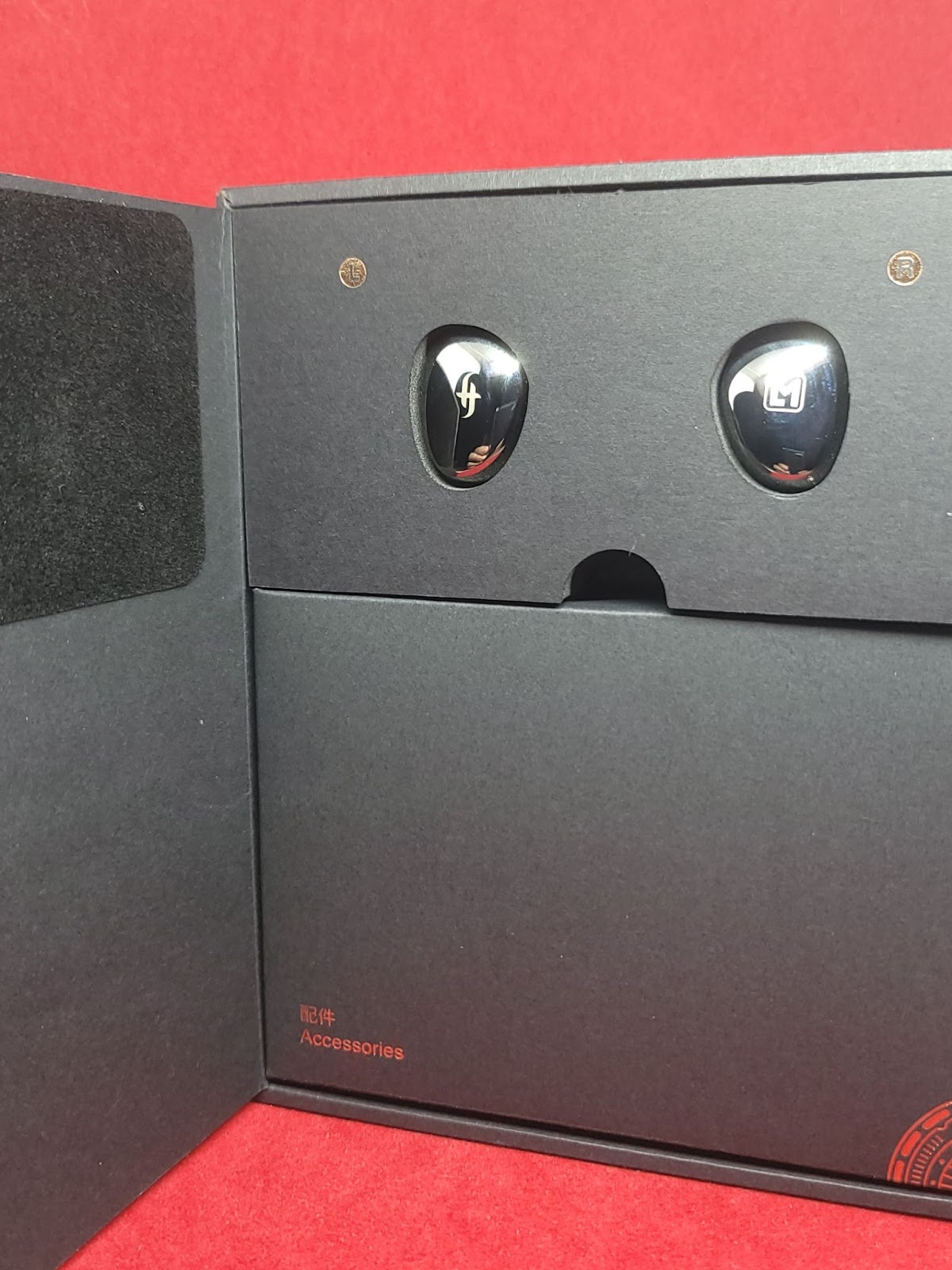
Packaging and its contents are identical to the original EA500 and EM6L. For those who don’t know, EA500LM comes with an unbranded carrying case, a thin but decent cable, 3 pairs of eartips, 3 pairs of tuning nozzles and spare O rings. Well tuning nozzles and O rings are exclusive to EA500 brothers.
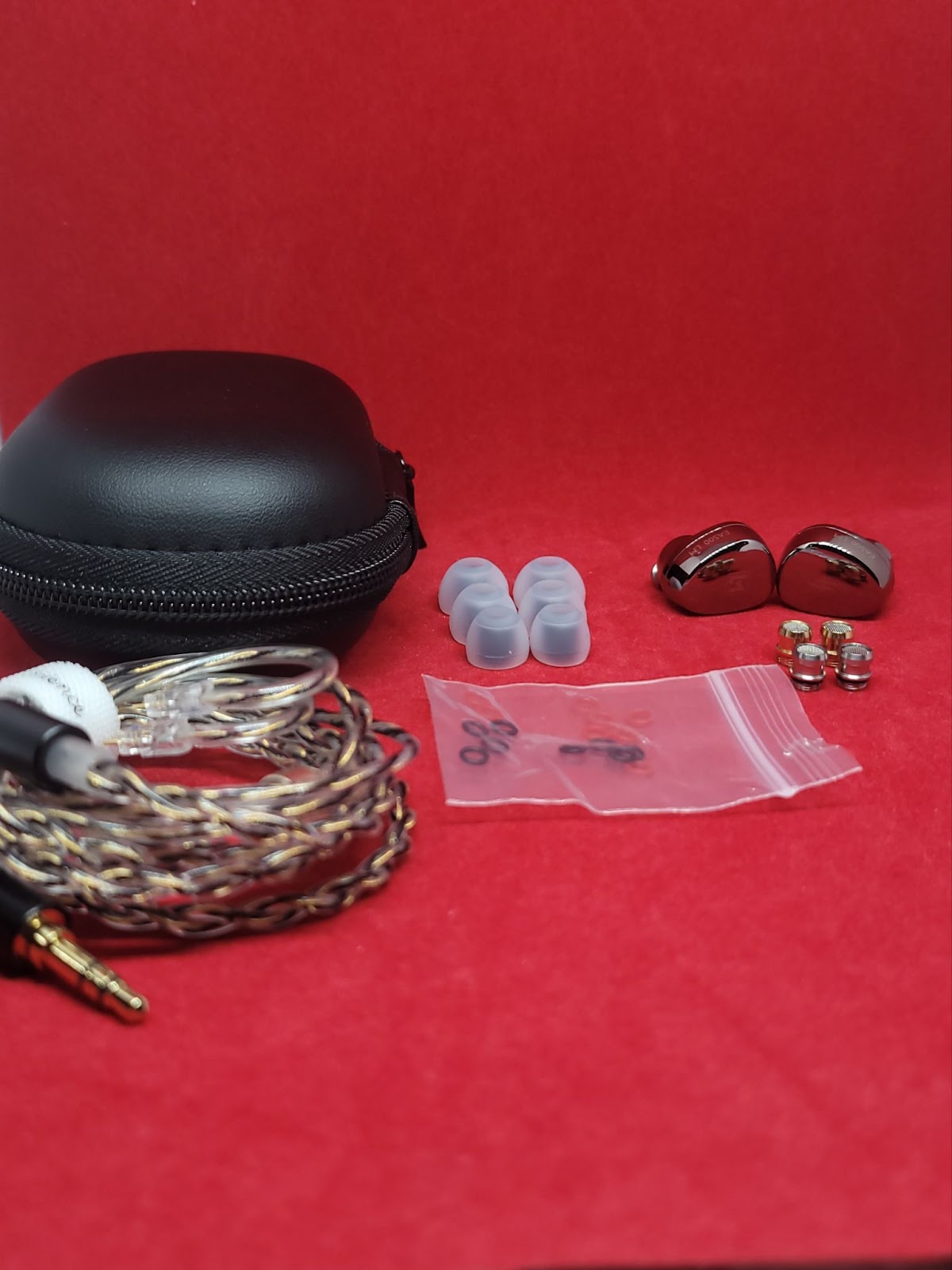
EA500LM didn’t stray far from the usual Simgot sound. Although they come with 3 tuning nozzles, gold and silver with red rings sound very close. Gold nozzles have tuning foams in them and they somewhat soften the sound but don’t alter the peaks too much so I decided to use the silver nozzles with red rings which don’t feel like they are holding back the IEMs. Nozzles with black filters collect dust since even the other nozzles are already very bright. If only gold nozzles made more difference.
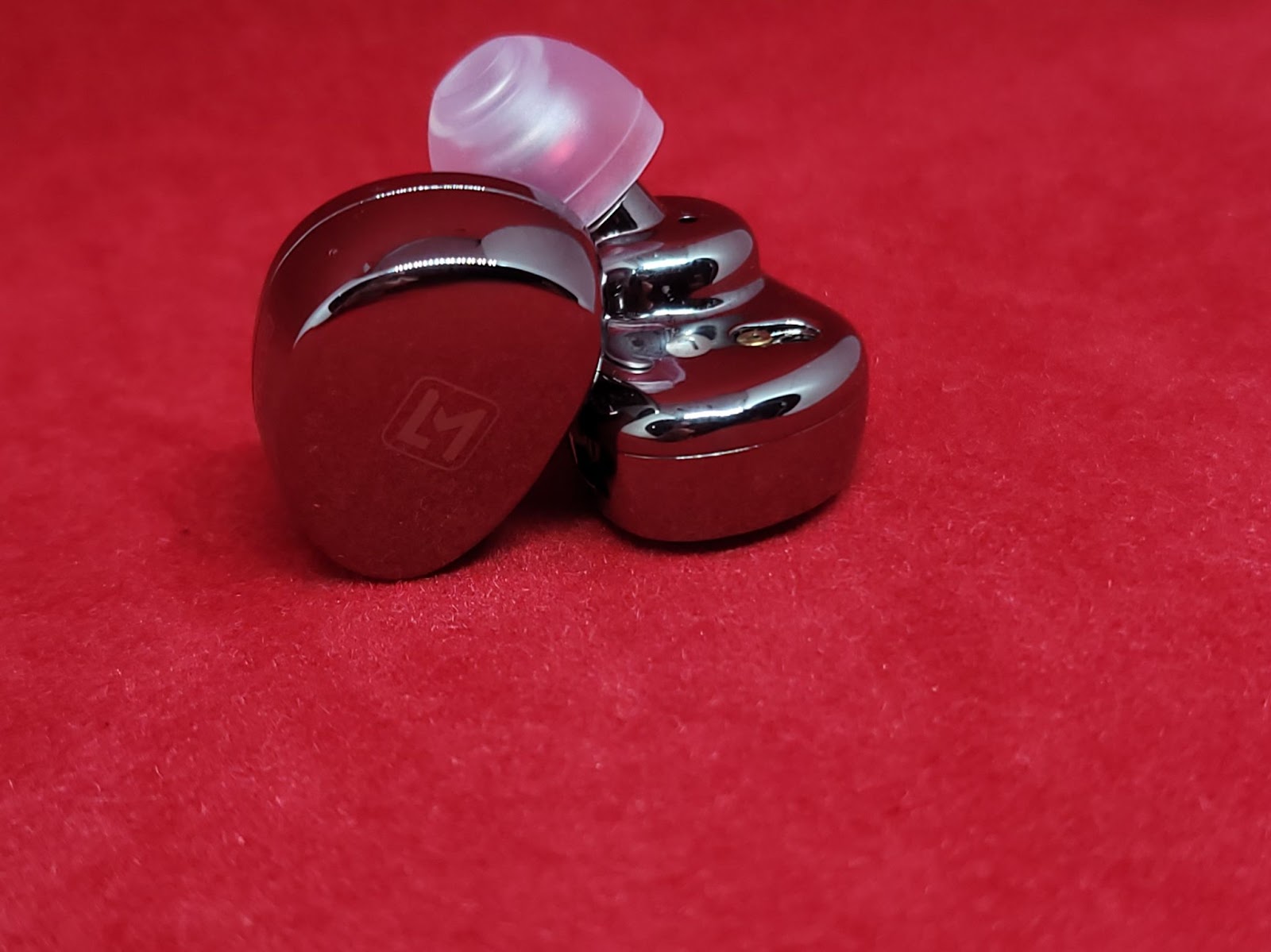
Compared to its predecessor, bass gained some heft and weight. It also extends deeper into the subbass and rumbles more. Attack and decay is very fast and it’s one of the aspects that convinces you that Simgot again used very high quality drivers.
Mids are lovely as always but intensity is somewhat increased. I know some of you find EW200 shouty and harsh and you are probably going to find EA500LM shouty and harsh too. But even in long listening sessions I didn’t feel fatigued at all. Like upper mids, treble is also elevated but unless I cranked up the volume it didn’t feel harsh for me. Instead it sounded very airy and sparkly.
After EA500, I wouldn’t believe they would improve upon it but they actually did. In almost every way they improved subjective experience. I don’t think Simgot achieved it only with the tuning, if that were the case, EW200 would also be superior to the original EA500. EA500LM is highly detailed with great instrument separation. It also feels very spacious and imaging is very precise. I will elaborate in the comparisons section.
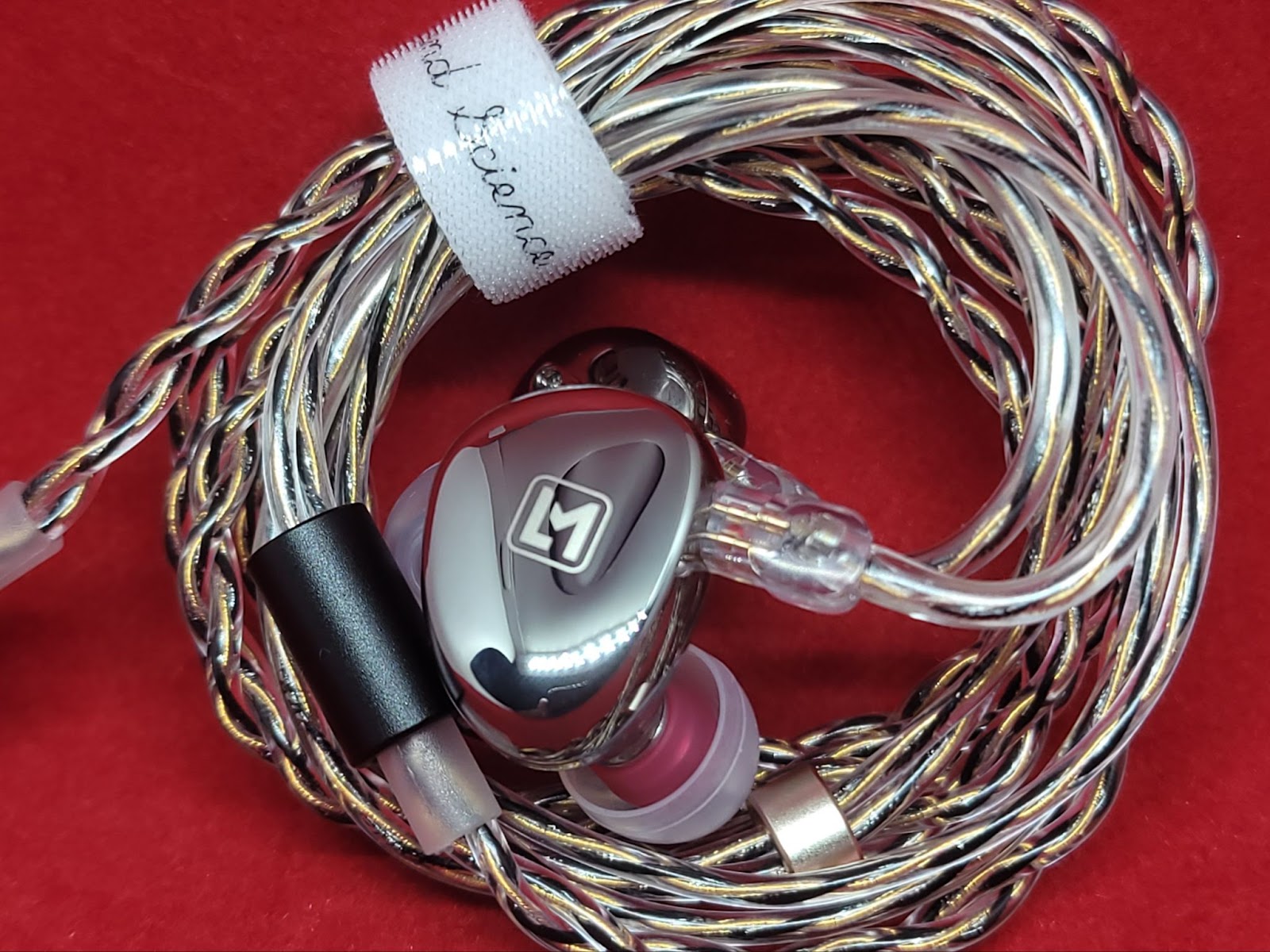
This is the obligatory comparison and I’m not the only one to compare them. However for the sake of convenience I will refer to them as OG and LM in this part.
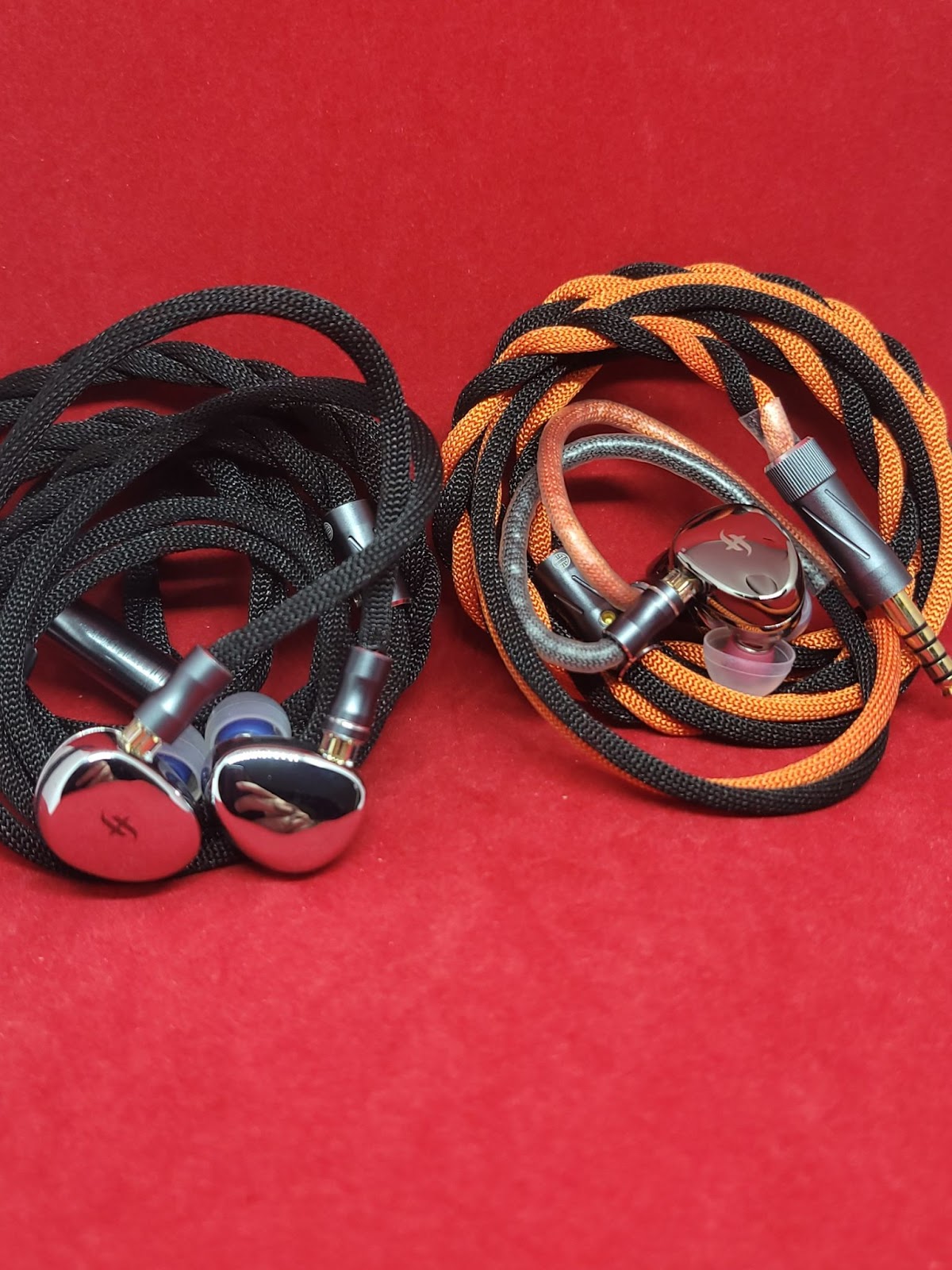
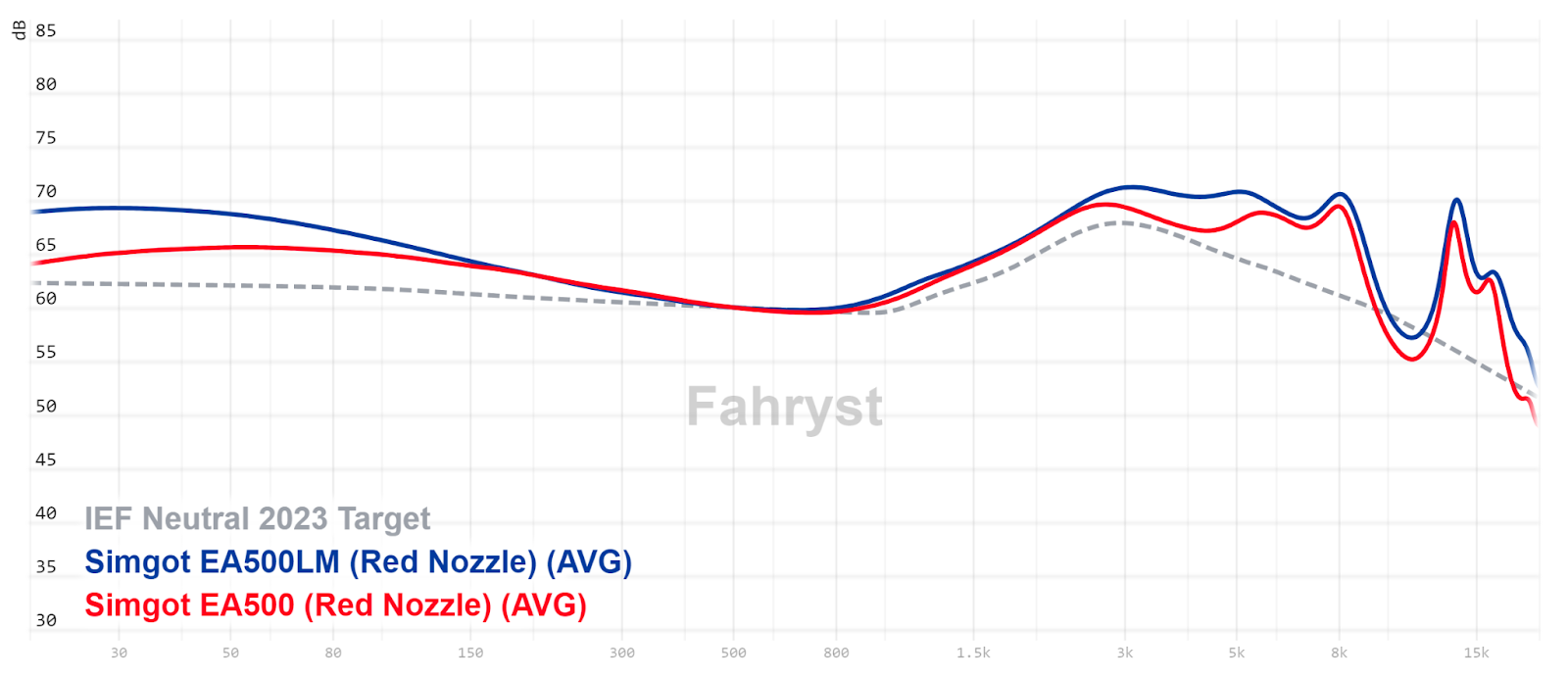
After comparing them for longer than I usually do, I actually couldn’t pick a conclusive winner. LM doesn’t replace the OG for me and OG is still relevant in my opinion. If you want to avoid some shout and treble energy, OG might suit you better. But improvements in technical aspects and bass region cannot be ignored.
Moondrop May has become one the most enjoyable IEMs for me and a default recommendation under 100 USD so I really wanted to put them against each other.
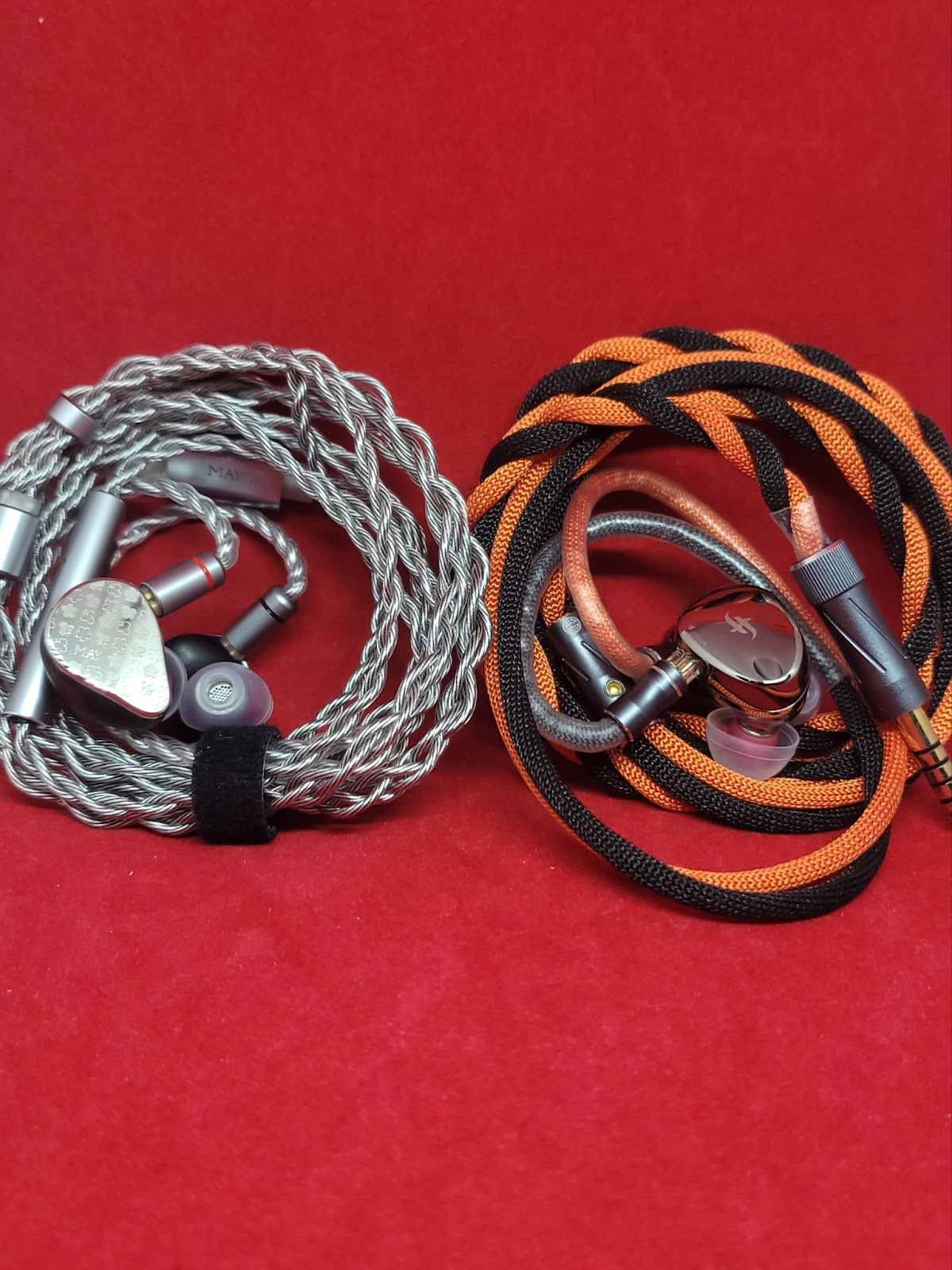
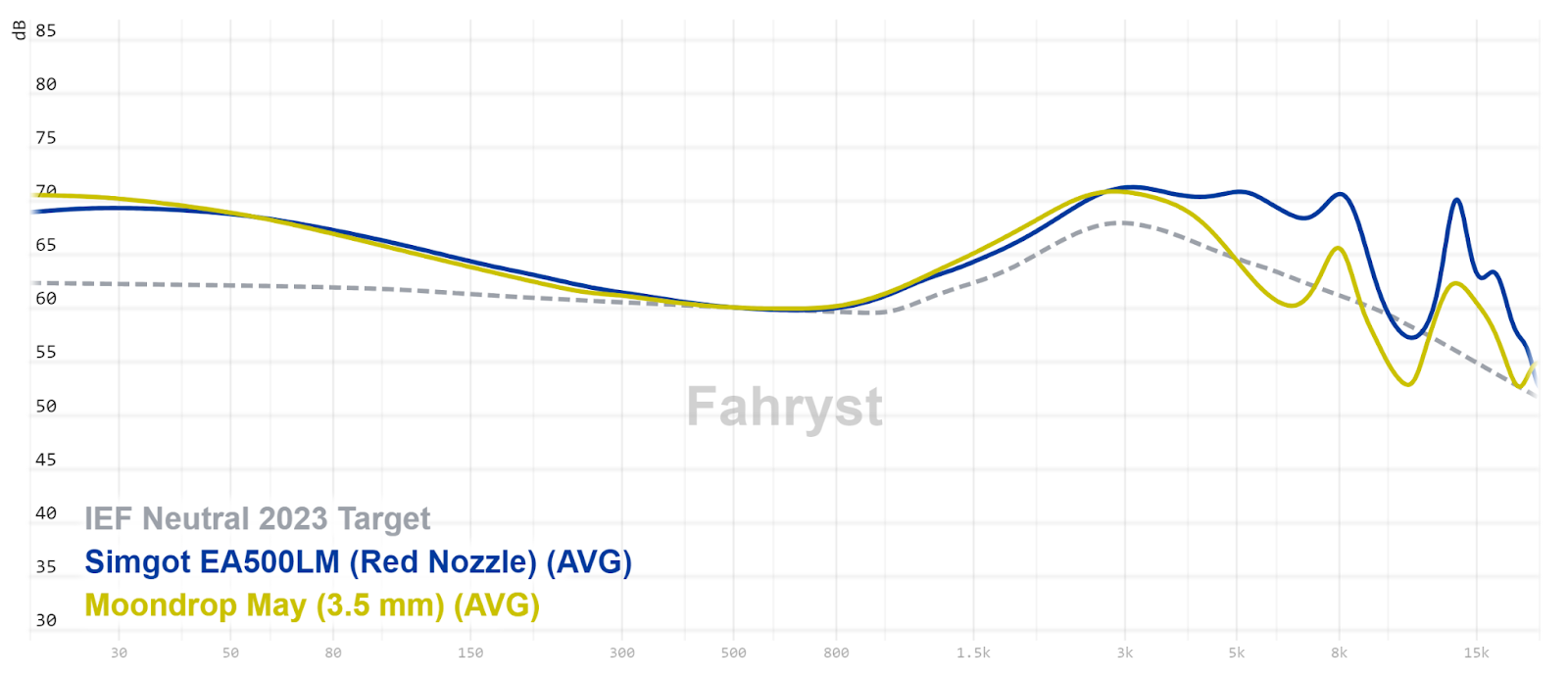
It was fun comparing them and I can definitely say I’m glad to own them both. EA500LM is highly technical with Simgot’s bright tuning, May is very versatile thanks to its cable with less technical capability.
Although Simgot named these EA500LM, like I said in the comparisons section, I don’t think these replace the original EA500. In fact I think EA500LM is the default upgrade if you liked the EW200. Tuning is different enough to keep OG and LM both even though they improved LM technically. EA500 was already a benchmark below 100 USD and LM also became one. The only nitpick I can make is, gold and silver red nozzles aren’t that different. If only one of the nozzles made them closer to the OG EA500. Fine, I will do it myself.
Disclaimers
Simgot EA500LM was provided to me by Simgot for free and I only paid for the customs fee. As I always say, everyone is biased one way or another so take everything you read with a grain of salt. Also I will try to be more concise and to the point in my reviews from now on without worrying about the word count etc. If you have any questions, please ask me in the comments and I will try to answer them to the best of my abilities.
Build and Accessories of Simgot EA500LM
Earpieces of the EA500LM are identical to the original EA500; it’s made fully out of metal, only darker in color. If you like EA500’s fit, then you don’t need to worry at all. Domes of the drivers powering them are, like I said above, made using Lithium and Magnesium.
Packaging and its contents are identical to the original EA500 and EM6L. For those who don’t know, EA500LM comes with an unbranded carrying case, a thin but decent cable, 3 pairs of eartips, 3 pairs of tuning nozzles and spare O rings. Well tuning nozzles and O rings are exclusive to EA500 brothers.
Sound of Simgot EA500LM
Tonality
EA500LM didn’t stray far from the usual Simgot sound. Although they come with 3 tuning nozzles, gold and silver with red rings sound very close. Gold nozzles have tuning foams in them and they somewhat soften the sound but don’t alter the peaks too much so I decided to use the silver nozzles with red rings which don’t feel like they are holding back the IEMs. Nozzles with black filters collect dust since even the other nozzles are already very bright. If only gold nozzles made more difference.
Compared to its predecessor, bass gained some heft and weight. It also extends deeper into the subbass and rumbles more. Attack and decay is very fast and it’s one of the aspects that convinces you that Simgot again used very high quality drivers.
Mids are lovely as always but intensity is somewhat increased. I know some of you find EW200 shouty and harsh and you are probably going to find EA500LM shouty and harsh too. But even in long listening sessions I didn’t feel fatigued at all. Like upper mids, treble is also elevated but unless I cranked up the volume it didn’t feel harsh for me. Instead it sounded very airy and sparkly.
Technicalities
After EA500, I wouldn’t believe they would improve upon it but they actually did. In almost every way they improved subjective experience. I don’t think Simgot achieved it only with the tuning, if that were the case, EW200 would also be superior to the original EA500. EA500LM is highly detailed with great instrument separation. It also feels very spacious and imaging is very precise. I will elaborate in the comparisons section.
Comparisons
Simgot EA500 (original) vs. EA500LM
This is the obligatory comparison and I’m not the only one to compare them. However for the sake of convenience I will refer to them as OG and LM in this part.
- LM is slightly harder to drive.
- Bass on LM has more weight and more power behind it and extends deeper into the subbass. In some songs, bass guitars on the OG sound more prominent but that’s probably caused by the LM having more treble energy.
- Both have incredible mids presentations. OG is slightly cleaner and also less shouty and less intense.
- One is not harsher than the other, surprisingly. Although LM is slightly brighter, shoutier and more intense, they stop at the same line when it comes to harshness and fatigue. In fact LM is slightly more controlled in the treble.
- Timbre is slightly better on the OG but LM is more spacious. LM is more detailed and has more defined notes. Imaging is also sharper on the LM.
After comparing them for longer than I usually do, I actually couldn’t pick a conclusive winner. LM doesn’t replace the OG for me and OG is still relevant in my opinion. If you want to avoid some shout and treble energy, OG might suit you better. But improvements in technical aspects and bass region cannot be ignored.
EA500LM vs Moondrop May
Moondrop May has become one the most enjoyable IEMs for me and a default recommendation under 100 USD so I really wanted to put them against each other.
- May’s bass is more tactile, more impactful and rumblier but EA500LM’s bass is faster in decay and shows its capability in the first attack.
- May’s mids are, although forward, not intrusive. EA500LM is shoutier and more aggressive in the mids, especially in the upper region. Still it is tastefully done in my personal opinion. May has more body in the lower mids. Bass guitars are also more prominent on May.
- EA500LM is more susceptible to sibilance, May is as safe and inoffensive as can be. EA500 is much brighter.
- May has a more agreeable timbre. EA500LM’s timbre is although very good, the treble energy it has sometimes throws off the balance.
- EA500 is technically superior in almost every way. It feels more spacious and detailed. Although May is no slouch, it sounds blunted compared to EA500LM. Imaging is also sharper on EA500LM
It was fun comparing them and I can definitely say I’m glad to own them both. EA500LM is highly technical with Simgot’s bright tuning, May is very versatile thanks to its cable with less technical capability.
Conclusion
Although Simgot named these EA500LM, like I said in the comparisons section, I don’t think these replace the original EA500. In fact I think EA500LM is the default upgrade if you liked the EW200. Tuning is different enough to keep OG and LM both even though they improved LM technically. EA500 was already a benchmark below 100 USD and LM also became one. The only nitpick I can make is, gold and silver red nozzles aren’t that different. If only one of the nozzles made them closer to the OG EA500. Fine, I will do it myself.
Last edited:
Jarlaxle
100+ Head-Fier
Pros: Tactile, nuanced and authoritative bass
Pretty shells
Sounds great with soul, funk and acoustic music
Pretty shells
Sounds great with soul, funk and acoustic music
Cons: Not the most balanced tonality
Shouty
Unnatural timbre
Discrepancy between lower mids and upper mids
Lacks air
Shouty
Unnatural timbre
Discrepancy between lower mids and upper mids
Lacks air
Celest has been on a roll with one successful release after another. For those who don’t know, Celest is Kinera’s sister brand that targets the more budget conscious audience. The most expensive Celest product so far was Phoenix Call which is sold for 129 USD. Plutus beast is the second priciest product Celest has released and sold for 89 USD. Celest also has a number of other successful IEMs like Wyvern, Gumiho and Pandamon and also other accessories like gaming cables with boom mics.
Disclaimers
Celest Plutus Beast was provided to me by Kinera for review. As I always say, everyone is biased one way or another so take everything you read with a grain of salt. Also I will try to be more concise and to the point in my reviews from now on without worrying about the word count etc. If you have any questions, feel free to ask me in the comments and I will try to answer them to the best of my abilities.
Build and Accessories of Celest Plutus Beast
Plutus Beast comes in a simple package like the rest of their line, however it has everything you will need plus a metal bookmark in the usual Celest fashion. Included two sets of tips, the carrying case and the cleaning tool leaves nothing to be desired. Included cable is not very good but it’s serviceable. You can choose either the 3.5 mm or the 4.4 mm option while ordering depending on your needs.
Earpieces of Plutus Beast are made out of resin. Unfortunately I haven’t tried Phoenix Call but from what I gathered, their shell shapes are identical. Art on the faceplates is gorgeous as always. I can’t say they are the best fitting or the most comfortable IEMs I’ve ever used. When I used them with smaller tips, I could insert them deeper in my ears and get the benefit of the Bone Conduction driver inside. Yes, Plutus Beast uses an additional Bone Conduction driver per side, along with their SPD 2.0 and Balanced Armature drivers, again one of each per side. Bone conduction makes a springy sound whenever you touch the shells which might be annoying at first, but when you securely insert them in your ears and play your music, you forget that there was such a thing in the first place.
Sound of Celest Plutus Beast
Tonality
Plutus Beast is not the most balanced IEM tonally, and that’s not the point. It’s more about showing its power and what it is capable of. You can think of it as a technology demo or a prototype maybe. Does it mean it sounds bad? Absolutely not. Let me explain:
Bass on the Plutus Beast might be the sole reason to buy these IEMs. Thanks to the BC driver, Plutus Beast produces one of the most tactile, authoritative and nuanced bass there is, at least close to its price range. The only IEM that performed close to it was BQEYZ Wind, which also utilized a BC driver. Unfortunately I only demoed Wind for a short time a while back and couldn’t compare them head to head.
There is a discrepancy in Plutus Beast’s midrange, lower mids are too recessed compared to upper mids, or rather upper mids are too pronounced and shouty. While female vocals sound intimate and emotional, overall timbre takes a hit and Plutus Beast sounds dry and tinny. Male vocals could use a little bit more body too.
Treble on Plutus Beast is mostly relaxed but there is a very narrow peak between 7k and 8k which shows itself occasionally. Other than that, it lacks air and feels kind of closed in.
Like I said in the beginning, Plutus Beast isn’t exactly tonally balanced, but specific genres sound lovely with these. I especially enjoyed listening to Funk, Soul and Acoustic performances.
Technicalities
Technically, Plutus Beast competes well in its price range. It has fine resolving capability. However timbre isn’t very natural because of the tuning quirks I mentioned. Headstage isn’t particularly big either. Comparisons should shed more light to Plutus Beast’s technical attributes.
Comparisons
Celest Plutus Beast vs. BQEYZ Winter
BQEYZ Winter is another IEM that fashions a Bone Conduction driver, however it works mostly in the midrange and lower treble so each provides different benefits. I wish I had BQEYZ Wind with me for comparison which would make more sense in terms of Bone Conduction utility.
- In the bass region, Plutus Beast beats Winter hands down, it has more impact, more rumble, more nuance and more authority in the bass.Winter doesn’t have a huge bass however, by itself it has a commendable bass response thanks to its 12 mm dynamic driver.
- Winter is more balanced. Plutus Beast is undoubtedly shoutier. While female vocals are mostly close and intimate, male vocals feel distant and lack body on Plutus Beast.
- Neither is particularly harsh or sibilant. Winter has more energy, air and snap in the treble. Plutus Beast’s treble is more relaxed and a little blunted.
- Plutus Beast has a pretty good resolving capability but unfortunately still not as resolving as Winter. Plutus Beast has more details in the bass region, Winter on the other hand, is more detailed in the mids and treble areas.
- Headstage on Winter is wider, deeper and imaging is more precise.
Celest Plutus Beast vs. Audiosense AQ4
Audiosense AQ4 has been one of my go to IEMs for pure bass enjoyment without sacrificing overall tonality too much. Of all the IEMs I have, it made the most sense to compare even though it is a more expensive choice.
- AQ4 has a more boomy and pillowy bass. Plutus Beast’s bass has more authority, a faster decay and better control. Bass on Plutus Beast is also more nuanced.
- Their lower mids tuning is similar but upper mids emphasis on Plutus Beast throws off the balance. As a result AQ4 again has a more natural warmth and body in the lower mids. In the upper mids, again Plutus Beast is much shoutier while AQ4 is more relaxed. Guitars, piano, string instruments and such are also more emphasized on Plutus Beast.
- Both have rather relaxed treble, moreso on AQ4 but it has better treble extension.
- AQ4 has a much better timbre. It’s also more resolving in the mids and treble while Plutus Beast is more resolving in the bass. But AQ4’s more relaxed treble might not highlight some of these details even if it renders them.
- AQ’s headstage is slightly wider and much deeper than Plutus Beast’s. Imaging is also again more precise.
Conclusion
Plutus Beast isn’t an all rounder, that’s for certain. It could have been more balanced. In fact when I tried to EQ it, I got rid of almost all of my gripes. But as it is, it’s more of a genre specific IEM. Bass on these is to die for. Soul and Funk performances sound lovely. So if you want the cheapest IEMs with Bone Conduction drivers, or if you love your bass above all else or you are fine with using EQ, Plutus Beast is an IEM definitely worth a try.
kapsontong
Spectacular review!
Jarlaxle
100+ Head-Fier
Pros: Price!
Great neutral bright tuning
Good comfort
Great neutral bright tuning
Good comfort
Cons: Minor quirks in tonality
Nothing more at this price
Nothing more at this price
Hifiman needs no introduction as they make some of the best headphones in every price category. I have owned several Hifiman headphones and reviewed a couple of them before. In general, they all impressed me and became my benchmarks. HE400se is Hifiman’s entry level planar magnetic headphones that are currently priced at 109 USD but can be bought for even cheaper during sales.
Disclaimers
Hifiman HE400se was provided to me by Mark from Hifiman for free and I only paid the customs fees. As I always say, everyone is biased one way or another so take everything you read with a grain of salt. Also I will try to be more concise and to the point in my reviews from now on without worrying about the word count etc. If you have any questions, please ask me in the comments and I will try to answer them to the best of my abilities.Build and Accessories of Hifiman HE400se
Since HE400se is Hifiman’s entry model, it would be unfair to expect too much from it in terms of construction and accessories. So headphones being presented in an environment friendly cardboard box and only coming with a rubberized cable didn’t bother me too much.
Materials used in its construction are mostly plastic with only yolks being metal and headband being leatherette. In fact the materials are almost identical with Edition XS and HE6se v2. So while I can’t fault the choices in its construction considering the price, it’s more frustrating that higher models don’t offer a more premium experience.
Headband is mostly comfortable since it’s not too heavy. This wasn’t the case with the Edition XS since its headband caused a hot spot on top of my head. In the case of HE6se v2, while it was fairly comfortable, it wasn’t staying firmly on my head so I replaced it’s headband with a Audeze styled one.
HE400se is not exactly easy to drive. I would recommend using an amplifier with a decent power output. Probably something along the lines of 500 mW or 1 Watt should suffice.
Sound of Hifiman HE400se
Tonality
HE400se proudly represents Hifiman’s bright/neutral house sound. Bass is not very emphasized but not exactly linear either. It has a tint of warmth if we consider Diffuse Field as strictly neutral. There is also a slight sub bass roll off due to the leakage in the seal in the pads.Mids tuning is again mostly neutral with slight deviations. HE400se also has Hifiman’s usual 2k dip which helps with the sound stage but also gives a slight unnatural sensation. It’s more true for this one as the voices sound like they are coming through a tunnel ever so slightly. By itself you wouldn’t notice it but it becomes apparent when you change headphones or compare it directly to something more “natural”.
Like other Hifiman planars, HE400se is also bright but I wouldn’t call them harsh. In fact it doesn’t have the tizzy and fatiguing nature even some of the higher models have but you can also say HE400se doesn’t have their treble extension and detail level. It's also not as refined as its bigger brothers but by itself, it’s hard to complain.
Technicalities
HE400se is a cheap planar and this translates to several things. It’s mostly superior to the headphones with dynamic drivers that are even more expensive but doesn’t beat more expensive headphones with planar magnetic drivers and other novel technologies. It has good details and staging capabilities. Timbre is surprisingly good but not exceptional. As always, comparisons will give more context to what I try to convey.Comparisons
Hifiman HE400se vs. Hifiman Sundara
I didn’t expect the HE400se to beat its bigger brother but this comparison should help those you are considering an upgrade in the future or wondering if they should directly jump to Sundara.- Sundara is mostly made out of metal while HE400se is mostly plastic.
- They both have similar sound signatures.
- Sundara immediately sounds clearer and more refined.
- Sundara has more noticeably impact, authority and control in the bass. They both have similar subbass extensions. HE400se is slightly warmer and has a little bit more midbass quantity.
- There is a bigger scoop in the mids on HE400se which makes it sound like voices coming from further away through a tunnel but it doesn’t necessarily sound wider.
- Sundara sounds wider, deeper, more open and spacious.
- HE400se is more likely to get sibilant depending on the volume you are listening to.
- Timbre is more natural on Sundara throughout the frequency spectrum but especially in the mids.
- Sundara is a step up to HE400se in every thinkable technical aspect, it’s more detailed and resolving, has better layering and separation of instruments, sounds more spacious and imaging is better. You simply feel more perceptive of your surroundings with Sundara. But HE400se puts out around 70% of Sundara’s performance, which is considered a modern classic already, for around one third of its price.
Hifiman HE400se vs. Monoprice Monolith M570
Monolith M570 are planar magnetic headphones that are from the family of Sendy Aiva, Sivga P-II, BLON BL20 and Takstar HF580. They cost 300 USD when they were released but sold for less than 150 USD before they were discontinued.- Build quality and materials are much more premium on the M570.
- M570 is even warmer and has a thicker note weight. Bass is again more impactful and it has more authority and power behind it, but M570 also has more detail and texture in the bass. M570 extends much better into the subbass and rumbles more.
- Mids, especially lower mids up to 1-1.5 kHz are emphasized on M570. Vocals are pretty much neutral on HE400se, on M570 on the other hand, they are close and personal and sometimes honky. This makes presentation on M570 more emotional while HE400se sounds more natural.
- HE400 is brighter, it’s also again more likely to get sibilant with the volume but, M570 is not particularly dark either.
- Upper mids and lower treble are similar on both but M570 has more treble sizzle and snap. Still tonal balance skewed more toward low frequencies on M570 so overall they are warmer headphones.
- Timbre on HE400se is more natural. M570, although sounds enjoyable, has tuning quirks and is not exactly natural.
- Their imaging capabilities are similar, M570’s headstage isn’t particularly wider but it’s deeper than HE400se. M570 is more resolving and has better separation and layering capability.
Conclusion
I will be honest, I missed reviewing full size headphones so I had a great time reviewing HE400se. My comparisons were all with higher tier headphones because I was already impressed with them from the start. They are very well tuned, especially at their price. They didn’t outright beat any of them, true, but around 100 USD I can’t think of any headphones that’s better. So probably the lesson you should learn from this review is that HE400se is probably the best headphones around 100 USD but if you decide to spend more, you can definitely get more.
Last edited:
Jarlaxle
100+ Head-Fier
Pros: Price
Planar technicalities
Great fit and comfort
Nice cable
Planar technicalities
Great fit and comfort
Nice cable
Cons: Planar timbre
It could use a little more midbass
Slightly intense
It could use a little more midbass
Slightly intense
Evaluating Artti T10 was rather easy for me. Because I’m pretty familiar with the planar sound, especially on the IEMs that came after 7Hz Timeless. But before spoiling the review too much, I should introduce T10.

Artti T10 is the first IEM Artti has released. Before T10, I reviewed their R1, which was a 3 Dynamic Driver IEM. While it was tuned very well, it didn’t exactly suit my taste. I was expecting the T10 to be better for me because of how it measured pretty much the same as the other planars in the market with a cheaper price tag. Coming at 69 USD MSRP, is T10 the cheapest “good” planar?
I bought the Artti T10 with a discount in exchange for a review. As I always say, everyone is biased one way or another so take everything you read with a grain of salt. Also I will try to be more concise and to the point in my reviews from now on without worrying about the word count etc. If you have any questions, please ask me in the comments and I will try to answer them to the best of my abilities.
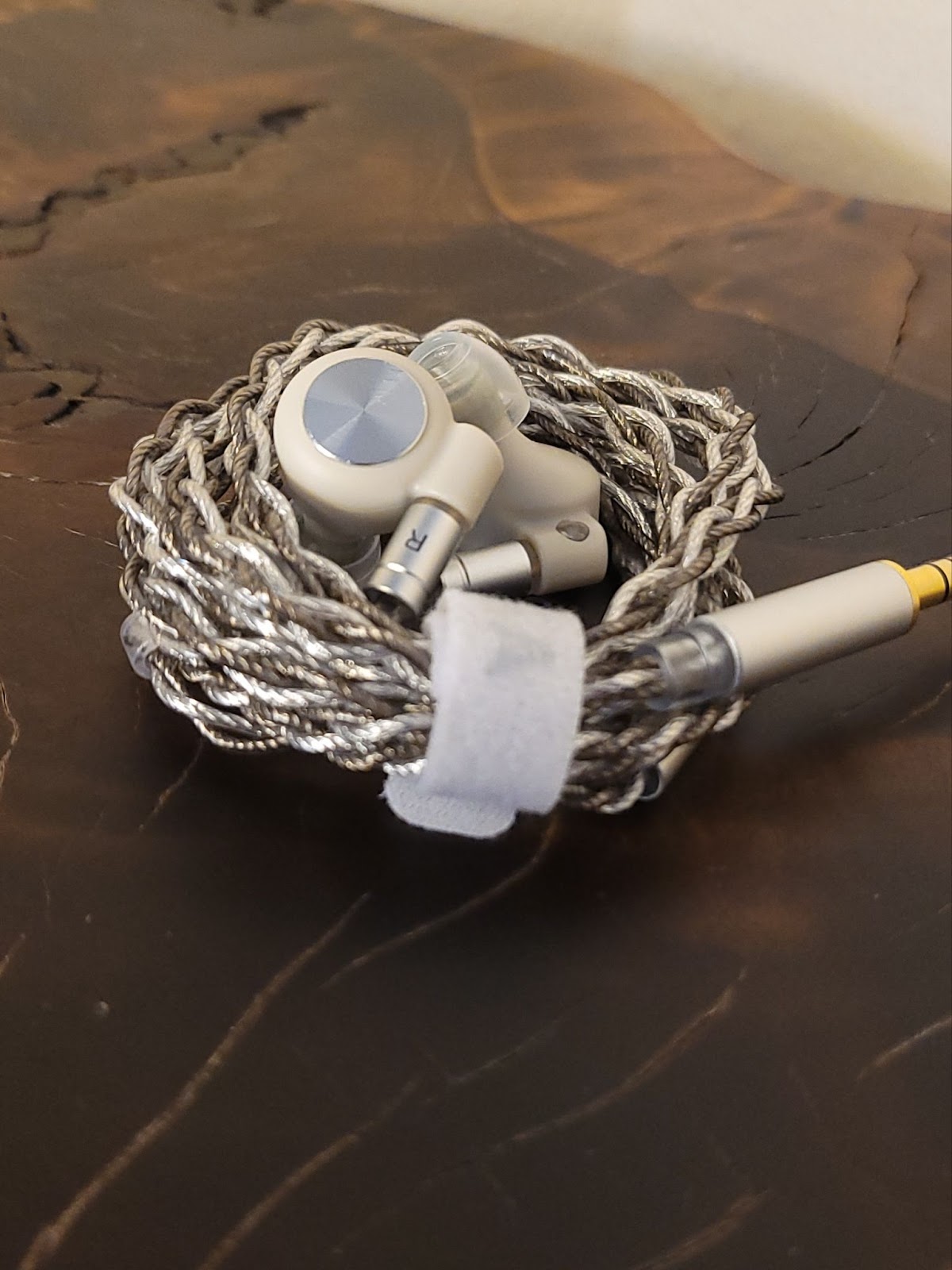
Artti T10 uses a 14.2 mm planar magnetic driver. This driver is probably the same that has been extensively used by the other manufacturers including LetShuoer in their S12, S12 Pro and Z12. One thing however, the T10 is harder to drive than my S12. It’s not impossible to drive but you should get better results with a decent dongle, DAP or something like that.
Packaging and accessories is again similar to the LetShuoer offerings just like R1. Actually everything is identical with R1 except the shell material, tip and cable colors.

The Shells of the T10 are plastic, and a very cheap one at that. It might be the cheapest feeling plastic on an IEM I’ve ever seen. At least it is light and very comfortable. Nozzles are angled and rather long allowing a deeper insertion.
Cable that comes with T10 is probably the same one that comes with LetShuoer’s DZ4, a 4 core silver plated copper with 4.4 mm and 3.5 mm options. I can say that it’s one of the better stock cables I’ve got. Both LetShuoer and Artti deliver in that regard.
Apart from the cable, T10 again comes with two sets of tips, one wide bore and one regular. Included case is a fabric one identical to the one that came with the R1.
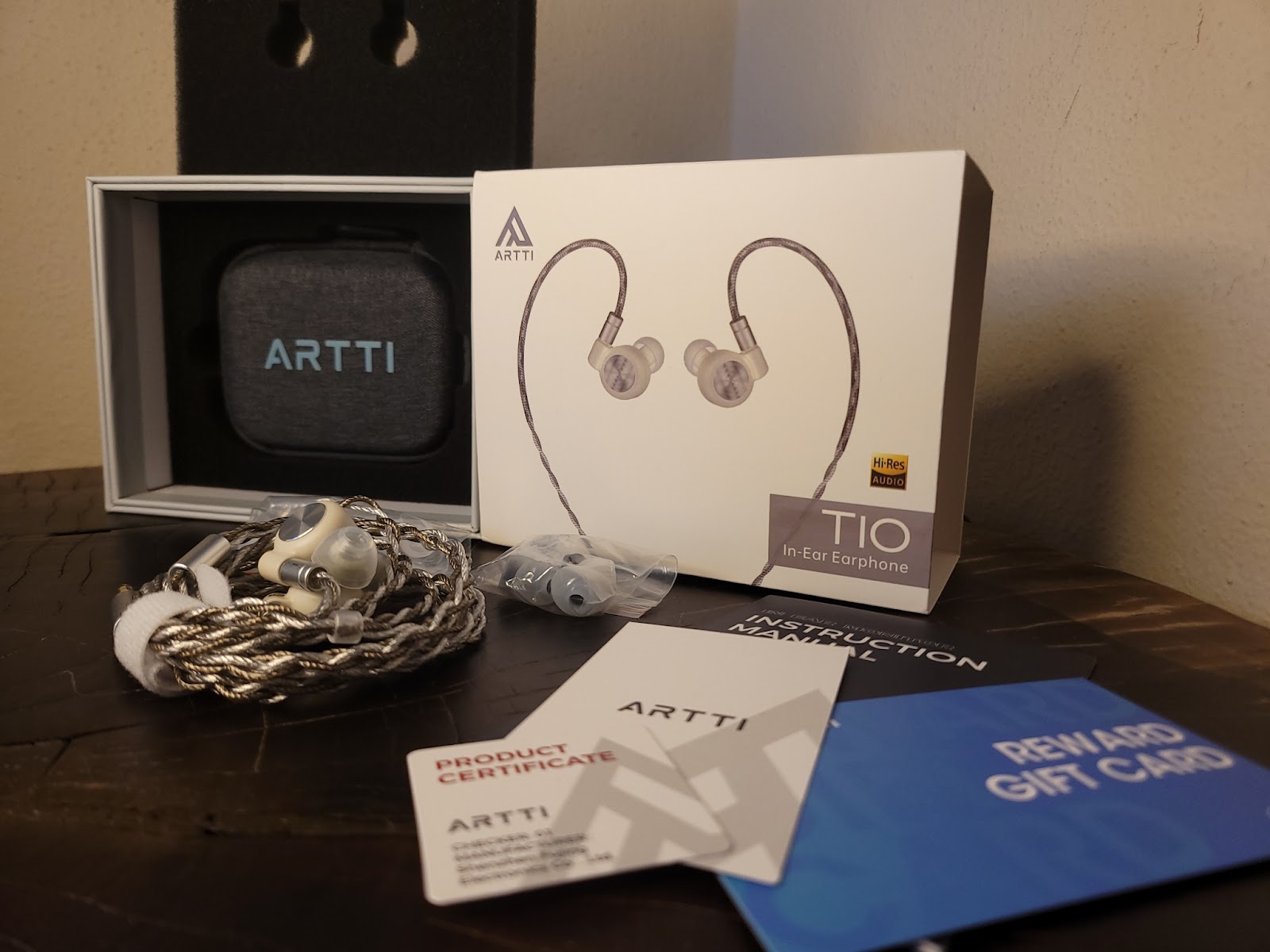
If you have used planar magnetic IEMs before, Artti T10 would come very familiar with a few refinements. Like the usual planar fashion, bass decay is fast and the feeling is rather dry. Tuning is subbass focused with nice grunt and rumble. Still I can see some people left wanting for a little more quantity.
Mids on the T10 again well tuned and mostly on point, upper mids however, are forward and borderline shouty. Newest planar IEMs moved away from this approach but T10 followed its predecessors in that regard.
Treble, like S12 and others, is emphasized. However it mostly stays on the safe side without getting too sizzly and splashy. I didn’t feel fatigued even after hours of listening.
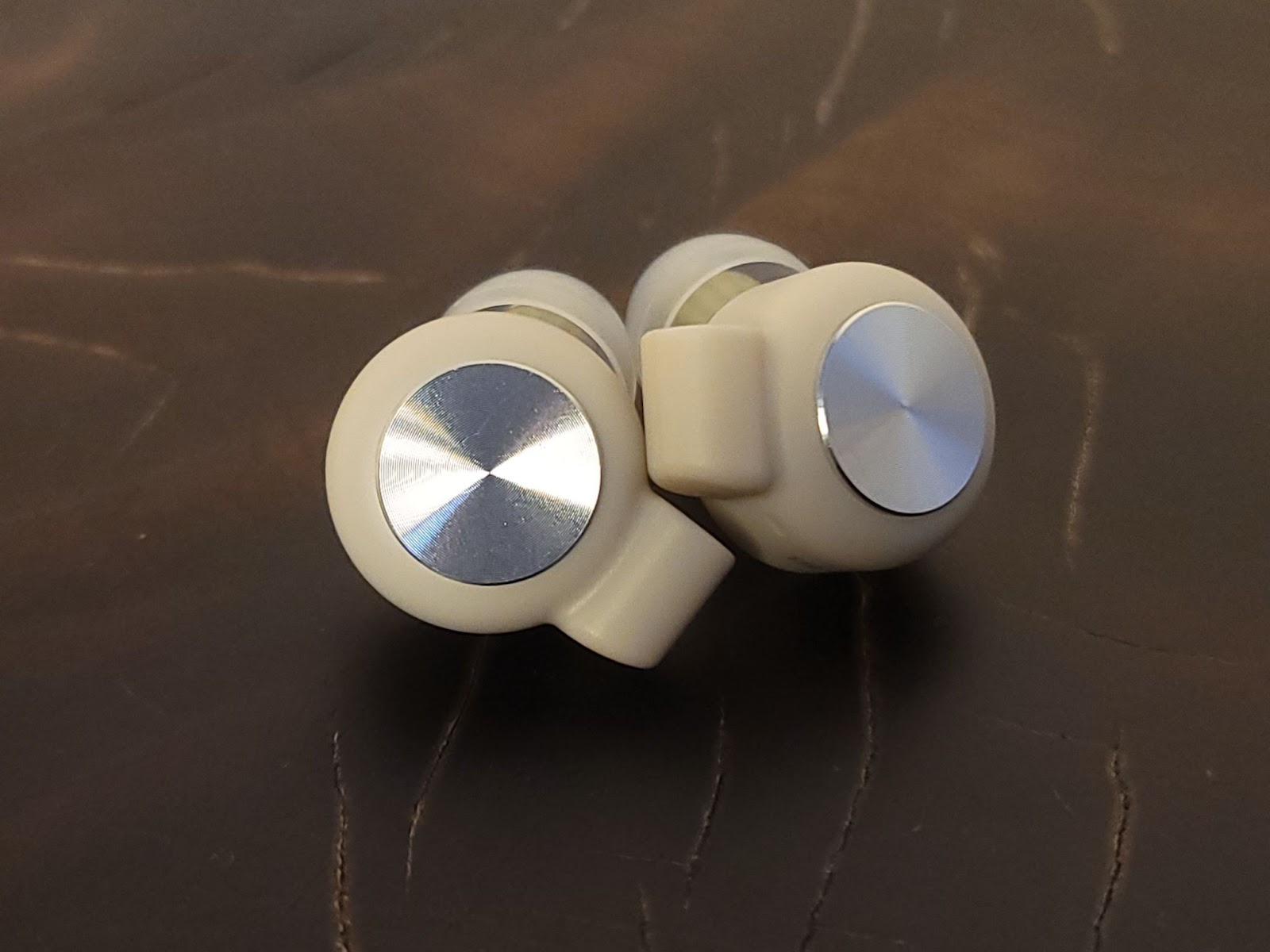
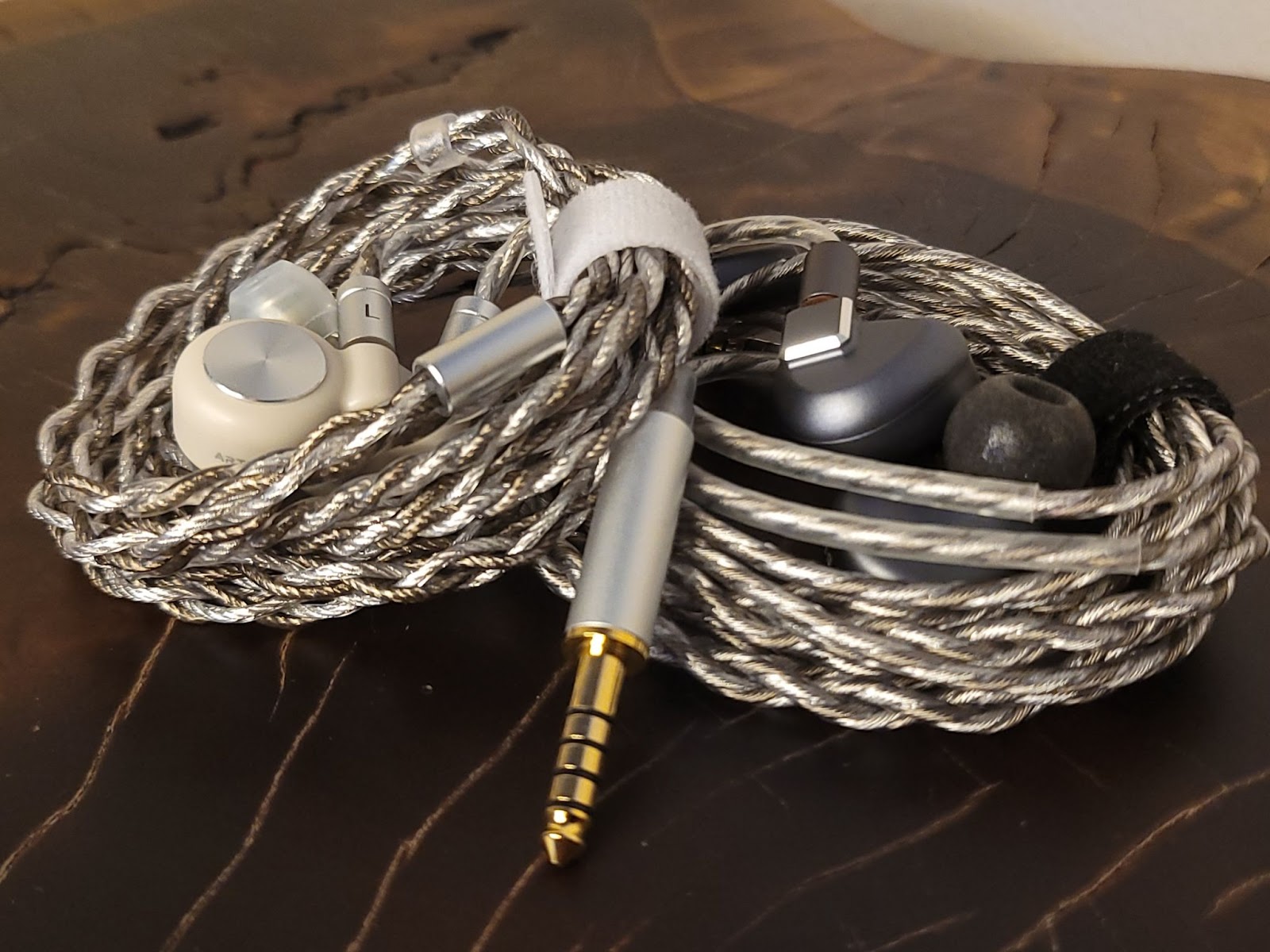
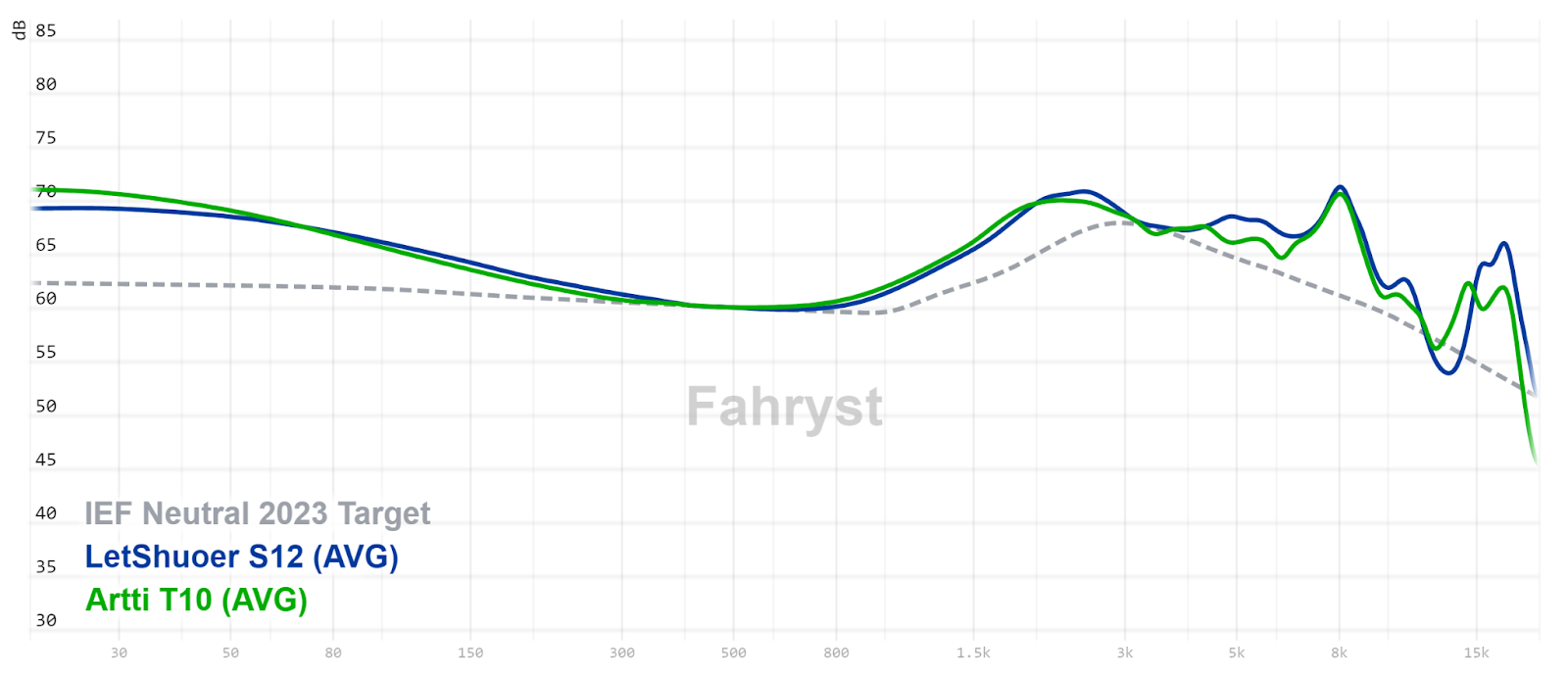
I’m not gonna lie, I had high expectations for T10. If it was just a cheaper S12, that would already be a win but surpassing that? I wasn’t expecting that at all. These last few weeks, I didn’t have much time to listen to my other planar IEMs and headphones and while reviewing T10 I noticed how much I missed this sound. It could easily be a 5-star review at the price T10 is offered. However that would imply that T10 is a perfect IEM, which it isn’t. It still has some quirks that other planar IEMs have, like sounding a little dry and intense. But for 70 USD (actually it can usually be found for less than 50 USD on aliexpress) I don’t know why someone looking for technicalities would buy anything else below 100 USD.
Artti T10 is the first IEM Artti has released. Before T10, I reviewed their R1, which was a 3 Dynamic Driver IEM. While it was tuned very well, it didn’t exactly suit my taste. I was expecting the T10 to be better for me because of how it measured pretty much the same as the other planars in the market with a cheaper price tag. Coming at 69 USD MSRP, is T10 the cheapest “good” planar?
Disclaimers
I bought the Artti T10 with a discount in exchange for a review. As I always say, everyone is biased one way or another so take everything you read with a grain of salt. Also I will try to be more concise and to the point in my reviews from now on without worrying about the word count etc. If you have any questions, please ask me in the comments and I will try to answer them to the best of my abilities.
Configuration, Build and Accessories of Artti T10
Artti T10 uses a 14.2 mm planar magnetic driver. This driver is probably the same that has been extensively used by the other manufacturers including LetShuoer in their S12, S12 Pro and Z12. One thing however, the T10 is harder to drive than my S12. It’s not impossible to drive but you should get better results with a decent dongle, DAP or something like that.
Packaging and accessories is again similar to the LetShuoer offerings just like R1. Actually everything is identical with R1 except the shell material, tip and cable colors.
The Shells of the T10 are plastic, and a very cheap one at that. It might be the cheapest feeling plastic on an IEM I’ve ever seen. At least it is light and very comfortable. Nozzles are angled and rather long allowing a deeper insertion.
Cable that comes with T10 is probably the same one that comes with LetShuoer’s DZ4, a 4 core silver plated copper with 4.4 mm and 3.5 mm options. I can say that it’s one of the better stock cables I’ve got. Both LetShuoer and Artti deliver in that regard.
Apart from the cable, T10 again comes with two sets of tips, one wide bore and one regular. Included case is a fabric one identical to the one that came with the R1.
Sound of Artti T10
Tonality
If you have used planar magnetic IEMs before, Artti T10 would come very familiar with a few refinements. Like the usual planar fashion, bass decay is fast and the feeling is rather dry. Tuning is subbass focused with nice grunt and rumble. Still I can see some people left wanting for a little more quantity.
Mids on the T10 again well tuned and mostly on point, upper mids however, are forward and borderline shouty. Newest planar IEMs moved away from this approach but T10 followed its predecessors in that regard.
Treble, like S12 and others, is emphasized. However it mostly stays on the safe side without getting too sizzly and splashy. I didn’t feel fatigued even after hours of listening.
Technicalities
Planar magnetic IEMs always impress with their technicalities. Personally, I think you can’t get something technically better than planars below 500 USD if you don’t mind the timbre of course. T10 is no different in that regard, it is as resolving and detailed as its predecessors. It also has a very sharp imaging and feels decently spacious. Again like other planars, timbre is not exactly the best but there is an improvement here too. If you listen to T10 after a good single DD, you notice it sounds off but in a vacuum it does a good job. As always, a comparison will give more context to what I tried to describe.Comparisons
Artti T10 vs LetShuoer S12
The similarity in the graphs is uncanny. So much so that I thought T10 is just a recycled S12. But A/B comparison proved otherwise.- T10 is harder to drive.
- Graphs may look almost identical but differences are more substantial than the graphs indicate, probably because of the insertion depth of the nozzles. Shell materials and other differences also might be the cause.
- S12 has slightly more body. Bass impact is similar. T10 extends better into the subbass with more rumble.
- Tuning in mid frequencies is more or less the same. They are both forward in the upper mids. Vocals are intimate and borderline shouty. Moreso on the S12.
- Both have some treble emphasis and intensity. S12 is harsher, more intense and more prone to sibilance. I usually use my S12 with foam tips and after a while get fatigued. I didn’t have such an issue with T10.
- Timbre is better on T10 although it still has the metallic sizzly planar timbre. S12 has more air and sounds slightly more open.
- Both are very resolving and detailed.That is the trademark of planars. But S12 feels like it spoon feeds you the details with more treble emphasis, T10 not so much.
- They both have laser sharp imaging. Staging is also pretty good on both. They sound open and wide. S12’s headstage might be slightly wider.
Conclusion
I’m not gonna lie, I had high expectations for T10. If it was just a cheaper S12, that would already be a win but surpassing that? I wasn’t expecting that at all. These last few weeks, I didn’t have much time to listen to my other planar IEMs and headphones and while reviewing T10 I noticed how much I missed this sound. It could easily be a 5-star review at the price T10 is offered. However that would imply that T10 is a perfect IEM, which it isn’t. It still has some quirks that other planar IEMs have, like sounding a little dry and intense. But for 70 USD (actually it can usually be found for less than 50 USD on aliexpress) I don’t know why someone looking for technicalities would buy anything else below 100 USD.
Jarlaxle
100+ Head-Fier
Pros: Good build
Great Price
Included accessories (modular cable, tuning nozzles, 7 pair of tips, case)
Balanced tuning with great mids and impactful bass
Great Price
Included accessories (modular cable, tuning nozzles, 7 pair of tips, case)
Balanced tuning with great mids and impactful bass
Cons: Fatiguing
Mediocre technicalities
Tuning nozzles should have been implemented better
Occasional harshness
Mediocre technicalities
Tuning nozzles should have been implemented better
Occasional harshness
TRN is one of the Chinese IEM makers that are better known for their budget offerings. They haven’t released a noticeable product for a while and seemed to have been left behind by their competition as other companies also released some bangers in their territory. But then they dropped Conch. For 35 USD, an IEM with metal shells, a cable with interchangeable terminations, 3 pairs of different tuning nozzles, decent selection of tips and an aluminum carrying case is still unthinkable below 100 USD.
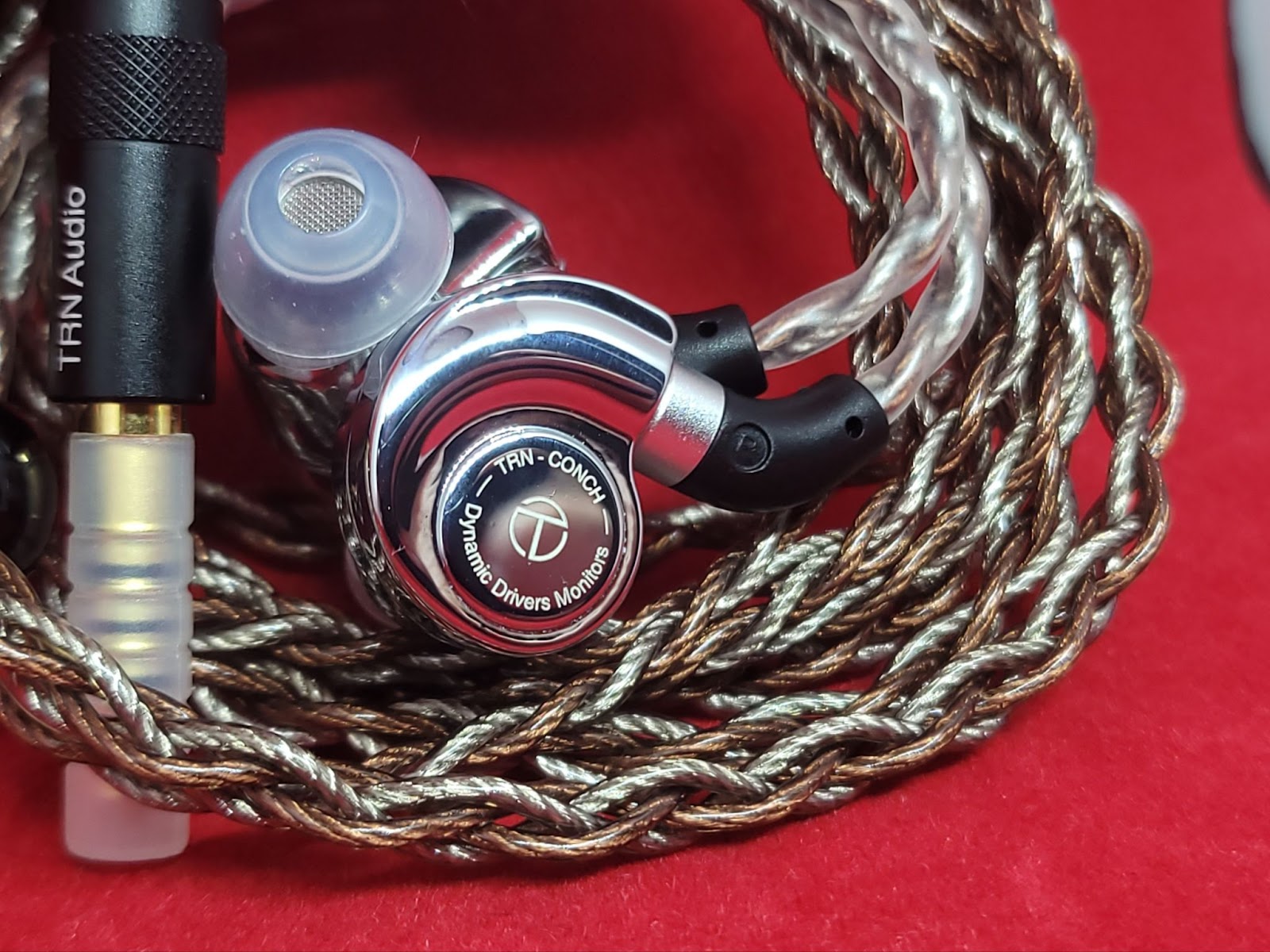
TRN Conch was provided to me by Cloris from shenzhenaudio.com for free. As I always say, everyone is biased one way or another so take everything you read with a grain of salt. Also I will try to be more concise and to the point in my reviews from now on without worrying about the word count etc. If you have any questions, please ask me in the comments and I will try to answer them to the best of my abilities.
With my enthusiasm above, I kind of spoiled this part. Yes earpieces of conch are fully made out of metal, and a heavy one at that. They are heavier than Simgot EW200 for example. Although they are fairly comfortable, weight causes some fatigue for me after a while.
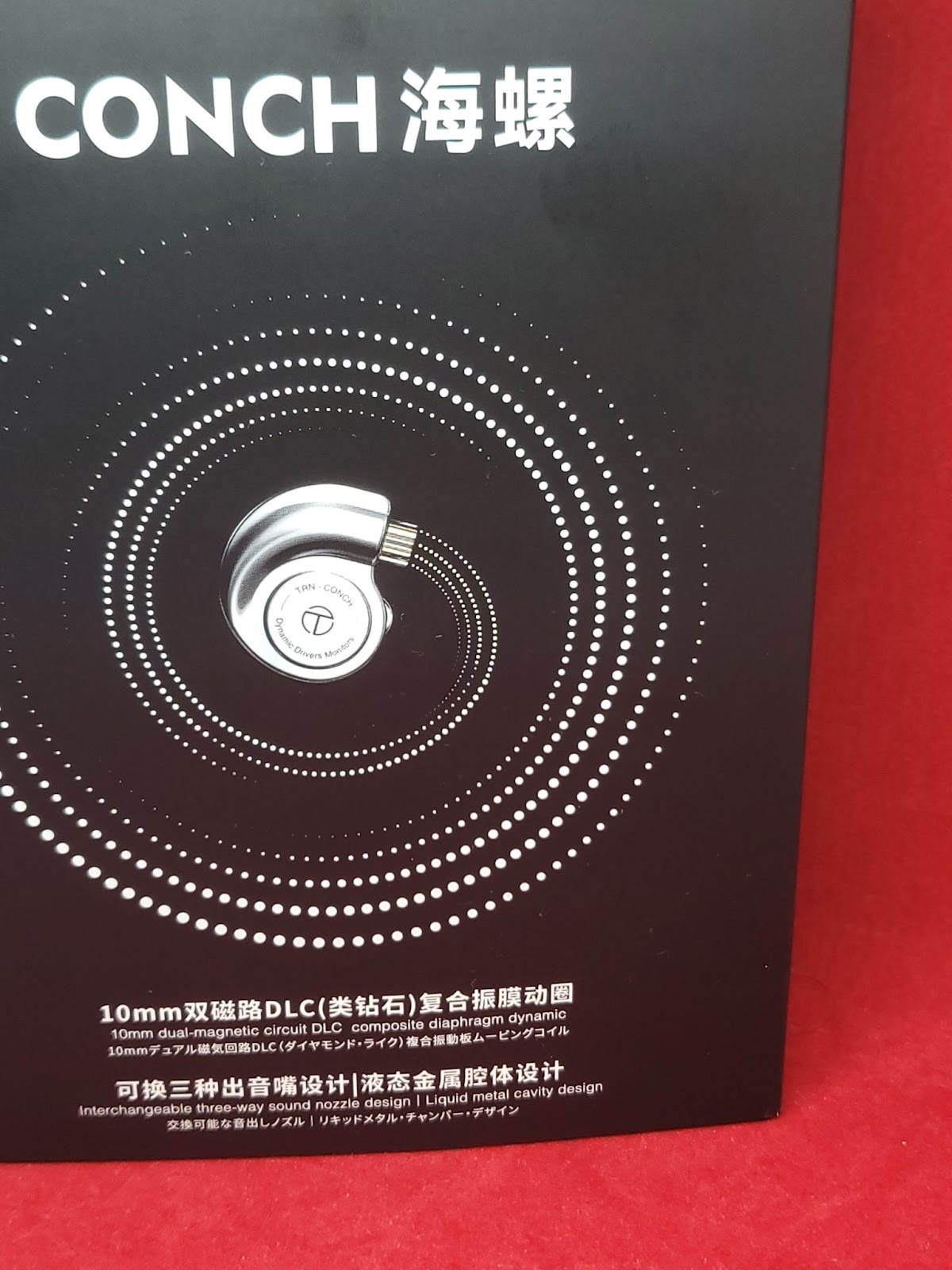
Conch uses a QDC or C-pin type of connector. Cable provided with the IEMs is a silver plated OFC one. It’s nothing too impressive but definitely better than probably anything that comes with an IEM at this price. Furthermore, TRN usually only sends one termination with their modular cables but they included all three (3.5 mm, 2.5 mm and 4.4 mm) terminations in the packaging.
Tip inclusion is also very generous. There are a total of two sets of silicon and a pair of memory foam tips. I should mention that one of the sets is theirT-Ear tips which I used throughout all of my listening. Aluminum case is also identical to the cases that come with Whizzer Kylin IEMs.

Balanced could be the best word to describe Conch’s tonality but there is more to it than that. First of all there are tuning nozzles. Unfortunately, only the red nozzles were usable for me. Even the black nozzles were too shouty, bright and harsh so I couldn’t even dare to try the blue ones. While red nozzles sounded good, they kind of held back the IEMs a little so something in between red and black nozzles would have been great. Modders?
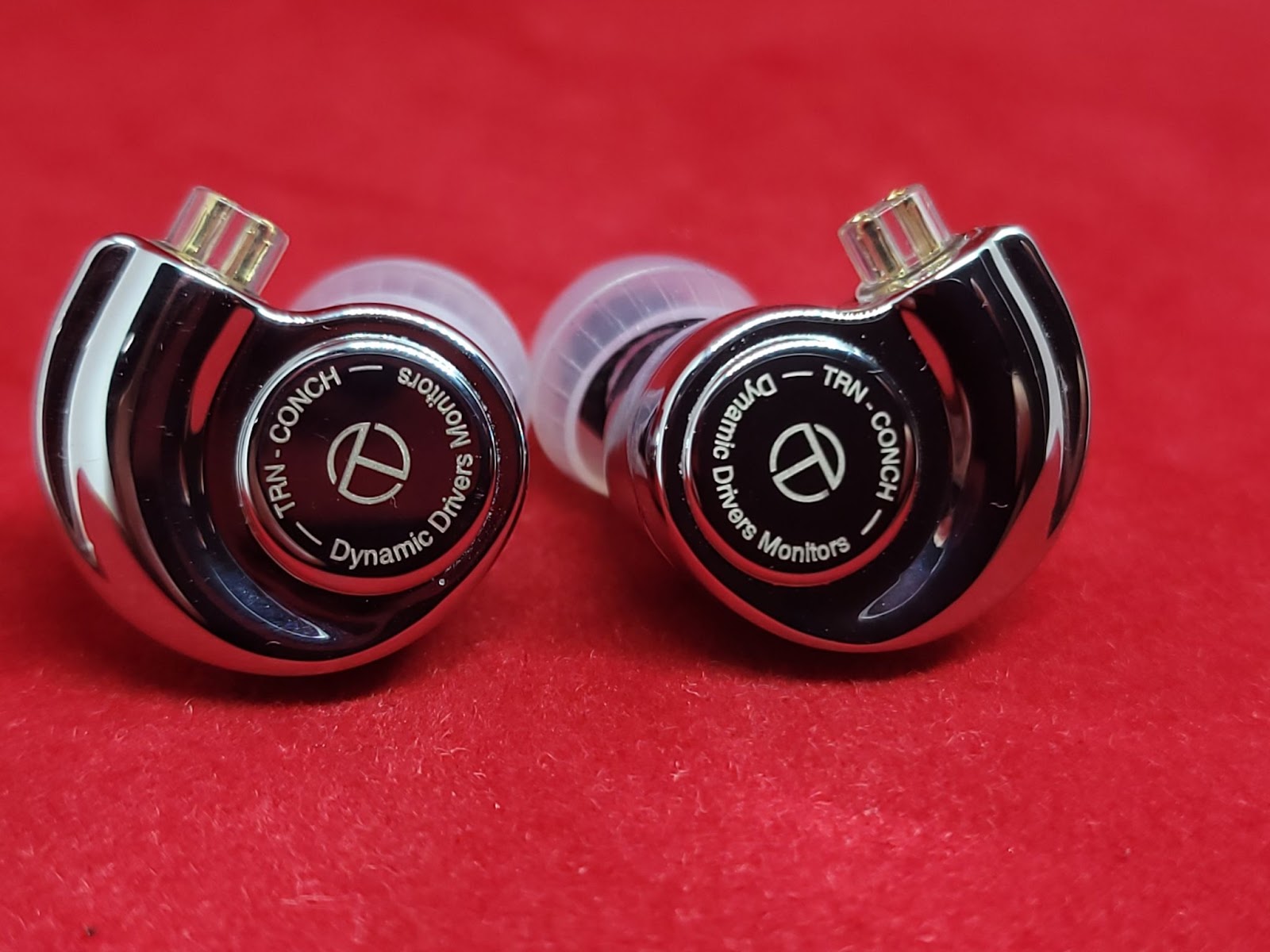
Bass of Conch has a good impact and rumble. Bass quality isn’t something special but at this price I wasn’t expecting too much anyway. Mids were also on point. Bass doesn’t overwhelm mids and mids doesn’t overshadow bass. However treble on Conch is kind of a mixed bag. While it isn’t exactly bright with red nozzles, there is excess upper energy in the upper treble which gets to you after listening for a while. The 8k peak seen on the graph isn’t just a coupler artifact, I think there exists a peak around 7k or 8k to some degree. Conch doesn’t sound piercing mind you, but rather grating. Other than that Conch sounds sparkly and splashy in the treble, maybe a little too much.
Unfortunately Conch doesn’t impress with its technical capabilities. While it is sufficiently revealing, the head stage it creates is rather narrow. Timbre is also takes a hit because of the treble quirk I mentioned. These parameters should make more sense in the comparisons section where I give more context.
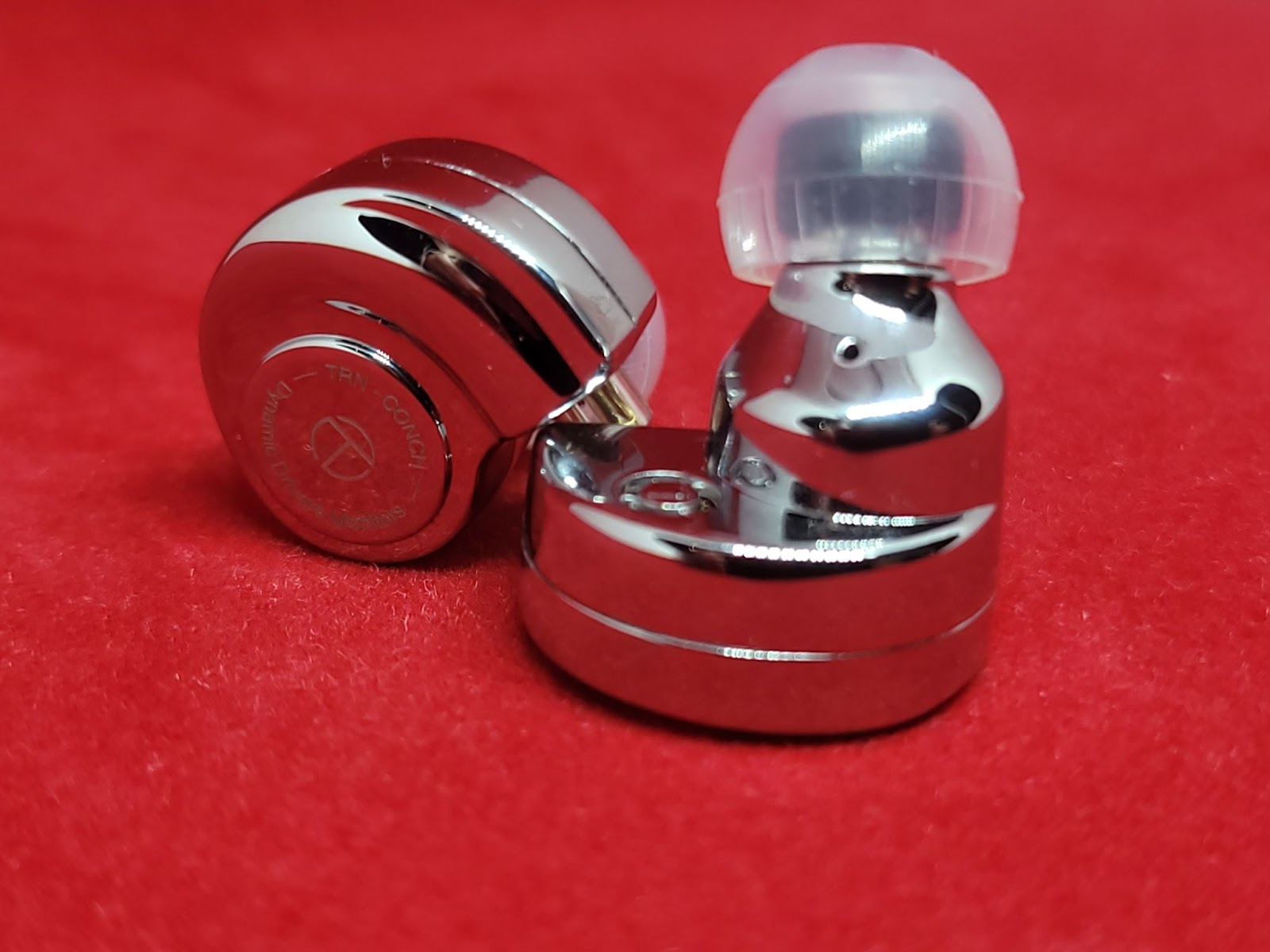
EW200 for me, is the benchmark below 50 USD. So comparing Conch to EW200 is a given to determine the place of Conch in the market.
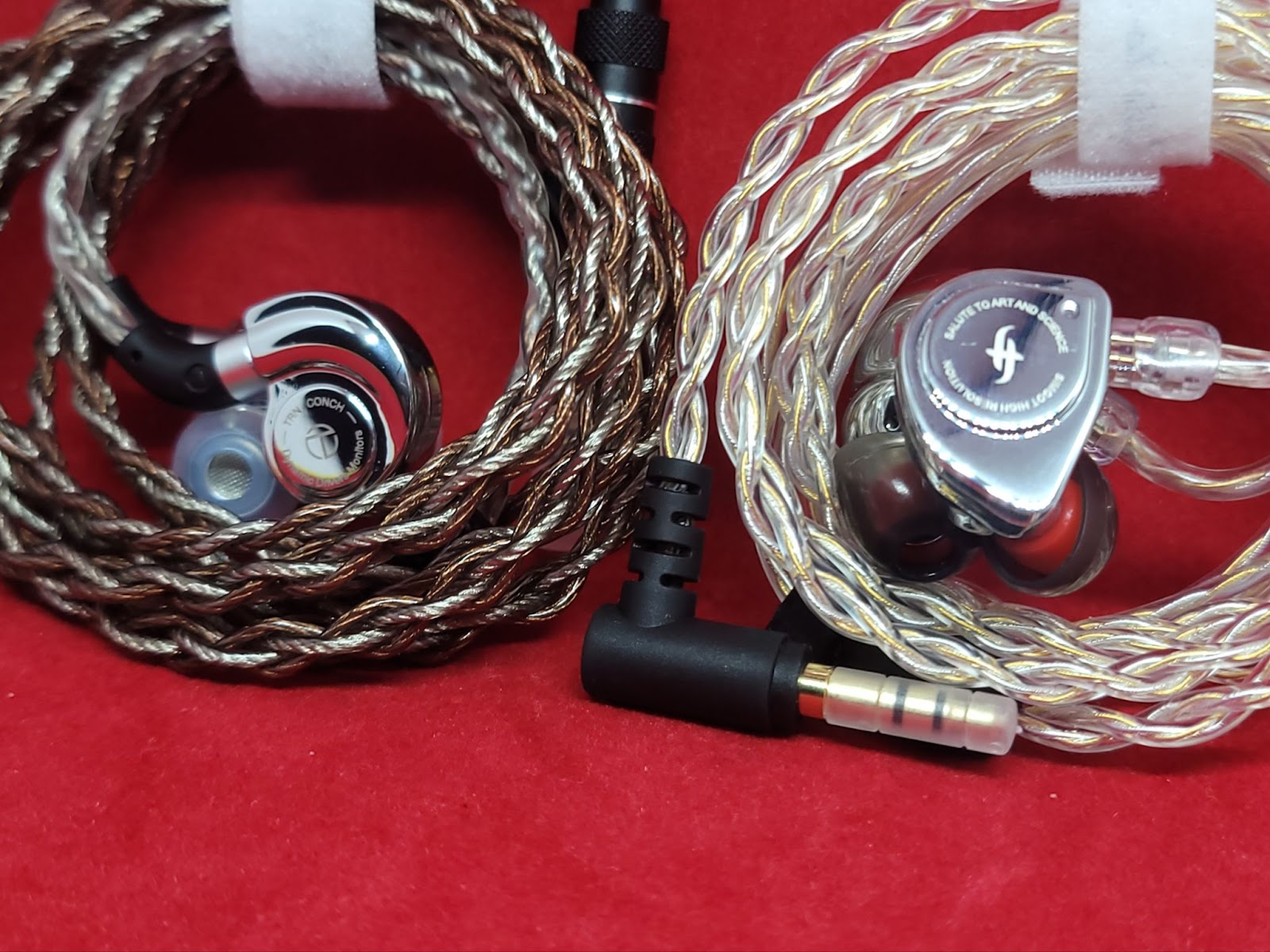
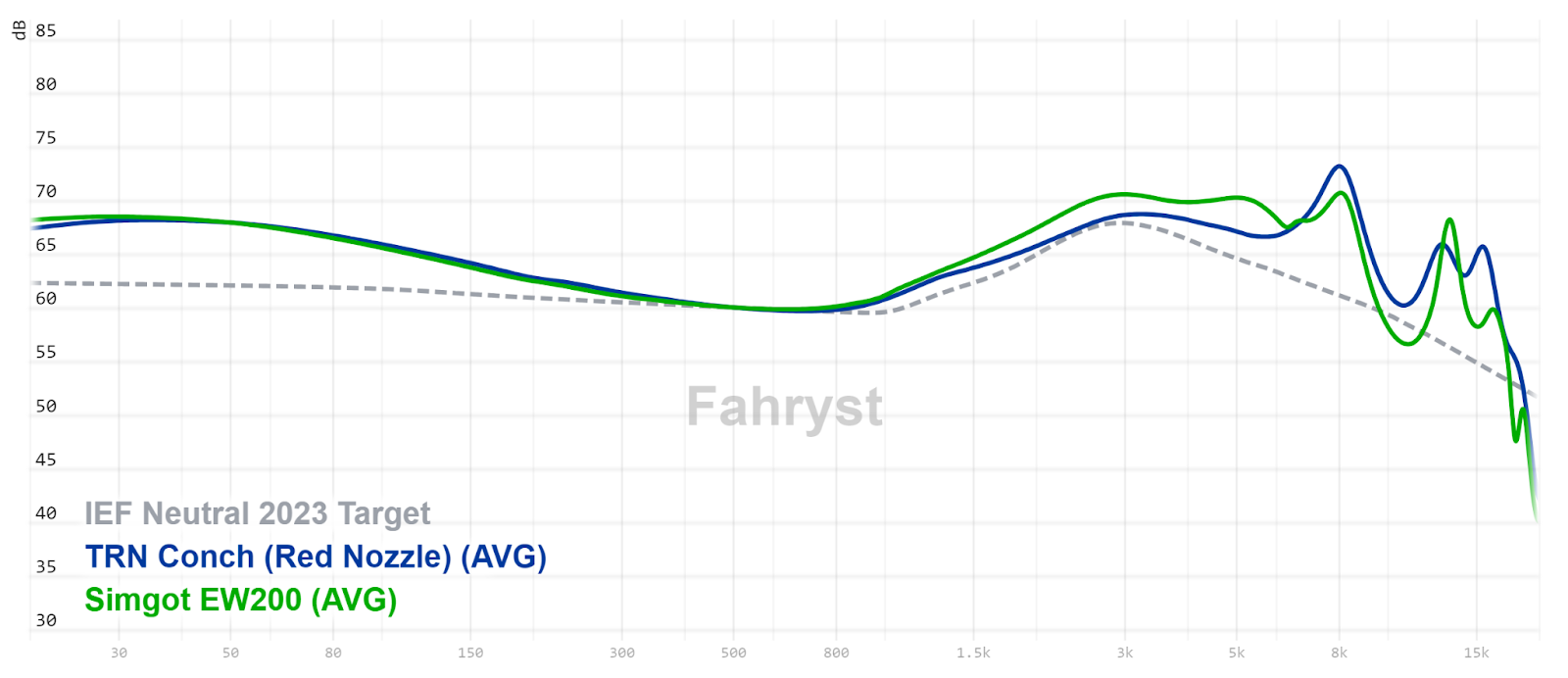
Z300 has been one of my favorite IEMs below 50 USD for some time with its build quality and nice cable as much as sound quality. Also they have somewhat similar sound signatures.
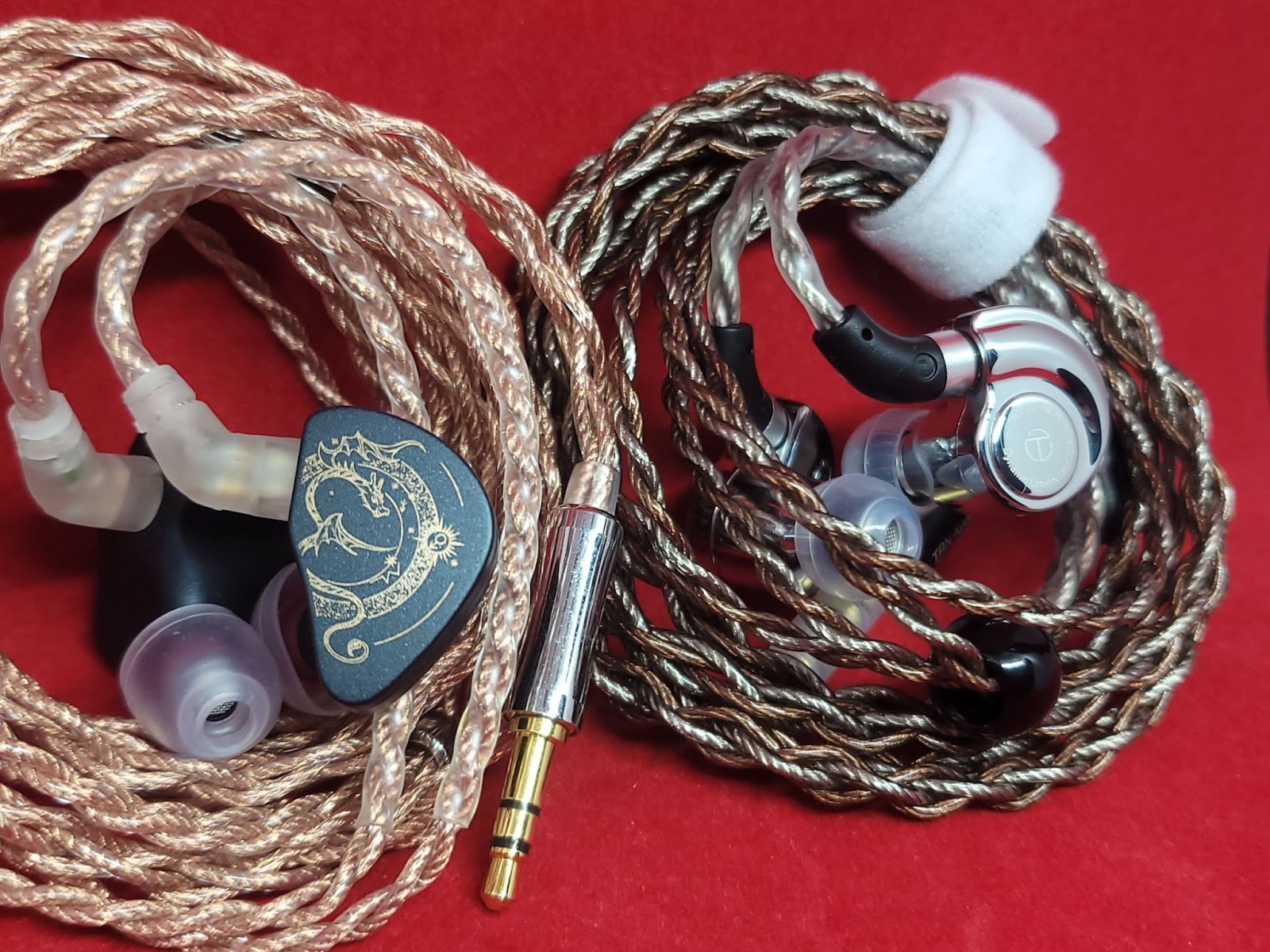
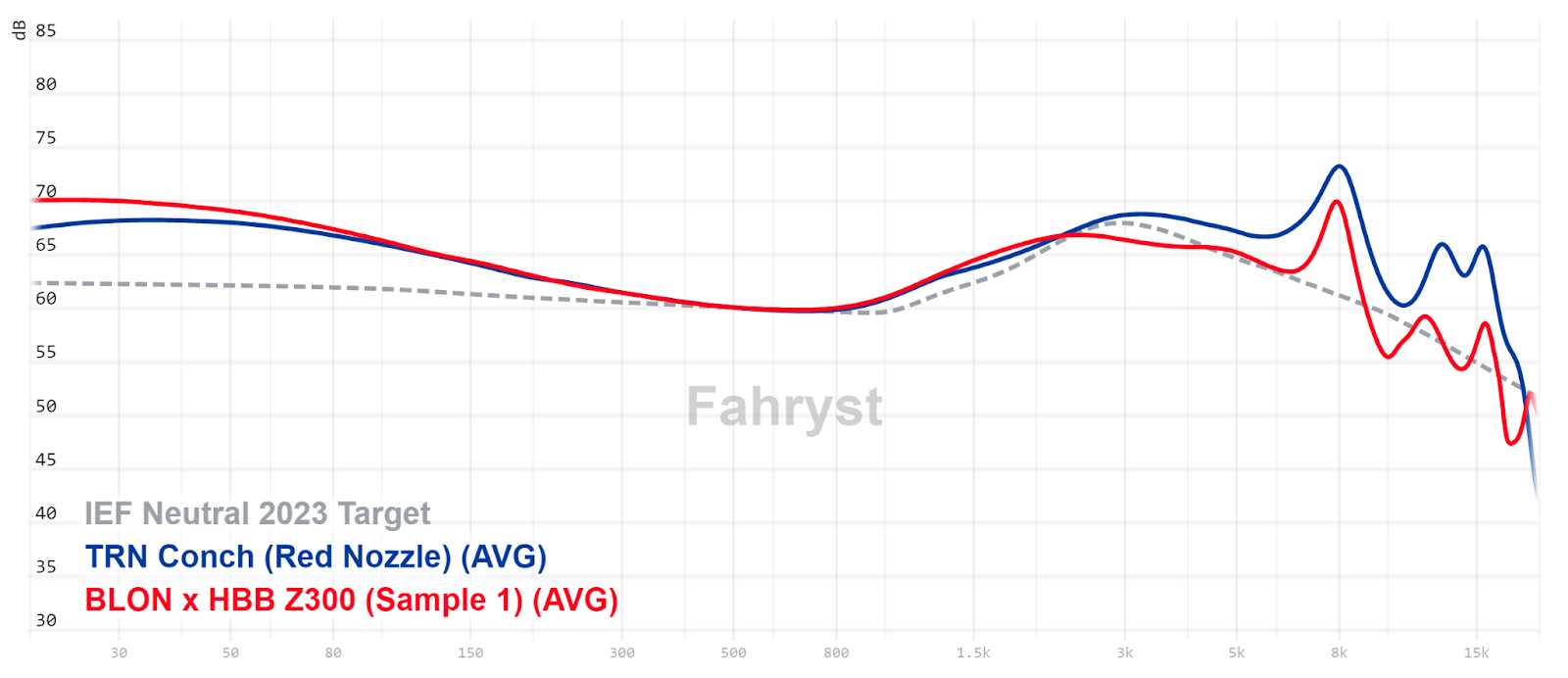
While TRN Conch isn’t the best performer in its price range, the value proposition it offers is hard to ignore. I have seen many people happy with their purchases. It has a balanced tuning that is enjoyable to listen to most of the time. But after long listening sessions, fatigue was inevitable for me. If you use EQ or like modding or aren’t sensitive to upper treble, there is definitely a big potential here. Other than that, the cable and accessories probably would cost you more if you tried to buy them separately. For the price, I think EW200 is still a better performer but Conch is a very good second alternative with a better package.
Disclaimers
TRN Conch was provided to me by Cloris from shenzhenaudio.com for free. As I always say, everyone is biased one way or another so take everything you read with a grain of salt. Also I will try to be more concise and to the point in my reviews from now on without worrying about the word count etc. If you have any questions, please ask me in the comments and I will try to answer them to the best of my abilities.
Build and Accessories of TRN Conch
With my enthusiasm above, I kind of spoiled this part. Yes earpieces of conch are fully made out of metal, and a heavy one at that. They are heavier than Simgot EW200 for example. Although they are fairly comfortable, weight causes some fatigue for me after a while.
Conch uses a QDC or C-pin type of connector. Cable provided with the IEMs is a silver plated OFC one. It’s nothing too impressive but definitely better than probably anything that comes with an IEM at this price. Furthermore, TRN usually only sends one termination with their modular cables but they included all three (3.5 mm, 2.5 mm and 4.4 mm) terminations in the packaging.
Tip inclusion is also very generous. There are a total of two sets of silicon and a pair of memory foam tips. I should mention that one of the sets is theirT-Ear tips which I used throughout all of my listening. Aluminum case is also identical to the cases that come with Whizzer Kylin IEMs.
Sound of TRN Conch
Tonality
Balanced could be the best word to describe Conch’s tonality but there is more to it than that. First of all there are tuning nozzles. Unfortunately, only the red nozzles were usable for me. Even the black nozzles were too shouty, bright and harsh so I couldn’t even dare to try the blue ones. While red nozzles sounded good, they kind of held back the IEMs a little so something in between red and black nozzles would have been great. Modders?
Bass of Conch has a good impact and rumble. Bass quality isn’t something special but at this price I wasn’t expecting too much anyway. Mids were also on point. Bass doesn’t overwhelm mids and mids doesn’t overshadow bass. However treble on Conch is kind of a mixed bag. While it isn’t exactly bright with red nozzles, there is excess upper energy in the upper treble which gets to you after listening for a while. The 8k peak seen on the graph isn’t just a coupler artifact, I think there exists a peak around 7k or 8k to some degree. Conch doesn’t sound piercing mind you, but rather grating. Other than that Conch sounds sparkly and splashy in the treble, maybe a little too much.
Technicalities
Unfortunately Conch doesn’t impress with its technical capabilities. While it is sufficiently revealing, the head stage it creates is rather narrow. Timbre is also takes a hit because of the treble quirk I mentioned. These parameters should make more sense in the comparisons section where I give more context.
Comparisons
TRN Conch (Red Nozzles) vs. Simgot EW200
EW200 for me, is the benchmark below 50 USD. So comparing Conch to EW200 is a given to determine the place of Conch in the market.
- Bass quantity is similar on both, but Conch is more powerful and impactful. It also has more body since balance skews towards lower frequencies with red nozzles. EW200, on the other hand extends deeper into the subbass.
- Vocals are more forward on EW200, they are borderline shouty. With red nozzles Conch’s mids and vocal performance are pretty much on point.
- EW200 is brighter and sounds more open. Conch however, has more upper treble energy. It is sparklier but also harsher. Compared to EW200, Conch is splashy and tends to get sibilant. With red nozzles it’s not really piercing but it gets grating the more you listen to.
- Staging is better on EW200. It extends further in all three dimensions and is more believable. Conch’s headstage feels cramped compared to EW200.
- EW200 is more resolving but Conch is no slouch either. Imaging, layering and separation however is much better on EW200. Timbre is also much more lifelike on EW200.
TRN Conch vs. Blon x HBB Z300
Z300 has been one of my favorite IEMs below 50 USD for some time with its build quality and nice cable as much as sound quality. Also they have somewhat similar sound signatures.
- Bass is more prominent on Z300, it also rumbles more but slightly more pillowy. Conch’s bass is tighter.
- Vocals are richer and more intimate on Z300.
- Conch is brighter and also more susceptible to sibilance.
- Timbre is better on Z300 as it doesn’t have the metallic shimmer that Conch has.
- Conch is more revealing but not necessarily more resolving. They are pretty much on par in terms of resolution.
- Z300’s headstage is slightly wider and deeper. It’s also slightly better at imaging.
Conclusion
While TRN Conch isn’t the best performer in its price range, the value proposition it offers is hard to ignore. I have seen many people happy with their purchases. It has a balanced tuning that is enjoyable to listen to most of the time. But after long listening sessions, fatigue was inevitable for me. If you use EQ or like modding or aren’t sensitive to upper treble, there is definitely a big potential here. Other than that, the cable and accessories probably would cost you more if you tried to buy them separately. For the price, I think EW200 is still a better performer but Conch is a very good second alternative with a better package.
Jarlaxle
100+ Head-Fier
Pros: Highly detailed and technical
Bright but balanced tuning with no real harshness
Very comfortable
Great price to performance ratio
Bright but balanced tuning with no real harshness
Very comfortable
Great price to performance ratio
Cons: QDC connector (doesn't bother me)
Timbre is slightly off
Can be fatiguing in long listening sessions
Tips come off from the nozzles easily
A little bass light or rather dry
Timbre is slightly off
Can be fatiguing in long listening sessions
Tips come off from the nozzles easily
A little bass light or rather dry
Simgot’s single DD IEMs got countless praises but when they released a 1+4 hybrid, everyone was curious to see how they would perform, myself included. Not only that, with their 109 USD price, they would be one of the cheaper 1+4 hybrids out there. There is no need to raise the hype here since EM6L has been out for a while and some people already named it one of the best releases of 2023.
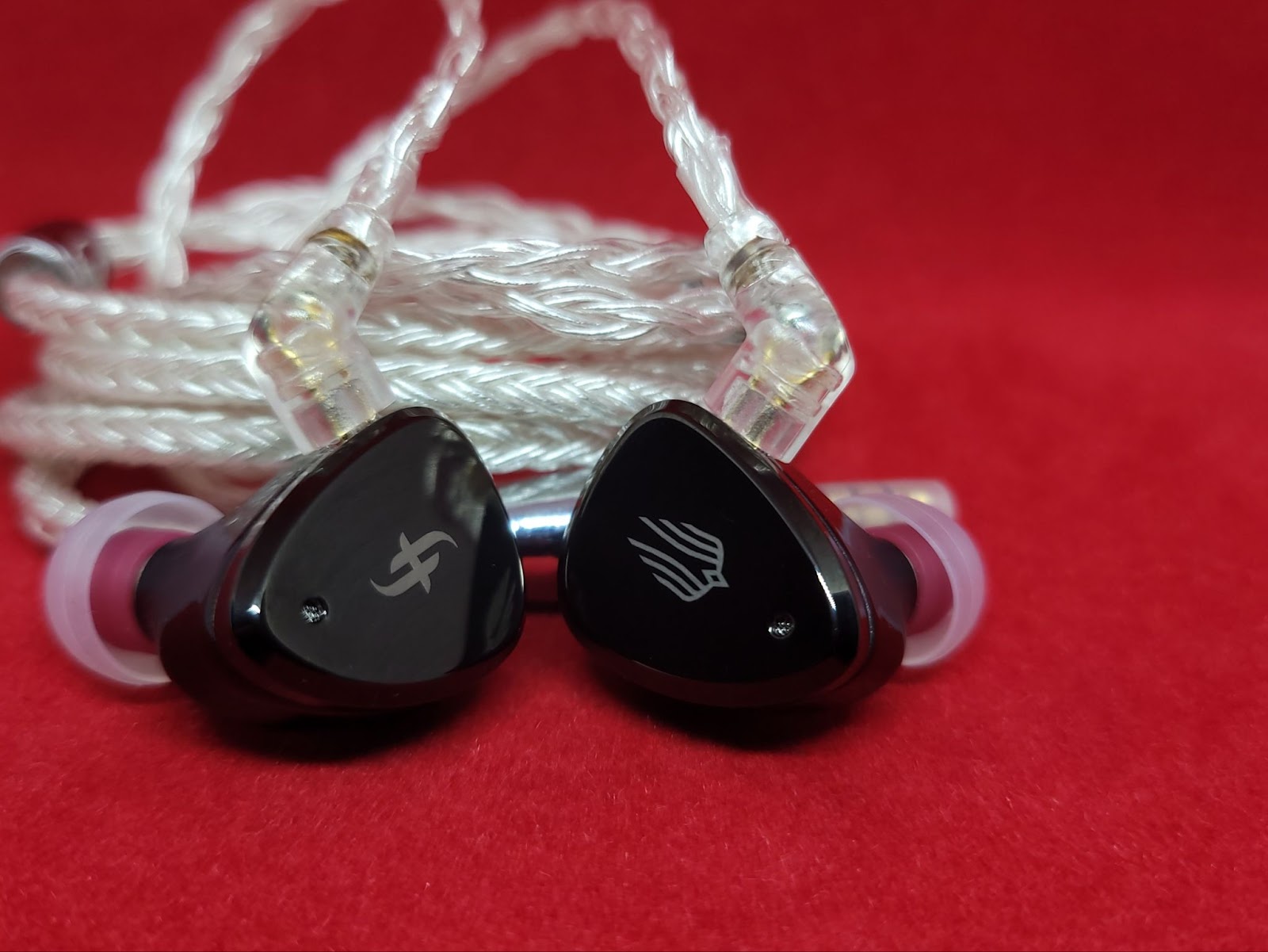
Simgot EM6L Phoenix was provided to me by Simgot for free and I only paid for the customs fee. As I always say, everyone is biased one way or another so take everything you read with a grain of salt. Also I will try to be more concise and to the point in my reviews from now on without worrying about the word count etc. If you have any questions, please ask me in the comments and I will try to answer them to the best of my abilities.
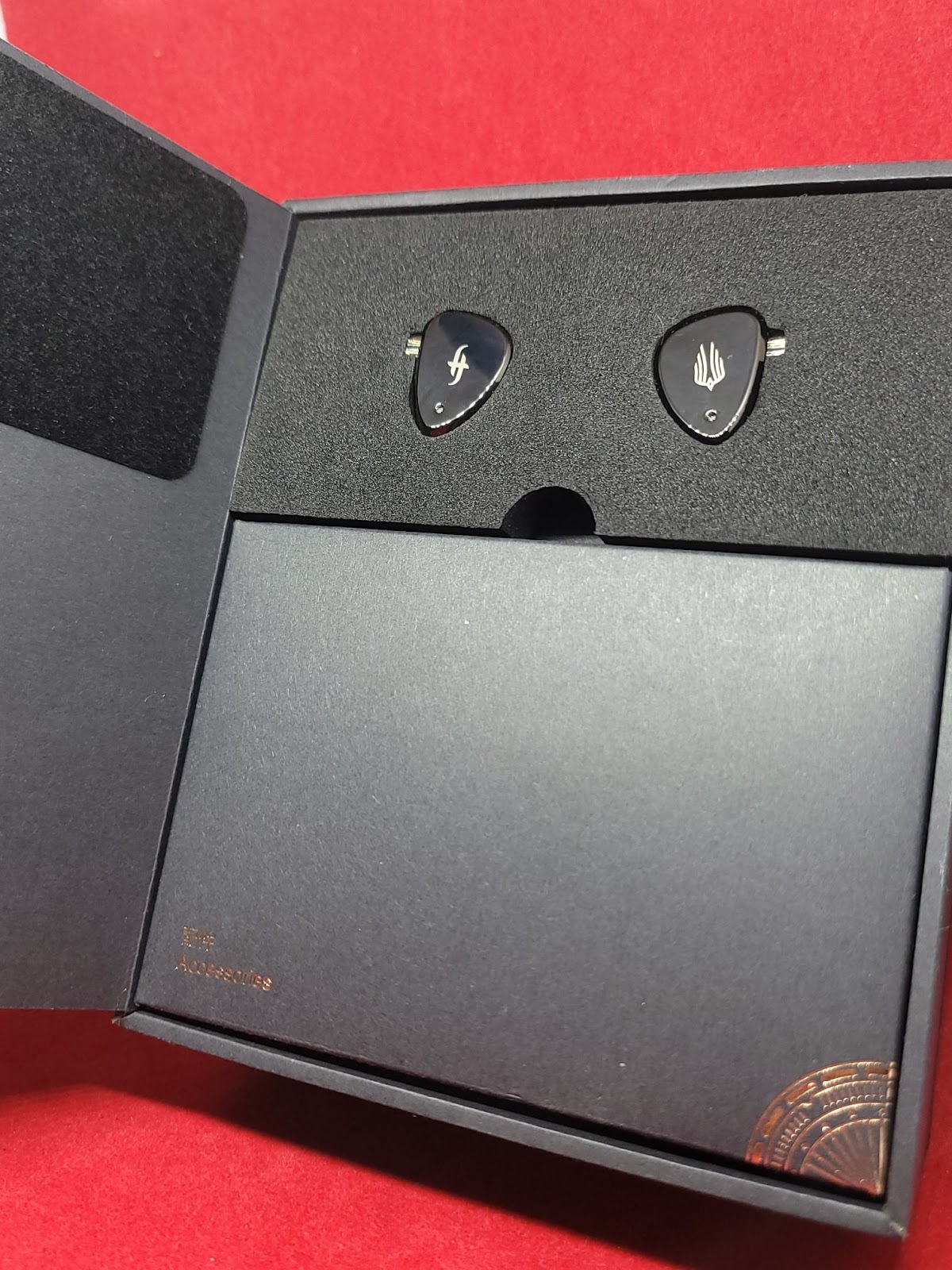
EM6L a.k.a Phoenix is kind of an experimental product from Simgot, at least that is the impression it gave me with some of its aspects. First of all, it is a hybrid, and a 1+4 one at that. It uses a 3-way crossover and has a 3D printed resin shell instead of a metal one Simgot usually uses. Apart from these, connectors used on EM6L are the ones known as QDC or C-pin type which we are familiar with from brands like KZ. They almost make EM6L look cheap but understated dark metal faceplates look gorgeous so I don’t really mind them.
The thing I loved about the build of EM6L is the shell size; they are not huge like other hybrids I used. Ear pieces are light and very comfortable which is a huge plus. Size and shape aren’t much different to usual single DD IEMs but nozzles aren’t angled like other Simgots. A minor gripe of mine here is that nozzles don’t have any contour or lip so some tips easily slips out of the nozzles.
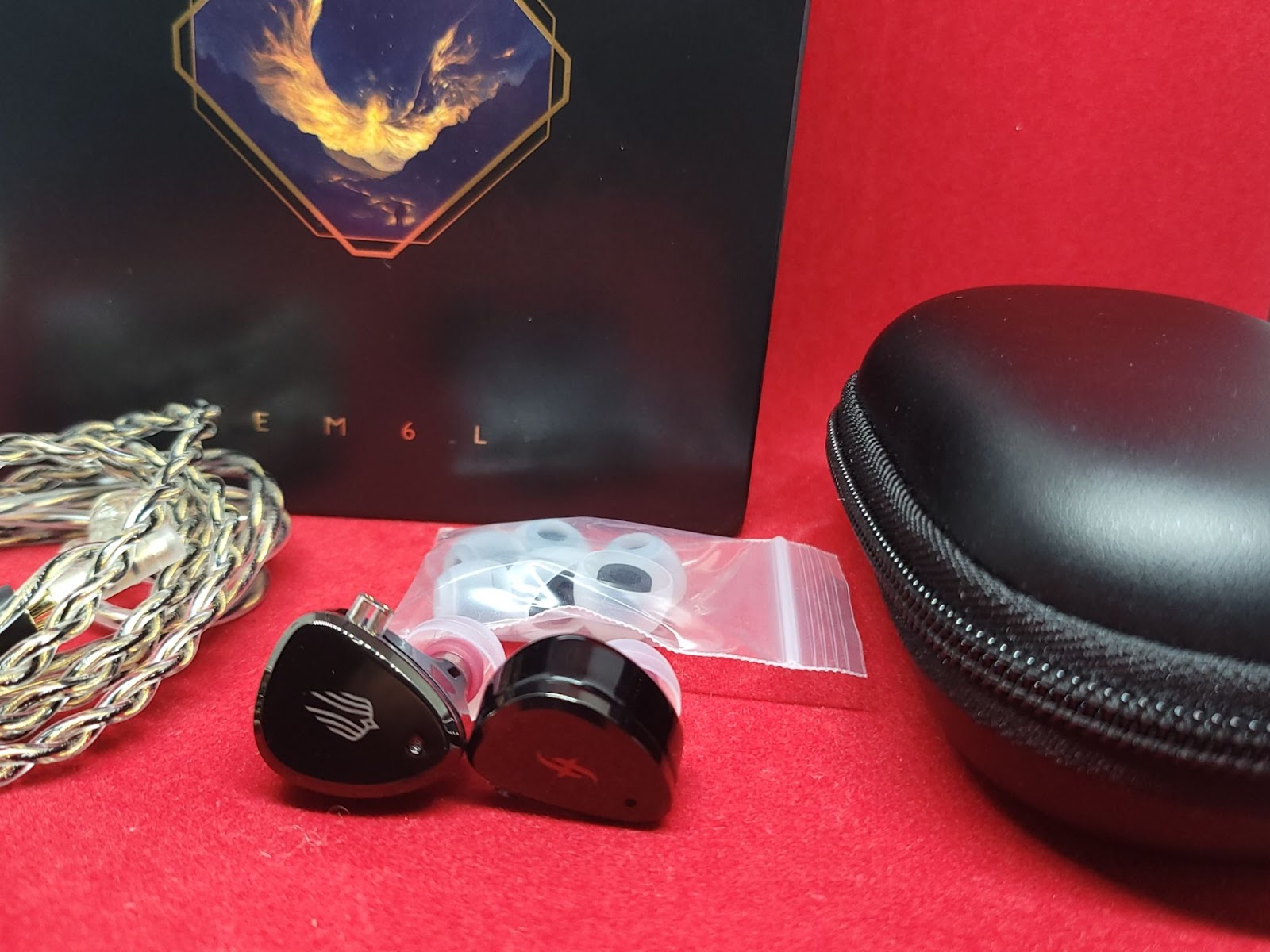
Box and presentation is simple yet well thought out. I loved how Simgot placed an extra piece of felt on the cover where faceplates touch. Not that they needed because faceplates already had protective film on them. Unfortunately though, the box wasn’t abundant with accessories as usual. There was only an unbranded case, a cable and a decent set of tips.
EM6L, like most of the other Simgot IEMs, aims for the Harman 2019 Target and for the most part hugs the line very closely. There are, however, some quirks which may or may not be welcome depending on your tastes or what you think about Harman tuning style.
EM6L Phoenix is bright, there is no denying that, all the Simgot IEMs I have tried are bright. But the balance on EM6L is a little different. Bass on EM6L isn’t very prominent, some may even say they are light in note weight. For me they are just a smidge dry, that’s all. For those who love EA500’s richness, EM6L might not satisfy you, after all EW200 didn’t satisfy them either. Still bass quality is pretty good, that’s what we would expect from Simgot.
Mids are forward and have a fine presence, no surprises there. But again other Simgot IEMs do a little better here tonally. EM6L has a late peaking ear gain, which I’m not a big fan of. Piano, brass instruments and electric guitars have more energy than I’m used to.
Like I said earlier, EM6L is bright, especially the upper treble is very pronounced. This makes them very technical and Simgot somehow managed it without them being too harsh. They can get fatiguing in long listening sessions for some, but I wasn’t too bothered by them. Frequency response graphs don't show the usual 8k resonance peak because there is actually a dip there. While it negates the piercing effect that occurs with drivers of inferior quality, it also makes them lack a certain snap I got accustomed too. Still I prefer this over the piercing effect.
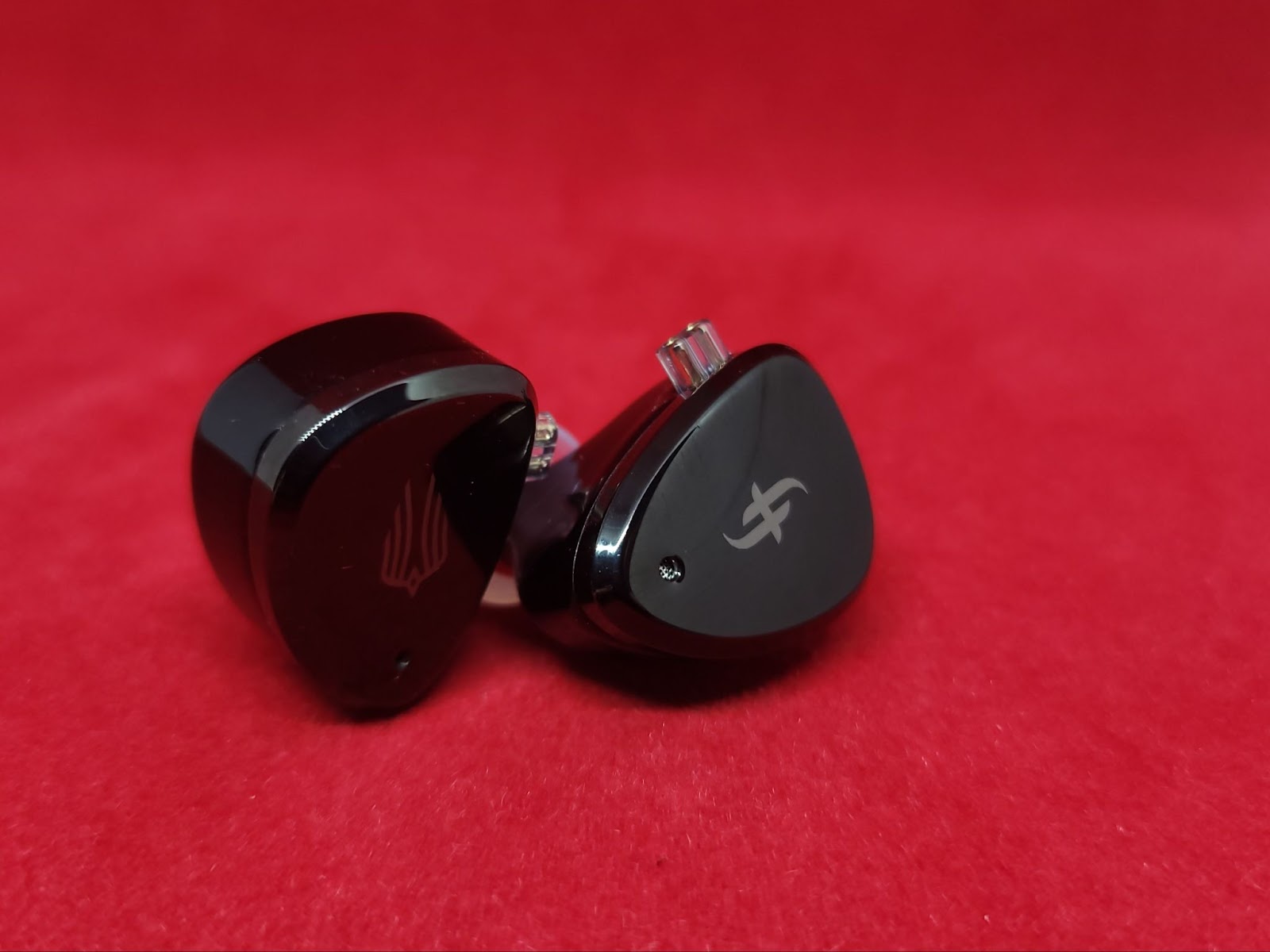
It might have come as I had a lot of negative things to say about EM6L so far, but those were nitpicks at best. They are well tuned but a little quirky, that’s all and they more than make up for those with their technical capability.
First of all, they let me hear lots of nuances I haven’t heard at this price point. They are very detailed and resolving. Like I said earlier, this is mostly attributed to the tuning which is kind of common among the high end sets. Drivers might not be of the highest quality but Simgot managed to get the best out of them. Unfortunately the timbre is slightly off. In fact it was the first thing I noticed when I put them in my ears for the first time. It’s not off putting but noticeable if you come from a very natural sounding set. Staging capabilities are fine but imaging and layering is quite good.
Hexa has been one of the benchmarks below 100 USD and also being a hybrid, it was the most sensible choice for me to do a comparison.

Considering how Hexa is one of the top choices below 100 usd, EM6L trading blows with Hexa is a compliment on its own.
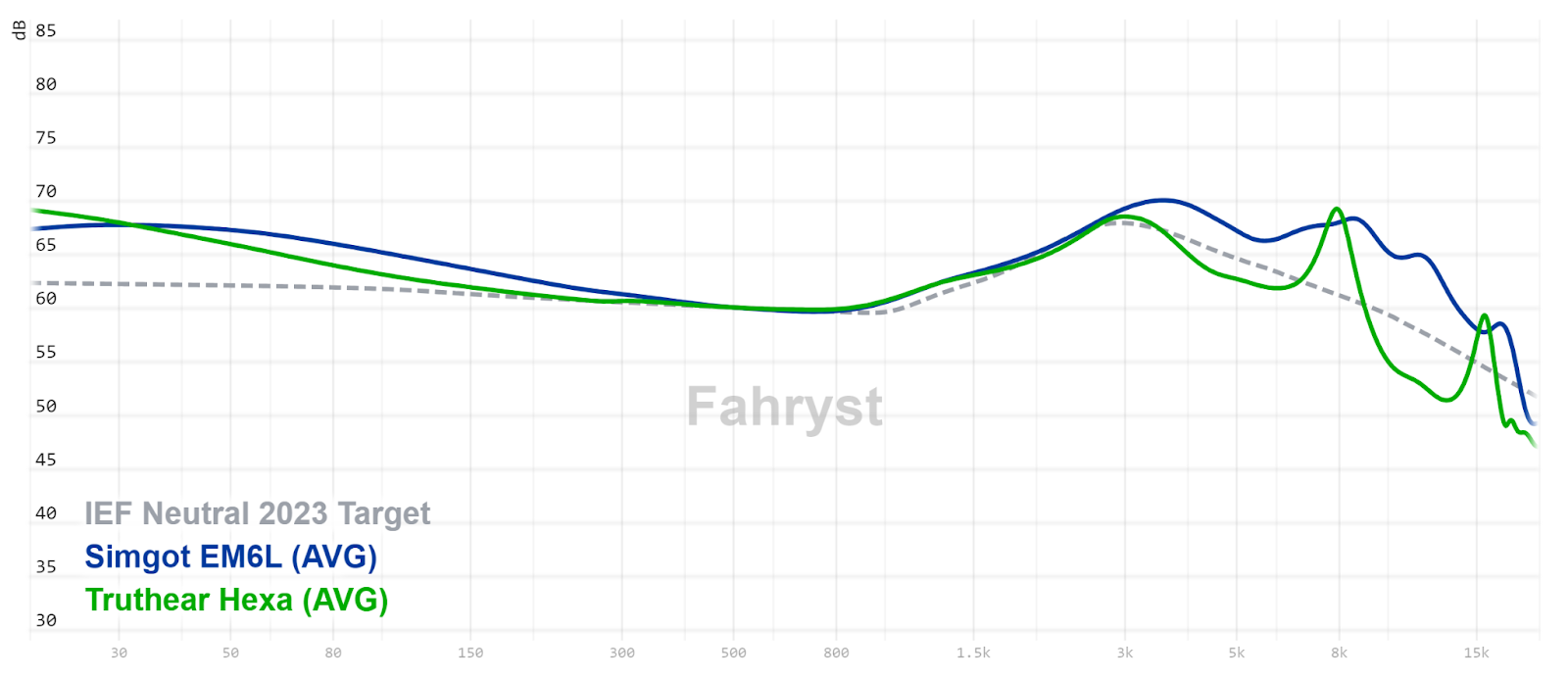
EM6L was another IEM that I enjoyed reviewing. They are very technical, especially for their price but also have some quirks. While tonally there are better IEMs in its price range including Simgot’s own offerings, I think technically they outcompete others I have heard so far. So it really depends on what you value more.
Disclaimers
Simgot EM6L Phoenix was provided to me by Simgot for free and I only paid for the customs fee. As I always say, everyone is biased one way or another so take everything you read with a grain of salt. Also I will try to be more concise and to the point in my reviews from now on without worrying about the word count etc. If you have any questions, please ask me in the comments and I will try to answer them to the best of my abilities.
Build and Accessories of Simgot EM6L
EM6L a.k.a Phoenix is kind of an experimental product from Simgot, at least that is the impression it gave me with some of its aspects. First of all, it is a hybrid, and a 1+4 one at that. It uses a 3-way crossover and has a 3D printed resin shell instead of a metal one Simgot usually uses. Apart from these, connectors used on EM6L are the ones known as QDC or C-pin type which we are familiar with from brands like KZ. They almost make EM6L look cheap but understated dark metal faceplates look gorgeous so I don’t really mind them.
The thing I loved about the build of EM6L is the shell size; they are not huge like other hybrids I used. Ear pieces are light and very comfortable which is a huge plus. Size and shape aren’t much different to usual single DD IEMs but nozzles aren’t angled like other Simgots. A minor gripe of mine here is that nozzles don’t have any contour or lip so some tips easily slips out of the nozzles.
Box and presentation is simple yet well thought out. I loved how Simgot placed an extra piece of felt on the cover where faceplates touch. Not that they needed because faceplates already had protective film on them. Unfortunately though, the box wasn’t abundant with accessories as usual. There was only an unbranded case, a cable and a decent set of tips.
Sound of Simgot EM6L
Tonality
EM6L, like most of the other Simgot IEMs, aims for the Harman 2019 Target and for the most part hugs the line very closely. There are, however, some quirks which may or may not be welcome depending on your tastes or what you think about Harman tuning style.
EM6L Phoenix is bright, there is no denying that, all the Simgot IEMs I have tried are bright. But the balance on EM6L is a little different. Bass on EM6L isn’t very prominent, some may even say they are light in note weight. For me they are just a smidge dry, that’s all. For those who love EA500’s richness, EM6L might not satisfy you, after all EW200 didn’t satisfy them either. Still bass quality is pretty good, that’s what we would expect from Simgot.
Mids are forward and have a fine presence, no surprises there. But again other Simgot IEMs do a little better here tonally. EM6L has a late peaking ear gain, which I’m not a big fan of. Piano, brass instruments and electric guitars have more energy than I’m used to.
Like I said earlier, EM6L is bright, especially the upper treble is very pronounced. This makes them very technical and Simgot somehow managed it without them being too harsh. They can get fatiguing in long listening sessions for some, but I wasn’t too bothered by them. Frequency response graphs don't show the usual 8k resonance peak because there is actually a dip there. While it negates the piercing effect that occurs with drivers of inferior quality, it also makes them lack a certain snap I got accustomed too. Still I prefer this over the piercing effect.
Technicalities
It might have come as I had a lot of negative things to say about EM6L so far, but those were nitpicks at best. They are well tuned but a little quirky, that’s all and they more than make up for those with their technical capability.
First of all, they let me hear lots of nuances I haven’t heard at this price point. They are very detailed and resolving. Like I said earlier, this is mostly attributed to the tuning which is kind of common among the high end sets. Drivers might not be of the highest quality but Simgot managed to get the best out of them. Unfortunately the timbre is slightly off. In fact it was the first thing I noticed when I put them in my ears for the first time. It’s not off putting but noticeable if you come from a very natural sounding set. Staging capabilities are fine but imaging and layering is quite good.
Comparison
Simgot EM6L vs. Truthear Hexa
Hexa has been one of the benchmarks below 100 USD and also being a hybrid, it was the most sensible choice for me to do a comparison.
- Hexa is mostly bass light except subbass. EM6L has more body and bass impact. Bass guitars are also more prominent on EM6L. EM6L slightly extends better in the subbass.
- EM6L is significantly brighter, and also has more vocal presence but not particularly harsh. In fact, it could be said that Hexa’s tuning is too safe. Hi-hats have a more satisfying energy on EM6L; there is also an occasional glare. Also EM6L has a dip at 8k which makes it lack a certain snap which Hexa and most other IEMs have. EM6L might get fatiguing in longer listening sessions.
- While not perfect, timbre is better and more believable on Hexa. EM6L is slightly off and nasally. EM6L is technically more capable than Hexa. It is more resolving and detailed. Also EM6L has better staging and imaging, it feels wider and deeper.
Considering how Hexa is one of the top choices below 100 usd, EM6L trading blows with Hexa is a compliment on its own.
Conclusion
EM6L was another IEM that I enjoyed reviewing. They are very technical, especially for their price but also have some quirks. While tonally there are better IEMs in its price range including Simgot’s own offerings, I think technically they outcompete others I have heard so far. So it really depends on what you value more.
kapsontong
Simgot is on a roll!
Jarlaxle
100+ Head-Fier
Pros: Nice timbre
Lush and rich presentation
Satisfying bass amount
Not harsh
Suitable for loud level listeners
Lush and rich presentation
Satisfying bass amount
Not harsh
Suitable for loud level listeners
Cons: Too bassy for most genres
Too warm
Bass quality is not the best, it is loose and pillowy
Not particularly technical
Details get lost
Too warm
Bass quality is not the best, it is loose and pillowy
Not particularly technical
Details get lost
Artti is a relatively new brand and R1 is their second IEM in the market. They are priced at 79 USD but can usually be bought for cheaper through their Aliexpress store. Although newly established, some things might look very familiar because they are manufactured by LetShuoer, at least that’s what it says on the back of the box.
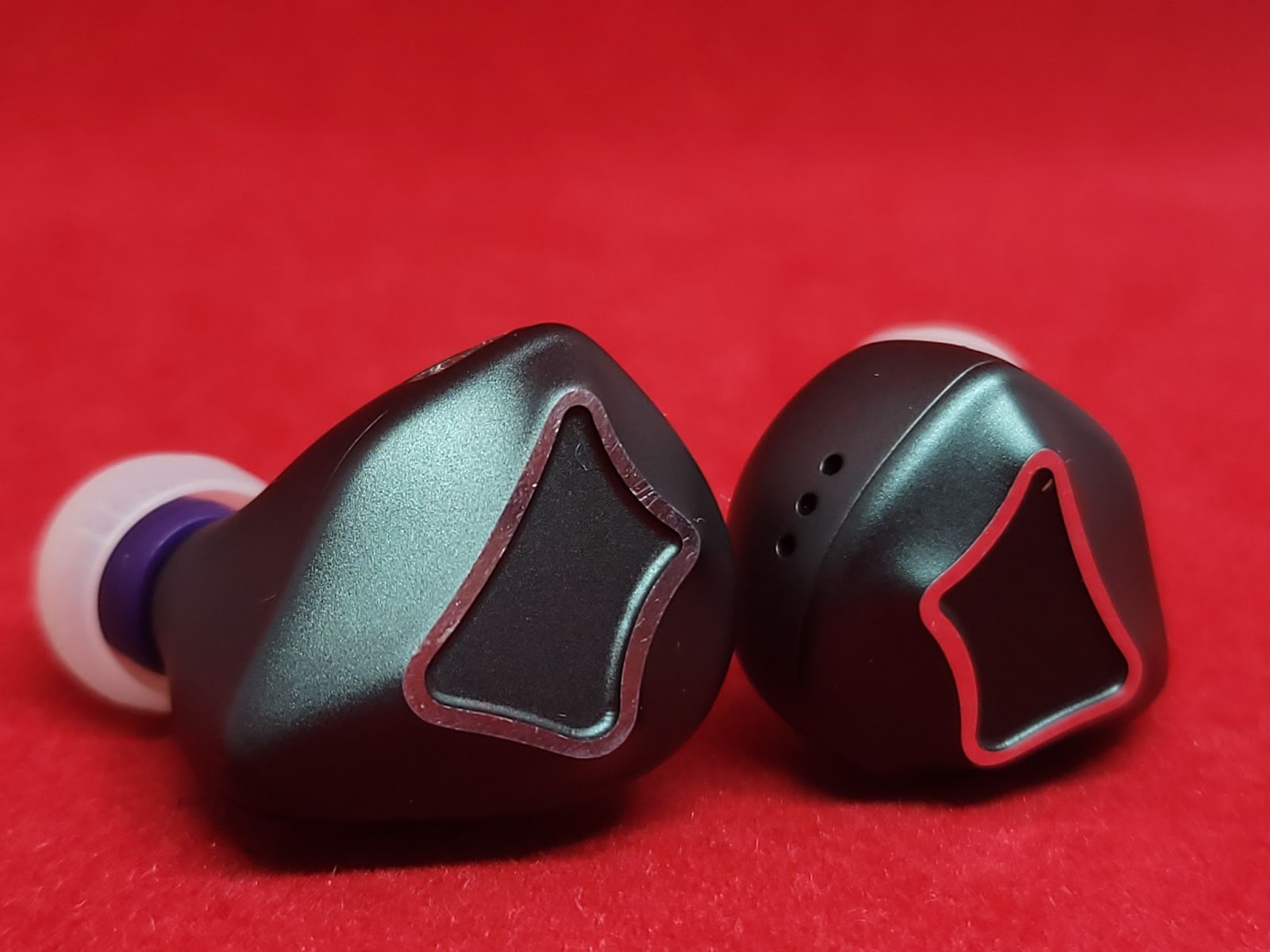
I bought Artti R1 with a discount in exchange for a review. As I always say, everyone is biased one way or another so take everything you read with a grain of salt. Also I will try to be more concise and to the point in my reviews from now on without worrying about the word count etc. If you have any questions, please ask me in the comments and I will try to answer them to the best of my abilities.
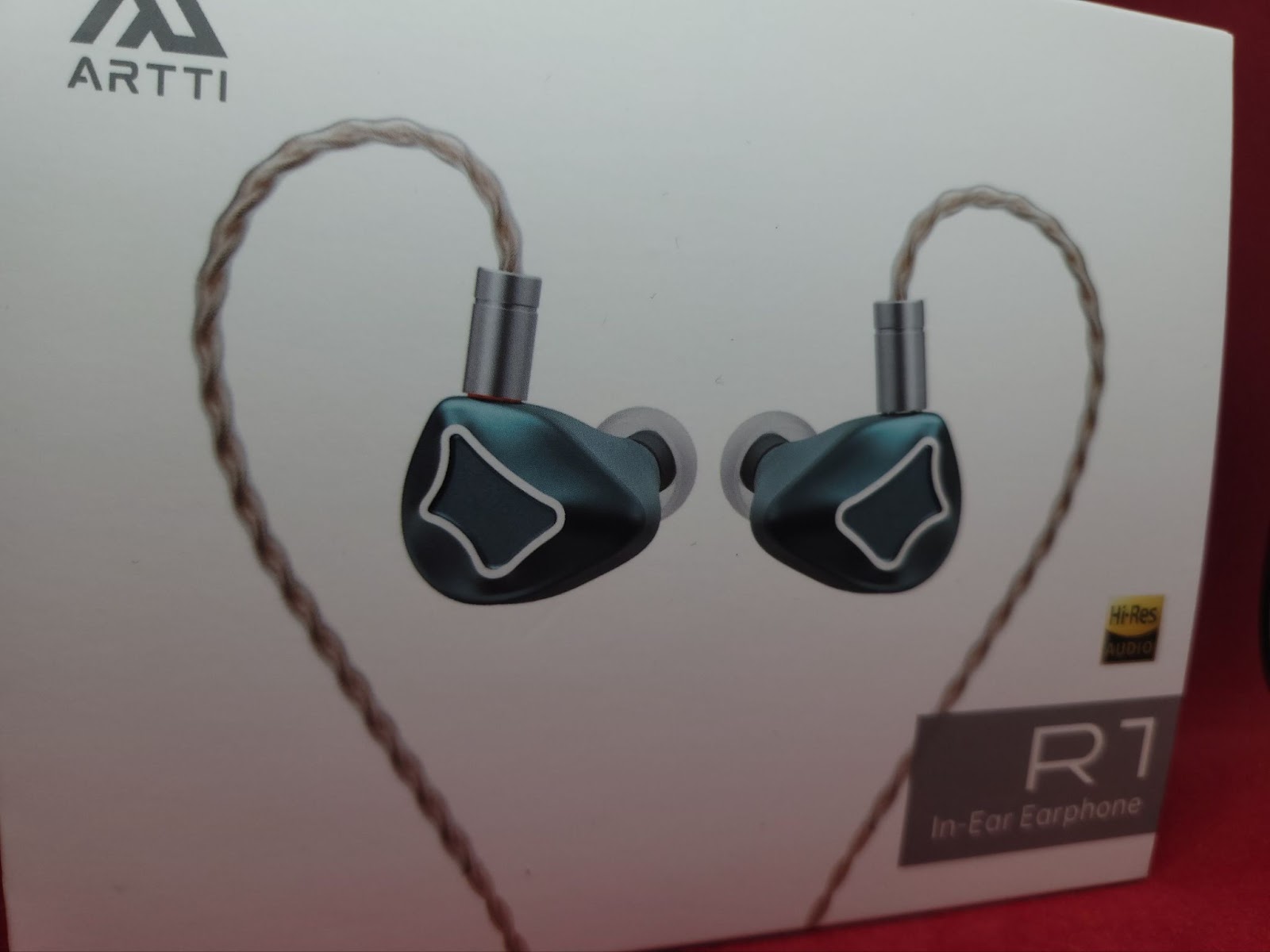
Shells of R1 made out of aluminum. They are relatively light and moderately comfortable. In fact, the shell shape is pretty much identical with LetShuoer’s DZ4, except DZ4 uses a resin shell.
Cable that the Artti R1 comes with is nothing extraordinary. They have both 3.5 mm and 4.4 mm options and I opted for 4.4 mm. Apart from the cable, R1 comes with two sets of generic tips and a case made out of fabric. All the accessories were placed in the case to save space in the box so the set provides a modest unboxing experience.
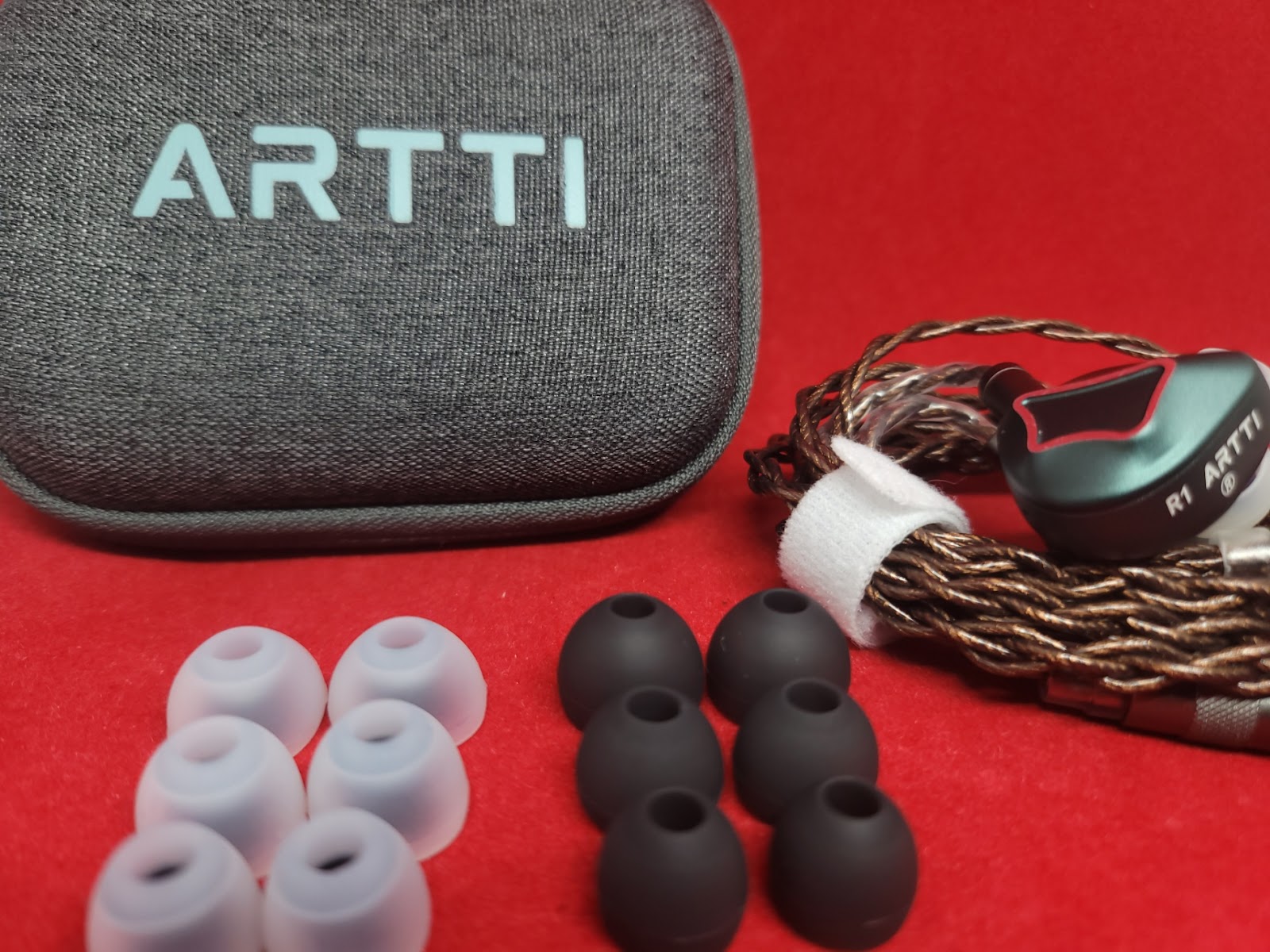
Bass on R1 is overpowering but also kind of loose. It bleeds into the mids, making the whole presentation warm, lush, rich and fuzzy.
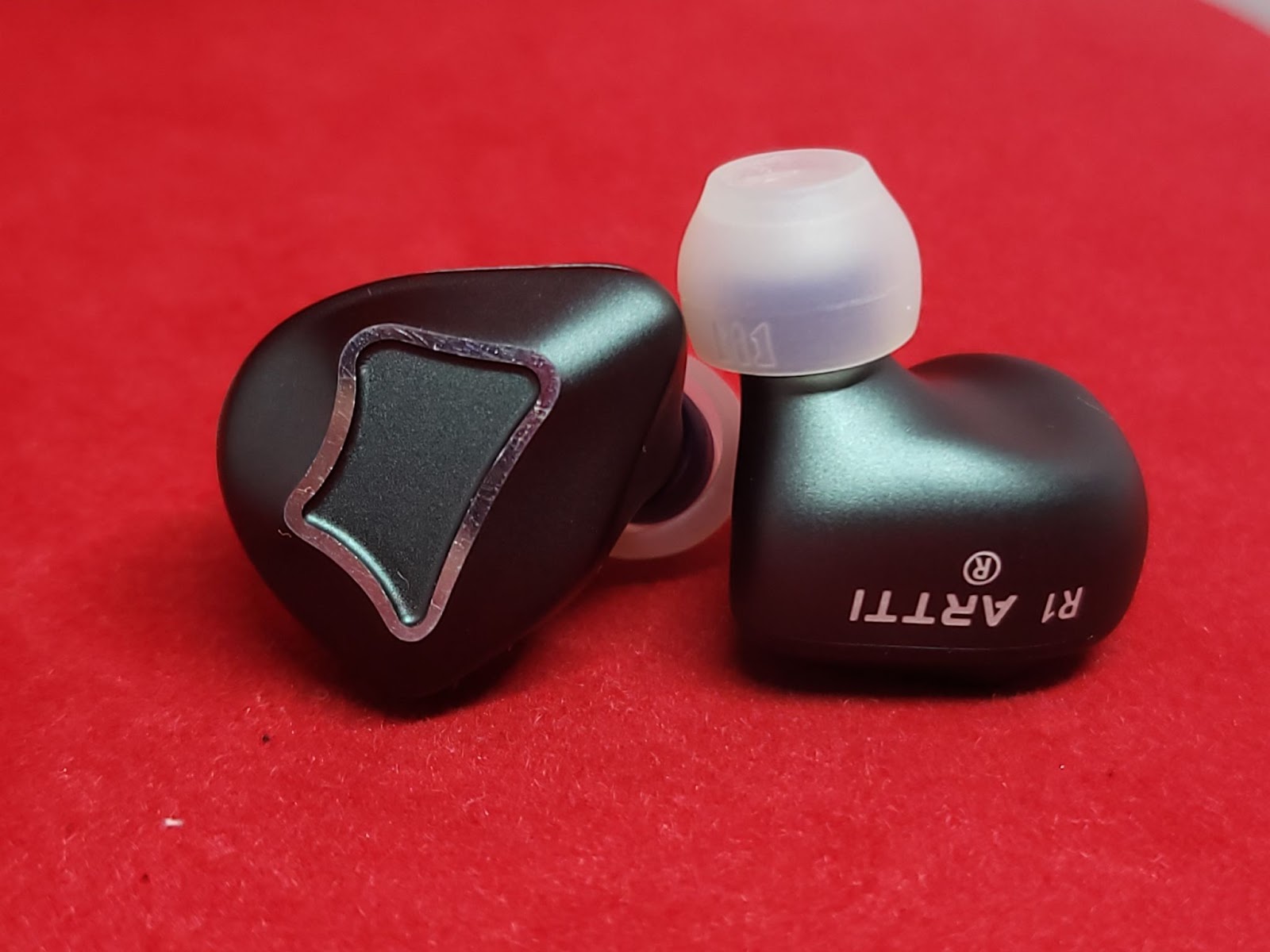
Mids aren’t particularly recessed but since bass is too overpowering, they usually get overshadowed. Upper mids however are emphasized so that they can still shine through with female vocals and electric guitars. When there aren't overpowering bass notes, this warm tonality makes them sound lush and romantic.
Treble is present but not overemphasized. Hi-hats have decent sparkle and don’t sound very blunted.
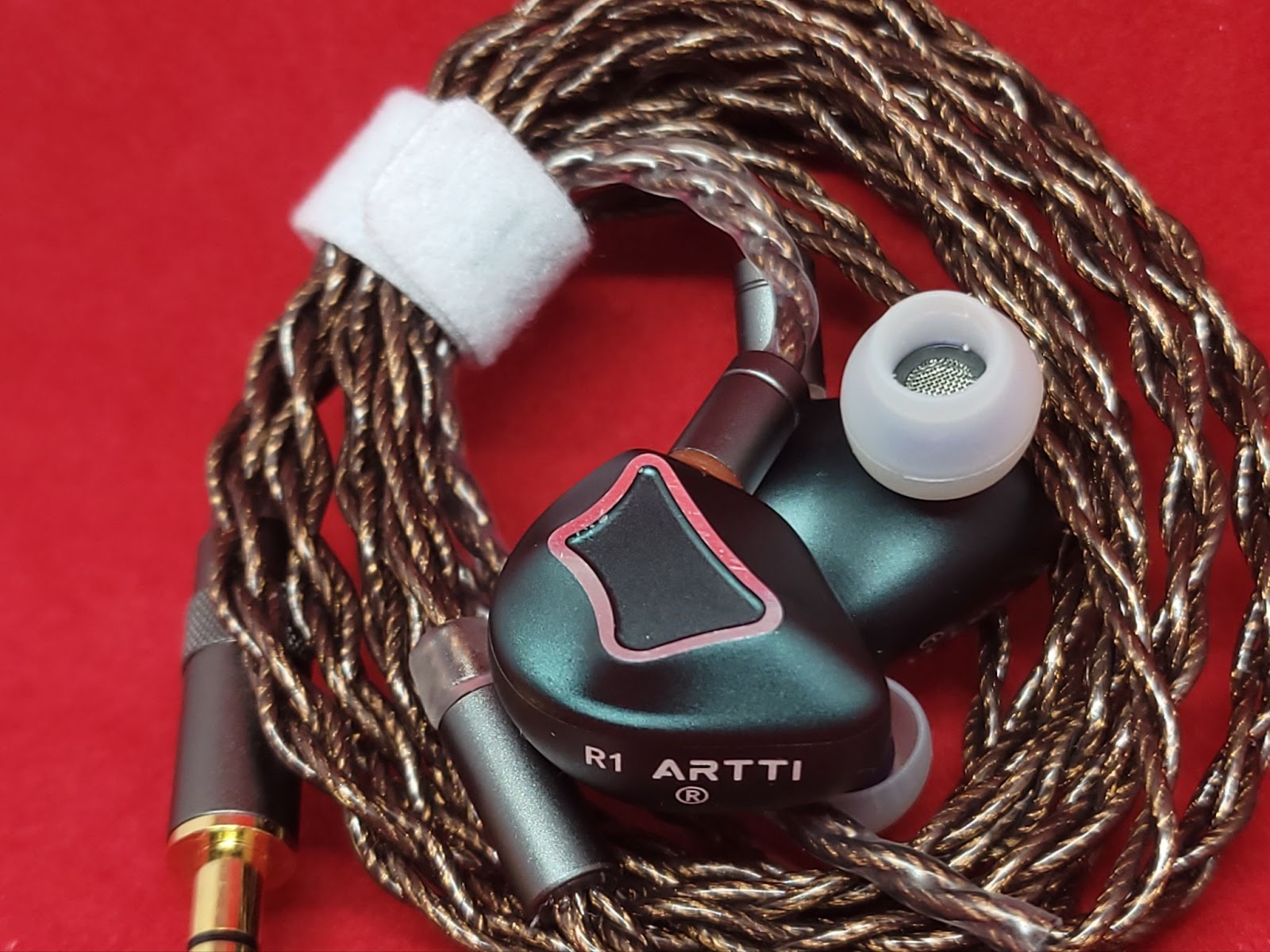
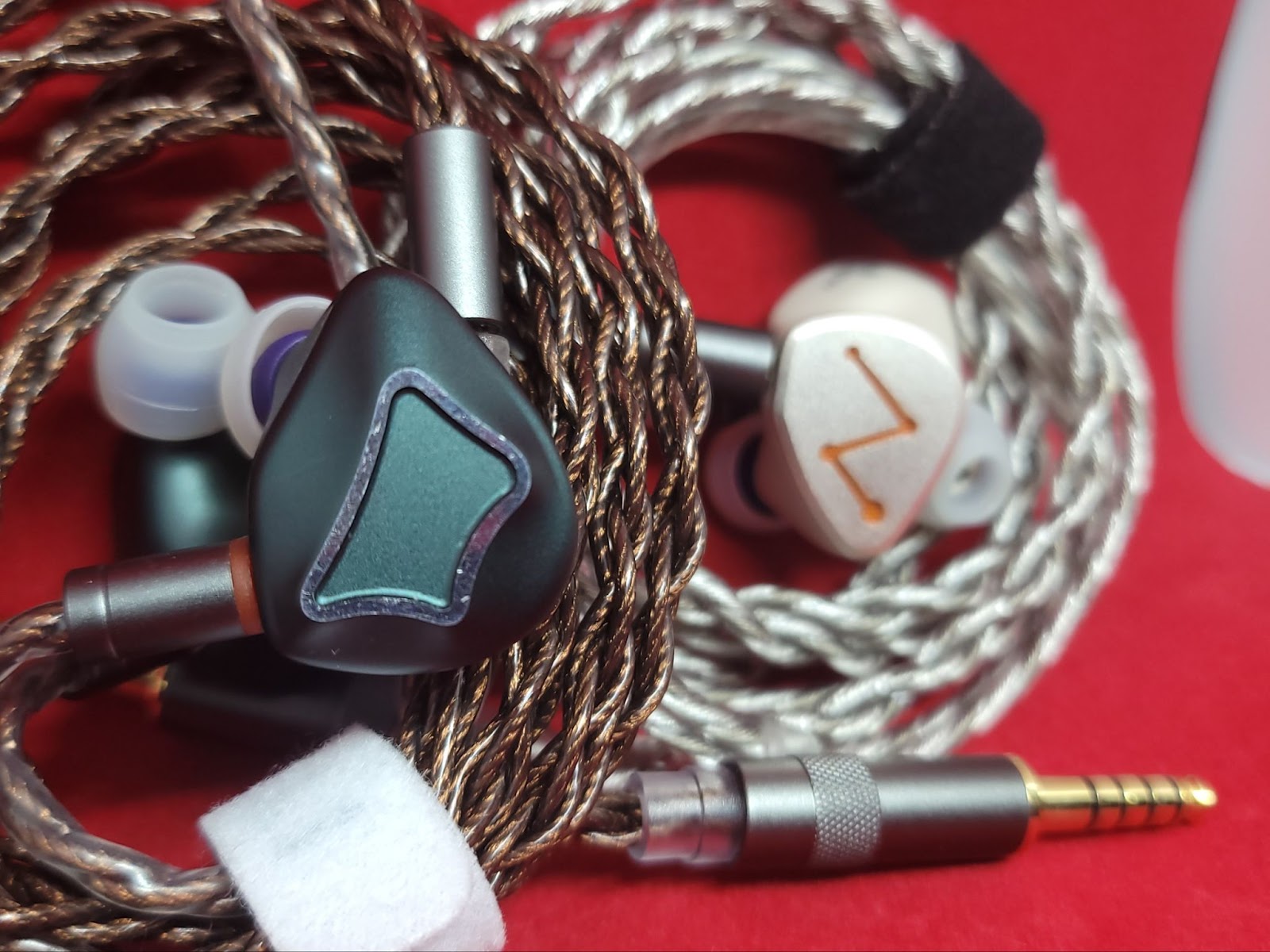
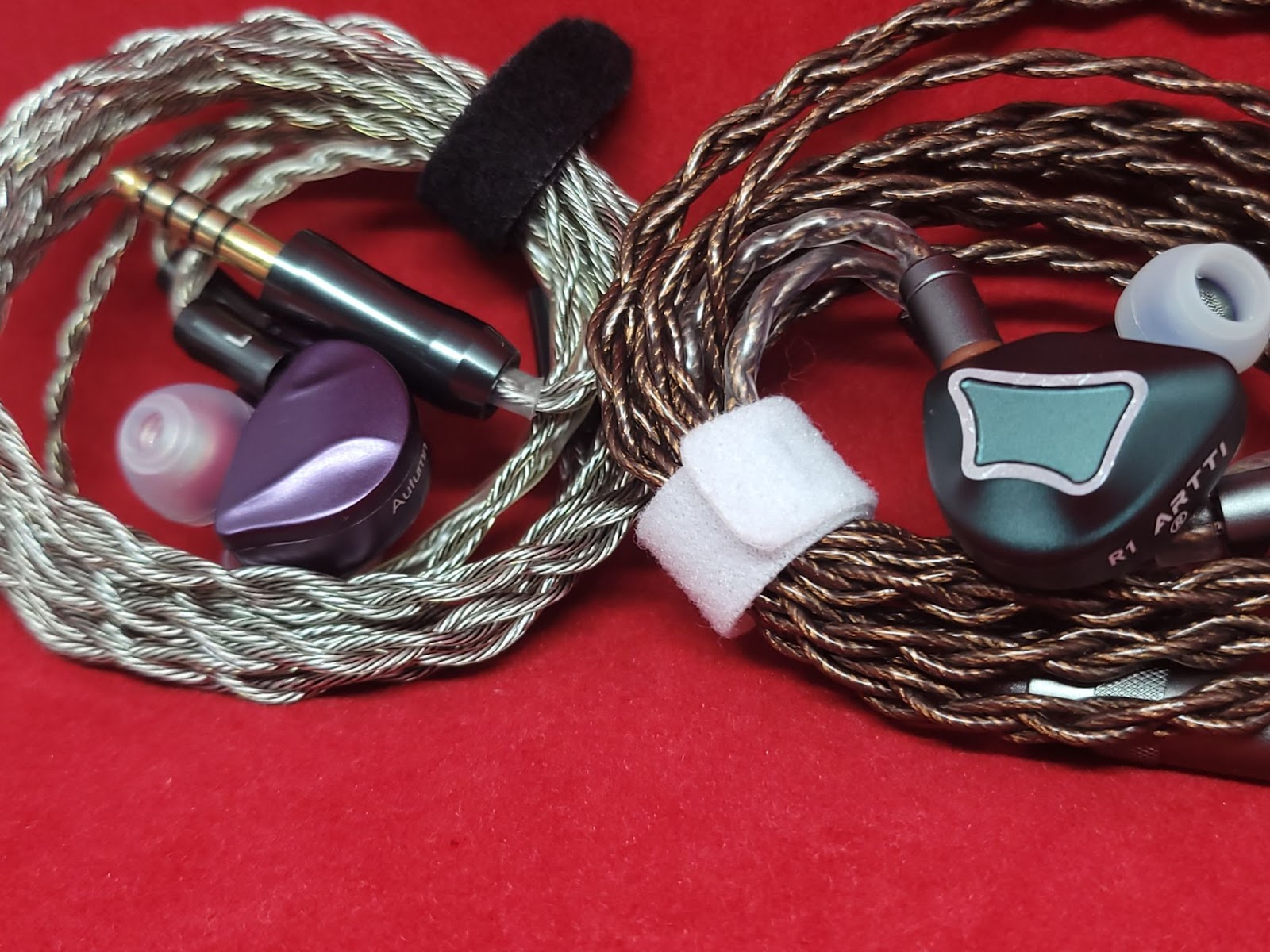
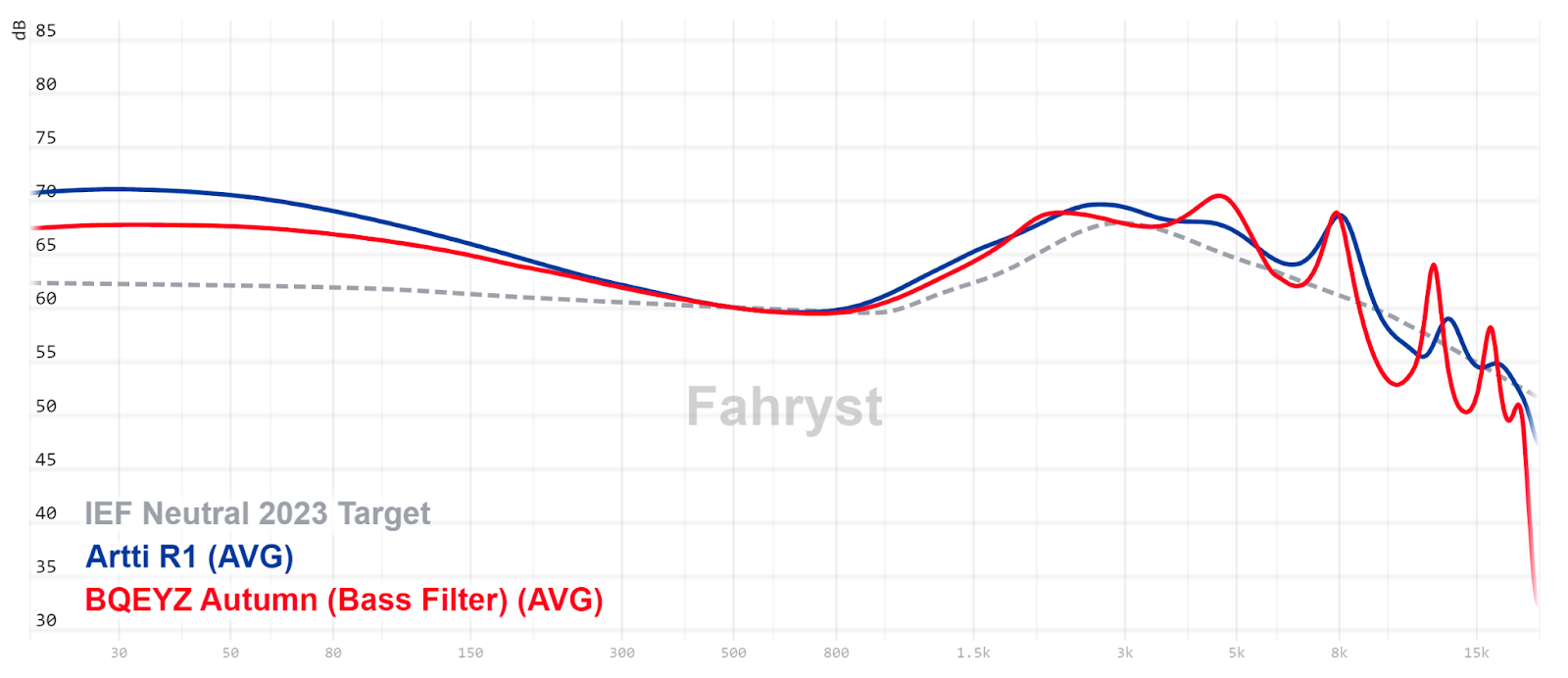
Disclaimers
I bought Artti R1 with a discount in exchange for a review. As I always say, everyone is biased one way or another so take everything you read with a grain of salt. Also I will try to be more concise and to the point in my reviews from now on without worrying about the word count etc. If you have any questions, please ask me in the comments and I will try to answer them to the best of my abilities.
Configuration, Build and Accessories of Artti R1
R1 uses three dynamic drivers per side, one being an 8 mm beryllium composite diaphragm driver for bass and two 6 mm PU suspension edge and titanium dome drivers for the rest of the frequency range. There is a crossover but no info about its design or whether it’s two or three way.Shells of R1 made out of aluminum. They are relatively light and moderately comfortable. In fact, the shell shape is pretty much identical with LetShuoer’s DZ4, except DZ4 uses a resin shell.
Cable that the Artti R1 comes with is nothing extraordinary. They have both 3.5 mm and 4.4 mm options and I opted for 4.4 mm. Apart from the cable, R1 comes with two sets of generic tips and a case made out of fabric. All the accessories were placed in the case to save space in the box so the set provides a modest unboxing experience.
Sound of Artti R1
Tonality
Artti R1 has a V-shaped tonality with the emphasis on the bass region.Bass on R1 is overpowering but also kind of loose. It bleeds into the mids, making the whole presentation warm, lush, rich and fuzzy.
Mids aren’t particularly recessed but since bass is too overpowering, they usually get overshadowed. Upper mids however are emphasized so that they can still shine through with female vocals and electric guitars. When there aren't overpowering bass notes, this warm tonality makes them sound lush and romantic.
Treble is present but not overemphasized. Hi-hats have decent sparkle and don’t sound very blunted.
Technicalities
Artti R1 doesn’t impress too much with its technical capabilities. Although having separate drivers helps a little, being a bassy IEM, the details can get lost in the mix. They don’t particularly feel wide either but depth is decent. Imaging is OK but nothing exceptional. All in all, technically they represent the price bracket they belong to.Comparisons
Artti R1 vs. LetShuoer DZ4
Comparing Artti R1 to LetShuoer DZ4 made sense because their prices are similar and DZ4 also uses 3 drivers plus a passive radiator.- R1 is much warmer, bassier, rumblier and richer. Bass guitars are especially pretty much absent in DZ4. Bass quality is slightly better on DZ4, R1’s bass feels pillowy. Both have good bass extensions.
- Although upper mids are similar, the warmth on R1 skews the balance towards darkness. DZ4 is clearer and sounds more neutral.
- Neither is exactly shouty, but both have more than enough energy in the upper mids, maybe R1 slightly more pronounced.
- R1 has slightly more bite in the treble but neither is harsh.
- R1 is technically more capable. Imaging is sharper and it resolves more nuances but unfortunately excess bass amount masks most of these nuances so DZ4 may come as more detailed. Both have moderate stage size. Timbre is slightly metallic on DZ4. R1 sounds lush, not the most natural but more natural than DZ4.
Artti R1 vs. BQEYZ Autumn (with Bass Filter)
I use Autumn in comparisons a lot because it is one of my favorite iems. In this case I believe Autumn’s bass implementation is what R1 could have used in my personal opinion.- R1 is again bassier, rumblier and warmer. Autumn’s bass is just right for me, it is also tighter and more textured.
- Bass bleed is also minimal on Autumn with just enough richness while remaining clean and clear. R1 is overly rich and lush compared to that.
- Upper mids are just a smidge shoutier and electric guitars have more energy on R1
- Autumn’s biggest flaw is the 5k peak. While it adds presence to the recordings, in some cases it gets sibilant and harsh. However spinfit tips reduce this peak and only the hint of harshness remains. Artti does not have such a problem. Autumn is airier in the upper treble.
- Staging is better on Autumn as it feels much larger. Imaging is also sharper than R1. R1 resolves nuances as much as Autumn if not more but the bass amount just overwhelms and masks the details.
Conclusion
Artti R1 is a fine IEM and a very good one for bass lovers. For me, the bass amount was just too much and it did more bad than good. It sounded great with EDM and Lo-Fi music, decent with rock and metal but I just couldn’t connect to my music with R1 as much as I like. So my rating is very personal and I’m sure others will like it more than I did. One thing is for sure though, now I have another IEM to recommend to basshead friends.
Last edited:
Jarlaxle
100+ Head-Fier
Pros: EQ!
Great presets
Convenience of not needing a dongle
Pretty looks (subjective)
Good build quality
Decent comfort
Nice feeling cable
Great presets
Convenience of not needing a dongle
Pretty looks (subjective)
Good build quality
Decent comfort
Nice feeling cable
Cons: Included tips (or lack thereof)
Somewhat clunky app
Could be improved technically
Somewhat clunky app
Could be improved technically
Moondrop is one of the bigger players in the IEM market and May is their projection to the future in my opinion with the removable DSP cable and endless possibilities. With the 65 USD asking price, let’s see if Moondrop delivers on these promises.
Disclaimers
Moondrop May was provided to me by Shenzhen Audio for free in exchange for a review. As I always say, everyone is biased one way or another so take everything you read with a grain of salt. Also I will try to be more concise and to the point in my reviews from now on without worrying about the word count etc. If you have any questions, please ask me in the comments and I will try to answer them to the best of my abilities.
Build and Accessories of Moondrop May
May comes in a package we became accustomed to. Personally I like the anime art style they use and providing a frequency response graph is always welcome. What comes in the packaging is a little humble however, with a very nice case, the dsp cable which is identical to their freedsp cable apart from the branding and just one set of generic tips which I didn’t even use.
Build of the earpieces is very good, almost identical to Moondrop’s own Variations with smaller shells so they are more comfortable for me than the other iems I have tried lately. Nozzles are rather thick but not very long so they aren’t intrusive. Shells are made out of semi transperent dark resin and faceplates are mirrored metal. Yes they are fingerprint magnet but the playful pattern on the shells kind of camouflages them.
Inside May uses two drivers. The 10 mm dynamic driver is a full frequency one unlike the most other hybrids and the 6 mm, what they call annular planar driver, helps with the treble frequencies.
Sound of Moondrop May
Tonality
Talking about the tonality of an IEM that is made to be equalized is a little stupid but still I could talk about presets here. I mostly used May on the Standard preset. In this setting, tuning was subbass focused neutral with great tactility and decent body. Mids and treble were also on point with no shout or harshness at all.
Harman preset, although looks bassier on graphs, is cleaner, clearer and vocal focused. Not that other presets are muddy, in fact, I’d argue a lot of people would find Harman preset a little lean but it sounds very good when the song is suitable.
Other settings are more or less variants of the Standard preset with different bass levels.
Lastly, setting all the filters at 0 gain manually yields the same result with using a different cable. Some of my friends prefer listening to May this way. It isn’t vastly different from similar presets so you can tell the baseline is actually pretty good. In my opinion, Standard preset has a more balanced presentation while 0 gain has more bass and body and a little more blunted treble. If you are a treble head or like a little bite, you might not like May this way.
Technicalities
Moondrop May isn’t something that sets the world on fire with its technical capability. It is more or less on par with other good sub 100 USD IEMs. It doesn’t feel closed in, reveals good amount of details. Timbre is pretty good as it is and can be improved with EQ. Actually around 80% of technical qualities depend on the tuning in my opinion so potential is quite high.
More on the Cable and Moondrop Link 2.0 App
Like I said earlier, in the case of May talking about the possibilities instead of Tonality of the IEMs makes more sense.
May’s cable is identical to Moondrop’s own FreeDSP cable which is sold for 30 USD. FreeDSP however, comes with different presets while the presets on May’s cable are specialized for May. Still you can download other presets from Moondrop that imitate their other IEMs or other users uploaded. You can also import EQ profiles that you created using tools like AutoEQ. Unfortunately Parametric EQ only uses peak filters so I assume the profiles you import also shouldn’t include shelf filters.
There are 9 bands of filters which should be enough for any profile. The profile you create and apply is saved in the cable so you can use the last setting you applied with any other device including your computer. The app doesn’t work as smoothly as I’d like it to but I hope it keeps improving.
Comparisons
Truthear Hexa vs. Moondrop May (no filter applied)
May is a product that is a whole nother level from the conventional IEMs. I could have compared it to Tanchjim's One DSP but honestly there is nothing to compare. One DSP is a cheaper alternative to May with caveats. It only has 5 adjustable filters, technically inferior and has a zinging upper treble quirk that is harder to fix with EQ.So I decided to compare May without applying any EQ to Truthear’s Hexa which is considered a benchmark below 100 USD by.
- To be honest, they are more similar than different, neither is sibilant or harsh.
- Without the DSP cable May is richer, has a little more body, vocals are a little more forward and drums and bass guitars are highlighted more.
- Treble on May is ever so slightly more refined. Hexa’s treble although, not harsh, kind of loses its composure compared to May’s. Still without any filters, May’s treble lacks a little bite so treble heads beware.
- May feels more spacious while Hexa is more closed in. Imaging and layering on May is better. May is also slightly more resolving but neither is truly exceptional in this area.
Conclusion
I enjoyed my time with Moondrop May a lot. In fact I have already recommended it to my friends. It is not perfect, of course it isn’t, especially the app should be refined more. But at the price it was offered I’m more than happy. For quite a while I wasn’t genuinely enjoying my music with the equipment that came for a review. But with May, I often found myself forgetting that I was supposed to review it, bobbing my head, vibing to my test tracks again that started to become boring after listening to them so many times.
I know some may argue that they were already using equalizing apps on their phones but having that DSP correction in the cable itself and not using a software is a convenience by itself. If I were to leave the hobby today, May would be one of the things I would definitely keep because of this convenience, versatility and all the possibilities it brings to the table.
Last edited:
Jarlaxle
100+ Head-Fier
Pros: One of the best textured and defined bass rendition
Lifelike timbre
Enveloping staging and sharp imaging
Lifelike timbre
Enveloping staging and sharp imaging
Cons: Size of the shells
Nozzles don’t accommodate wider aftermarket tips
Overshadowed vocals and electric guitars
Fatiguing
Nozzles don’t accommodate wider aftermarket tips
Overshadowed vocals and electric guitars
Fatiguing
Sony needs no introduction. Being an electronics giant, they have some consumer level audio products, but also they are audio professionals with record labels, studios and such, they make some of the best pro and enthusiast level audio products. IER-Z1R is one such product in their line. When they were released in 2018, you had to dish out 1999 USD, but nowadays they can usually be found around 1699 USD or less depending on the time of the year.
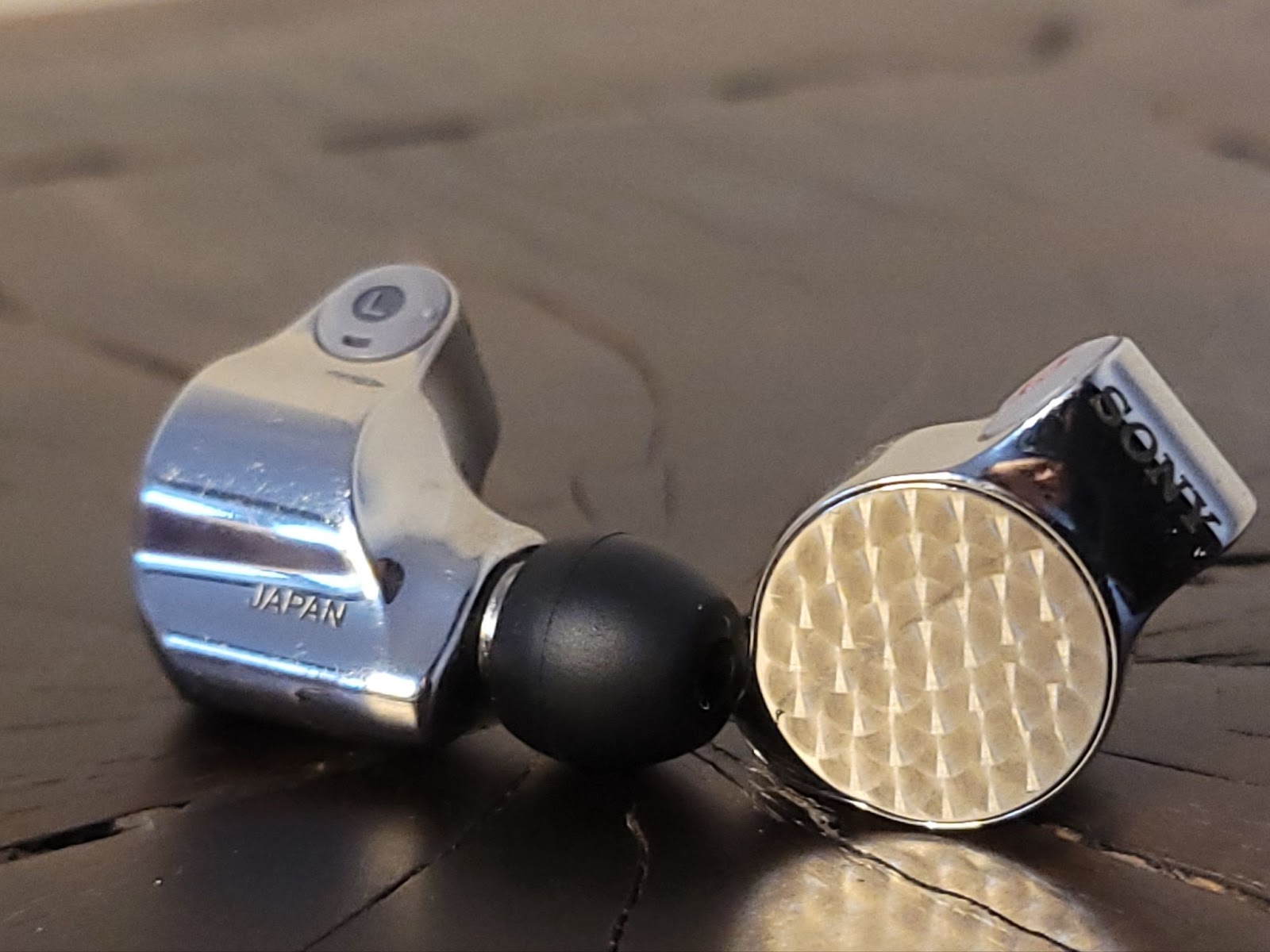
Sony IER-Z1R was loaned to me by a friend of mine along with a Kinera x Effect Audio Orlog Cable. As I always say, everyone is biased one way or another so take everything you read with a grain of salt. Also I will try to be more concise and to the point in my reviews from now on without worrying about the word count etc. If you have any questions, please ask me in the comments and I will try to answer them to the best of my abilities.
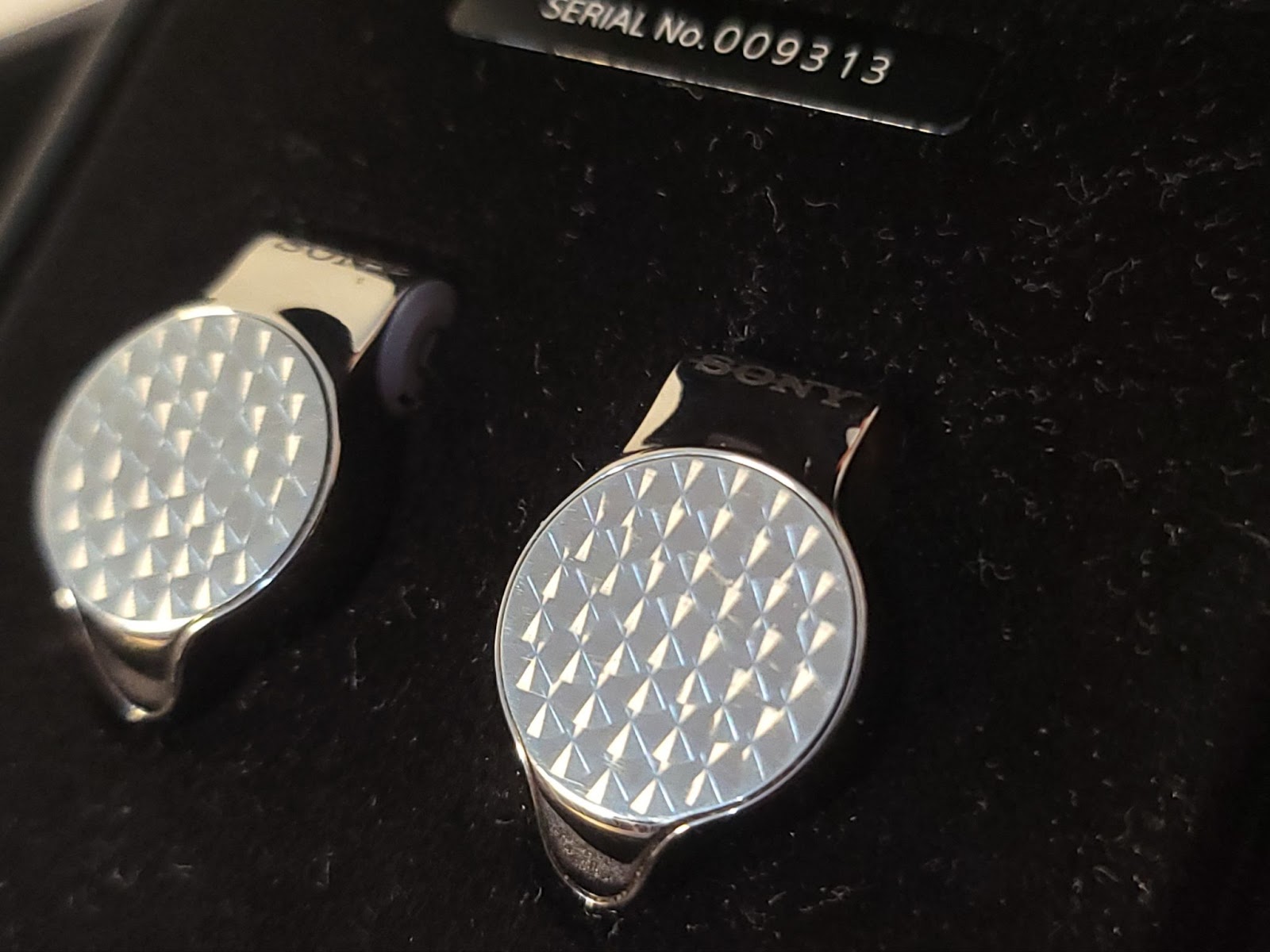
IER-Z1R has huge round steel shells that are infamous for their uncomfortable fit. Surprisingly they fit my ears decently with a deep enough insertion. No, they are not comfortable and I get tired after an hour but I’ve inserted worse things in my ear. Especially pseudo custom shells usually touch unnecessary parts in my unusually shaped concha but Z1R doesn’t so I think I could live with them.
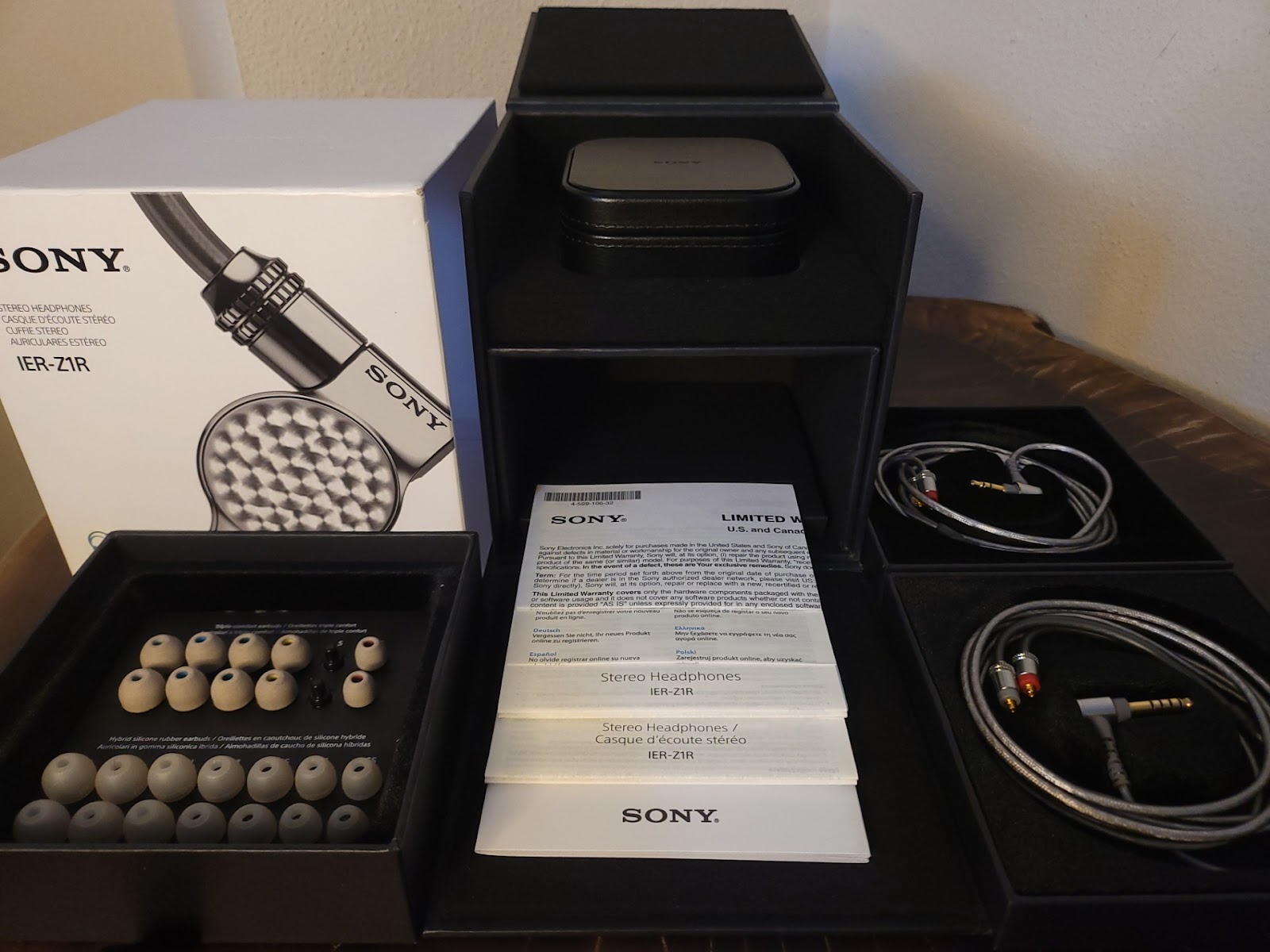
Box is fitting for a Top of the Line IEM with magnetic drawers, two cables, 13 pairs of tips and a hard case. Cables are not bad but not braided and they tend to retain their shape.
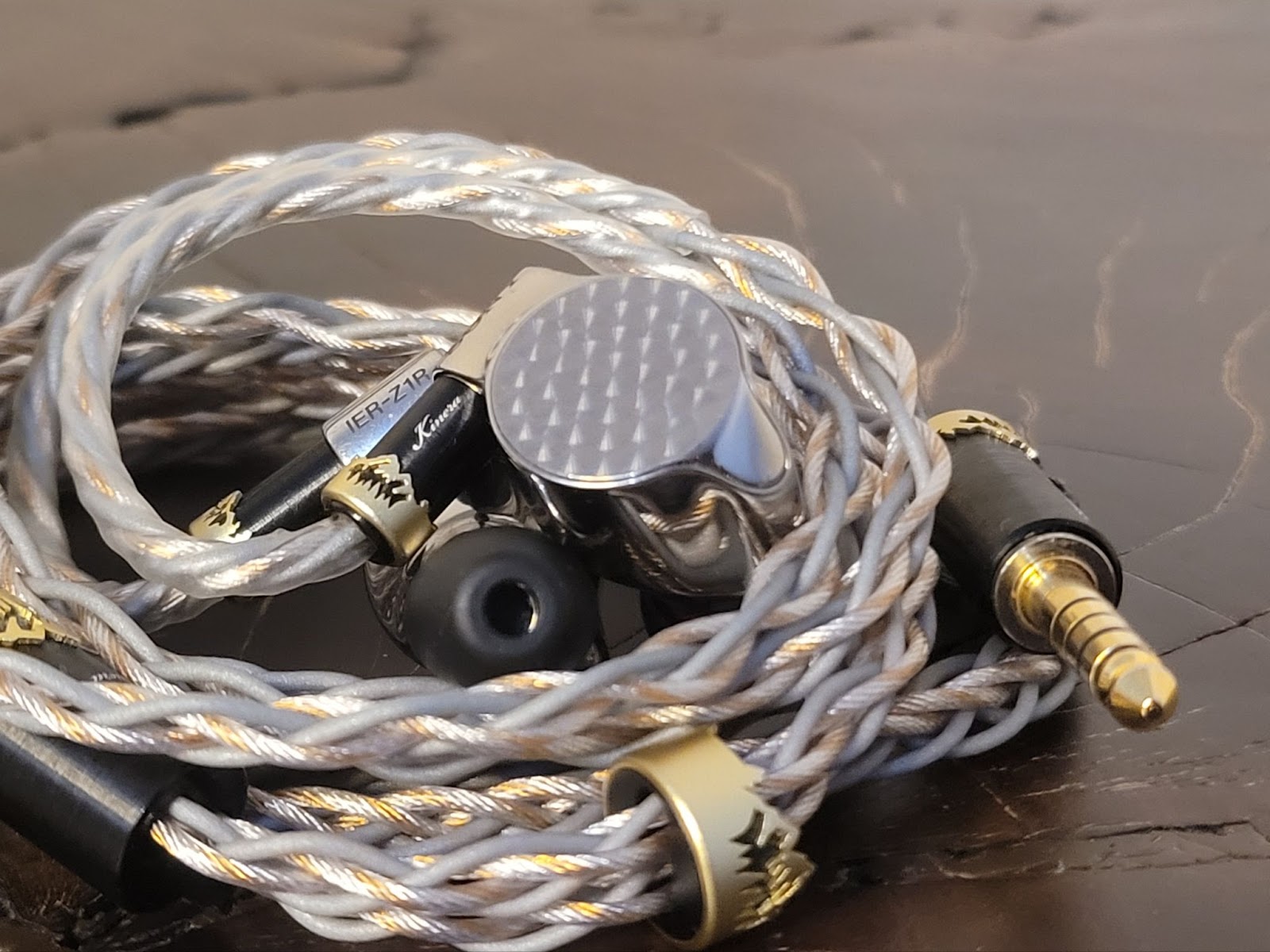
The bass on Z1R however, is probably the most well defined, textured and natural bass I’ve ever heard on an IEM so far. It has just the right attack and decay which reminds me of the days when we messed around in recording studios. It also has that old school vibe of the boom boxes which makes you believe that the sound field is deeper than it is. It’s an attribute that is really hard to achieve on an IEM. I actually got the similar vibe from 7Hz Legato but the quality of Legato’s bass was nowhere near that of Z1R's.
Z1R’s treble is very well extended, so much so that I had a hard time believing that it was achieved by just one balanced armature. However the overall treble is more prominent than neutral. It never got piercing or harsh but was somewhat fatiguing in longer listening sessions. I’m not sure if the size of the shells or the amount of treble was more fatiguing for me so it wasn’t too much of a problem however I felt its excessiveness especially when I raised the volume with vocal heavy tracks.
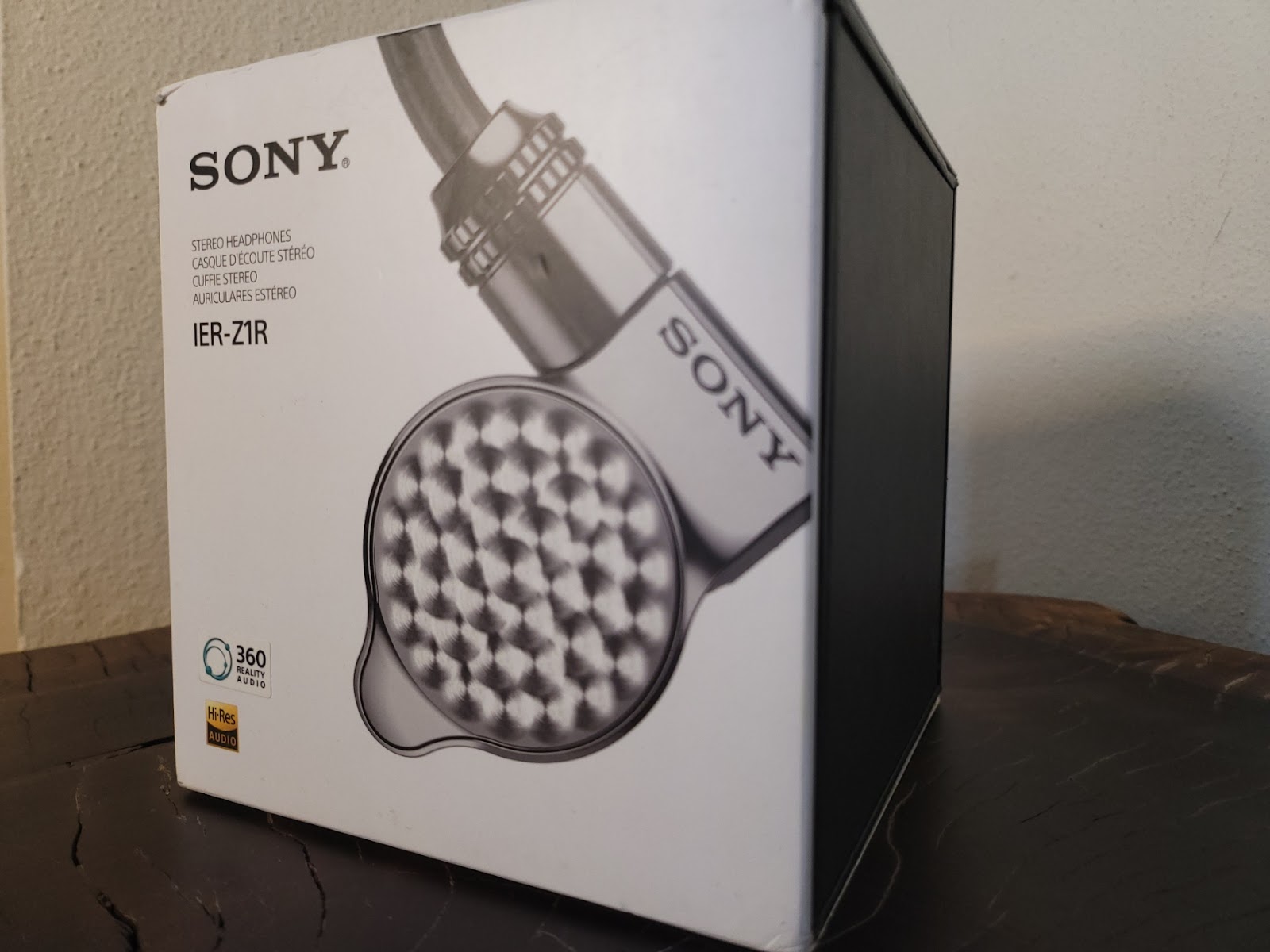
There is not much to say about Z1R when it comes to technicalities. Although probably there are many more detailed IEMs out there, Z1R’s resolving and staging capabilities and timbral qualities carves its place among other TOTL IEMs. Staging and imaging was especially very lifelike and believable.
AKG N5005 is still the flagship of AKG’s IEM line although they aren’t in production anymore. They cost 1000 USD when they were first released.
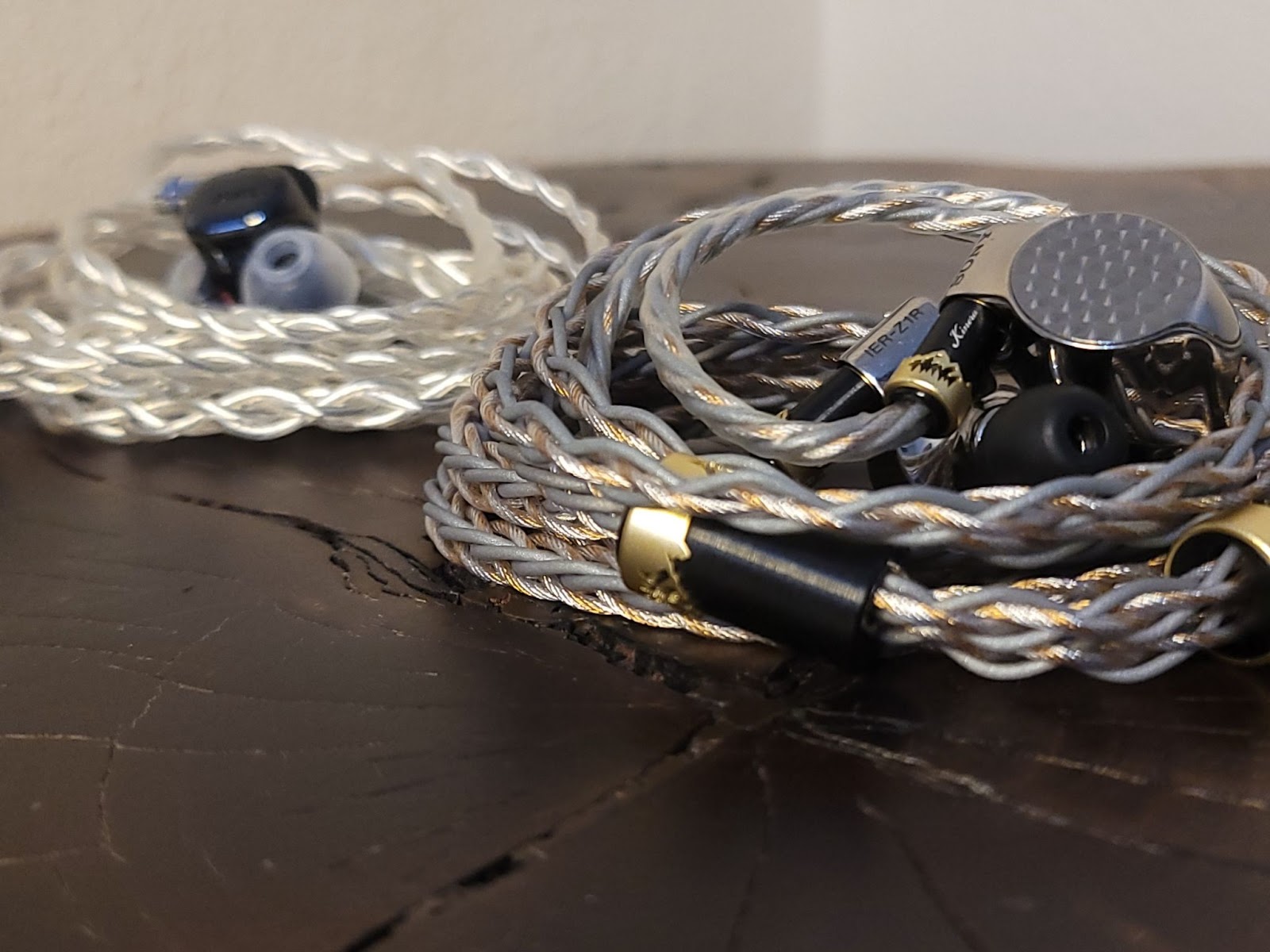
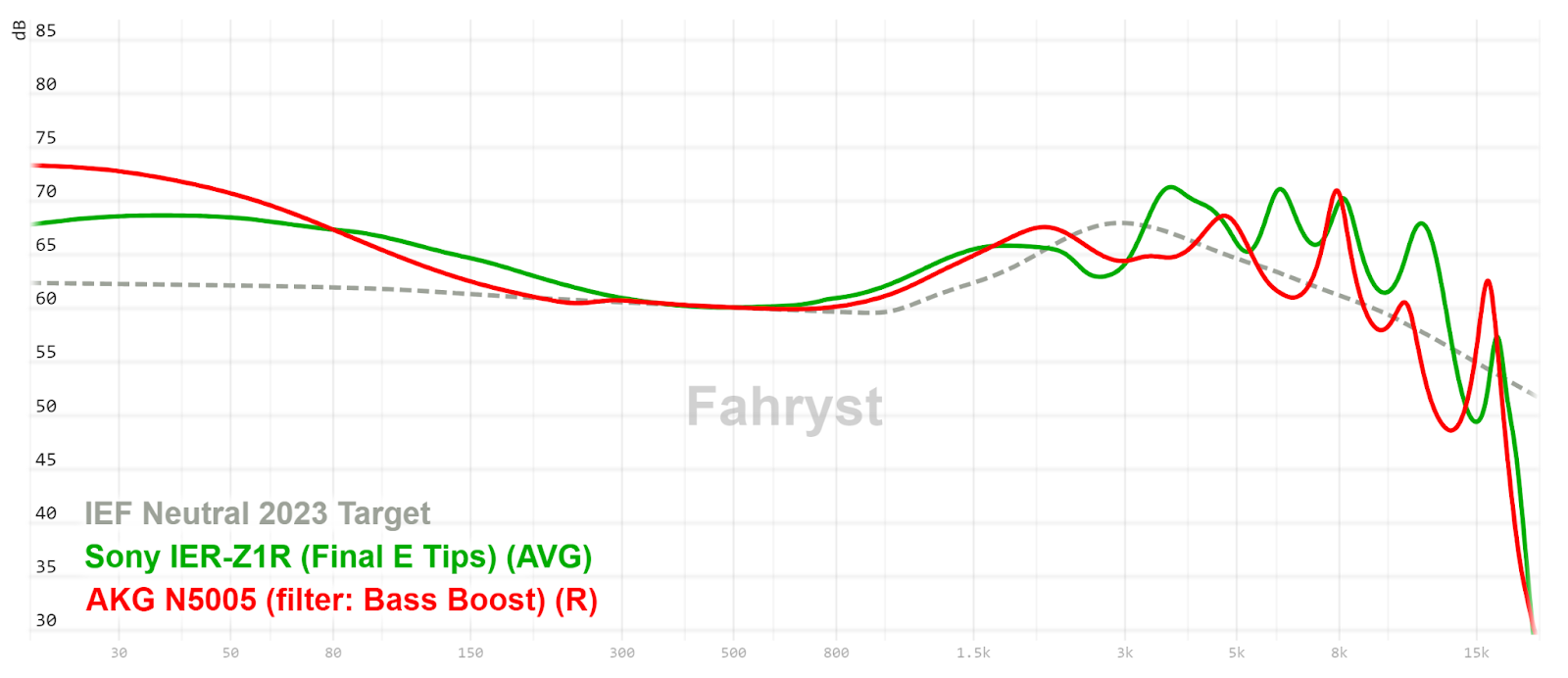
Moondrop Variations is among the best IEMs I have on hand and still one of the best value products on the market.
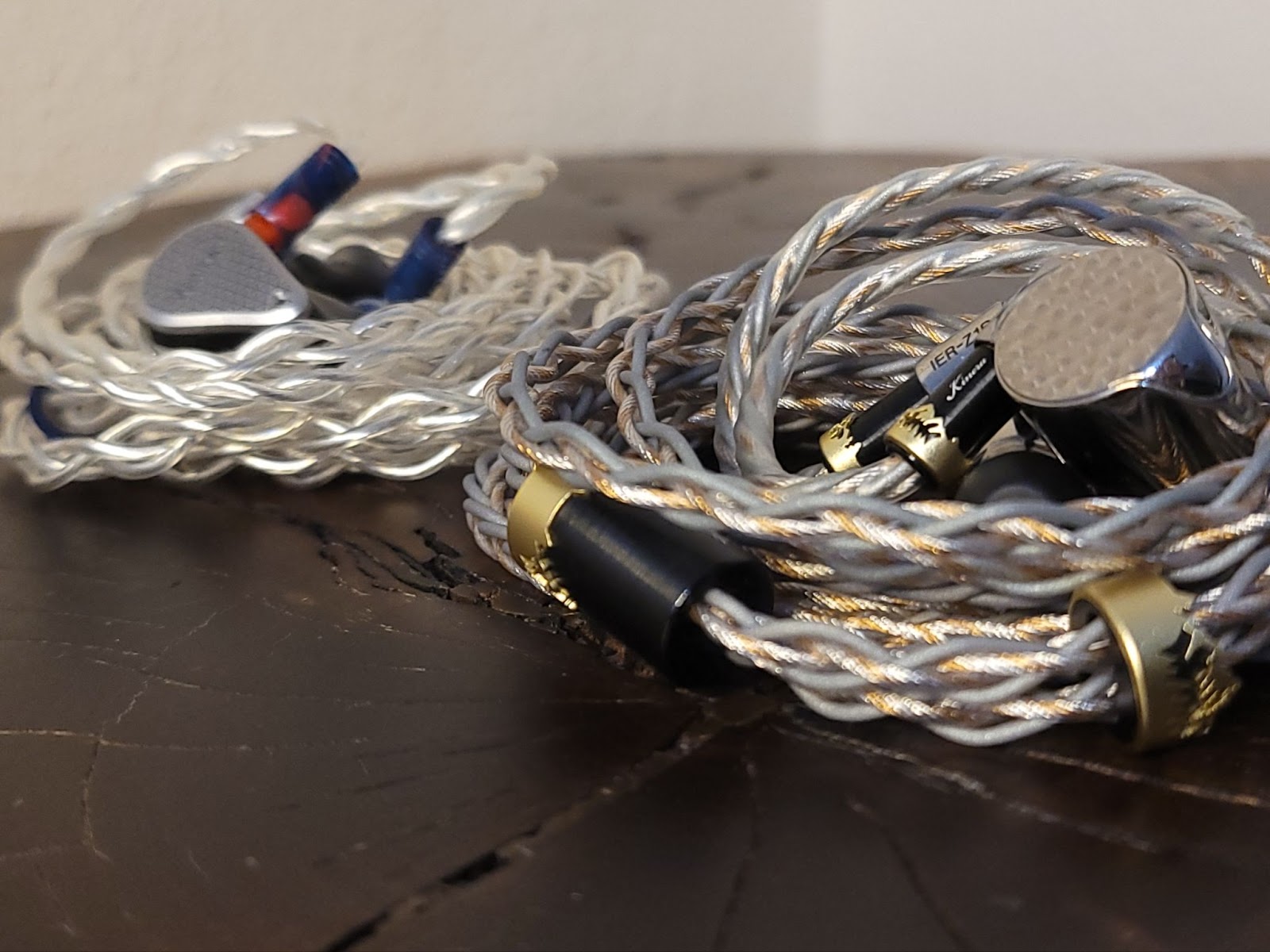
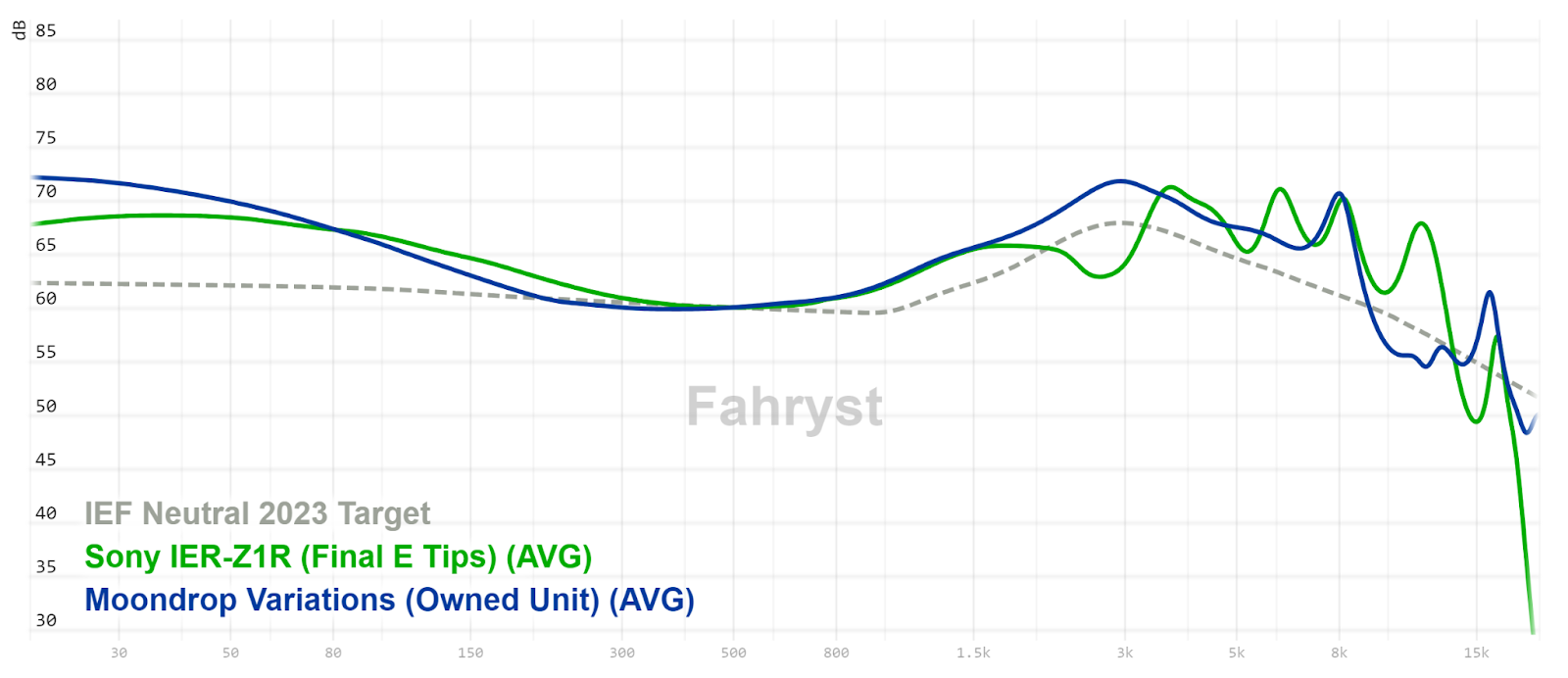
I don’t think I have added anything new regarding the opinion of the community about these old pieces of gems. However, it was a great experience for me. Sony IER-Z1R was one of the best sounding things I’ve ever put in my ears. Sound signature wasn’t exactly my favorite but even then I still could enjoy them and appreciate their capability.
These are very expensive, yes, and probably they were even more out of reach when they were released. But nowadays, there are much more expensive IEMs coming out of China and other countries which makes me believe that IER-Z1R not only held its ground but also added to its value.
Disclaimers
Sony IER-Z1R was loaned to me by a friend of mine along with a Kinera x Effect Audio Orlog Cable. As I always say, everyone is biased one way or another so take everything you read with a grain of salt. Also I will try to be more concise and to the point in my reviews from now on without worrying about the word count etc. If you have any questions, please ask me in the comments and I will try to answer them to the best of my abilities.
Build and Accessories of Sony IER-Z1R
IER-Z1R has huge round steel shells that are infamous for their uncomfortable fit. Surprisingly they fit my ears decently with a deep enough insertion. No, they are not comfortable and I get tired after an hour but I’ve inserted worse things in my ear. Especially pseudo custom shells usually touch unnecessary parts in my unusually shaped concha but Z1R doesn’t so I think I could live with them.
Box is fitting for a Top of the Line IEM with magnetic drawers, two cables, 13 pairs of tips and a hard case. Cables are not bad but not braided and they tend to retain their shape.
Sound of Sony IER-Z1R
Tonality
Sony IER-Z1R has a mild V-shaped signature. Mids are somewhat recessed, especially upper mids, which keeps vocals from popping as much as I like and am used to.The bass on Z1R however, is probably the most well defined, textured and natural bass I’ve ever heard on an IEM so far. It has just the right attack and decay which reminds me of the days when we messed around in recording studios. It also has that old school vibe of the boom boxes which makes you believe that the sound field is deeper than it is. It’s an attribute that is really hard to achieve on an IEM. I actually got the similar vibe from 7Hz Legato but the quality of Legato’s bass was nowhere near that of Z1R's.
Z1R’s treble is very well extended, so much so that I had a hard time believing that it was achieved by just one balanced armature. However the overall treble is more prominent than neutral. It never got piercing or harsh but was somewhat fatiguing in longer listening sessions. I’m not sure if the size of the shells or the amount of treble was more fatiguing for me so it wasn’t too much of a problem however I felt its excessiveness especially when I raised the volume with vocal heavy tracks.
Technicalities
There is not much to say about Z1R when it comes to technicalities. Although probably there are many more detailed IEMs out there, Z1R’s resolving and staging capabilities and timbral qualities carves its place among other TOTL IEMs. Staging and imaging was especially very lifelike and believable.
Comparisons
Sony IER-Z1R vs AKG N5005 (Bass Filter)
AKG N5005 is still the flagship of AKG’s IEM line although they aren’t in production anymore. They cost 1000 USD when they were first released.
- N5005 has more subbass. They have more grunt and also are more thumpy. Z1R on the other hand, is more impactful in the midbass and has probably the most natural and well textured bass rendition I’ve ever heard with true to life attack and decay.
- Upper mids are recessed on Z1R so, vocals and electric guitars on N5005 are more lively and energetic.
- Timbre on Sony Z1R is much better and lifelike.
- High hats retain their natural metallicness on Z1R while on N5005, they can sound more plasticky or nasally compared to that.
- Z1R is a little more edgy in the lower treble and more prone to get sibilant. With bass filters N5005 is easier to listen to but with any other filter it is sibilant and piercing for me.
- Z1R has a more enveloping and lifelike stage. N5005 sounds wider but also flat. It can also be attributed to their fit, Z1R fits deeper in my ears. Both of their imaging and layering capabilities are on par.
- Z1R is slightly more detailed but more than that, it renders these details effortlessly and naturally.
Sony IER-Z1R vs Moondrop Variations
Moondrop Variations is among the best IEMs I have on hand and still one of the best value products on the market.
- Bass on Z1R is more impactful, textured and detailed. Variation’s bass is still decent, it rumbles more in the subbass. Bass guitars however, Variations’ weakest point and Z1R’s well articulated bass is miles ahead in this area.
- Variations is a vocal specialist. Although a little shouty and lean, they are also clean, crisp and engaging. Vocals are more recessed on Z1R and can be overshadowed by the other instruments like drums and hi-hats, but they slightly have a richer tone.
- Treble on Variations has decent energy and pretty much on point for me, Z1R’s treble is elevated and has better extension however it can get spicy compared to Variations. I didn’t find the Z1R piercing or harsh no matter how much I turned up the volume but it has a bright tuning nevertheless. Still if you are looking for a little bite, Z1R’s treble might be more suitable for you.
- Variations has a wider stage and feels more spacious. But Z1R has a slightly sharper imaging and instrument layering.
- Z1R again has a more lifelike and believable timbre. While comparing them head to head I noticed Variations’ rare shortcomings for the first time.
- Variations sounds more detailed thanks to its cleaner tuning but it also sounds a little more blunted and restrained compared to Z1R. I think Z1R is as resolving as Variations if not more. It goes without saying that how now 5-years-old Z1R’s lower driver count can keep up with others is quite an accomplishment.
Conclusions
I don’t think I have added anything new regarding the opinion of the community about these old pieces of gems. However, it was a great experience for me. Sony IER-Z1R was one of the best sounding things I’ve ever put in my ears. Sound signature wasn’t exactly my favorite but even then I still could enjoy them and appreciate their capability.
These are very expensive, yes, and probably they were even more out of reach when they were released. But nowadays, there are much more expensive IEMs coming out of China and other countries which makes me believe that IER-Z1R not only held its ground but also added to its value.
Last edited:
Jarlaxle
100+ Head-Fier
Pros: Excellent technicalities for the price
Great metal build
Fairly comfortable
Very balanced tuning
Very easy to drive
Great metal build
Fairly comfortable
Very balanced tuning
Very easy to drive
Cons: Might be a bit too bright for some
You might hear the noise floor due to the high sensitivity
You might hear the noise floor due to the high sensitivity
Simgot had a great year. They obtained great success with their single DD EA500 and released hit after hit since then. One of those hits is EW200 Maze. I had my eye on a pair ever since their release and when Simgot reached out to me, I especially asked them for one to see what’s the fuss about these 40 USD IEMs.
Disclaimers
Simgot EW200 Maze was provided to me by Simgot for free and I only paid for the customs fee. As I always say, everyone is biased one way or another so take everything you read with a grain of salt. Also I will try to be more concise and to the point in my reviews from now on without worrying about the word count etc. If you have any questions, please ask me in the comments and I will try to answer them to the best of my abilities.Build and Accessories of Simgot EW200 Maze
Earpieces of EW200 are fully made out of metal, both shells and faceplates. Finish is glossy and mirrored just like EA500 but shape is not oval. In fact the shape of the ear pieces is probably identical to EW100P but I don’t have a pair so cannot really comment on that. According to the marketing, during the manufacturing of the shells both casting and CNC methods are used, probably to keep the cost down. I’m glad that they did. I wasn’t interested in EW100p too much but full metal budget IEMs always intrigue me.Just like EA500, nozzles are nicely angled, providing good comfort for my ears. I heard some people have issues with angled nozzles but, apart from comfort I also think that they help with staging and imaging, just like angled pads/drivers in headphones. Earpieces have a little heft to them so keeping them in your ears might prove difficult, but if the earhooks of the cable you use are reliable, I don’t think you will have any issues.
Speaking of drivers, Simgot says these are originally developed for their upcoming flagship IEMs. They call this driver Dual-sided Silicon Crystal Plasma a.k.a. SCP which is apparently a hybrid of DLC and LCP diaphragms, having both of their strong attributes. Of course all of these mean nothing if it doesn’t sound good. Left ear piece had driver flex but, with some friends’ recommendation I tried foams and silicon tips with wider bores so the flex issue was solved completely. I wanted to mention this in case any of you face such an issue.
I rambled about their build more than I usually do so let’s cut short to the rest of the package. After all, Simgot mostly cares about the build and the sound of their IEMs there is really not much else. Still embedding their motto: “Salute to Art and Science” to ear pieces and various places on the box is a nice touch. The cable is decent enough although a little thin, similar to the EA500 cable with only difference being the color scheme of the wires. EW200 only comes with a set of generic tips and a pouch identical to the Tanchjim provides with their budget iems minus the branding. Nothing to complain about at this price. The EA500 case didn’t have any branding either by the way.
Sound of Simgot EW200 Maze
Tonality
EW200 has been in the market for months now, so I’ve already seen graphs and reviews earlier. Therefore their tonal balance didn’t surprise me. They are by all means bright and I know western listeners are kind of getting tired of Chi-fi IEMs being too bright. However, EW200 is tuned tastefully with a healthy amount of bass to balance the scales. Yes, they have a satisfying bass but definitely not muddy or overbearing. Midbass and lower mids are clean but not too dry. I could enjoy both EDM and J-Pop equally. Vocals pop just like EA500, which made me believe that this is Simgot’s house sound, now that I’ve heard two of their offerings. EW200 never got harsh in healthy listening volumes during my testing, though being bright I can imagine they can get edgy for some people.Technicalities
I was expecting the tonal balance of EW200 to be good but, I really wasn’t expecting them to perform this well technically. Ten seconds in and I was completely caught off-guard by the enveloping sound of EW200. Their staging and imaging is extraordinary at this price, and resolving capability is just as good as any top performer single DD in the sub 100 USD category.
Of course tonal balance aside, these attributes require context so let’s move on to the comparisons.
Comparisons
Simgot EW200 Maze vs. Truthear x Crinacle Zero: RED
- EW200 has more bass and sub-bass presence. Zero: RED, in its stock form, has just enough bass. Adding a 25 ohm adapter increases the bass amount and skews the balance towards lower frequencies, but not really increases the impact power and fun. EW200’s bass is faster, tighter and more controlled. Red’s bass is behind in these aspects and adding impedance only makes it worse by increasing bloat and distortion.
- EW200 is much brighter, RED is darker and more relaxed compared to that. Still the clean presentation compensates for this disadvantage on RED.
- Mids, especially vocals and guitars are livelier on EW200 without being too in your face. Red is too relaxed in that regard.
- EW200 is slightly shoutier and edgier but it doesn’t cross the line in my comfortable listening volumes. However, loud listeners might prefer Red for its more relaxed and forgiving tuning.
- Both have very clean and clear mids. EW200 achieves this with brighter tuning with engagement and becomes slightly edgy along the way. Red, on the other hand, to keep its relaxed presentation, sacrifices bass and lower mids a little.
- Technically or subjectively EW200 superior in all aspects. Timbre is slightly more appealing and convincing on EW200. Also EW200 is sharper and more precise in separation and instrument placement, Red sounds hazier and more blunted compared to that.
- EW200 sounds more spacious and enveloping compared to Red. Imaging is also much more precise on EW200. I find Red’s imaging especially underwhelming. Detail retrieval and resolution are also the areas where EW200 is stronger.
Simgot EW200 Maze vs. Simgot EA500
- EW200 has noticeably more bass, punch and impact.
- EA500 has a slightly warmer and richer tone. Compared to that, EW200 is cleaner and female vocals pop a little bit more.
- Their treble is almost identical, they are both bright and slightly edgy but never crossing the line for me.
- EA500’s staging and imaging is slightly superior but they are again so close.
- EW200 sounds so close to EA500 that it was scary, however EA500 proved itself as the superior IEM on Dream Theater’s Panic Attack. Timbral qualities, separation and resolution capabilities of EA500 overshadowed EW200 and rightfully so.
On another note, I would have liked to compare EPZ Q5 since they are close in price but, I loaned it to a friend and didn’t have it with me while reviewing the EW200. However, in my review of Q5, I also compared it to Simgot EA500 and I remember the gap being larger between them than EW200 and EA500 in technicalities. So I would probably prefer EW200 to Q5 although they measure pretty close.
Conclusion
EW200 came as a great surprise. Like I said earlier, I was expecting them to be good, but not this good. They almost made any other single DD irrelevant. They are well built, comfortable and sound great. They are very sensitive so you can use them with any equipment. What else can you expect at this price? If you like bright tonality and looking for a balanced tuning on a budget, look no further.
Ferdze
what is the nozzle size? thanks!
Jarlaxle
100+ Head-Fier
Pros: Great tuning that is both fun and clean
Relatively comfortable
Inclusion of protective pouches
Very good technicalities
Great bass performance thanks to a high performance driver
Relatively comfortable
Inclusion of protective pouches
Very good technicalities
Great bass performance thanks to a high performance driver
Cons: Only one set of generic tips
Subpar cable
Thicc nozzle
Tucked bass comes with a cost of leanness (not much)
Slight BA timbre
A little unrefined in the treble
Subpar cable
Thicc nozzle
Tucked bass comes with a cost of leanness (not much)
Slight BA timbre
A little unrefined in the treble
Chopin is Timmy Vangtan a.k.a. Gizaudio’s second collaboration with an IEM manufacturer to create a product that would suit his listening preferences as well as market trends. He is a pretty well known and liked individual by the community. Binary on the other hand, is the dark horse in this relationship. They are, by no means a new manufacturer, but Chopin is their first product in the international market as far as I know.
Priced at 199 USD MSRP, which is very crowded with highly competent iems by the way, the 1+3 hybrid iem Chopin promises a lot, but does it deliver? We will try to find out in this review.
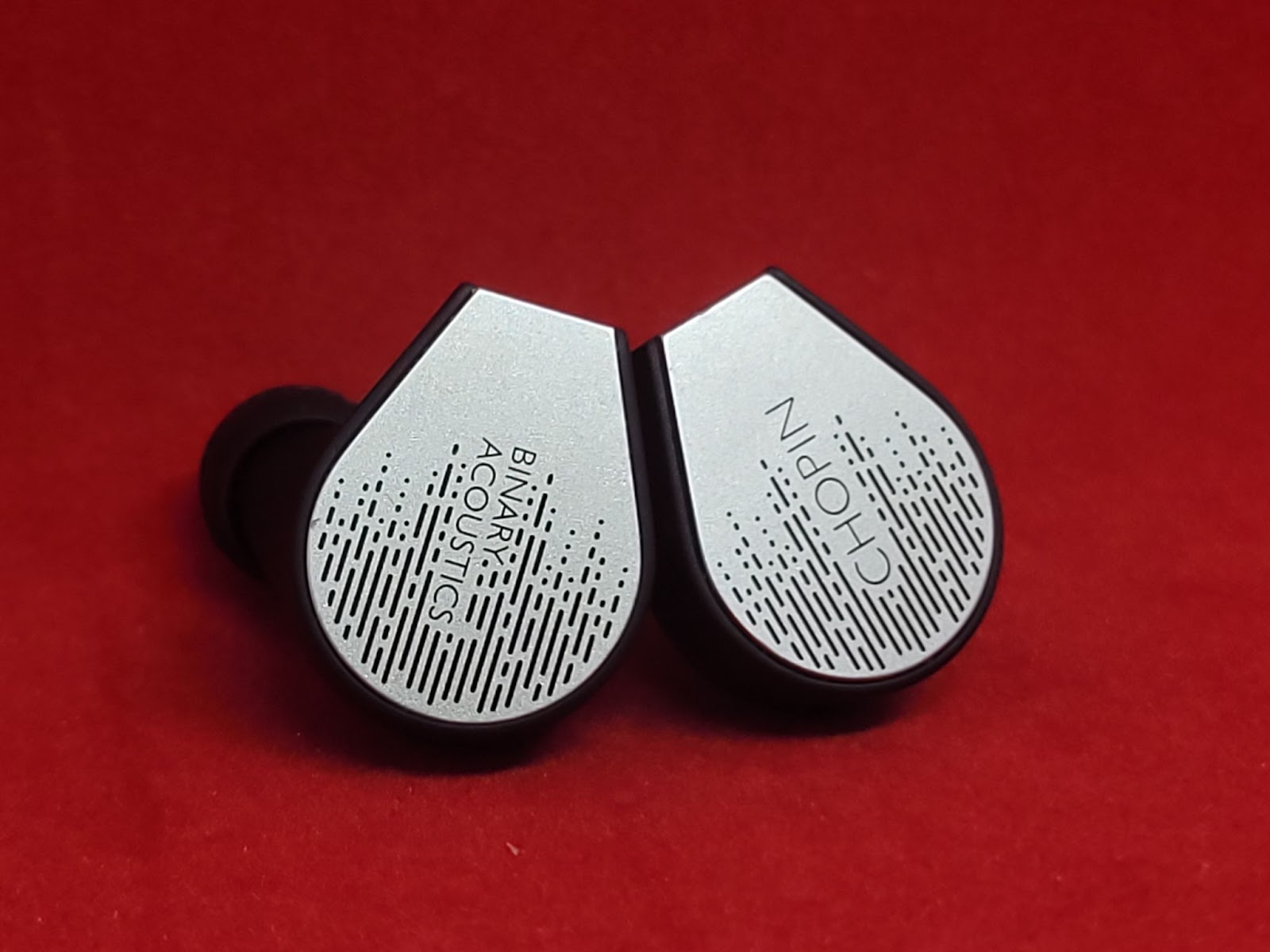
Binary x Gizaudio Chopin was provided to me by Hifigo with a discount in exchange for a review. As I always say, everyone is biased one way or another so take everything you read with a grain of salt. Also I will try to be more concise and to the point in my reviews from now on without worrying about the word count etc. If you have any questions, please ask me in the comments and I will try to answer them to the best of my abilities.
As soon as you open the box, you immediately notice Chopin is a no-frills kind of iem. As Eiji (Zerstorer_GOhren) had called it, utilitarian is the best word to describe their design intention. Box opens upwards in an uncommon way and reveals the case, the accessories and some literature.
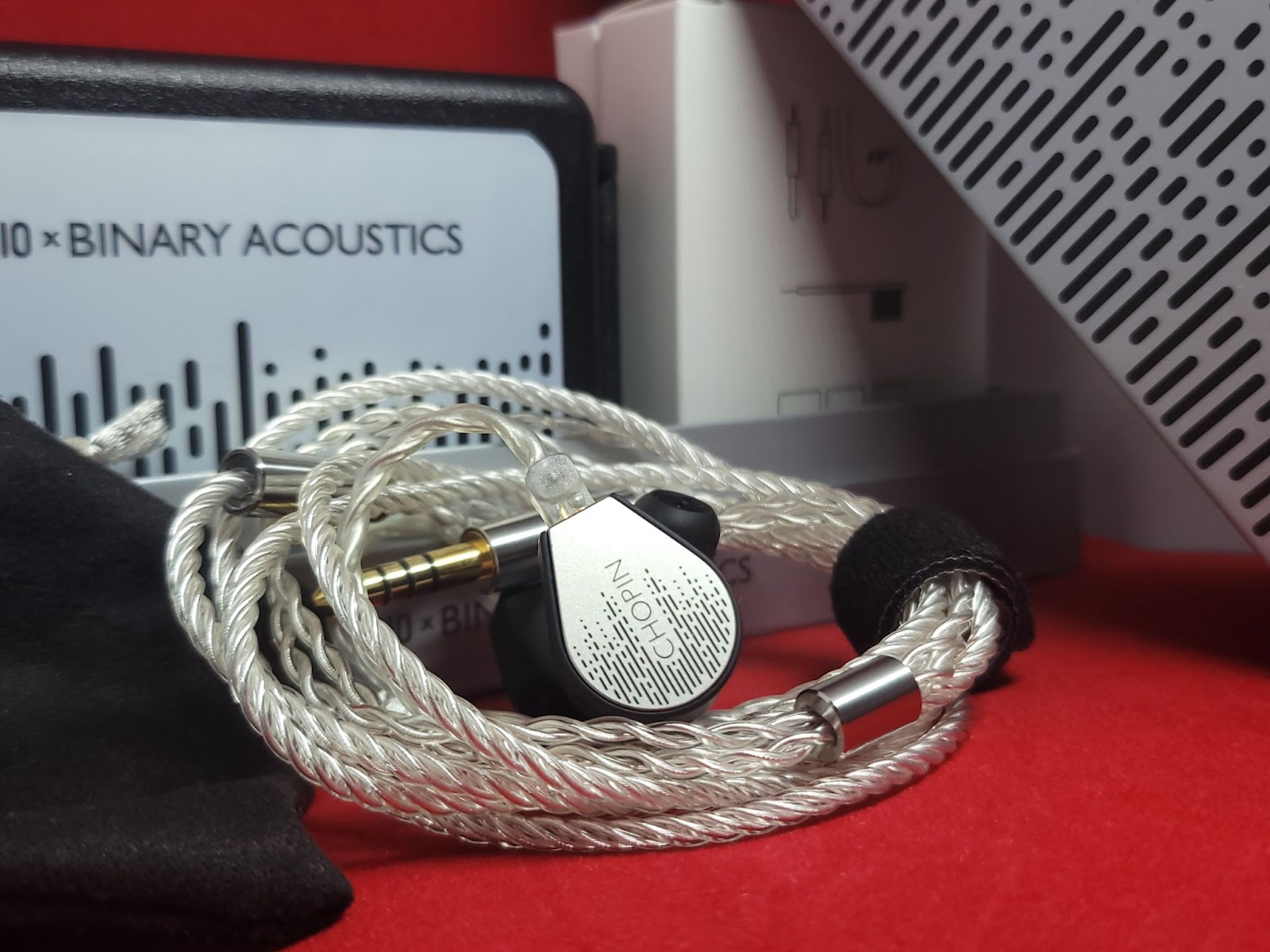
When you open the case, you notice the ear pieces are placed in small pouches each, at least they are supposed to, but mine were flying around freely. Fortunately the unimpressive plastic case has some soft foam in it, so the shells weren’t damaged and iems are working fine.
Accessories box is also unimpressive with a set of generic tips, a cleaning brush and a 4.4 mm balanced cable. At first they didn’t have a 3.5 mm single ended choice but now they do so good news.
I have to make a point of two things before I move on to the shell design. My first gripe is the cable, it really is something you would expect from an iem that is below 100 usd. I won’t comment on if or how it affects the sound but I’ve seen much better cables from cheaper iems. But at least I appreciate the offering of a balanced choice. My other and bigger gripe is the tip offerings. Most of the reviewers and pre-orderers get Divinus Velvet Tips with their iems but I didn’t. Probably they have forgotten or something. Why I’m saying this is because until I tried my JVC Spiral Dots, I couldn’t get a good fit. They were either uncomfortable or didn’t seal properly. So in my opinion a suitable aftermarket tip is a must with these. Fortunately if you order now, Chopin comes with Softears UC tips. I don’t have UCs but I have tried similar tips. Unfortunately they weren’t near as good as JVC Spiral Dots for me, so that you know.
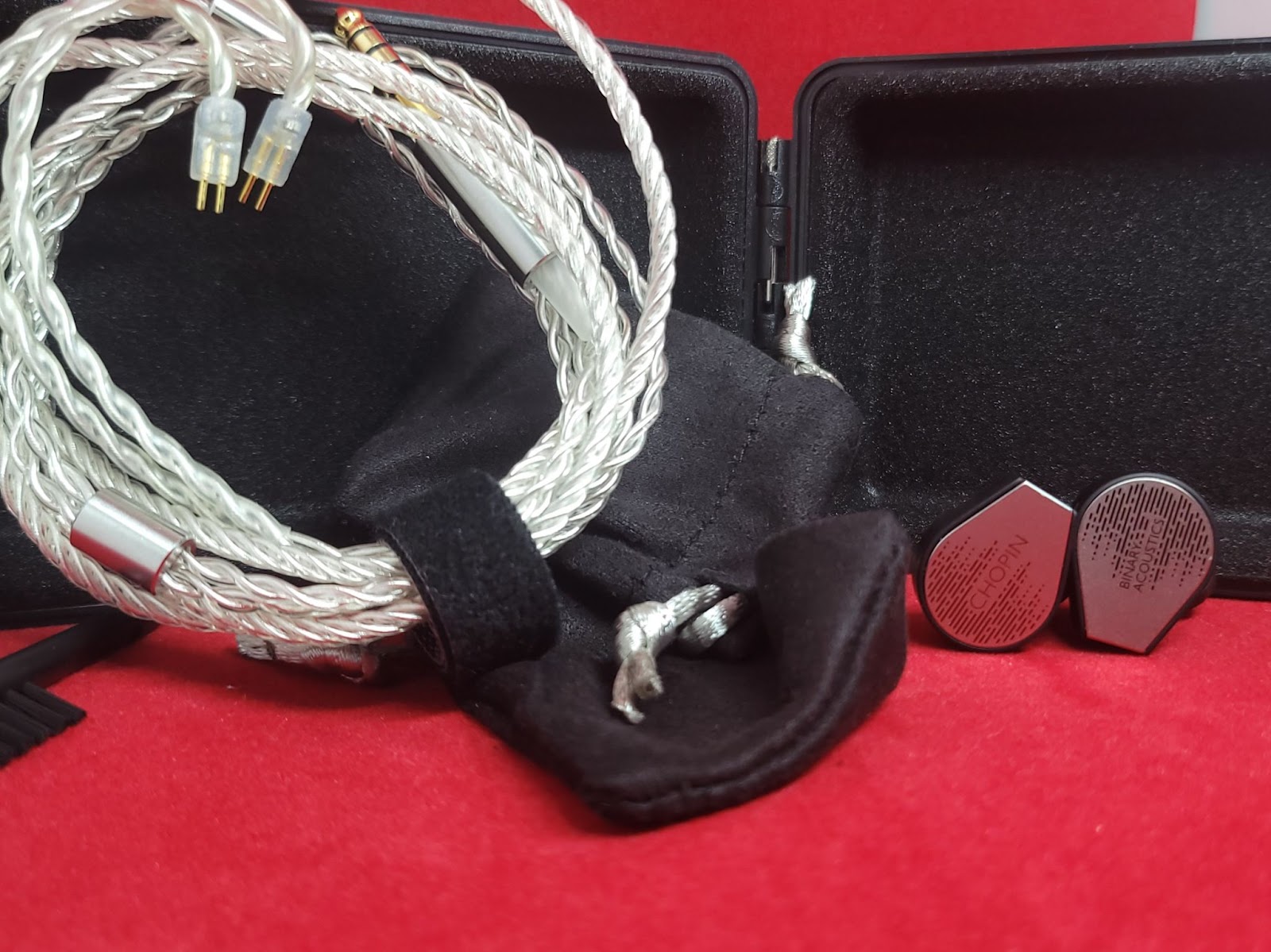
The shells of Chopin are built pretty good. They cut some corners with packaging and accessories but shells are let off the hook it seems. They are built with the same hard resin material with Truthear Hexa and Moondrop Variations, even the color is the same. Faceplates are metal. Shape of the shells is unusual and I was kind of worried about the fit but they actually fit very well even into small ears like mine. If only nozzles were a little narrower too. Yes the nozzles are on the thick side, pretty much the same with Truthear Hexa, Moondrop Variations or LetShuoer DZ4. That said, the angle of the nozzle is very well designed and it provides a nice deep insertion. However, like I said earlier, to get a good seal and comfort I had to roll a lot of tips. Another slight nitpick of mine is that connectors on the shells are too recessed, so some flush 2-pin cables probably won’t fit these.
Chopin pretty much sounds like how the graph shows. So whatever I say here would look like I’m reading the graph. Still I will try to give more context but comparisons below will make you understand much better.
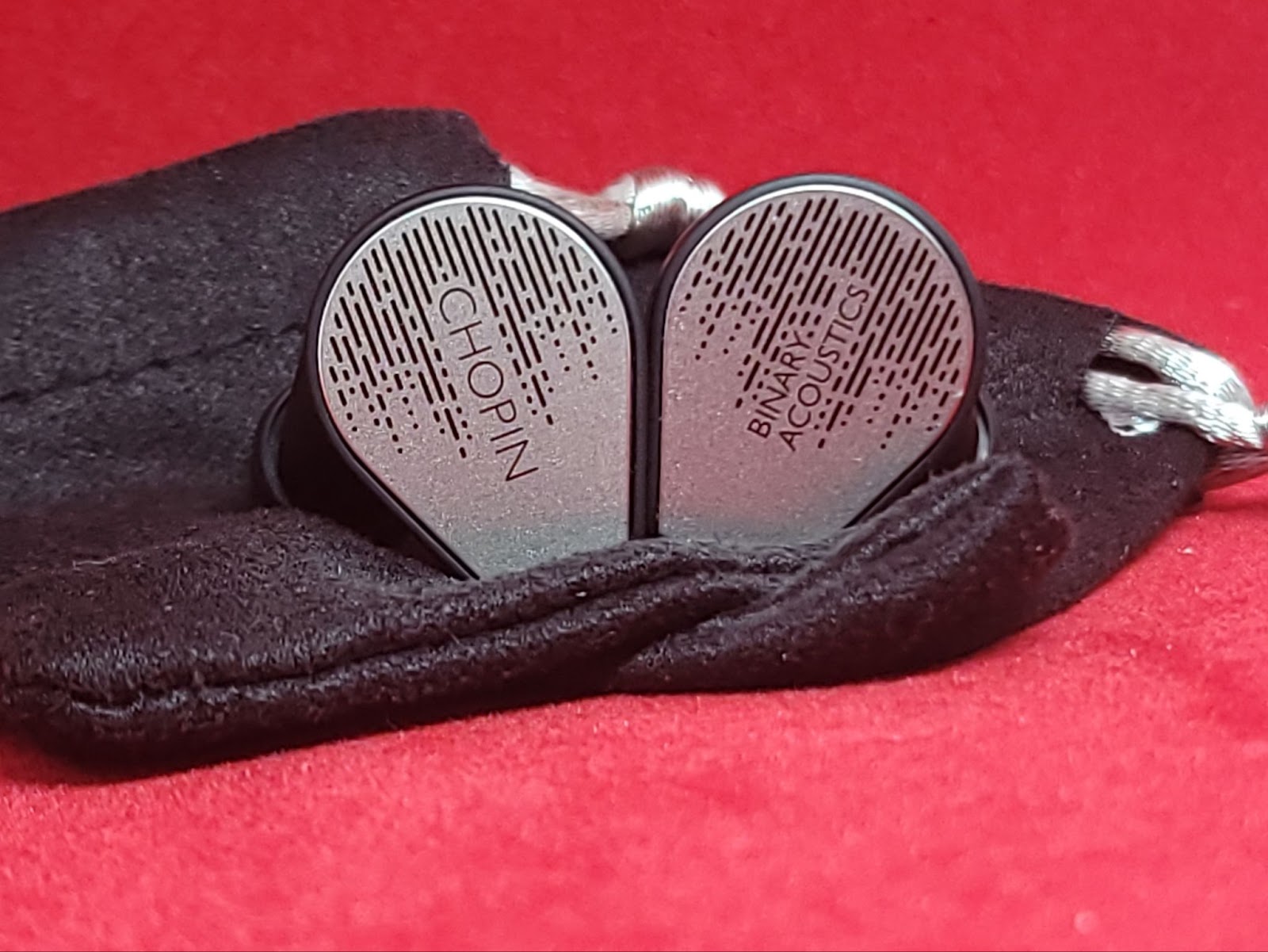
Some of you already know that Timmy likes his female vocals and weeb music, so he probably tuned Chopin to adhere to the Harman target to benefit from its strong points while avoiding its shortcomings. The bass and the lower mids are not excessively lean like other harman tuned iems. It still keeps mids and vocals clean and clear. Lower mids are tucked and this shows itself with a little lack of warmth. Bass guitars sometimes lack energy and can be masked by the drums. Speaking of drums, they have a very good attack. Impact and texture is also great, so much so that it is hard to believe a 8 mm dynamic driver is achieving this.
Mids are very well tuned. Chopin almost never gets shouty or wonky. Vocals pop and they are, as I said earlier, very clean and clear.
Treble is slightly bright but mostly correct. There have been very rare instances where it gets splashy so I wouldn’t call them smooth. Timbre is mostly good but shortcomings of the Balanced Armatures that have been used shows itself from time to time.
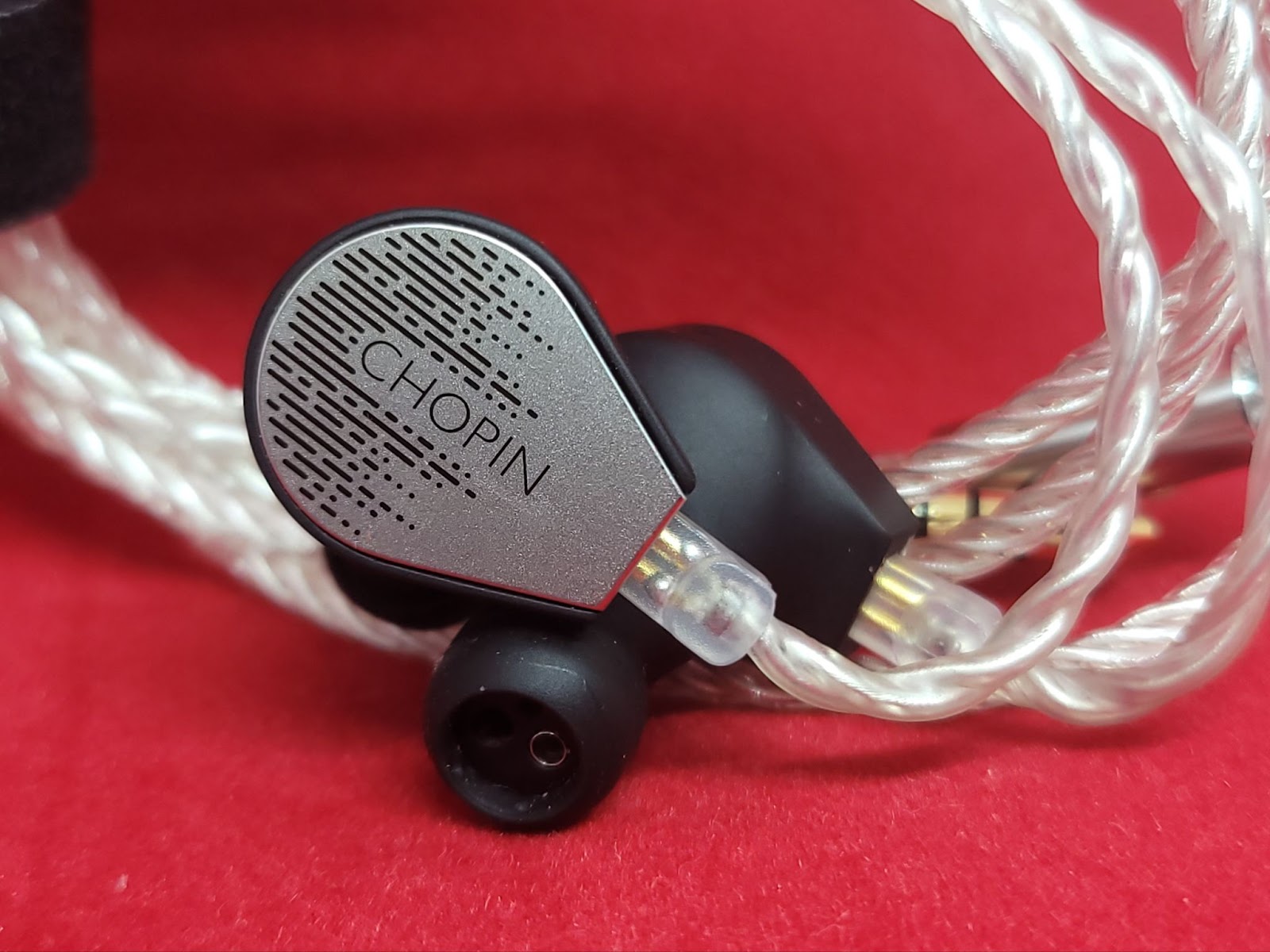
Chopin has good extension in the treble and feels fairly spacious. Tuning lets details to be perceived easily and resolving capability is on par with the asking price.
As soon as people saw the graphs they immediately asked if Chopin was aiming to be a Variations killer so it only made sense to compare them to see how close it gets.
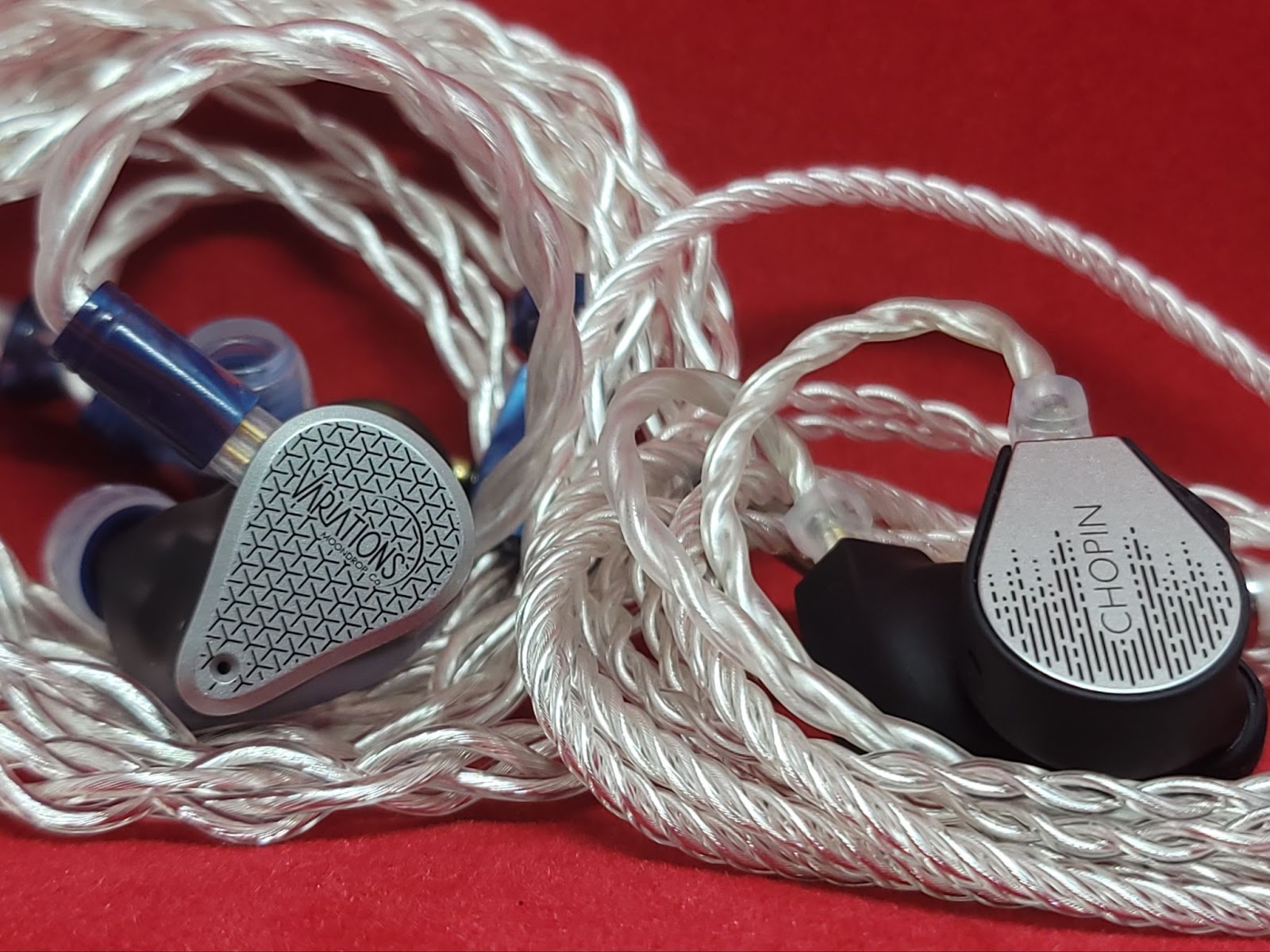
Variations is much clearer, wider, more spacious, more natural and more resolving. It also has much better timbre and imaging. Chopin’s staging and imaging capabilities are still decent.
Chopin hits harder in the bass region but rumbles slightly less.
Chopin is warmer and bass guitars are more prominent in Chopin.
Chopin has a more intimate presentation.
Variations have much better treble, more controlled. Chopin’s treble can get messy and splashy compared to that. It’s not harsh but just loses its composure.
Variations have a more forward presentation in the upper mids. Chopin is slightly less shouty.
In short Chopin is a more exciting, but also a less refined Variations.
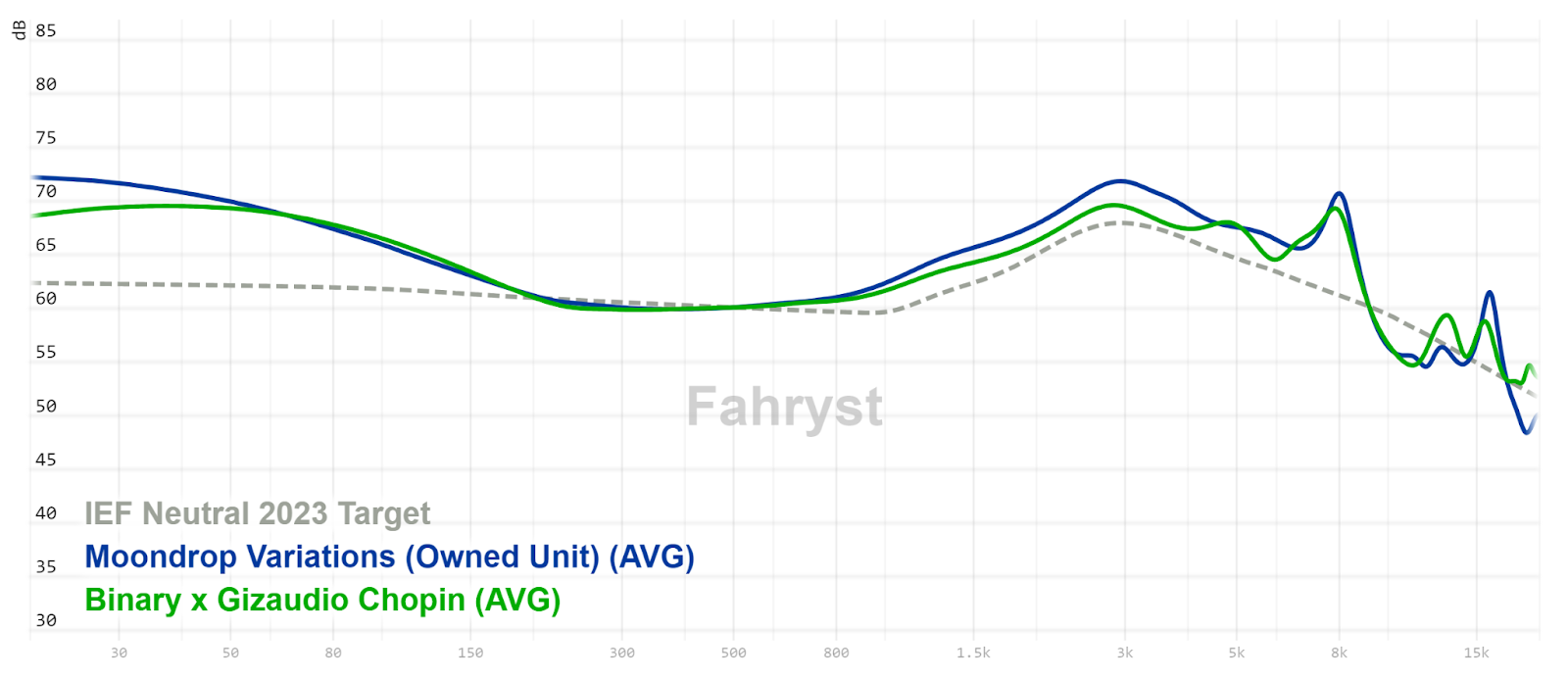
Normalized at 500 Hz
What if you want a totally different tuning for a similar price?
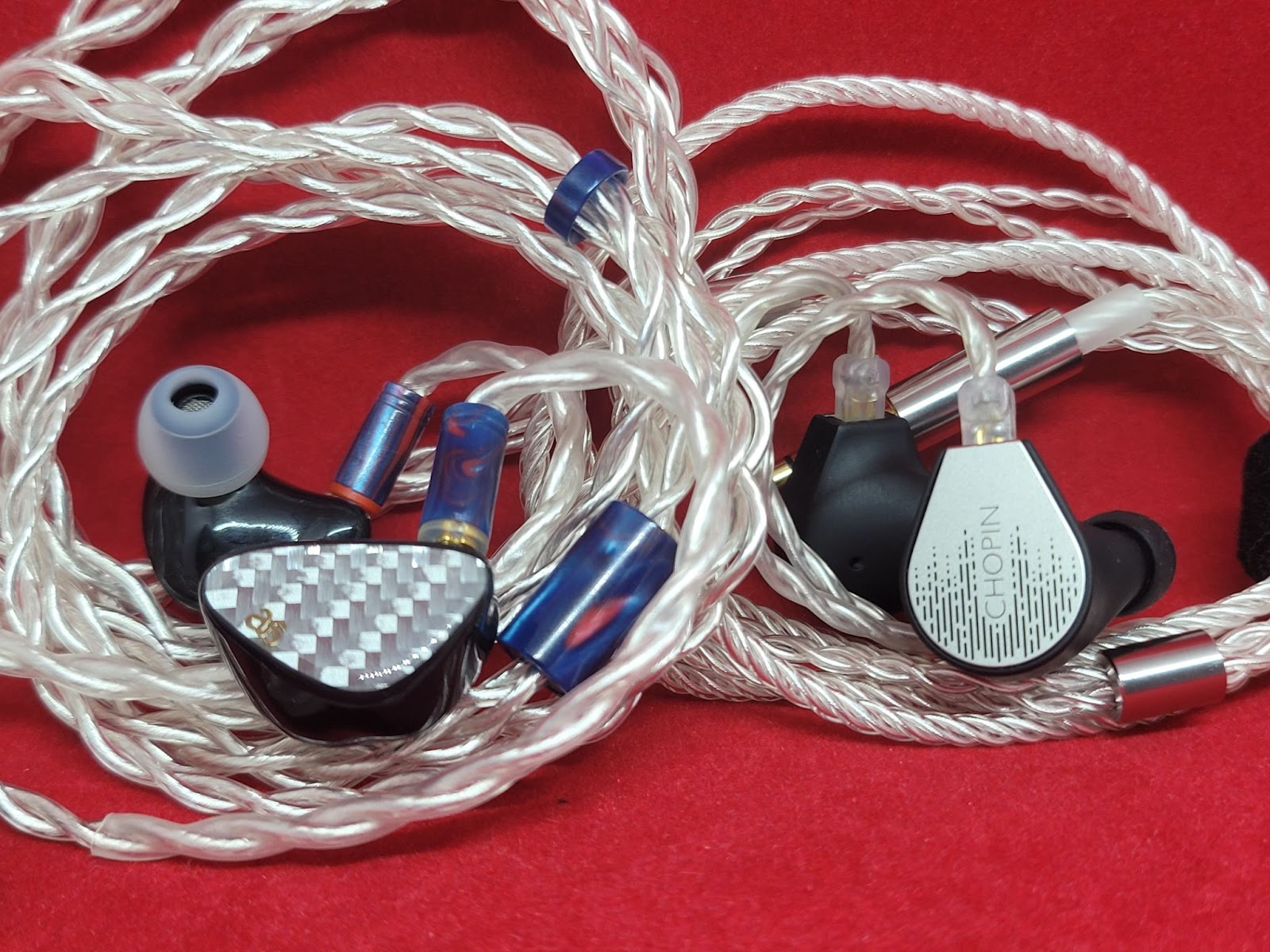
Chopin’s subbass although has decent extension, it is nowhere near the thunderous subbass of AQ4. Apart from the obvious bass and warmth difference, Chopin sounds much cleaner and clearer. Also bass quality seems to be higher on Chopin.
Treble on AQ4 is slightly more polished, Chopin sounds a little more splashy.
Vocals, whether male or female, pop on Chopin. On AQ4, while they have enough presence, they are more in line with the rest of the music. Neither is sibilant or harsh.
Chopin sounds more open and spacious. Imaging and layering is also slightly better on Chopin. Their resolving capabilities are close if AQ4 is not slightly better. However, since Chopin has a more “clean” tuning, it can reveal more details. In AQ4’s case, masking occurs more often than not. AQ4 has a slightly better timbre, Chopin has a more apparent edginess or BA timbre if you will. From what I gathered, AQ4’s balanced armatures are of higher quality but Chopin's dynamic drivers perform better. Still we shouldn’t forget that AQ4’s tuning might be causing extra distortion. So if the bass is EQ’d down, AQ4 might in fact perform better.
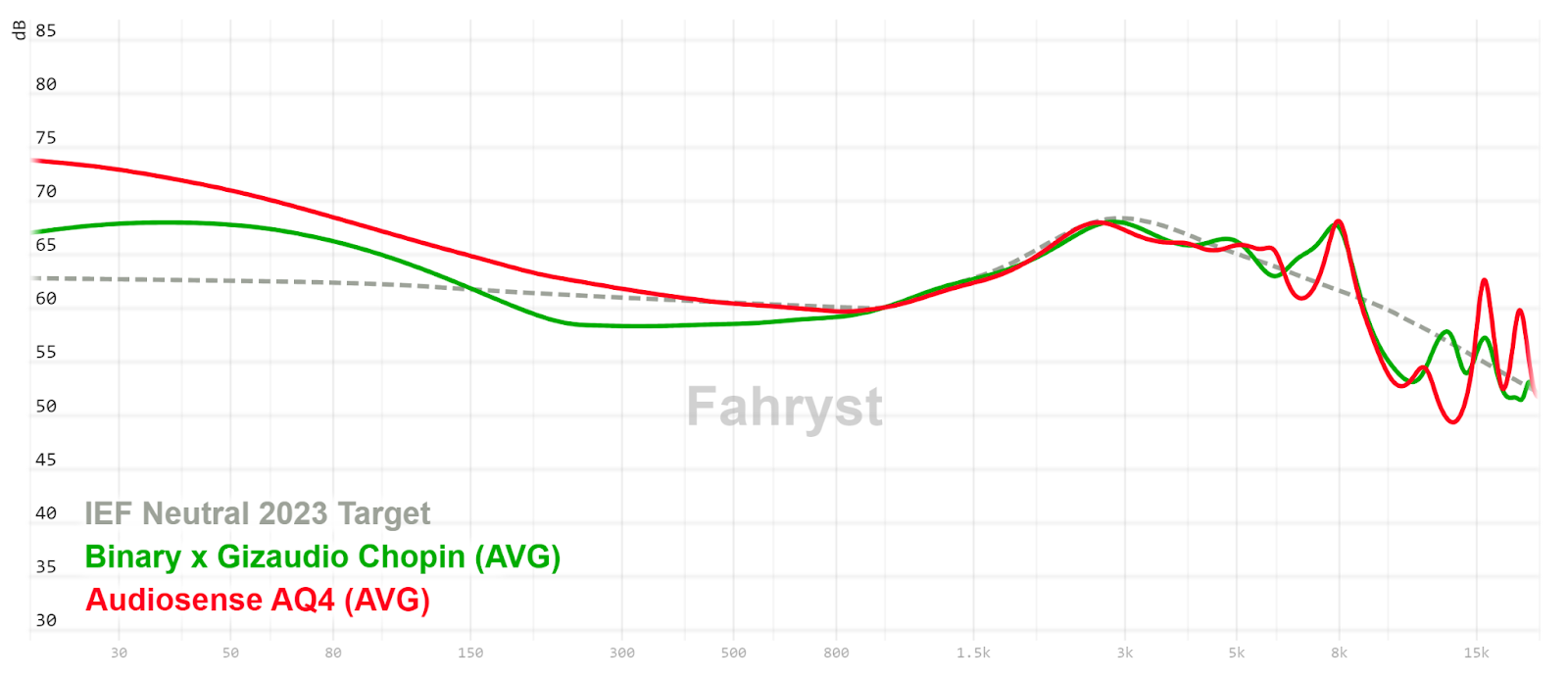
Normalized at 1000 Hz
Timmy and Binary did very good with Chopin. While there are a lot of great iems in the 200 usd price range, I can’t think of any vocal focussed tucked bass one on the top of my head. Below 100 USD you have Crinacle’s Truthear Zero and Zero Red and above 500 USD you have Xenns Top and Moondrop Variations. Could Chopin be cheaper? Considering the balanced armatures’ performance and accessories, probably. Is it an upgrade to the Zeros? Absolutely! Is it a Variations killer? No. So overall, it is a very competitively priced and well performing choice, and if you are looking for a vocal focussed tuning or, you are curious about how sets with tucked bass sounds, probably your only choice.
Priced at 199 USD MSRP, which is very crowded with highly competent iems by the way, the 1+3 hybrid iem Chopin promises a lot, but does it deliver? We will try to find out in this review.
Disclaimers
Binary x Gizaudio Chopin was provided to me by Hifigo with a discount in exchange for a review. As I always say, everyone is biased one way or another so take everything you read with a grain of salt. Also I will try to be more concise and to the point in my reviews from now on without worrying about the word count etc. If you have any questions, please ask me in the comments and I will try to answer them to the best of my abilities.
Build and Accessories of Binary x Gizaudio Chopin
As soon as you open the box, you immediately notice Chopin is a no-frills kind of iem. As Eiji (Zerstorer_GOhren) had called it, utilitarian is the best word to describe their design intention. Box opens upwards in an uncommon way and reveals the case, the accessories and some literature.
When you open the case, you notice the ear pieces are placed in small pouches each, at least they are supposed to, but mine were flying around freely. Fortunately the unimpressive plastic case has some soft foam in it, so the shells weren’t damaged and iems are working fine.
Accessories box is also unimpressive with a set of generic tips, a cleaning brush and a 4.4 mm balanced cable. At first they didn’t have a 3.5 mm single ended choice but now they do so good news.
I have to make a point of two things before I move on to the shell design. My first gripe is the cable, it really is something you would expect from an iem that is below 100 usd. I won’t comment on if or how it affects the sound but I’ve seen much better cables from cheaper iems. But at least I appreciate the offering of a balanced choice. My other and bigger gripe is the tip offerings. Most of the reviewers and pre-orderers get Divinus Velvet Tips with their iems but I didn’t. Probably they have forgotten or something. Why I’m saying this is because until I tried my JVC Spiral Dots, I couldn’t get a good fit. They were either uncomfortable or didn’t seal properly. So in my opinion a suitable aftermarket tip is a must with these. Fortunately if you order now, Chopin comes with Softears UC tips. I don’t have UCs but I have tried similar tips. Unfortunately they weren’t near as good as JVC Spiral Dots for me, so that you know.
The shells of Chopin are built pretty good. They cut some corners with packaging and accessories but shells are let off the hook it seems. They are built with the same hard resin material with Truthear Hexa and Moondrop Variations, even the color is the same. Faceplates are metal. Shape of the shells is unusual and I was kind of worried about the fit but they actually fit very well even into small ears like mine. If only nozzles were a little narrower too. Yes the nozzles are on the thick side, pretty much the same with Truthear Hexa, Moondrop Variations or LetShuoer DZ4. That said, the angle of the nozzle is very well designed and it provides a nice deep insertion. However, like I said earlier, to get a good seal and comfort I had to roll a lot of tips. Another slight nitpick of mine is that connectors on the shells are too recessed, so some flush 2-pin cables probably won’t fit these.
Sound of Binary x Gizaudio Chopin
Tonality
Chopin pretty much sounds like how the graph shows. So whatever I say here would look like I’m reading the graph. Still I will try to give more context but comparisons below will make you understand much better.
Some of you already know that Timmy likes his female vocals and weeb music, so he probably tuned Chopin to adhere to the Harman target to benefit from its strong points while avoiding its shortcomings. The bass and the lower mids are not excessively lean like other harman tuned iems. It still keeps mids and vocals clean and clear. Lower mids are tucked and this shows itself with a little lack of warmth. Bass guitars sometimes lack energy and can be masked by the drums. Speaking of drums, they have a very good attack. Impact and texture is also great, so much so that it is hard to believe a 8 mm dynamic driver is achieving this.
Mids are very well tuned. Chopin almost never gets shouty or wonky. Vocals pop and they are, as I said earlier, very clean and clear.
Treble is slightly bright but mostly correct. There have been very rare instances where it gets splashy so I wouldn’t call them smooth. Timbre is mostly good but shortcomings of the Balanced Armatures that have been used shows itself from time to time.
Technicalities
Chopin has good extension in the treble and feels fairly spacious. Tuning lets details to be perceived easily and resolving capability is on par with the asking price.
Comparisons
Binary x Gizaudio Chopin vs Moondrop Variations
As soon as people saw the graphs they immediately asked if Chopin was aiming to be a Variations killer so it only made sense to compare them to see how close it gets.
Variations is much clearer, wider, more spacious, more natural and more resolving. It also has much better timbre and imaging. Chopin’s staging and imaging capabilities are still decent.
Chopin hits harder in the bass region but rumbles slightly less.
Chopin is warmer and bass guitars are more prominent in Chopin.
Chopin has a more intimate presentation.
Variations have much better treble, more controlled. Chopin’s treble can get messy and splashy compared to that. It’s not harsh but just loses its composure.
Variations have a more forward presentation in the upper mids. Chopin is slightly less shouty.
In short Chopin is a more exciting, but also a less refined Variations.
Normalized at 500 Hz
Binary x Gizaudio Chopin vs Audiosense AQ4
What if you want a totally different tuning for a similar price?
Chopin’s subbass although has decent extension, it is nowhere near the thunderous subbass of AQ4. Apart from the obvious bass and warmth difference, Chopin sounds much cleaner and clearer. Also bass quality seems to be higher on Chopin.
Treble on AQ4 is slightly more polished, Chopin sounds a little more splashy.
Vocals, whether male or female, pop on Chopin. On AQ4, while they have enough presence, they are more in line with the rest of the music. Neither is sibilant or harsh.
Chopin sounds more open and spacious. Imaging and layering is also slightly better on Chopin. Their resolving capabilities are close if AQ4 is not slightly better. However, since Chopin has a more “clean” tuning, it can reveal more details. In AQ4’s case, masking occurs more often than not. AQ4 has a slightly better timbre, Chopin has a more apparent edginess or BA timbre if you will. From what I gathered, AQ4’s balanced armatures are of higher quality but Chopin's dynamic drivers perform better. Still we shouldn’t forget that AQ4’s tuning might be causing extra distortion. So if the bass is EQ’d down, AQ4 might in fact perform better.
Normalized at 1000 Hz
Conclusion
Timmy and Binary did very good with Chopin. While there are a lot of great iems in the 200 usd price range, I can’t think of any vocal focussed tucked bass one on the top of my head. Below 100 USD you have Crinacle’s Truthear Zero and Zero Red and above 500 USD you have Xenns Top and Moondrop Variations. Could Chopin be cheaper? Considering the balanced armatures’ performance and accessories, probably. Is it an upgrade to the Zeros? Absolutely! Is it a Variations killer? No. So overall, it is a very competitively priced and well performing choice, and if you are looking for a vocal focussed tuning or, you are curious about how sets with tucked bass sounds, probably your only choice.
Jarlaxle
100+ Head-Fier
Pros: Great Gaming Performance with good imaging and microphone
Mid centric balanced tuning
Decent technicalities
Pseudo-custom resin shells
Mid centric balanced tuning
Decent technicalities
Pseudo-custom resin shells
Cons: Shells are unfortunately not one size fits all
Not even a carrying pouch is included, just a zip-lock bag if you are keen on using that
Might get shouty depending on the volume or the song
Bass and lower mids are not at a satisfying level for every music genre.
Not even a carrying pouch is included, just a zip-lock bag if you are keen on using that
Might get shouty depending on the volume or the song
Bass and lower mids are not at a satisfying level for every music genre.
Kinera’s Celest branch has arguably the most successful line of products among all of the Kinera brands in my personal opinion. For those who don’t know, Celest aims at younger audio enthusiasts and releases budget conscious no frills products unlike Kinera or QoA which also pays great attention to design and packaging.
I have reviewed their cable with boom microphone; Ruyi, that converts any iem into a gaming/communicating one earlier and praised it for its performance. Now Celest did it again and for the same price of $29 MSRP for the Pro version ($25 for the regular version which doesn’t have the boom mic attachment), they released not only the cable but a gaming iem with a detachable boom mic. But did it make Ruyi irrelevant? Let’s find out!
Disclaimers
Celest Wyvern Pro was provided to me by Kinera for review. As I always say, everyone is biased one way or another so take everything you read with a grain of salt. Also I will try to be more concise and to the point in my reviews from now on without worrying about the word count etc. If you have any questions, feel free to ask me in the comments and I will try to answer them to the best of my abilities.
Build and Accessories of Celest Wyvern Pro
Celest Wyvern comes in a simple package which does not impress. When you open the box, a plastic wyvern plate accessory and a boom mic greets you. The Wyvern plate looks nice but serves no purpose. You can’t even make a keychain out of it, well you could manage if you tried but it isn’t really a keychain.
When you remove that cover, you find the earpieces, two sets of nice eartips, a pair of pop filters for boom mic and the cable with an inline microphone; yes you read that right. My guess is if you buy the regular version you get the same cable and can still use it for gaming and communications. It’s just you can’t benefit from the advantages of the boom mic which I’ll dwell on later. Cable’s length is, just like Ruyi, 1.5 m which is more suited for desktop gaming but not necessarily for mobile use.
Earpieces look very pretty with their jade green tinted milky white resin shells. Faceplates are plain but don’t look too bad. They are shaped to follow an average ear concha’s contours. You can also call them pseudo custom if you will. Unfortunately they hurt my ears. But the fault lies with my weirdly shaped and small ears. To be certain, I asked some of my friends and even had my brother put them in his ears and without exception they all said they were very comfortable. So if you don’t suffer from ears like mine, you won’t have any problems with their comfort. For my testing I had to give up on deep insertion.
Sound of Celest Wyvern
Gaming Performance
When I first saw Celest Wyvern’s graph, I was immediately reminded of Epos gaming headsets. Some of you may know, they are tuned to have high upper mids to emphasize footstep noises and great at positional cues because of that diffuse field-like sound signature.
I tested Wyvern on a ranked Apex Legends session with my brother. Most of you may know that in Apex Legends, you need to be careful not to get ambushed and ambush other engaged enemies whenever you can. At one point I heard a group of enemies from the other side of the wall. I warned my brother several times until they came closer for him to hear too. And mind you he was using my Epos H6Pro which is considered one of the best gaming headsets. Other than this I had no problem pinpointing enemies’ positions.
Celest Wyvern Pro’s boom mic also surprised me in a very good way. It sounds very clear and fairly neutral. I was expecting the microphone to be identical to Celest Ruyi’s, however it sounded even clearer. Compared to Wyvern Pro, Ruyi’s mic sounds bassier and chestier so if you like that tone in your microphone, there is that. What Ruyi offers that Wyvern Pro cable doesn’t is remote controls for volume etc. I also compared Wyvern Pro boom mic to Behringer BC12 and Epos H6Pro’s mic. Behringer sounded more nasally. Only H6Pro’s mic was clearer to no one's surprise since it is one of the best headset microphones out there. It was also much louder so you might want to keep that in mind. I also tried the inline microphone briefly. It sounded clear enough but much more muffled than the boom mic and lost volume as soon as I placed it far away from my mouth. So it is perfectly fine for calls but, for gaming I suggest using the boom mic, which disables inline mic as soon as you connect it to the cable.
Music Performance
Tonality
Celest Wyvern is a gaming iem first and foremost which happens to be great at music listening too. It has a mid centric tonality which is pretty well handled. Tonal balance is fairly neutral. Slightly boosted bass is on point for gaming with enough impact and rumble. I’m not sure if it should be attributed to LCP diaphragm or the tuning but the bass is tight and pretty well textured. However the amount of the bass might not be enough for rap, RnB or modern pop music. Wyvern’s treble is very good for its price with good extension and just enough sparkle. Because of their mid forwardness, they get shouty before you are hit with any sibilance or harshness.
Technicalities
Budget single DD iems don’t really excel at technicalities, that’s for sure. However Wyvern is as good as it gets. It feels fairly airy and spacious. Details and imaging is very good as I described at the gaming performance section. Timbre is again very good for the price.
Comparisons
Gaming iems are not really common yet but they are actually more or less regular iems with microphones. So I decided to compare them to other well regarded budget iems.
Kinera Celest Wyvern Pro vs Tangzu Wan’er S.G
Wan’er has more bass quantity. It is also more thumpy but looser in the bass. Compared to that, Wyvern is tighter. Bass guitars on Wan’er are more satisfying.
Wan’er is slightly shoutier than Wyvern. Lower mids are also more pronounced on Wan’er; male vocals have more body and authority. Neither is sibilant but as you raise the volume or if the song is recorded sibilant, wan’er shows it earlier. Lower treble is again more forward on Wan’er so it can get fatiguing earlier, maybe.
Overall wan’er sounds richer but Wyvern sounds cleaner and clearer.
Wyvern extends better in the treble and feels airier, therefore it is wider and more spacious. Wan’er, on the other hand, is more intimate if you like that kind of presentation.
Both of the iems perform similarly in terms of imaging and layering. But wyvern is a little bit more detailed.
Kinera Celest Wyvern Pro vs. 7hz Salnotes Zero
Bass is slightly more powerful and better textured on Wyvern. Zero feels like it extends into the subass slightly better, but it may also be due to a slight error in volume matching
Mid frequencies are more pronounced on Wyvern so both male and female vocals are more intimate and highlighted compared to Zero.
Zero is brighter, it is not offensive or harsh for me but it might be too much for treble sensitive people. Wyvern’s treble is on point.
Zero has more sparkle and sounds slightly more detailed. Timbre is better on Wyvern. Zero sounds slightly more plasticky compared to Wyvern. Their staging capabilities are similar but Zero’s imaging might be slightly sharper.
I can confidently say that Wyvern is tonally and technically placed just in between Wan’er and Zero.
Conclusion
Budget range in iems is more competitive than ever and choice is depending more and more to the preference and who offers more for the same price. In the case of Wyvern Pro, it offers a great boom microphone, very comfortable pseudo-custom molded resin shells and an as good tuning and technicalities as its competitors, if not better just for $29. You can find them even cheaper if you follow the deals on Aliexpress and other retailers. If only they fit my ears better too.
Jarlaxle
100+ Head-Fier
Pros: Highly technical
Great build quality
"Luxurious" pouch
Fairly comfortable
Nice cable
Tuning options
Great build quality
"Luxurious" pouch
Fairly comfortable
Nice cable
Tuning options
Cons: Recessed mids (subjective)
Somewhat loose bass
Isn't very suitable for loud volume listeners since they can get edgy
Potential noise floor (due to high sensitivity)
Somewhat loose bass
Isn't very suitable for loud volume listeners since they can get edgy
Potential noise floor (due to high sensitivity)
Hidizs is one of the better established audio companies from China. Their DAPs, portable DACs and amplifiers are highly popular. They also had several IEMs earlier, which unfortunately I have never tried but, lately they have been storming the market with release after release.
Hidizs MS3 has been out for months now and this review was supposed to be released much earlier but the first unit I got had a slight problem. After I contacted Hidizs, they sent me another unit after I sent the first one back, so I’m kind of late to the party.

MS3 is Hidizs' last hybrid, but they have released two other IEMs since then. It has a 1 dynamic driver and 2 Knowles balanced armatures configuration and 3 tuning options. The MSRP for them is $169 but it can be bought for $119 from several places.
Hidizs MS3 was provided to me by Hidizs for review. As I always say, everyone is biased one way or another so take everything you read with a grain of salt. Also I will try to be more concise and to the point in my reviews from now on without worrying about the word count etc. If you have any questions, please ask me in the comments and I will try to answer them to the best of my abilities.
The MS3 has a metal shell and faceplate. It looks very similar to their own MS5 but this time the finish is matte rather than glossy which I prefer. Also it doesn’t have the same openings on the faceplate. Shells are not very big and they fit comfortably in my ears. I mostly despise multi driver IEMs with huge shells but MS3 is not one of them. They feel pretty hefty but not overly heavy.

As I mentioned earlier Hidizs MS3 has 3 different tuning options and they can be changed by replacing nozzle filters. When you remove the nozzle you can see one of the balanced armatures is situated in the nozzle. I don’t have any particular opinion about it but some people think it is a bad idea, so that you know.
Apart from their usual three sets of silicone tips, they come with a rather thick cable terminating with either 3.5 mm single ended or 4.4 mm balanced. I especially loved the angle of the earhook, it is neither too aggressive nor too loose. Your mileage may vary of course. Lastly the Hidizs provides a leather pouch rather than a case. Some people prefer cases but I like pouches better since they are more pocketable and believe me in Hidizs’ case, it is not some cheap drawstring pouch. It has a very strong metal spring mechanism that closes as soon as you stop applying pressure. I love it!
They are very sensitive to drive so you don’t need anything powerful for the MS3 but they can also reveal the noise floor of your source so you might want to use something decent to listen to these.
The MS3 has a V-Shaped sound signature with noticeably recessed mids. Before I received the unit, their representative said they are going for a highly technical house sound and I can attest to that. Semblance to their earlier MS5 is very apparent. I only tried the MS5 for a short period of time but from what I can remember, MS3 is much more balanced. In a vacuum, you wouldn’t easily notice anything wrong with it although it is not one of the most natural sounding IEMs.
With rose gold balanced filters, the MS3 has a prominent but somewhat loose bass and some bleed into the mids. It has good extension and decent rumble in the subbass. Because of the bass bleed, lower mids are rather warm and overall IEMs have a thick note weight.
Mids are recessed like I mentioned earlier. You probably wouldn’t have any problem with rock and metal but for vocals and songs with acoustic passages you might find yourself raising the volume only to lower later on the same song’s more lively part. To be honest I’m not a big fan of this.
The MS3 has a lively treble. There are lots of sparkles, lots of nuances and details. It is not harsh per se, but there is not much headroom for pushing the volume more or it can get sibilant and piercing easily. I’m mostly a low volume listener so I didn’t really have much problem.
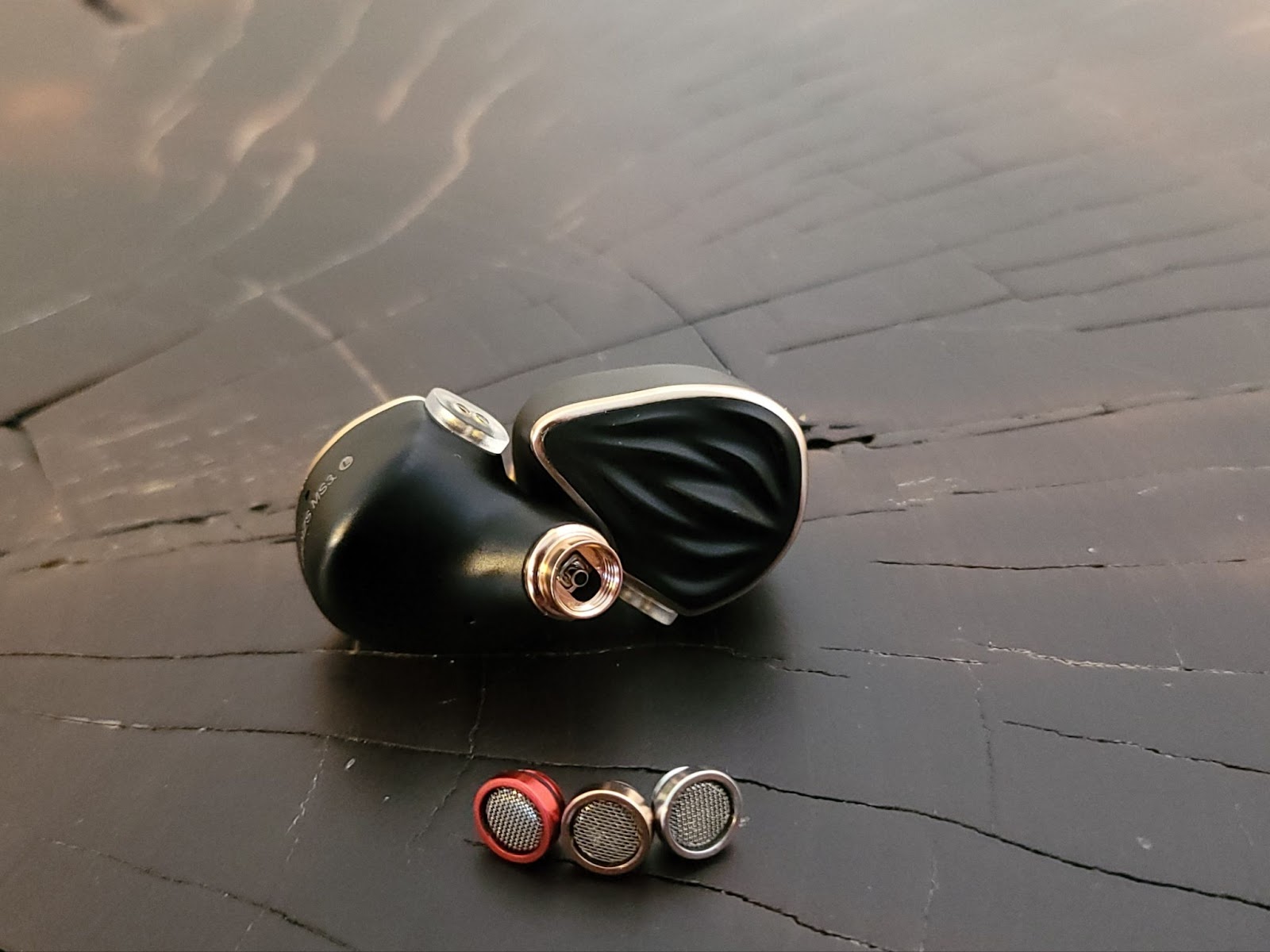
With red bass filters, tonality becomes a little more tame. On the other hand, the already loose bass goes out of control and it does more harm than good. Upper mids also backs down so if you have any problem with shoutyness, not that they are shouty to begin with, you might prefer these filters. However it doesn’t do much to the treble so any sibilance and harshness that appear on the other filters remains on bass filters as well.
The silver treble filters are pretty similar to the balanced ones. It increases the technical capability of the IEMs a little but they might get harsh even if they weren’t with balanced filters.
As I stated earlier, Hidizs MS3 is a highly resolving and very detailed IEM. The quality of the balanced armature drivers really shows itself. They sound fairly spacious. Also the imaging and the layering of the different sounds are both very good. Timbre is mostly fine, just not the best out there. More on that in the Comparisons part.
Comparisons
I used rose gold balanced filters on MS3 in comparisons and volume matched the IEMs I compared at 500 Hz both since sound signatures are vastly different, it yielded an interesting result which I will explain later.
Xinhs HS3 is also another 1+2 IEM that is similarly priced with MS3. It is tuned by another fellow reviewer Akros, who also had his own version: Erasmus at some point. I reviewed Erasmus earlier and thought it would be a fair comparison although sound signatures are significantly different.

Xinhs HS3 is more relaxed and easier to listen to. Compared to that, MS3 is more engaging and emotional. MS3 sounds clearer and more detailed. MS3 is more sparkly and airy but also more aggressive and can get sibilant. HS3 has no sibilance whatsoever.
HS3 has a tighter bass that is although less prominent, hits harder. MS3 is warmer, thicker but also feels wetter and looser. MS3 also rumbles more but it can be caused by the looseness of the bass generally.
Both male and female vocals are more distant and kind of muffled on HS3. On MS3 they are closer and also clearer. Male vocals are chestier and female vocals are livelier on MS3.
Bass guitars don't sound satisfying on Xinhs, on MS3 they sound much better. Xinhs is more suitable for loud listening, MS3 isn’t.

Mids are recessed on MS3. HS3 is much more balanced and sounds more neutral. If you raise the volume on Xinhs, like you volume matched at 2 KHz for example, it scales very well and closes the gap I mentioned above. So overall MS3 is much more lively and dynamic but HS3 is more neutral and natural.
Timbre is better on Xinhs, though in a vacuum MS3 timbre is not that bad. MS3 is much more spacious. Imaging and layering is also better on MS3.
Hexa feels like it is reaching deeper into the subbass and rumbles more but again MS3 feels looser and has a little more reverb I think. Hexa’s bass is tighter and more satisfying. MS3’s bass looser, so it bleeds and warms up the lower mids.

Hexa’s mids closer to what I perceive as neutral therefore feels more natural. MS3’s mids are noticeably recessed.
Vocals are mostly closer on Hexa. But they don’t sound particularly clearer because of the darker tonality.
Treble is much more prominent on MS3 and it gets sibilant very easily. Hexa doesn't have any issues when it comes to sibilance but it leaves much to be desired when it comes to lively presentation. You can say it has a more relaxed tonality.
I don’t like the treble on Hexa, I can’t really put my finger on it but it sounds wonky and kind of blunted. Although MS3’s treble is more aggressive, it sounds more satisfying. It is lively, sparkly and “edgy”.
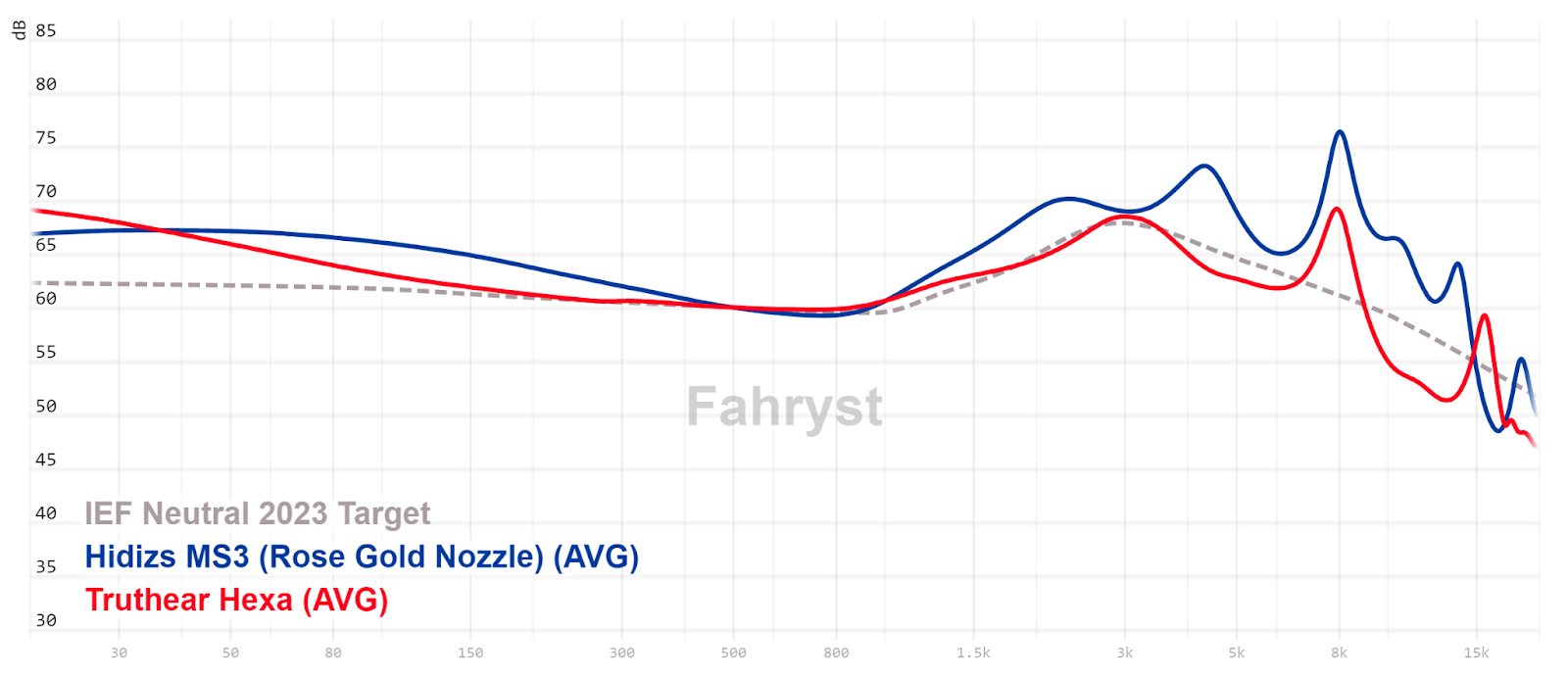
MS3 is technically much more capable than Hexa. Timbre is mostly better on Hexa except cymbals and high-hats. MS3 is more resolving and detailed. It also feels more spacious and extends wider and deeper. Imaging and layering is also better on MS3 and it handles complex passages better.
Hidizs MS3 is a “technicalities first” kind of IEM. Although I’m not particularly a fan of this kind of tuning, I’m not bothered by it either. By itself it gave me a satisfying experience and showed its shortcomings only when I compared it to other IEMs. I don't like having to give things a score but for better context, If I had to give a score to the MS3 I’d give the tuning 3 stars and technicalities 5 stars, especially for the price. If you want to have a taste of what you can get at a higher price point you can try Hidizs MS3.
Hidizs MS3 has been out for months now and this review was supposed to be released much earlier but the first unit I got had a slight problem. After I contacted Hidizs, they sent me another unit after I sent the first one back, so I’m kind of late to the party.
MS3 is Hidizs' last hybrid, but they have released two other IEMs since then. It has a 1 dynamic driver and 2 Knowles balanced armatures configuration and 3 tuning options. The MSRP for them is $169 but it can be bought for $119 from several places.
Disclaimers
Hidizs MS3 was provided to me by Hidizs for review. As I always say, everyone is biased one way or another so take everything you read with a grain of salt. Also I will try to be more concise and to the point in my reviews from now on without worrying about the word count etc. If you have any questions, please ask me in the comments and I will try to answer them to the best of my abilities.
Build and Accessories of Hidizs MS3
The MS3 has a metal shell and faceplate. It looks very similar to their own MS5 but this time the finish is matte rather than glossy which I prefer. Also it doesn’t have the same openings on the faceplate. Shells are not very big and they fit comfortably in my ears. I mostly despise multi driver IEMs with huge shells but MS3 is not one of them. They feel pretty hefty but not overly heavy.
As I mentioned earlier Hidizs MS3 has 3 different tuning options and they can be changed by replacing nozzle filters. When you remove the nozzle you can see one of the balanced armatures is situated in the nozzle. I don’t have any particular opinion about it but some people think it is a bad idea, so that you know.
Apart from their usual three sets of silicone tips, they come with a rather thick cable terminating with either 3.5 mm single ended or 4.4 mm balanced. I especially loved the angle of the earhook, it is neither too aggressive nor too loose. Your mileage may vary of course. Lastly the Hidizs provides a leather pouch rather than a case. Some people prefer cases but I like pouches better since they are more pocketable and believe me in Hidizs’ case, it is not some cheap drawstring pouch. It has a very strong metal spring mechanism that closes as soon as you stop applying pressure. I love it!
They are very sensitive to drive so you don’t need anything powerful for the MS3 but they can also reveal the noise floor of your source so you might want to use something decent to listen to these.
Sound of Hidizs MS3
Tonality
The MS3 has a V-Shaped sound signature with noticeably recessed mids. Before I received the unit, their representative said they are going for a highly technical house sound and I can attest to that. Semblance to their earlier MS5 is very apparent. I only tried the MS5 for a short period of time but from what I can remember, MS3 is much more balanced. In a vacuum, you wouldn’t easily notice anything wrong with it although it is not one of the most natural sounding IEMs.
With rose gold balanced filters, the MS3 has a prominent but somewhat loose bass and some bleed into the mids. It has good extension and decent rumble in the subbass. Because of the bass bleed, lower mids are rather warm and overall IEMs have a thick note weight.
Mids are recessed like I mentioned earlier. You probably wouldn’t have any problem with rock and metal but for vocals and songs with acoustic passages you might find yourself raising the volume only to lower later on the same song’s more lively part. To be honest I’m not a big fan of this.
The MS3 has a lively treble. There are lots of sparkles, lots of nuances and details. It is not harsh per se, but there is not much headroom for pushing the volume more or it can get sibilant and piercing easily. I’m mostly a low volume listener so I didn’t really have much problem.
With red bass filters, tonality becomes a little more tame. On the other hand, the already loose bass goes out of control and it does more harm than good. Upper mids also backs down so if you have any problem with shoutyness, not that they are shouty to begin with, you might prefer these filters. However it doesn’t do much to the treble so any sibilance and harshness that appear on the other filters remains on bass filters as well.
The silver treble filters are pretty similar to the balanced ones. It increases the technical capability of the IEMs a little but they might get harsh even if they weren’t with balanced filters.
Technicalities
As I stated earlier, Hidizs MS3 is a highly resolving and very detailed IEM. The quality of the balanced armature drivers really shows itself. They sound fairly spacious. Also the imaging and the layering of the different sounds are both very good. Timbre is mostly fine, just not the best out there. More on that in the Comparisons part.
Comparisons
I used rose gold balanced filters on MS3 in comparisons and volume matched the IEMs I compared at 500 Hz both since sound signatures are vastly different, it yielded an interesting result which I will explain later.
Hidizs MS3 vs. Xinhs HS3
Xinhs HS3 is also another 1+2 IEM that is similarly priced with MS3. It is tuned by another fellow reviewer Akros, who also had his own version: Erasmus at some point. I reviewed Erasmus earlier and thought it would be a fair comparison although sound signatures are significantly different.
Xinhs HS3 is more relaxed and easier to listen to. Compared to that, MS3 is more engaging and emotional. MS3 sounds clearer and more detailed. MS3 is more sparkly and airy but also more aggressive and can get sibilant. HS3 has no sibilance whatsoever.
HS3 has a tighter bass that is although less prominent, hits harder. MS3 is warmer, thicker but also feels wetter and looser. MS3 also rumbles more but it can be caused by the looseness of the bass generally.
Both male and female vocals are more distant and kind of muffled on HS3. On MS3 they are closer and also clearer. Male vocals are chestier and female vocals are livelier on MS3.
Bass guitars don't sound satisfying on Xinhs, on MS3 they sound much better. Xinhs is more suitable for loud listening, MS3 isn’t.
Mids are recessed on MS3. HS3 is much more balanced and sounds more neutral. If you raise the volume on Xinhs, like you volume matched at 2 KHz for example, it scales very well and closes the gap I mentioned above. So overall MS3 is much more lively and dynamic but HS3 is more neutral and natural.
Timbre is better on Xinhs, though in a vacuum MS3 timbre is not that bad. MS3 is much more spacious. Imaging and layering is also better on MS3.
Hidizs MS3 vs. Truthear Hexa
Hexa feels like it is reaching deeper into the subbass and rumbles more but again MS3 feels looser and has a little more reverb I think. Hexa’s bass is tighter and more satisfying. MS3’s bass looser, so it bleeds and warms up the lower mids.
Hexa’s mids closer to what I perceive as neutral therefore feels more natural. MS3’s mids are noticeably recessed.
Vocals are mostly closer on Hexa. But they don’t sound particularly clearer because of the darker tonality.
Treble is much more prominent on MS3 and it gets sibilant very easily. Hexa doesn't have any issues when it comes to sibilance but it leaves much to be desired when it comes to lively presentation. You can say it has a more relaxed tonality.
I don’t like the treble on Hexa, I can’t really put my finger on it but it sounds wonky and kind of blunted. Although MS3’s treble is more aggressive, it sounds more satisfying. It is lively, sparkly and “edgy”.
MS3 is technically much more capable than Hexa. Timbre is mostly better on Hexa except cymbals and high-hats. MS3 is more resolving and detailed. It also feels more spacious and extends wider and deeper. Imaging and layering is also better on MS3 and it handles complex passages better.
Conclusions
Hidizs MS3 is a “technicalities first” kind of IEM. Although I’m not particularly a fan of this kind of tuning, I’m not bothered by it either. By itself it gave me a satisfying experience and showed its shortcomings only when I compared it to other IEMs. I don't like having to give things a score but for better context, If I had to give a score to the MS3 I’d give the tuning 3 stars and technicalities 5 stars, especially for the price. If you want to have a taste of what you can get at a higher price point you can try Hidizs MS3.
Last edited:
Jarlaxle
100+ Head-Fier
Pros: Great build and comfort
Premium packaging
Very balanced tuning
Pretty good technicalities
Premium packaging
Very balanced tuning
Pretty good technicalities
Cons: MMCX Connectors (Subjective)
A little dry and dull timbre
Questionable design choice
A little dry and dull timbre
Questionable design choice
EPZ Q5 is the brand's newest IEM that is aimed at the budget market. As far as I know it is only sold on Aliexpress and the price is not constant. However for convenience’s sake I will say it is a 50 usd IEM which is very competitive.
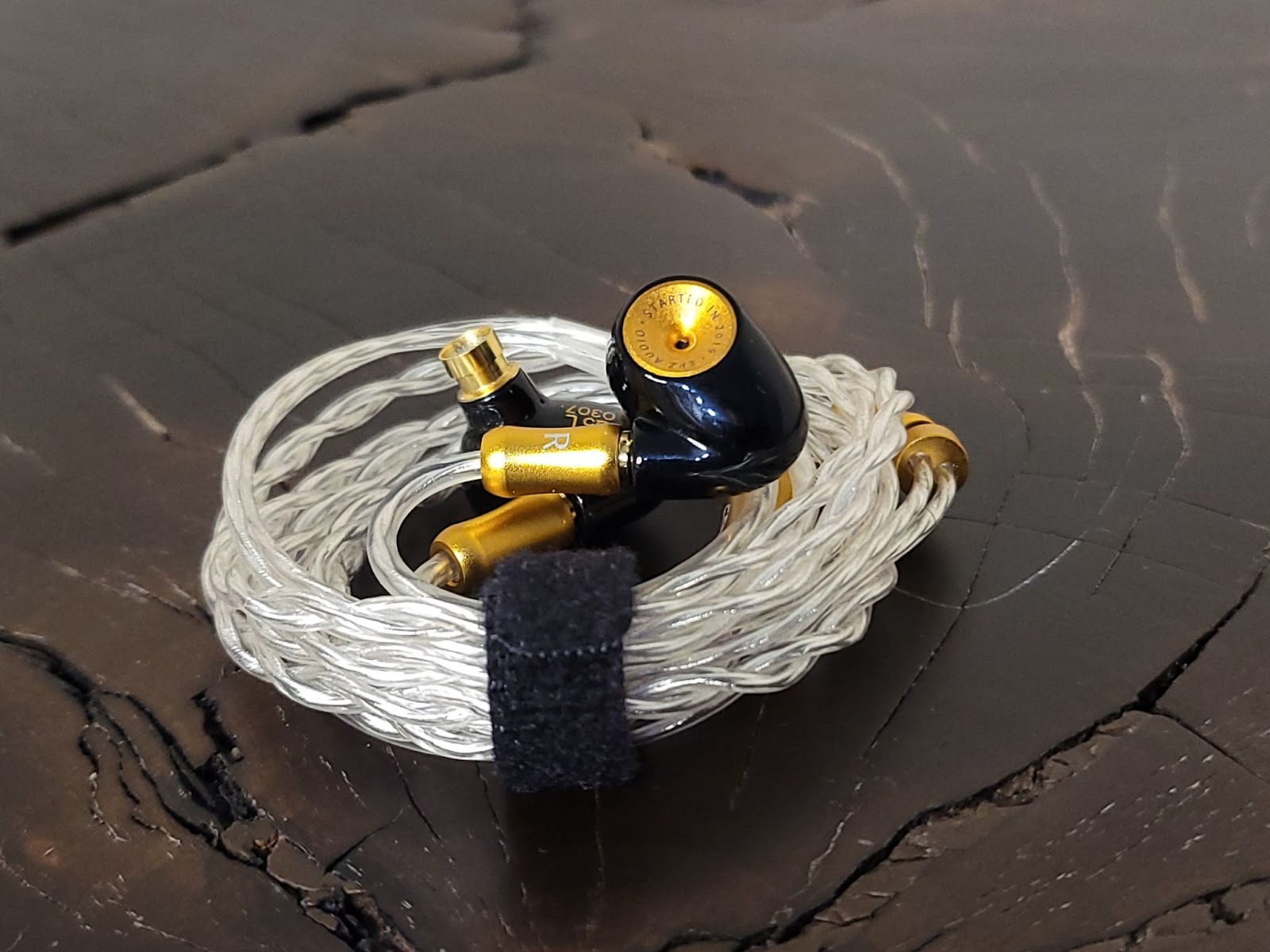
EPZ is not a new brand but it looks like they are getting noticed by more and more people recently. Earlier I reviewed their 1+4 Hybrid K5 and acknowledged what they did with it. It was well built and accessorized. In that sense Q5 is no different.
When Q5 first came into the daylight, it was mocked by the community for plagiarizing Meze’s design of Advar and rightfully so. Even the packaging is similar. Well, actually Q5’s box has a gimmick that Advar’s doesn’t have so it comes out on top! Instead of a lid, it splits open and you are greeted with the IEMs. To be honest I don’t think anyone would expect such a presentation from a 50 IEM!

Gimmicks aside, you are provided with 2 sets of decent eartips, a nice 3.5 mm SPC cable that is in line with IEMs’ design, an eva carrying case, a cloth for wiping IEMs and some literature. IEMs are made out of 3D printed resin. They are very small, light and comfortable for my ears and believe me most of the IEMs aren’t. On that note, brands should really make their IEMs smaller or in at least two sizes. You can’t just assume every audiophile has ears like Dumbo. It gets even more ridiculous when they use female models to promote their products.
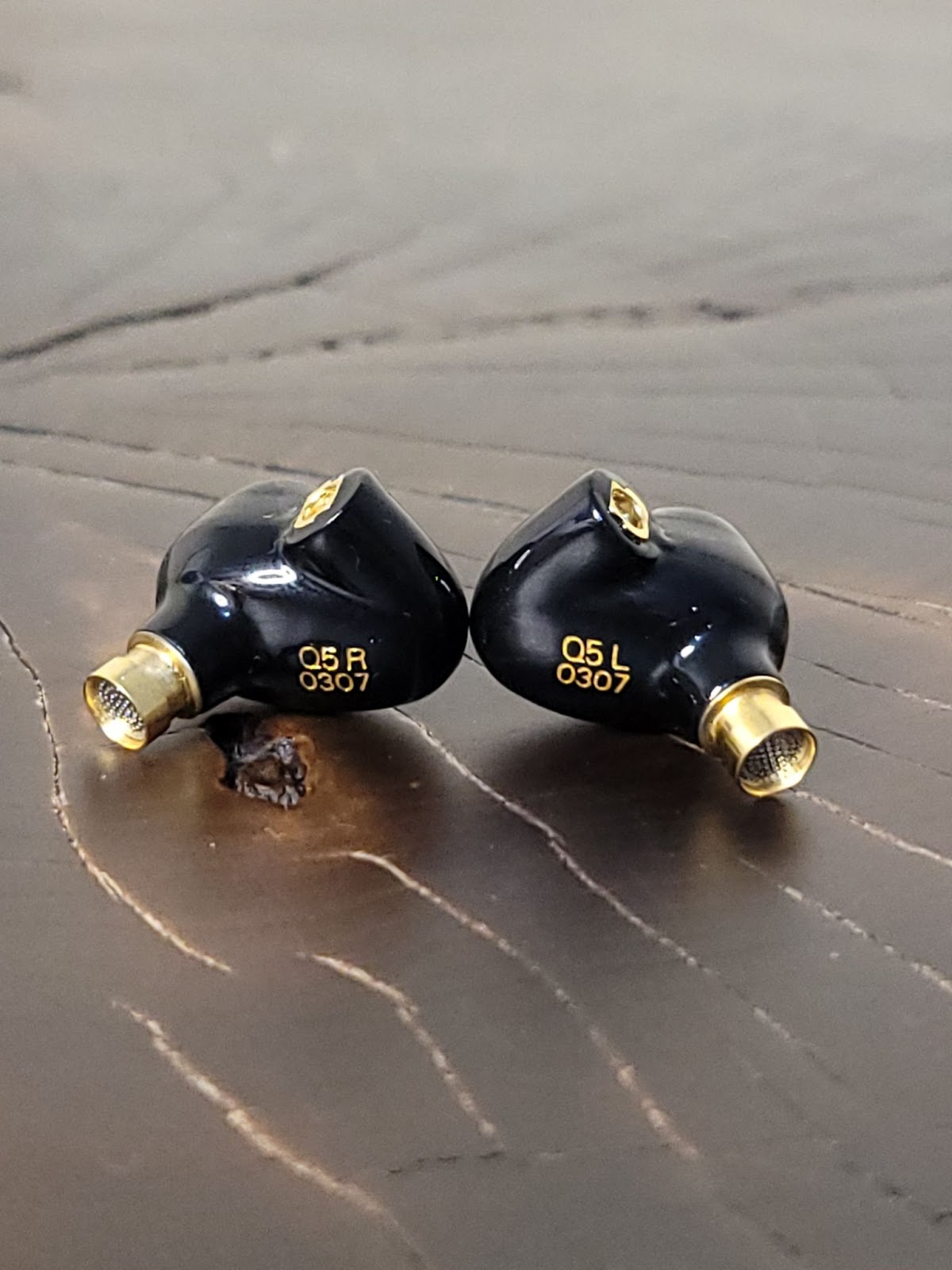
Anyway, the look of the IEMs is like I said earlier, pretty much the same with Meze Advar. Which might be intentional, seeing EPZ got to be recognized by more people after this. The only thing I don’t like is the usage of MMCX connector but that is subjective of course.
There is really not much to say about Q5 without comparing it to other IEMs. They have a very balanced tuning with a satisfying but not overpowering amount of bass. Mids are not too forward nor too laid back. Treble is mostly smooth but has just enough sparkle. They don’t get splashy at all unless they are pushed too much. You can say they almost lack character, emphasizing the word: “almost.”
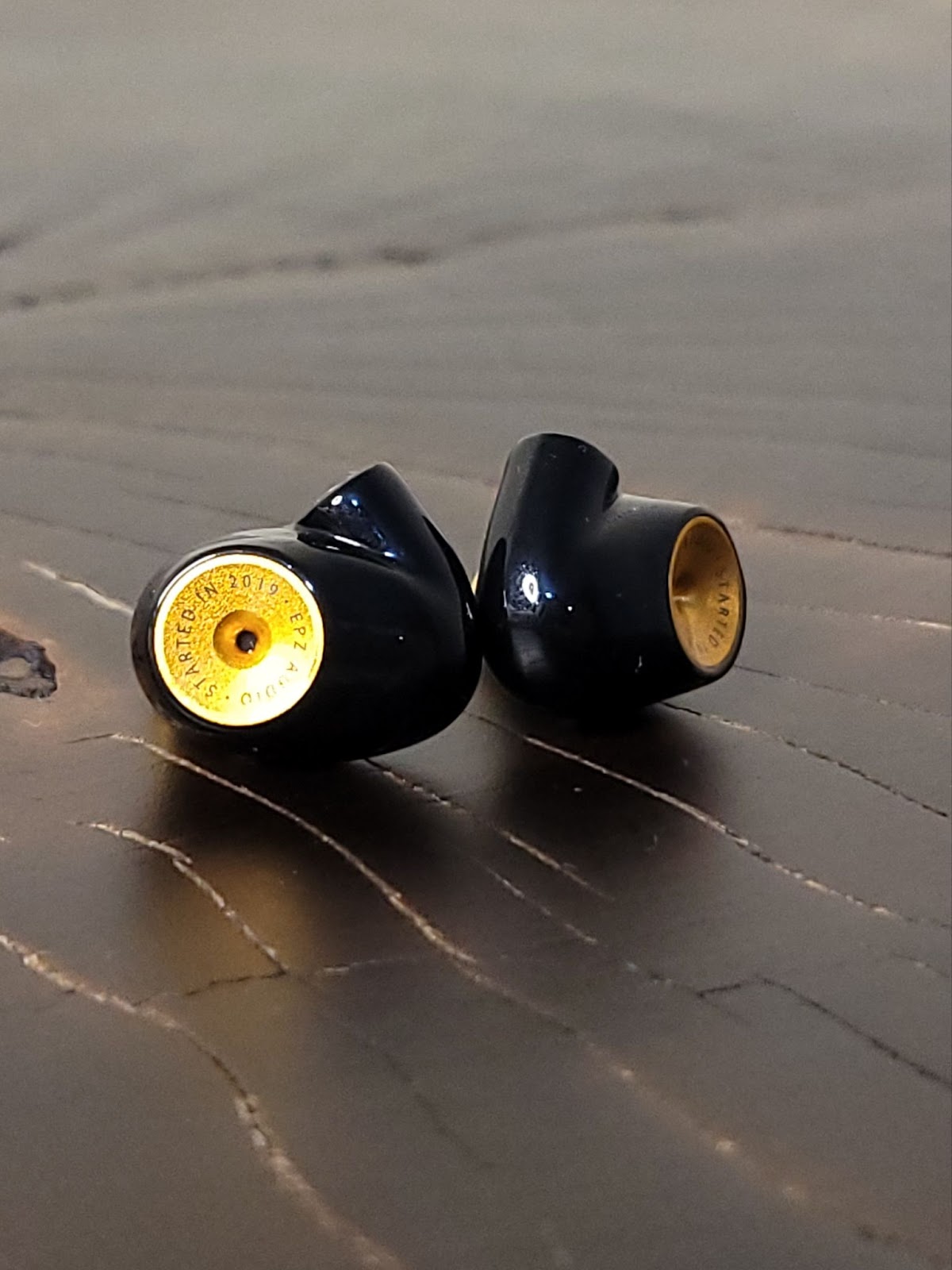
Technically they are very proficient to say the least. They don’t set the world on fire but for a budget single DD they aren’t behind their competitors. As you would read in the comparisons section, they are decently resolving and detailed, fairly wide. Timbre is pretty good like any well tuned single DD, although not the best out there. It might come as a little dry or cold if you are used to a warmer sound but by itself I have no complaints.
For more context I urge you to read the comparisons.
For many of the enthusiasts out there, Simgot EA500 is the reigning king of the sub $100 IEMs so it is only natural that I would compare these two.
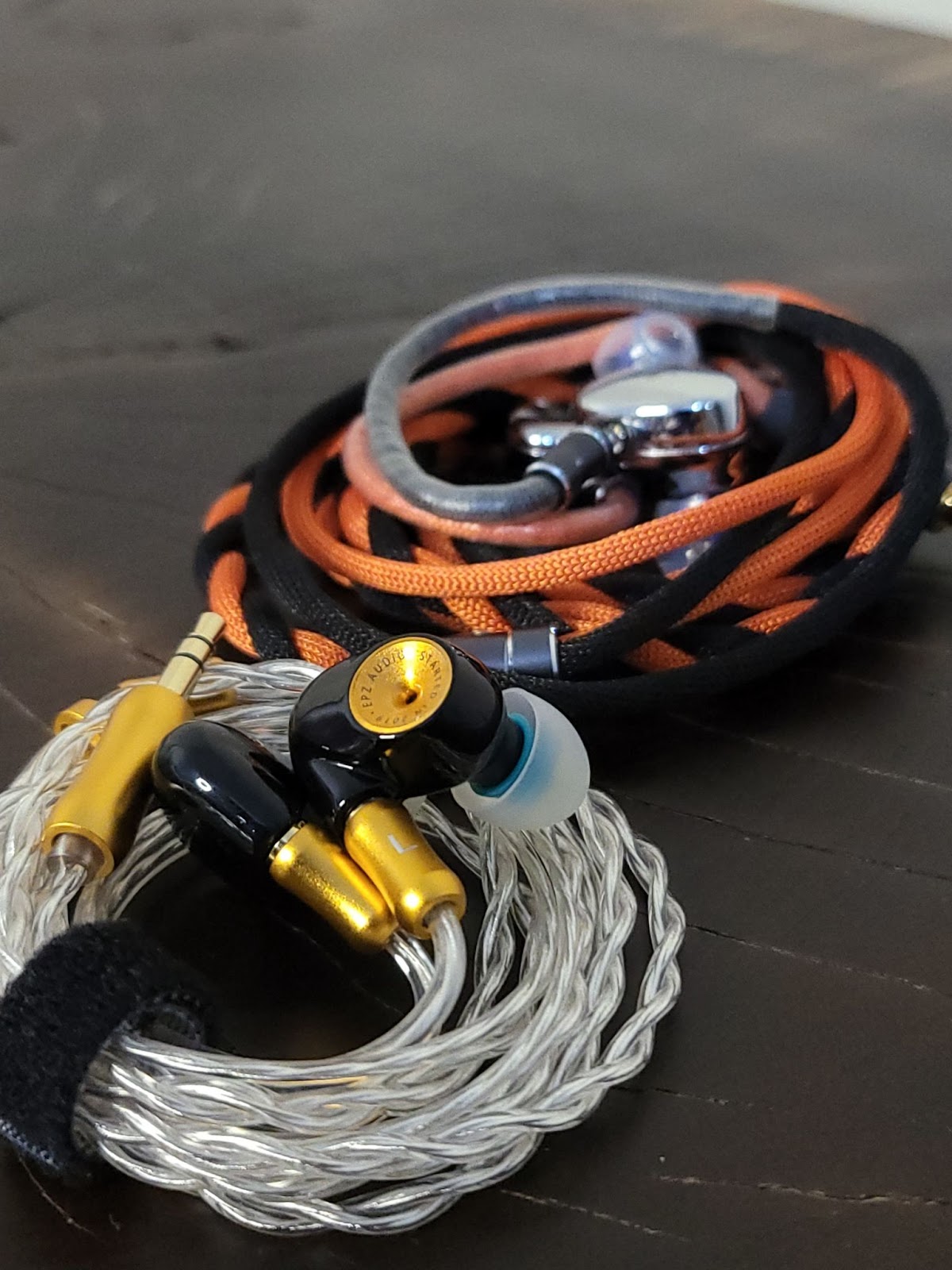
Right off the bat, EA500 sounds livelier, Q5 is slightly darker and more closed in.
Q5, as graphs indicate, is more prominent in the subbass area and rumbles more.
Still, EA500 has a satisfying thump, just not enough rumble. Q5 is slightly superior in the bass for my taste. Bass guitar however, steals the spotlight on EA500 due to its warmer tuning.
Both Male and Female vocals are closer to you in EA500. Also they reverberate more and feel more emotional, almost magical, so are the strings, guitars, piano and so on. EA500 might be slightly edgier on upper mids and lower treble but they are really very close.
EA500 is noticeably livelier, sparklier and airier in the treble but also slightly harsher if you are sensitive to treble. As I said in the beginning of the comparison, Q5 feels more closed in. On the other hand, Q5 still feels on point without showing off. Treble is satisfying without getting fatiguing. If you listen to it in a vacuum, you wouldn’t find anything wrong at all.

EA500 technically, no doubt is superior, although Q5 is no slouch. EA500 is more resolving and detailed. Timbre is also slightly more lifelike. Compared to that, Q5 sounds slightly duller and drier. Also EA500 feels airier and more spacious. EA500 doesn’t lose its composure easily but Q5 did in a few cases.
I really wanted Q5 to beat EA500. That would have been a very exciting experience. It did well enough considering the price difference but EA500 still reigns supreme.
The Z300 was one of the best purchases for me this year. Although they are mostly overshadowed by other IEMs in its price range, when you consider the great build and nice cable it comes with, I'd put the Z300 higher on my recommendations list. At some point I will definitely review these as well.
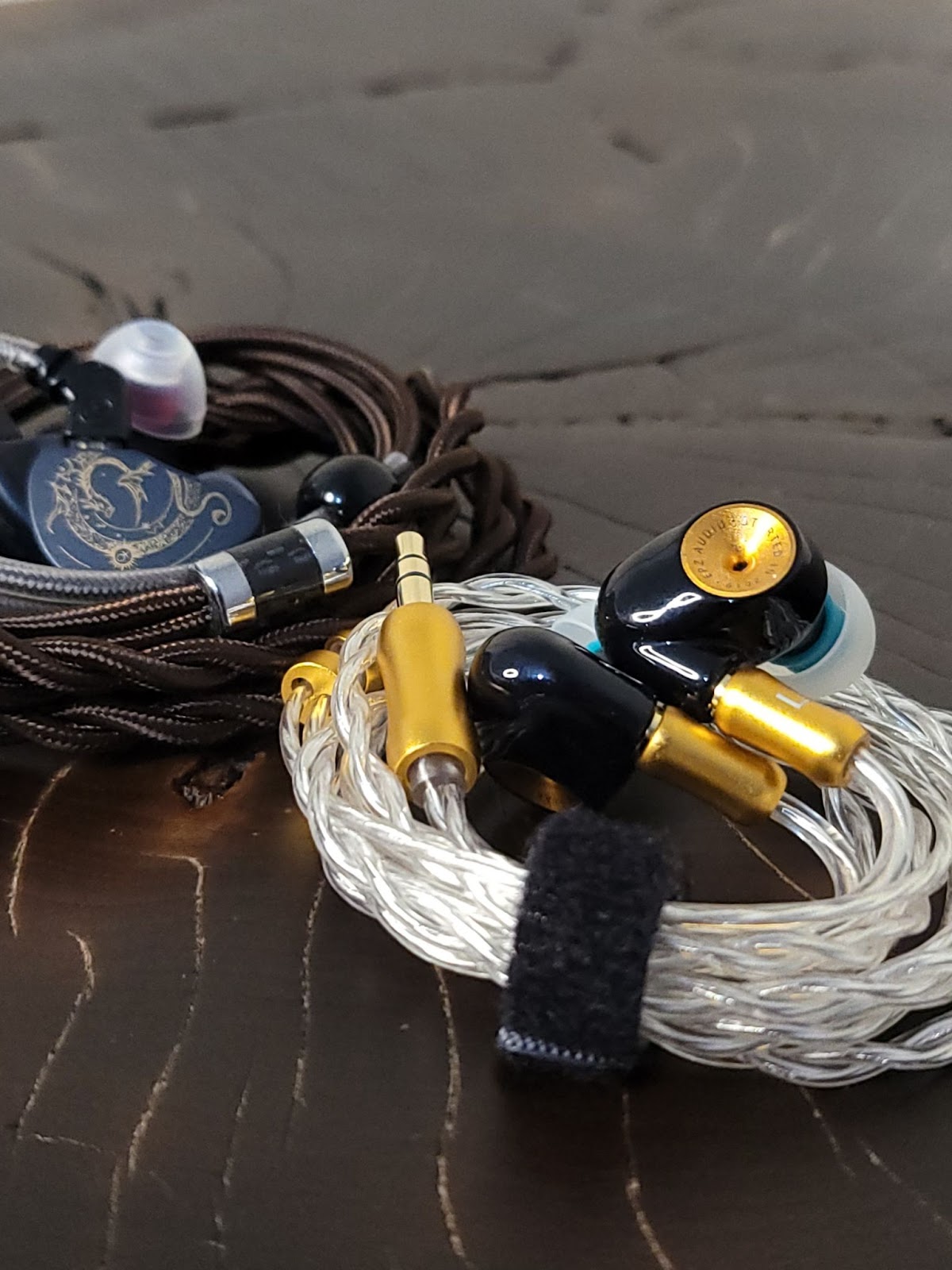
Z300 has a more satisfying thump in the bass. Also it feels fuller and rumbles slightly more in the subbass. The bass on Z300 is more prone to bleed into the mids while Q5 sounds tighter, cleaner and clearer.
Mids are warmer and wetter on Z300, maybe a little too wet. Vocals are also closer to you on Z300. They don’t get particularly shouty but they can pop or hint sibilance occasionally. Q5 doesn’t really have this kind of quirk.
Although the graph shows otherwise, upper mids on the Z300 is not that far behind. Compared to that, Q5 is again duller and drier while Z300 is more emotional.
Neither is particularly too prominent in the treble. But Z300 is a little more splashy, Q5 is slightly smoother compared to that.
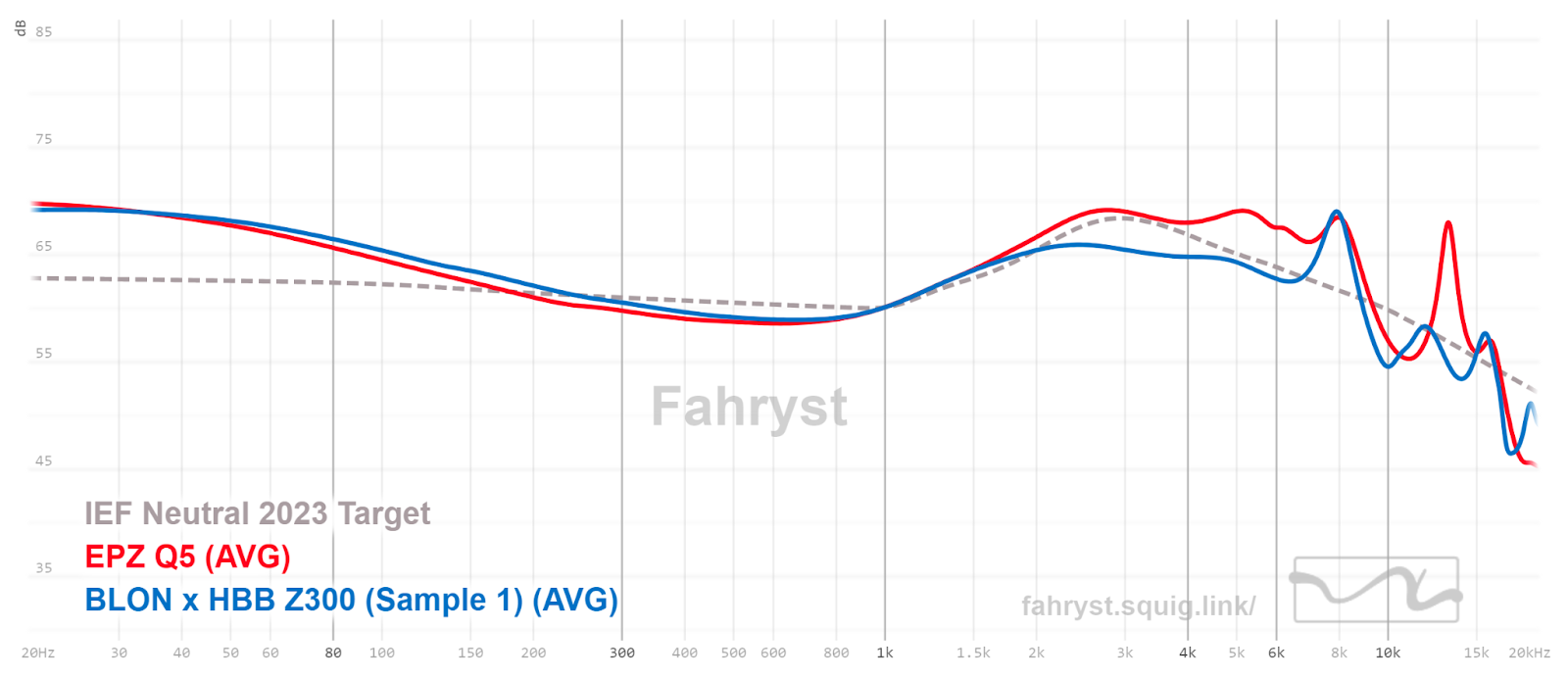
Technically they mostly trade blows. Q5 sounds more spacious. Also imaging, layering and instrument placement on the Q5 is better in this bigger sound field. On the other hand, Z300 might be a little bit more resolving but tuning makes it hide most of the nuances it resolves. In this sense Q5 is more detailed.
EPZ Q5 is a very solid choice in its price range. Let’s be honest. Most of the IEMs in the budget category are more or less tuned to adhere to a similar target. The choice now depends on which one is technically more proficient, which one has a better build, which one is more comfortable or which one comes with a better cable. I think Q5 ticks these boxes more than almost all of the others. I actually had Truthear x Crinacle Zero and Zero: Red for a while during my evaluation of the Q5 and I’d rather get the Q5 instead of both for subjective reasons. (Issues with comfort and weird imaging) I’m not saying go get yourself a Q5 asap but I urge you to check out other reviews to see if they are to your liking and also look out for other releases from EPZ as they know what they are doing in my opinion.
EPZ is not a new brand but it looks like they are getting noticed by more and more people recently. Earlier I reviewed their 1+4 Hybrid K5 and acknowledged what they did with it. It was well built and accessorized. In that sense Q5 is no different.
Pros
- Great build and comfort
- Premium packaging
- Very balanced tuning
- Pretty good technicalities
Cons
- MMCX Connectors (Subjective)
- A little dry and dull timbre
- Questionable design choice
Disclaimers
EPZ Q5 was provided to me by EPZ for a fraction of its price. As I always say, everyone is biased one way or another so take everything you read with a grain of salt. Also I will try to be more concise and to the point in my reviews from now on without worrying about the word count etc. If you have any questions, please ask me in the comments and I will try to answer them to the best of my abilities.Build and Accessories of EPZ Q5
When Q5 first came into the daylight, it was mocked by the community for plagiarizing Meze’s design of Advar and rightfully so. Even the packaging is similar. Well, actually Q5’s box has a gimmick that Advar’s doesn’t have so it comes out on top! Instead of a lid, it splits open and you are greeted with the IEMs. To be honest I don’t think anyone would expect such a presentation from a 50 IEM!
Gimmicks aside, you are provided with 2 sets of decent eartips, a nice 3.5 mm SPC cable that is in line with IEMs’ design, an eva carrying case, a cloth for wiping IEMs and some literature. IEMs are made out of 3D printed resin. They are very small, light and comfortable for my ears and believe me most of the IEMs aren’t. On that note, brands should really make their IEMs smaller or in at least two sizes. You can’t just assume every audiophile has ears like Dumbo. It gets even more ridiculous when they use female models to promote their products.
Anyway, the look of the IEMs is like I said earlier, pretty much the same with Meze Advar. Which might be intentional, seeing EPZ got to be recognized by more people after this. The only thing I don’t like is the usage of MMCX connector but that is subjective of course.
Sound of EPZ Q5
Tonality
There is really not much to say about Q5 without comparing it to other IEMs. They have a very balanced tuning with a satisfying but not overpowering amount of bass. Mids are not too forward nor too laid back. Treble is mostly smooth but has just enough sparkle. They don’t get splashy at all unless they are pushed too much. You can say they almost lack character, emphasizing the word: “almost.”
Technicalities
Technically they are very proficient to say the least. They don’t set the world on fire but for a budget single DD they aren’t behind their competitors. As you would read in the comparisons section, they are decently resolving and detailed, fairly wide. Timbre is pretty good like any well tuned single DD, although not the best out there. It might come as a little dry or cold if you are used to a warmer sound but by itself I have no complaints.
For more context I urge you to read the comparisons.
Comparisons
EPZ Q5 vs. Simgot EA500
For many of the enthusiasts out there, Simgot EA500 is the reigning king of the sub $100 IEMs so it is only natural that I would compare these two.
Right off the bat, EA500 sounds livelier, Q5 is slightly darker and more closed in.
Q5, as graphs indicate, is more prominent in the subbass area and rumbles more.
Still, EA500 has a satisfying thump, just not enough rumble. Q5 is slightly superior in the bass for my taste. Bass guitar however, steals the spotlight on EA500 due to its warmer tuning.
Both Male and Female vocals are closer to you in EA500. Also they reverberate more and feel more emotional, almost magical, so are the strings, guitars, piano and so on. EA500 might be slightly edgier on upper mids and lower treble but they are really very close.
EA500 is noticeably livelier, sparklier and airier in the treble but also slightly harsher if you are sensitive to treble. As I said in the beginning of the comparison, Q5 feels more closed in. On the other hand, Q5 still feels on point without showing off. Treble is satisfying without getting fatiguing. If you listen to it in a vacuum, you wouldn’t find anything wrong at all.
EA500 technically, no doubt is superior, although Q5 is no slouch. EA500 is more resolving and detailed. Timbre is also slightly more lifelike. Compared to that, Q5 sounds slightly duller and drier. Also EA500 feels airier and more spacious. EA500 doesn’t lose its composure easily but Q5 did in a few cases.
I really wanted Q5 to beat EA500. That would have been a very exciting experience. It did well enough considering the price difference but EA500 still reigns supreme.
EPZ Q5 vs. BLON x HBB Z300
The Z300 was one of the best purchases for me this year. Although they are mostly overshadowed by other IEMs in its price range, when you consider the great build and nice cable it comes with, I'd put the Z300 higher on my recommendations list. At some point I will definitely review these as well.
Z300 has a more satisfying thump in the bass. Also it feels fuller and rumbles slightly more in the subbass. The bass on Z300 is more prone to bleed into the mids while Q5 sounds tighter, cleaner and clearer.
Mids are warmer and wetter on Z300, maybe a little too wet. Vocals are also closer to you on Z300. They don’t get particularly shouty but they can pop or hint sibilance occasionally. Q5 doesn’t really have this kind of quirk.
Although the graph shows otherwise, upper mids on the Z300 is not that far behind. Compared to that, Q5 is again duller and drier while Z300 is more emotional.
Neither is particularly too prominent in the treble. But Z300 is a little more splashy, Q5 is slightly smoother compared to that.
Technically they mostly trade blows. Q5 sounds more spacious. Also imaging, layering and instrument placement on the Q5 is better in this bigger sound field. On the other hand, Z300 might be a little bit more resolving but tuning makes it hide most of the nuances it resolves. In this sense Q5 is more detailed.
Conclusion
EPZ Q5 is a very solid choice in its price range. Let’s be honest. Most of the IEMs in the budget category are more or less tuned to adhere to a similar target. The choice now depends on which one is technically more proficient, which one has a better build, which one is more comfortable or which one comes with a better cable. I think Q5 ticks these boxes more than almost all of the others. I actually had Truthear x Crinacle Zero and Zero: Red for a while during my evaluation of the Q5 and I’d rather get the Q5 instead of both for subjective reasons. (Issues with comfort and weird imaging) I’m not saying go get yourself a Q5 asap but I urge you to check out other reviews to see if they are to your liking and also look out for other releases from EPZ as they know what they are doing in my opinion.
Jarlaxle
100+ Head-Fier
Pros: Exceptional execution of warm-neutral tuning
Expansive staging
Laser sharp imaging
Lovely mids presentation
Expansive staging
Laser sharp imaging
Lovely mids presentation
Cons: Pricy! (I could have knocked it down another half star tbh)
Bass is not enough for some genres
Not the most resolving and detailed at this price
Bass is not enough for some genres
Not the most resolving and detailed at this price
Twilight is Softears’ second single dynamic driver IEM that comes at a whopping $930. It may sound steep but in this review you are going to read, you may start to think that price tag might just be justified.
Softears is one of the few IEM manufacturers from China that doesn’t come out with a new product every other month. Their cheapest release is $285 Volume and prices go as high as $2499 with Turii Ti which is also a single dynamic driver. So you can confidently say they are a premium brand.
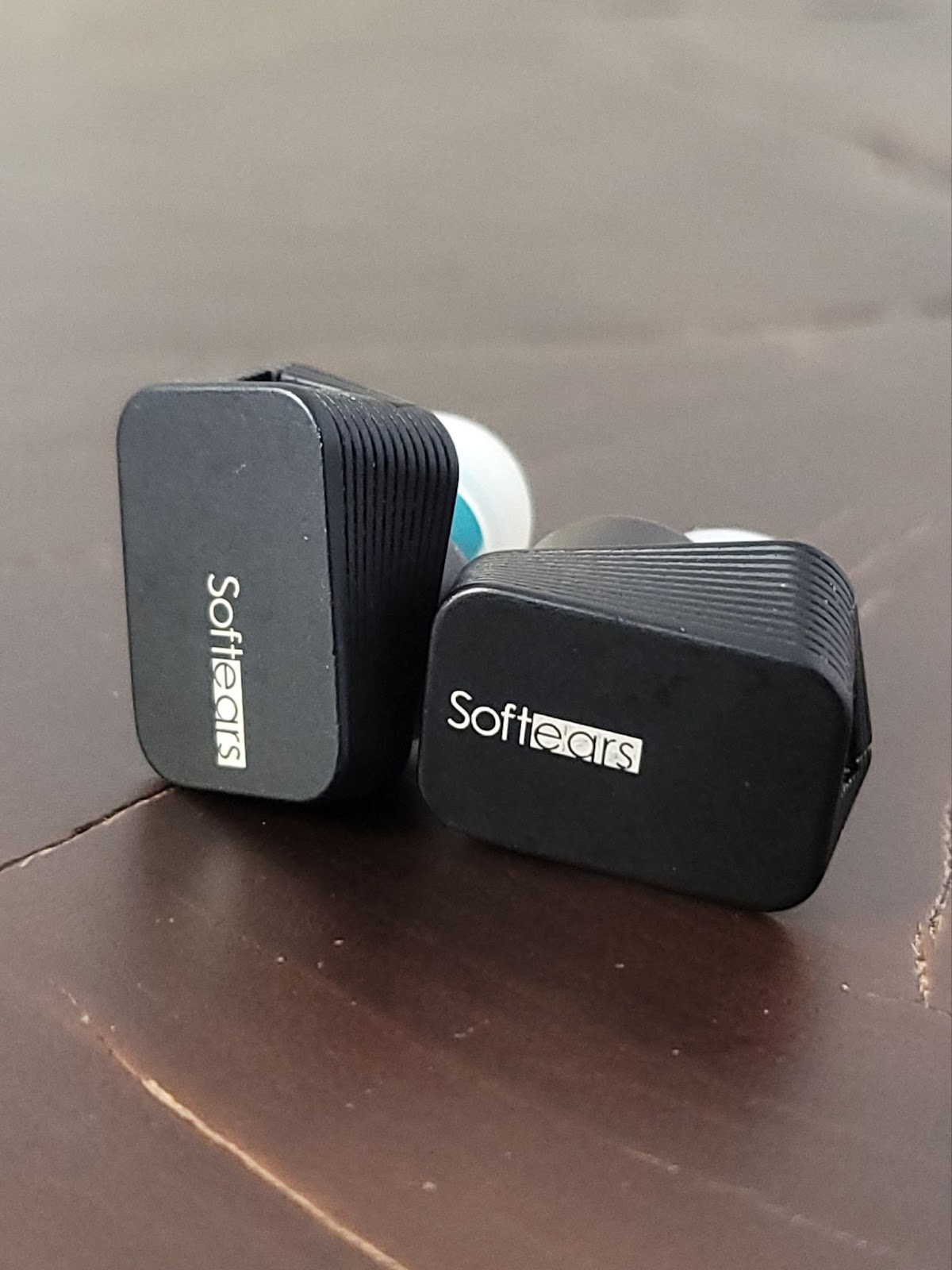
Softears Twilight is loaned to me by a friend (and I loaned him my Moondrop Variations so I couldn’t compare them head to head unfortunately.) As I always say, everyone is biased one way or another so take everything you read with a grain of salt. Also I will try to be more concise and to the point in my reviews from now on without worrying about the word count etc. If you have any questions, please ask me in the comments and I will try to answer them to the best of my abilities.
The Twilight is a very unique looking IEM but apparently this design is not just for show. In their product page they say and I quote:
“With more than 100 experiments and calculations, we got the volume of the rear cavity matching the unit. This improves the dynamic response and sensitivity and can easily produce the excellent low-frequency sound.”
Marketing aside, they managed to get something really amazing, but not in the low end, we will get to that. Shells are made out of aviation grade aluminum alloy and CNC machined. Nobody says it but these are basically open-back iems, believe it or not. They don’t block outside noise and leak the music you listen to to the outside.
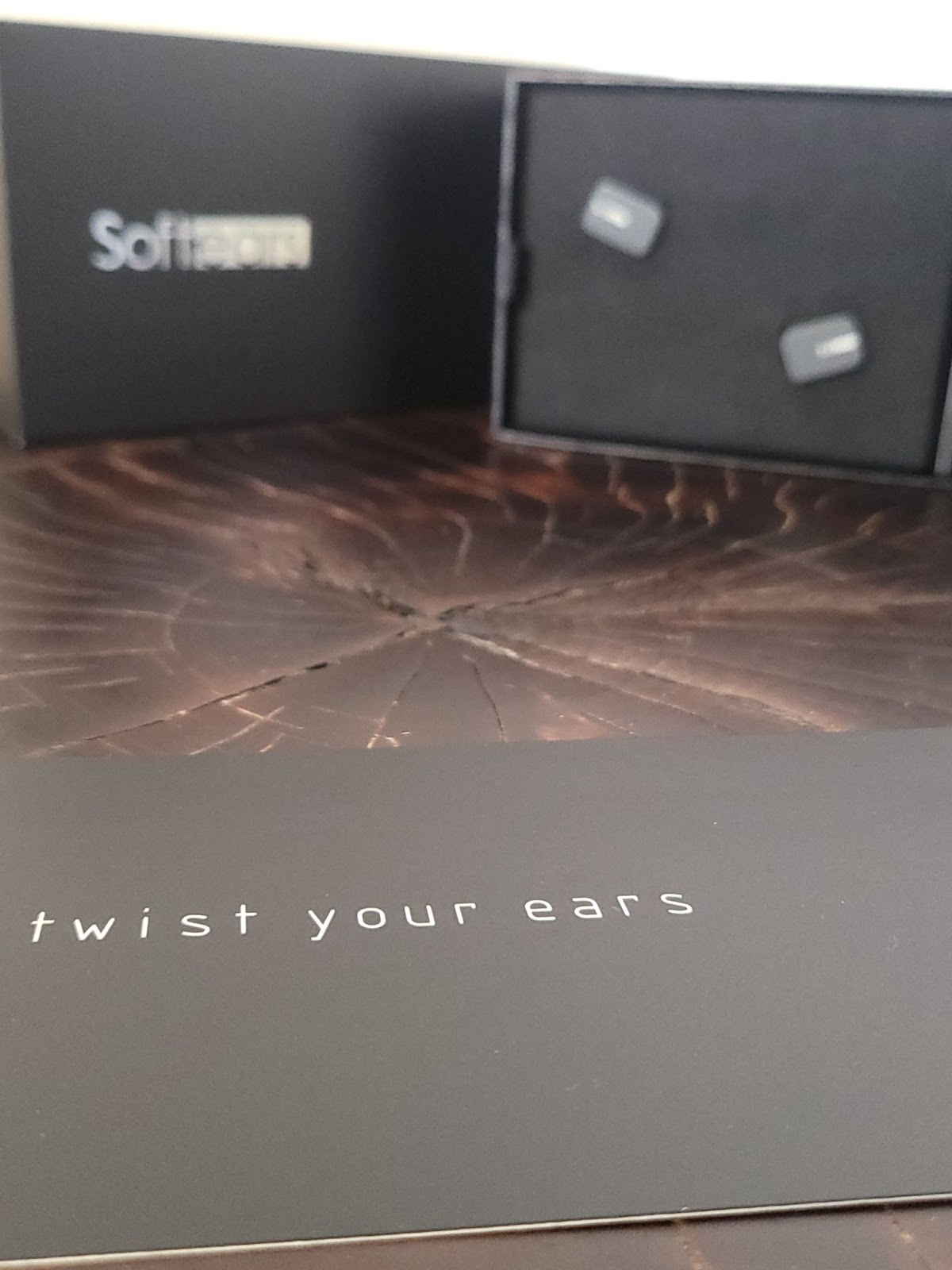
Drivers of the Twilight consist of DLC diaphragm with PU suspension if that matters to you.
They come with a 4.4 mm balanced cable that follows the design language of the Twilight and a 4.4 mm balanced to 3.5 mm single ended adapter cable. To be honest I prefer this to modular cables that are the rage these days.
Apart from the ear pieces and cables, box includes a cleaning tool, 9 pairs of ear tips and a split pouch to protect the earpieces from scratches and such.
Twilight is very easy to drive which is a good and a bad thing at the same time. You wouldn’t need a powerful source but still have to use a good one not to hear the noise floor. I think people should make a point of this more often instead of arguing about power requirements.
Twilight has a slightly warm neutral tonality. I was under the impression that these would have an ample amount of bass which I also mentioned in my first impressions. Maybe people’s reviews or marketing made me think so. Anyway these aren’t devoid of bass but definitely won’t satisfy you if you are after skull shaking bass. What you get on the other hand is a very tight and controlled bass that doesn’t bleed into the mids and color the rest of the spectrum. Neutral heads and mid lovers can rejoice.
Mids are where Twilight shines in my opinion. Well, probably I’m not the only one but I digress. To be honest Twilight didn’t wow me as much as my friend’s IE900 that I tried a couple of months back but I definitely prefer Twilight’s mids to IE900’s slightly recessed mids. Everything sounds on point. The vocals, both male and female, are adequately intimate but not shouty. No instrument masks the other, perfect.
Treble of Twilight was also tuned exceptionally. They are energetic enough without getting harsh or sibilant. Again everything is very well balanced. Depending on the song you listen to or the source you use there might be a few instances that these can get harsh but even in my long listening sessions I never got fatigued by them.
If you asked if Twilight is a special IEM, I’d say yes because of their technical capability. Notes are very well defined and seperated, definitely better than your usual 100-200 dollars single dynamic driver iems.
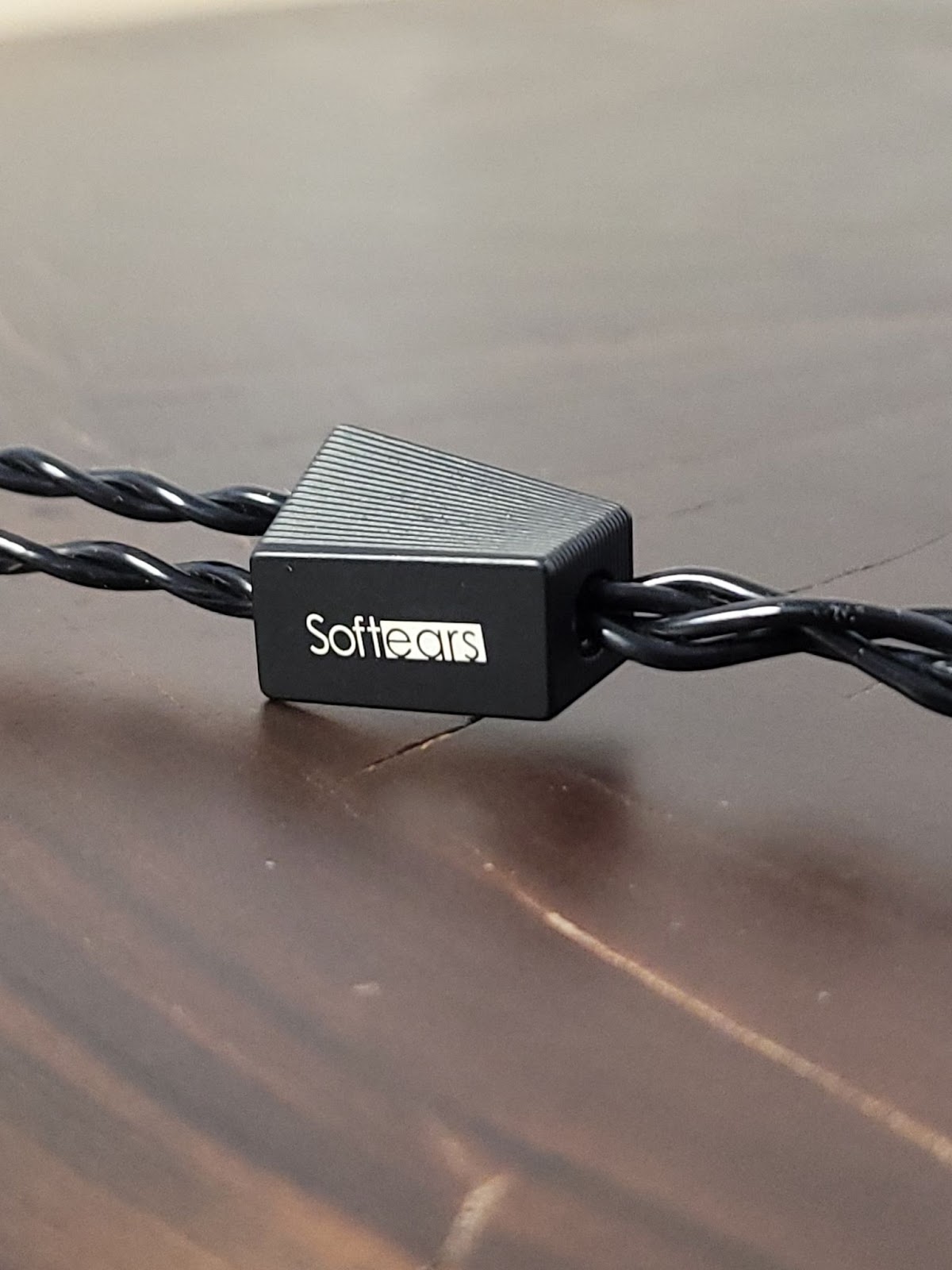
What Twilight does the best is staging and imaging as far as I’m concerned. When I first put these in my ears, the first thing that jumped out at me was how spacious and airy these sounded. Maybe that unique design and “open” closure of the shells contributed to this strength of Twilight. Stage is expansive and spacious, by iem standards of course. And they have laser sharp imaging which is only appropriate.
Unfortunately they are decently detailed, resolving capability is probably not the best around in its price range. How important this attribute is for you to decide.
Unfortunately I don’t have many iems with me that are in the same ballpark with the Twilight, so I chose AKG N5005 which was $999 when it was released and Simgot EA500 because someone pointed out its graph looked somewhat similar to the Twilight. (which I don’t agree by the way)

I tried to volume match both iems at 1 kHz before comparison. This proved that the N5005 was much harder to drive. I use N5005 with the bass filters because with other filters it immediately gets harsh, sibilant and balanced armature timbre becomes apparent.

I tried to volume match both iems at 1 kHz before comparison. They have pretty much the same sensitivity. I just reduced EA500’s volume a notch, although their product pages have the same impedance and sensitivity ratings.
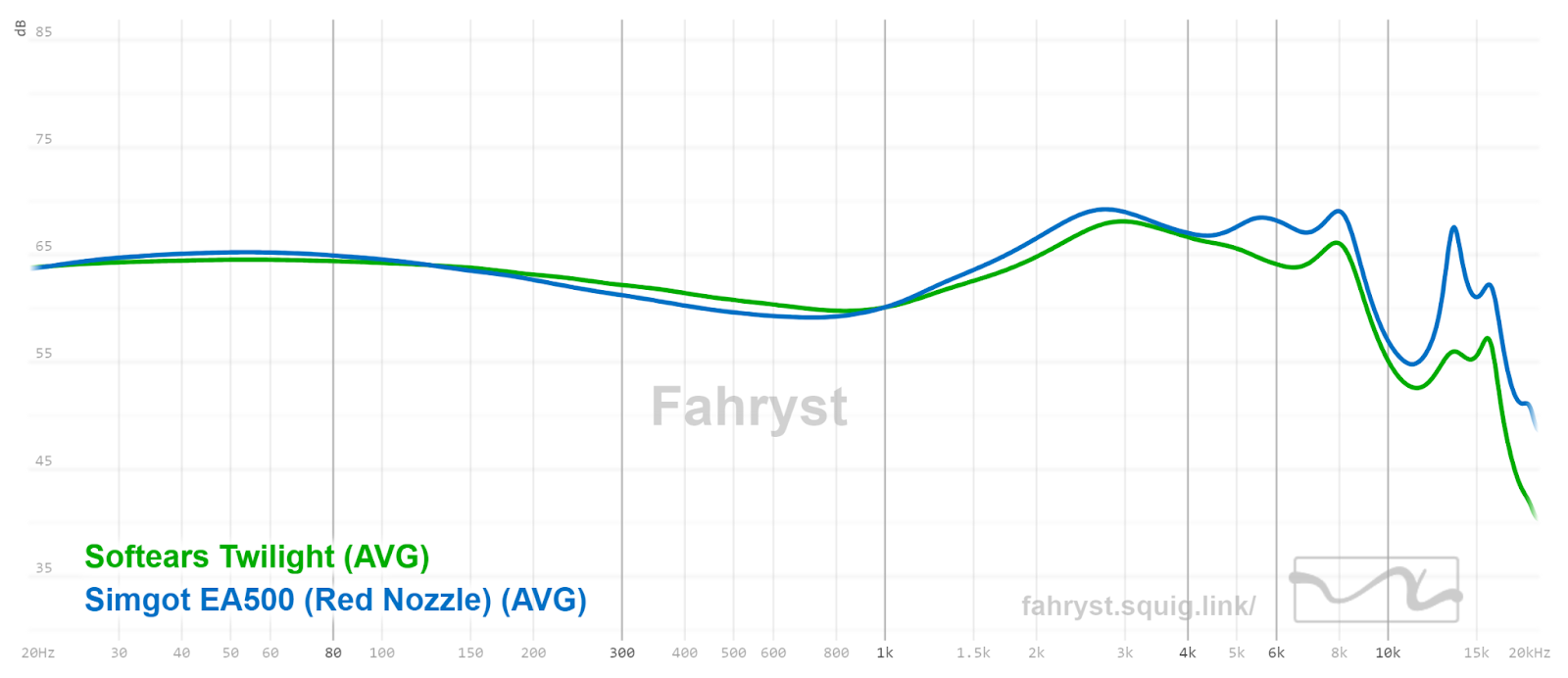
Softears Twilight is an amazing iem, no doubt about it. Is it $930 amazing? That, I’m not so sure. I usually prefer more exciting iems, and also I’m a sucker for clarity and Twilight promises neither of these. Apart from that, as the price goes higher, I expect more technically proficient iems; the manufacturers got the tuning somewhat down after all. The Twilight passes in every category with flying colors, except maybe resolving capability. Putting personal preferences aside, I’m pleasantly surprised at what they can do. For around $500 I’d say these are a blind buy, but for $930 I suggest you try them first if you can to see if they are what you are looking for. I just hope what they did with the Turii Ti and the Twilight will trickle down to more affordable iems in the future.
Softears is one of the few IEM manufacturers from China that doesn’t come out with a new product every other month. Their cheapest release is $285 Volume and prices go as high as $2499 with Turii Ti which is also a single dynamic driver. So you can confidently say they are a premium brand.
Pros
- Exceptional execution of warm-neutral tuning
- Expansive staging
- Laser sharp imaging
- Lovely mid presentation
Cons
- Pricy! (I could have knocked it down another half star tbh)
- Bass is not enough for some genres
- Not the most resolving and detailed at this price
Disclaimers
Softears Twilight is loaned to me by a friend (and I loaned him my Moondrop Variations so I couldn’t compare them head to head unfortunately.) As I always say, everyone is biased one way or another so take everything you read with a grain of salt. Also I will try to be more concise and to the point in my reviews from now on without worrying about the word count etc. If you have any questions, please ask me in the comments and I will try to answer them to the best of my abilities.
Build and Accessories of Softears Twilight
The Twilight is a very unique looking IEM but apparently this design is not just for show. In their product page they say and I quote:
“With more than 100 experiments and calculations, we got the volume of the rear cavity matching the unit. This improves the dynamic response and sensitivity and can easily produce the excellent low-frequency sound.”
Marketing aside, they managed to get something really amazing, but not in the low end, we will get to that. Shells are made out of aviation grade aluminum alloy and CNC machined. Nobody says it but these are basically open-back iems, believe it or not. They don’t block outside noise and leak the music you listen to to the outside.
Drivers of the Twilight consist of DLC diaphragm with PU suspension if that matters to you.
They come with a 4.4 mm balanced cable that follows the design language of the Twilight and a 4.4 mm balanced to 3.5 mm single ended adapter cable. To be honest I prefer this to modular cables that are the rage these days.
Apart from the ear pieces and cables, box includes a cleaning tool, 9 pairs of ear tips and a split pouch to protect the earpieces from scratches and such.
Sound of Softears Twilight
Twilight is very easy to drive which is a good and a bad thing at the same time. You wouldn’t need a powerful source but still have to use a good one not to hear the noise floor. I think people should make a point of this more often instead of arguing about power requirements.
Tonality
Bass
Twilight has a slightly warm neutral tonality. I was under the impression that these would have an ample amount of bass which I also mentioned in my first impressions. Maybe people’s reviews or marketing made me think so. Anyway these aren’t devoid of bass but definitely won’t satisfy you if you are after skull shaking bass. What you get on the other hand is a very tight and controlled bass that doesn’t bleed into the mids and color the rest of the spectrum. Neutral heads and mid lovers can rejoice.
Mids
Mids are where Twilight shines in my opinion. Well, probably I’m not the only one but I digress. To be honest Twilight didn’t wow me as much as my friend’s IE900 that I tried a couple of months back but I definitely prefer Twilight’s mids to IE900’s slightly recessed mids. Everything sounds on point. The vocals, both male and female, are adequately intimate but not shouty. No instrument masks the other, perfect.
Treble
Treble of Twilight was also tuned exceptionally. They are energetic enough without getting harsh or sibilant. Again everything is very well balanced. Depending on the song you listen to or the source you use there might be a few instances that these can get harsh but even in my long listening sessions I never got fatigued by them.
Technicalities
If you asked if Twilight is a special IEM, I’d say yes because of their technical capability. Notes are very well defined and seperated, definitely better than your usual 100-200 dollars single dynamic driver iems.
What Twilight does the best is staging and imaging as far as I’m concerned. When I first put these in my ears, the first thing that jumped out at me was how spacious and airy these sounded. Maybe that unique design and “open” closure of the shells contributed to this strength of Twilight. Stage is expansive and spacious, by iem standards of course. And they have laser sharp imaging which is only appropriate.
Unfortunately they are decently detailed, resolving capability is probably not the best around in its price range. How important this attribute is for you to decide.
Comparisons
Unfortunately I don’t have many iems with me that are in the same ballpark with the Twilight, so I chose AKG N5005 which was $999 when it was released and Simgot EA500 because someone pointed out its graph looked somewhat similar to the Twilight. (which I don’t agree by the way)
Softears Twilight vs. AKG N5005
I tried to volume match both iems at 1 kHz before comparison. This proved that the N5005 was much harder to drive. I use N5005 with the bass filters because with other filters it immediately gets harsh, sibilant and balanced armature timbre becomes apparent.
- Twilight is warmer but AKG bassier and more impactful.
- N5005 is cleaner and clearer even with the bass filters.
- Vocals are more intimate on Twilight, both male and female. With bass filters N5005 has a more relaxed presentation. N5005 feels more effortless, maybe even serious in a sense, but Twilight is more emotional. Twilight has that slight whispiness in the vocals that most of the harman-like tuned chinese iems.
- Twilight is brighter than N5005 with bass filters but isn’t overly bright or fatiguing.
- Thanks to its higher driver count, N5005 has faster transient response and resolves better. But Twilight has a brighter tuning therefore makes some details more apparent.
- Timbre is one of the most natural I’ve ever heard. Probably the most natural among the iems that’s for sure. Staging and imaging are also greatest aspects of twilight. N5005 sounds more closed in and less accurate in imaging.
Softears Twilight vs. Simgot EA500
I tried to volume match both iems at 1 kHz before comparison. They have pretty much the same sensitivity. I just reduced EA500’s volume a notch, although their product pages have the same impedance and sensitivity ratings.
- Bass quantity is similar but EA500 slams harder, compared to that the Twilight's bass is tighter.
- Vocals feel more forward and intimate on EA500.
- EA500 gets sibilant and harsh much more easily. The Twilight keeps its composure and presents songs in the most natural manner.
- EA500 is much brighter but a graph can also tell you that.
- Twilight resolves much better in a more effortless manner. EA500 pushes details and can get grating.
- Although EA500 is wide and images good in its own right, it is no match for The Twilight, it is that good.
Conclusion
Softears Twilight is an amazing iem, no doubt about it. Is it $930 amazing? That, I’m not so sure. I usually prefer more exciting iems, and also I’m a sucker for clarity and Twilight promises neither of these. Apart from that, as the price goes higher, I expect more technically proficient iems; the manufacturers got the tuning somewhat down after all. The Twilight passes in every category with flying colors, except maybe resolving capability. Putting personal preferences aside, I’m pleasantly surprised at what they can do. For around $500 I’d say these are a blind buy, but for $930 I suggest you try them first if you can to see if they are what you are looking for. I just hope what they did with the Turii Ti and the Twilight will trickle down to more affordable iems in the future.
J
Jarlaxle
@WILLJS Yes, as @BadgerRivFan said, they are fairly comfortable. My biggest concern was also their comfort but, I didn't have any issue and my ears welcome less iem than most of the people. However by design they stick out a bit and if you lie down with your iems on, you cannot with these.
WILLJS
upon lookin further at them, they aren't as blockey as i originally though, it just looks like to facia would dig into your ears
Kingnubian
I did not have much problem with fit, though a member of our small reviewer group did.
Jarlaxle
100+ Head-Fier
Pros: Great build quality
Exceptional technical capability
A breath of fresh air in a market flooded with Harman-like tuned IEMs.
Competitive price
Exceptional technical capability
A breath of fresh air in a market flooded with Harman-like tuned IEMs.
Competitive price
Cons: Tip and seal dependent
Not the safest tuning and not for all genres of music
Can occasionally get harsh
Not the safest tuning and not for all genres of music
Can occasionally get harsh
BQEYZ Winter Review (Fahri’s Take)

A fitting ending to an era as the BQEYZ Winter deliver in more ways than one. With their unusual tuning, great technical capability and successful bone conduction driver implementation Winter have become one of the more compelling choices in its price range.
The Winter are the latest entry to Chinese earphone manufacturer BQEYZ’s Seasons line-up. BQEYZ is by no means an inexperienced brand, however, they don’t usually follow current trends and hypes, and instead proceed at their own pace.Winter was earlier reviewed by Mahir, but I wanted to take them on as well. I’ve had their Autumn IEMs for some time and they have been one of my favorites ever since, so when the Winter were announced, I was quite curious and excited. Especially after hearing that they would have a bone conduction driver and are priced below USD $300. You can also read the full review at mobileaudiophile.com.

BQEYZ Winter
Pros
- Great build quality
- Exceptional technical capability
- A breath of fresh air in a market flooded with Harman-like tuned IEMs.
- Competitive price
Cons
- Tip and seal dependent
- Not the safest tuning and not for all genres of music
- Can occasionally get harsh
Technical Specifications
- Driver: 12mm dynamic, 11.6mm bone conduction
- Impedance: 38 Ω
- Sensitivity: 113 dB
- Frequency: 5-40KHz
- Cable Length: 1.2m
- Pin Type: 0.78mm-2 Pin
- Plug Type: 3.5mm/2.5mm/4.4mm
Disclaimers
Without boring you too much, I don’t necessarily have a sound preference. I tend to enjoy different sound profiles as long as they do well at what they intend to do. I try to be critic in my reviews but I might be somewhat biased one way or another (Recency bias, buyer’s bias etc.). Please keep these in mind. Also, I bought BQEYZ Winter as well as other IEMs mentioned here with my own money. If a unit I reviewed is given or loaned to me in the future, I will say so here.Packaging
BQEYZ is not stingy when it comes to packaging and accessories. Apart from the earphones, a silver-plated cable, two sets of ear tips special to Winter, a small pair of foam tips, a carrying case and a cleaning tool come out of the box. Cable termination can be selected when ordering.
BQEYZ Winter Packaging and Accessories
Cable
The cable is one of the better stock versions I’ve encountered. The purity of the cable is not specified. It behaves well but, the Autumn’s stock cable is still my favorite when it comes to feel and behavior.Design
The BQEYZ Winter have a high-quality CNC-machined aluminum finish. The shape is almost identical to the Autumn. The only noticeable difference at first glance is, that the Winter is a little thicker. Edges are nicely rounded, except the wings which are pointier than the Autumn’s wings.I have small ears with small conches and narrow ear canals and the Autumn has a perfect fit in my ears, but unfortunately, the Winter stick out a bit.
They are very tip and seal-dependent. I recommend you change tips until you find the perfect fit for your ear. Otherwise, you might find them harsh or wonder if the bone conduction drivers work at all.
Internals
The most interesting part of the BQEYZ Winter is their usage of bone conduction drivers. Not many earphones implement this technology. The examples that initially come to mind are Unique Melody’s Mext and Mest line earphones.BQEYZ only accompanied the bone conduction driver with their 12 mm dual cavity dynamic driver. So, we have a 1DD+1BC hybrid in our hands. This driver is probably from the same family as the Autumn drivers since they share similar characteristics.
The dynamic drivers in the Winter work full range, while the bone conduction drivers focus on higher frequencies to help with the treble extension and resolution capabilities.

BQEYZ Winter
BQEYZ Winter’s Sound
The BQEYZ Winter have a bright neutral tuning with some warmth down low. They don’t adhere to any popular target, a fresh breath of air in the current market.Bass
Bass on the Winter is slightly above neutral. They have a good impact thanks to their 12 mm dynamic driver. The bass doesn’t bleed into the mids nor feel detached. Subbass slightly rolls off; however, you can feel they rumbling when the song you listen to has that information. It’s just not highlighted.Midrange
Mids are mostly neutral. Lower mids are slightly warm and lush. Male vocals have a decent body. The upper mids are not too forward, so they don’t shout or invade your personal space. Midrange clarity is excellent.Treble
If there is an emphasized region in the Winter’s frequency range, it is the treble, especially the lower treble. The Winter are explosive IEMs, and they literally pop in the treble. They are not necessarily harsh unless you crank up the volume. “S” sounds, and most of the cymbals are not sibilant. However, “Sh” sounds can occasionally jump at you.
BQEYZ Winter Frequency Response Graph
Technical Capabilities
BQEYZ Winter shine brighter than most when it comes to technicalities. They are wide, deep, and airy. Imaging and separation of instruments are especially good. They resolve better than most of the IEMs in their price range. Attack and decay are on point, and the notes don’t linger more than they need to. Bass is very controlled.Clarity is top-notch, maybe except for the bass and the lower mids. But they still have decent clarity in the lower region. Timbral quality, although behind conventional dynamic drivers, is still very good. Only occasional pops in treble throws off the balance.
Comparisons
To give more context about my findings, I decided to compare the Winter to their predecessor the Autumn, since they are also priced pretty close.
BQEYZ Winter vs. Autumn
BQEYZ Winter vs. BQEYZ Autumn (with Normal Filters)
The Autumn are slightly harder to drive. (With the same power, the Winter get about 2 dBs louder when a 1k test tone played.)The mids, especially the upper mids, and female vocals are more forward on Autumn.
The Winter are noticeably warmer, while the Autumn have a brighter presentation and can get harsh a bit easier. Since Autumn can become sibilant easier, I prefer narrow bore tips with them, and it mostly solves the problem. The Winter, although similar, are more forgiving. They don’t really get sibilant around the same area.
They both hit hard in the bass region. The Autumn hit slightly harder thanks to their driver size. Sub bass extension is similar but transience might be slightly faster on Winter. However, the Autumn can be tuned according to genre and preference, so they have the upper hand.
The Winter resolve much better. Although Autumn are no slouch, they don’t have that last bit of clarity and resolving ability that the bone conduction driver brings.
The Autumn are considered one of the wider IEMs, and the Winter come very close. The Winter also feel a little bit deeper. The imaging capability of the Winter is also more precise.

BQEYZ Winter vs. Autumn Frequency Response Graphs
Conclusion
BQEYZ has another winner in its hands. While the Winter don’t have the safest and most popular kind of tuning, they do most things very well. Maybe they lack the bass amount that would make them a preferable choice for pop, electronic music, or hip-hop. But where they lack, they make up with exceptional technical capability, especially for their price. If you are bored of Harman-like tuned IEMs and want something different, the BQEYZ Winter might just be the thing.
Last edited:





















